- Nepal Tours
- Everest Region Tours
- Everest Base Camp trek

Everest Base Camp Trek 2024/2025
The Everest Base Camp trek (EBC) is possibly the most dramatic and picturesque in the Nepalese Himalayas. Not only will you stand face to face with Mount Everest, Sagarmatha in Nepali language, at 8,848m (29,029 ft), but you will also be following in the footsteps of great mountaineers like Edmund Hillary and Tenzing Norgay, who all wanted to reach Everest's summit. Below, we list more than 20 Everest Base Camp treks offered by some of the best trekking agencies in Nepal. Bookmundi has received more than 400 applications from trekking agencies around the world who wish to offer their Everest Base Camp trek with us. We have chosen the 20 best agencies so you are guaranteed a good trek as well as a great price. If you wish to explore other great treks in Nepal , check out the Manaslu trek as well as the famous Annapurna Circuit trek .
- Nepal Travel Guide
Everest Base Camp trek - 88 Trips with 1,781 Reviews

- Starts Kathmandu, Nepal
- Ends Kathmandu, Nepal
Everest Base Camp Trek
- Free cancellation
- Trip customizable
- Tour Type Private and Group Tour
- Activities Trekking and Hiking
- Accommodation Guest House & Hotel
- Transport Flight & Private Vehicle
- Age Range 8-80 yrs
- Operated in English, Hindi, Nepalese
- View More Jan 1, 2019 Jan 2, 2019 Jan 3, 2019

- Activities Trekking and Hiking & Mountains
- Age Range 10-79 yrs
- Operated in English, Nepali

Everest Base Camp – Kalapathar Trek
- Age Range 10-75 yrs

- Accommodation Hotel & Guest House
- Operated in English

- Tour Type Private Tour
- Transport Flight
- Age Range 15-70 yrs

- Age Range 12-79 yrs
- Brochure Price: US$ 1,560
- Special Deal (20%): - US$ 312
- Total Price from: US$ 1,248

- Ends Pokhara, Nepal
Everest Base Camp & Annapurna Circuit Trek
- Best price guaranteed
- No booking fees
- Tour Type Small Group Tour
- Activities Trekking and Hiking & Walking tours
- Transport Flight & 4WD Jeep
- Age Range 16-99 yrs
- Sep 07 Only 1 seat left
- Sep 11 Only 10 seats left

10 Day Everest Base Camp Trek with Chopper Return
- Activities Trekking and Hiking & Adventure Trekking and Hiking , Adventure & Helicopter Tours 'data-more-tripid='8079'>+1 more
- Transport Flight, Private Vehicle & Helicopter
- Age Range 5-79 yrs

Everest Base Camp Trekking
- Accommodation Guest House, Hotel & Tent
- Age Range 5-90 yrs

- Age Range 5-85 yrs

Short Everest Base Camp Trek
- Activities Trekking and Hiking & Adventure
- Transport Private Vehicle & Flight

- Accommodation Guest House, Hotel & Camping

- Tour Type Group Tour
- Activities Trekking and Hiking & Adventure Trekking and Hiking , Adventure & Mountains 'data-more-tripid='406'>+1 more

- Age Range 15-79 yrs
Traveling to Nepal? Chat with a local travel specialist in Nepal who can help organize your trip.

Everest Base Camp trek Reviews
- Sana Boutros
- Geremia De Carli
Traveller Photos for the Everest Base Camp trek

Everest Base Camp Trek - Overview
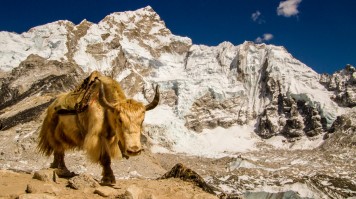
The trek to EBC is scenic and offers ever-changing Himalayan scenery through forests, hills and quaint villages. A great sense of anticipation builds as you trek up the Khumbu Valley, passing through intriguing Sherpa villages and Tibetan monasteries, all towered over by some of the highest and most stunningly beautiful mountains in the world. In the evenings, you will be rewarded with delicious Nepalese cuisine around the dining room fire while sipping Sherpa tea and conversing with other like-minded travelers.
Besides the superlative Mount Everest, some other prominent peaks visible during the Everest Base Camp trek include Lhotse (8501m), Makalu (8463m), Cho Oyu (8153m), and Ama Dablam (6856m).

Everest Base Camp Trek - Itinerary

You can complete an Everest Base Camp trek in 2 weeks . But if you don’t have much time, you can go for a short Everest Base Camp trek of under 10 days. The standard trekking itinerary for the Everest Base Camp Trek is 12 days long. However, it may vary slightly depending on the trekking agency you choose to go with:
Alternate Routes:
- Option 1: Although the EBC trek is the most well-known of all the treks in Nepal , there are other alternative treks that you can take. A popular choice is the shorter Everest Panorama Trek, which can be completed in 8 days. You will get to see Mount Everest and the surrounding peaks, but the Base Camp itself is not part of this trekking route. The maximum altitude on this trek is normally around 3,860 meters, as the itinerary's highest point is normally Tengboche.
- Option 2: Another option is the Gokyo Trek , which takes 12 days to complete and offers views of Everest and nearby peaks, Gokyo Lake, and the longest glacier in Nepal - Ngozumpa Glacier. You also have the option to combine the Everest Base Camp Trek with the Gokyo Trek for a 15-day trip.
- Option 3: A third alternative is the combined Everest Base Camp and Gokyo Trek , which takes 15 days. This trek is highly recommended, as you will see the amazing and pristine Gokyo region as well as Everest Base Camp.
- Option 4: Finally, if you have 16 days available or more, you can do the amazing Everest Base Camp 3 Passes Trek, crossing the 3 passes, Kong Ma La Pass, Cho La Pass, and Renjo La Pass, each of them above 5,000 meters.
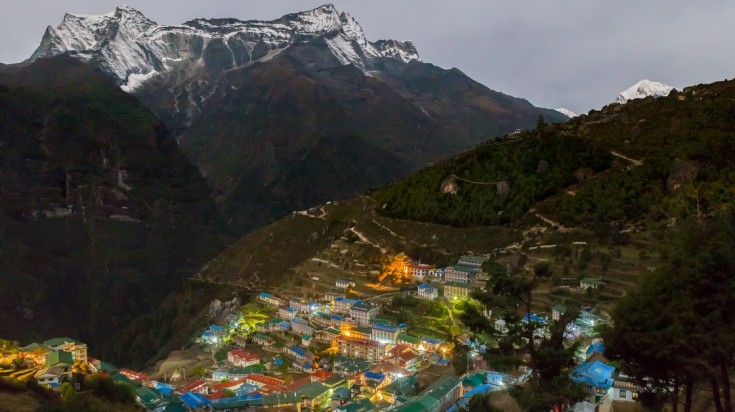
Everest Base Camp - Safety considerations
Please note the following safety considerations for the Everest Base Camp trek:
- This is a high-altitude trek, and therefore, careful acclimatization is needed. Acclimatization days are required during the trek to avoid altitude sickness.
- Temperatures regularly drop below freezing around EBC during early spring, late autumn, and winter. Please ensure you have the proper gear and clothing for the time of the year.
Check out our guide to find out the best time to trek to Everest Base Camp .
Everest Base Camp Trek - Questions and Answers
The Everest Base Camp trek is a 129 km round trip that starts from and ends in Lukla, where most people fly in from Kathmandu. It takes most travelers between eleven and 14 days to complete this journey, with the average duration being 12 days, of which it takes around eight days to trek from Lukla to the base camp. The return journey, which normally takes four days, is downhill.
We also recommend adding buffer periods of a day or two before and after your trek. You may need a couple of days in Kathmandu to shop for trekking gear and meet up with the tour guide to discuss the trek. The buffer period at the end of the trek is recommended because there is always a good chance of Lukla flights getting delayed due to bad weather. This means that the duration of your entire trip will be between 14 and 16 days.
Trekking to Everest Base Camp is truly a once-in-a-lifetime experience. Consistently voted as one of the best treks in the world, the entire journey is picturesque and features a variety of scenery.
However, the breathtaking landscapes that you encounter along the way are just part of the adventure. The tea houses and village lodgings where you stay offer a chance to experience local life and interact with the Sherpa people, making this journey a cultural experience. Some might find the trek to be highly demanding, but beautiful landscape and cultural interactions make it well worth it!
The price depends on the tour company you book with. But most tour operators charge between USD 700 and USD 1,500 for a trip to the base camp and back. There is also an option for a one-way hiking trip with a helicopter flight back to Kathmandu . This is significantly more expensive, though, at around USD 2,500 to USD 3,000 per person. Another option is a luxury EBC trip with comfier accommodation and more rest days. These tours can also go up to USD 3,000 per person. Check out our guide on how much it costs to trek to Everest Base Camp to find out more.
Topographically speaking, Everest Base Camp is called a ‘mountain plateau’, which essentially means that it is cold throughout the entire year. However, temperatures do vary from month to month. The months of December and January are the harshest, with average temperatures of around -10°C. The weather is a bit warmer in spring and fall, often reaching 15°C during the day, although nights are still very chilly. Summers can see daytime highs of 22°C and an average nighttime temperature of 4°C. But since the monsoon coincides with warmer months, rainfalls are prevalent even in the mountains. For more information, here is our guide on trekking seasons in Nepal .
The Everest Base Camp sits at the foot of the Khumbu Glacier in Nepal, close to the border with China. The trek to the base camp takes you past highland hamlets as well as the de facto Sherpa capital, Namche Bazaar. The Everest Base Camp on the Nepali side is also called the ‘south base camp’, which is more popular and distinct than the ‘north base camp’ in Tibet, China. The latter has been closed to travelers since February 2019.
Everest Base Camp is located 5,364 meters above sea level, while Lukla, the starting point of this journey, is situated at an elevation of 2,860 meters. That means that there is a staggering 2,504-meter elevation gain during the journey to the base of Mount Everest. However, almost all tour operators ensure that you have rest periods in between to decrease the chances of altitude sickness.
While Everest Base Camp trek is certainly not a walk in the park, you do not have to be an athlete to complete it. It requires no technical skills except for the ability to cover long distances on foot at altitude. Of course, the fitter you are, the more enjoyable you will find this journey.
The trek becomes more difficult as you get closer to the base camp primarily due to the altitude gain. The most challenging part of this trek is after you breach the 3,000-meter altitude, as the pressure level and the oxygen level drops. Altitude sickness can kick in at this height. Above 5,000 meters oxygen levels will be approximately 50% of the normal levels, which makes the trek that much more challenging. To learn more, read about altitude sickness while trekking in Nepal .
While you can hike to Everest Base Camp all year round, the best seasons are the pre-monsoon period between March and May and during the fall season (October and November). Fall is considered the best time to do this trek as this is when the sky is the clearest and the Himalayas look magnificent. More information in our guide on trekking seasons in Nepal .
Popular Activities
- Mountains tours
- Trekking and Hiking tours
Upcoming Departures
- Summer 2024/2025
- Winter 2024/2025
- Spring 2025
- August 2024
- September 2024
- October 2024
- November 2024
- December 2024
- January 2025
- February 2025
- August 2025
- September 2025
- October 2025
- November 2025
Everest Base Camp trek Durations
- 1-day Everest Base Camp Trek
- 9-days Everest Base Camp Trek
- 10-days Everest Base Camp Trek
- 12-days Everest Base Camp Trek
- 15-days Everest Base Camp Trek
- 16-days Everest Base Camp Trek
- 2-weeks Everest Base Camp Trek
Best price guaranteed - No booking fees
Free cancellation on most trips
Sign-in to unlock instant trip discounts. Create wish lists and save up to USD 1,500.
Everest Base Camp treks & tours

The big daddy of them all, the world’s highest peak and the tallest order on many a bucket list: Mt Everest.
Of course, you don’t need to reach the summit of this iconic mountain to experience the essence of a real Himalayan adventure. Go trekking through the high passes above flame-red rhododendron forests and stunning alpine lakes and enjoy the chance to appreciate the jaw-dropping mountain scenery, as well as challenging yourself physically. Each of our treks is supported by an experienced crew, so you can let your feet do the talking and just focus on your end goal – Everest Base Camp.
Our Everest Base Camp trips
Everest base camp highlights, why choose us.
As owners of the largest inbound tour operator in Nepal , we have years of experience on the ground. Our English-speaking local leaders are more than just someone to make sure you don’t get lost on the trail; they are there to share their stories and insights about the culture and history of the region, too.
Your safety is our number one priority. All of our leaders are trained in Advanced Wilderness First Aid and are qualified AMS (Acute Mountain Sickness) specialists. Thanks to our specialized safety equipment and crew, our annual helicopter evacuation rescue rate is less than two per cent, well below industry average.
All of our guides, assistant guides and porters are local to the Everest region and experienced in their field. But they’re not only trekking experts, they are your key to connecting with the local people, food, landscape and culture. With plenty of stories and tips to share, you’ll feel like an adopted local in no time.
We are committed to ensuring respectful and fair working conditions for all trekking porters. Any leaders that join Intrepid must start out as a porter, even if they have led for another company before. This ensures that all our leaders understand the important role a porter plays on a trek and the challenges of the job. Learn more about our Porter Policy here .
Our trips don’t only include our incredible crew but also all the safety gear required to help get you to Everest Base Camp safely. All accommodation and transport is included, plus a return flight to Lukla to get you to the start of the trek.
We have a ‘bring in, bring out’ philosophy on our Base Camp treks, meaning any rubbish should be taken back to Kathmandu and disposed of there. Rubbish disposed of in villages along the trek has to be walked back to major hubs using porters or yaks, so the less we leave behind, the better.
Filter by rating
Frequently asked questions
How far will i walk each day.
We walk for between four and eight hours each day, some days being more strenuous than others. Trekking is mostly done on paths, but there is the occasional rough terrain along the way, and some days will include ascents and descents of 1640 feet or more. This, in addition to the altitude can account for the variation in hiking time and distance per day.
Do I need hiking boots?
Well-fitted, comfortable and sturdy shoes are essential and can make a great difference in the enjoyment of your trip. Make sure to break them in before your trip, either by wearing them on training hikes or even just around the house. The first time you wear your boots should not be on the trail!
Will I suffer from altitude sickness?
Everest Base Camp sits at 17,600 feet. At this altitude, it’s common for travelers to experience some adverse health effects – regardless of age, gender or fitness level. Everyone will adapt to the altitude and thinning air differently. This is why we always try to keep the ascent slow and steady, to allow your body to acclimatize and make your journey to the summit easier. Some pre-existing medical conditions are known to worsen at high altitudes and be difficult to adequately treat on the ground, leading to more serious consequences, so it’s important that you discuss any pre-existing medical conditions with your doctor before you leave home.
Can I reduce my chances of getting altitude sickness?
While there’s no definitive way to avoid altitude sickness, you can help your body acclimatize to the increase in altitude by:
Drinking plenty of water – at least four liters per day, as well as other fluids like tea and soup.
Avoiding alcohol, tobacco and substances that might cause dehydration or interfere with the body’s ability to deliver oxygen to your vital organs.
Eating small meals that are high in carbohydrates (like dal bhat!).
Taking it easy and having regular breaks. Walk at a slower pace than you normally would. It’s not a race, and it’s important to take your time.
What training should I do in preparation?
We have a number of different training guides available:
Top training tips for Everest Base Camp
Our trekking training guide
5 things to know before you trek Everest Base Camp
How can I help myself acclimatize once I am there?
Your body needs time to adjust to the altitudes and acclimatize, which will make you feel better in the long run. We have taken this into account in our Itinerary by limiting the altitude we increase daily and by giving you extra nights to acclimatize in Namche Bazaar.
What is the accommodation like?
Teahouses are the most common accommodation style on the Everest Base Camp trek. They are simple but cozy, with shared toilets and washing facilities. As a general rule, the closer you are to Base Camp the more basic the teahouses are. While the views of Everest and the surrounding Himalayas are spectacular, the amenities are understandably basic.
Hot shower facilities are available in some teahouses for a price but occasionally a hot shower means a bucket of hot water.
Electricity to charge devices as well as paid WiFi is sometimes available. We suggest purchasing a solar charged portable charger to bring with you.
What is the food like?
Food along the Everest Base Camp trail is simple and filling. All food must be carried to your guesthouses by yaks or people, so the higher you get, the more limited and expensive your food options will be. The most common meal on the trail is Dal Bhat, sometimes served with a small side of cooked or pickled veg. Dal is lentil soup, and Baht is rice. It’s filling, delicious, and you can have free refills!
You can get Western-style food like pizza, but it’s usually quite expensive. Breakfast is typically a choice of noodle soup, porridge, fried bread, and eggs.
We do not include meals while trekking, allowing you to choose what you want to eat and when. We know from experience that altitude and physical exercise can affect appetites differently.
Where do we eat on the trek?
While it’s not compulsory, our leaders will always encourage our groups to eat together to help build group dynamics over shared meals. The places your leader will recommend are usually the teahouses we use for accommodation. These teahouses have been inspected and approved by our local operations team and are continually tried and tested by our travelers, guides, and leaders who eat there.
The teahouses we sleep in do not rely on our travelers buying food and beverages for payment, as is sometimes the case with independent travelers and other operators. Intrepid pays the teahouses for the accommodation they provide to our groups and any other services they provide generates additional income for them.
How will I get clean drinking water?
It is essential to bring two 1-liter water bottles to refill along the way. While trekking, boiled or safe water is available for drinking, however you should also carry a water purification method. This could be in the form of filtered water bottles, purification drops/tablets, or ultraviolet sterilization pens that are available in camping stores, some pharmacies, or online.
How do the porters work? Do I carry my own luggage?
The evening before you leave Kathmandu, you'll receive a duffle bag to pack all the clothes and necessities you’ll need for the duration of the trek 22 pounds maximum. Your excess luggage will be stored at our starting point hotel in Kathmandu.
Your team of porters will carry the duffle bags for you, together with the food and equipment for the trail. Keep in mind that you won't have access to these items until the end of each day, as the porters will always be ahead of the group. While hiking, you will need to carry your own day pack with your water, camera, sunscreen, rain jacket, warm layers, hand sanitizer, and any other personal items.
What should I pack?
It’s important you refer to the packing recommendations in your Essential Trip Information, however, for a general guide check out our blog, ‘ What to pack for a trekking trip to Nepal ’.
Do I need to bring all my own hiking gear?
We understand that you might not own all the appropriate gear required to trek in the Himalayas. Thankfully Kathmandu has plenty of shops where you can rent or buy hiking apparel, sleeping bags, and trekking poles. While there are a few stores which sell real brand names, most sell knock offs with varying degrees of quality. Your trip leader can assist you in renting or purchasing the items you require.
When is the best time to trek?
Fall: The most popular trekking season for Everest Base Camp runs from mid-September to November. October is traditionally the most popular time for this trek, when the views are great, the skies are usually clear, and the temperatures are not too extreme.
Winter: Some travelers prefer the colder winter months, from December to February when the days are still sunny, but the trails are quieter. If you’re travelling over this time be sure to bring some extra layers of warm clothes.
Spring: If you go to Everest Base Camp over March, April and May you may be lucky enough to meet the people who will be attempting to summit the mountain. Mid-March to mid-May is one of the best times to see rhododendrons, Nepal’s national flower, in full bloom.
Summer: Is monsoon season, so we don't recommend trekking in June or July.
What is the weather like?
Depending on when you travel the weather can be vastly different, but it is best to prepare for all weather, as it can vary throughout the day. During the day in the earlier months of the trekking season it can get very warm and sunny, but during the winter months it can drop well below 32 degrees Fahrenheit, so warm clothing is vital.
No matter what the temperature, or how cloudy it is, always use sun protection! The atmosphere is thinner at high altitude meaning the UV rays are more extreme. Snow can also reflect UV rays, which greatly intensifies UV radiation.
Are there ATMs along the trek?
ATMs are not common on the Everest Base Camp region. There are only two towns where you will see ATMs: Lukla and Namche Bazar. It is quite common for there to be problems with those ATMs or for them to be out of money, so we advise our travelers not to rely on them and make sure you leave Kathmandu with sufficient cash for meals and anything else you might require.
What is the difference between trekking to Everest Base Camp and summiting Everest?
At Intrepid, we offer treks to Everest Base Camp, not to the summit. Trekking to the summit of Everest can cost upwards of $60,000USD and is far more technical than the trek to Base Camp. The summit climb requires previous trekking experience and knowledge of how to climb ice, rock and use summit equipment. Base Camp, on the other hand, requires no technical trekking skills or experience and is considered much safer than summitting. The trek to Base Camp takes between seven to nine days, whereas a summit expedition takes between seven and nine weeks. Most people who trek to Base Camp go for the experience of seeing Mt Everest, while exploring the local culture. Those who undertake a summit expedition have the primary goal of making it to the top.
Do the porters carry first aid kits?
Yes. We carry multiple comprehensive first aid kits and our porters and leaders are fully trained in their use. We also take oxygen cylinders, oximeter, portable altitude chamber, and satellite phone.
Are your leaders trained to recognize the symptoms of Acute Mountain Sickness (AMS)?
Absolutely! Intrepid have invested in the highest standards of training of our staff, including advanced altitude training delivered by local doctors who undergo refresher training every two years. We also train them on how to respond in the case of a moderate or severe case of altitude sickness – which will always mean organizing for the affected traveller to descend immediately. During your briefing on the first evening of your trip, your leader will talk to you about the symptoms of AMS and how to recognize them.
Do you carry medicine for altitude?
Yes – there are three key, potentially life-saving drugs that our teams carry on the mountain. These are Dexamethasone, Diamox and Nifedipine and they used to treat cerebral and pulmonary oedema, which are the two potentially life-threatening complications of severe AMS. Our mountain guides are fully trained on the use of these drugs for altitude related illnesses.
Will oxygen be available?
We carry medical oxygen – and when a group has four passengers or more, this will mean multiple cylinders will be distributed among the team of mountain guides to ensure that oxygen is always quickly available in the case of an emergency. The oxygen that we carry is strictly for emergency use only – and cannot be used by clients to assist in climbing or summiting.
Does someone carry an oxygen tank?
Yes. Each crew has a medical porter who has an oxygen tank, in case trekkers need it.
Do you carry Gamow bags or PACs?
Yes. We carry PACs, a portable altitude chamber, which are used for sufferers of severe AMS. When a person is suffering from AMS, a descent of just a few hundred meters back down the mountain is enough to make a difference. However, a rapid descent on foot is not always possible on Everest Base Camp trek, in which case PACs are more effective.
How do your leaders communicate on the trek?
Cell phone coverage on the mountain is improving – but it's still patchy in many areas. For this reason, Intrepid leaders carry short wave radios to allow for communication in the case of an emergency.
Who is your trekking operator in Nepal?
All our trips in Nepal are operated by PEAK DMC Nepal, which is a fully-owned Intrepid Travel company based in Kathmandu.
How do we practice responsible travel?
We use porters on our treks instead of yaks to carry bags and equipment. Even though animal transport is much cheaper, we have found the animals aren’t treated well and there is no weight limit enforced while using these animals as carriers. We have a detailed Porter Policy in place, to ensure our porters are respected and treated in a dignified way.
At the end of your tour please consider donating to the KEEP Porters Clothing Bank . Contrary to the belief that porters are well-adjusted to the cold and altitude of the Himalayas, every year many porters suffer from a variety of illnesses such as altitude sickness, snow blindness, hypothermia and frostbite and some even die as a result. The Clothing Bank was set up in 2009 to provide ill-prepared porters with better clothing suitable for trekking in a mountain environment and reduce the number of unnecessary illnesses and fatalities that occur each year.
Get inspired on The Good Times
7 different ways to see Patagonia with Intrepid
6 of the best hikes in Iceland
It’s official: Phurba Sherpa is the world’s best outdoor guide
How to train for a walking trip
5 of the best treks in Pakistan
8 reasons to travel to Pakistan
7 ways you can prepare your feet for a long hike
The 6 things you should know before hiking the Larapinta Trail

- Best Hikes In The World
- Appalachian Trail
- European Hikes
- Nepal Hikes
- Patagonia Hikes
- See All Hikes
- Mount Kenya
- Mount Kilimanjaro
- Mount Toubkal
- See All Mountains
- South Africa
- New Zealand
- Switzerland
- United Kingdom
- Packing Lists
Everest Base Camp Trek – Nepal’s Most Famous Trek
Asia , Nepal
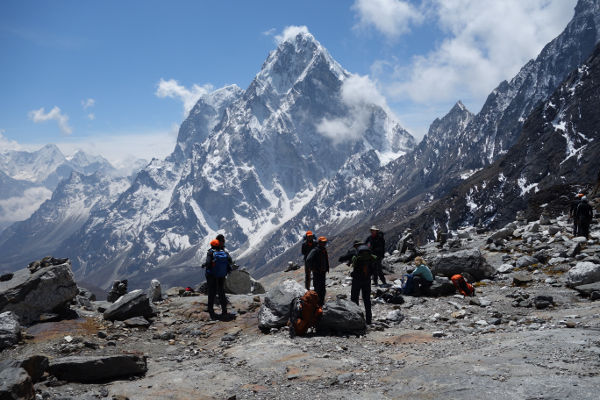
The Everest Base Camp Trek is one of the most popular and best treks in Nepal .
Home to four of the six highest mountains in the world – Mt. Everest (8,848 meters), Mt. Lhotse (8,516 meters), Mt. Makalu (8,470 meters) and Cho Oyu (8,201 meters) – the Everest (or Khumbu) region affords trekkers the opportunity to hike in one of the grandest and most awe-inspiring trekking areas in the world.
Trekkers get to retrace the footsteps taken by Sir Edmund Hillary and Tenzing Norgay on their historic Everest expedition in 1953.
On this page, you will find a comprehensive and impartial guide to the Everest Base Camp Trek.
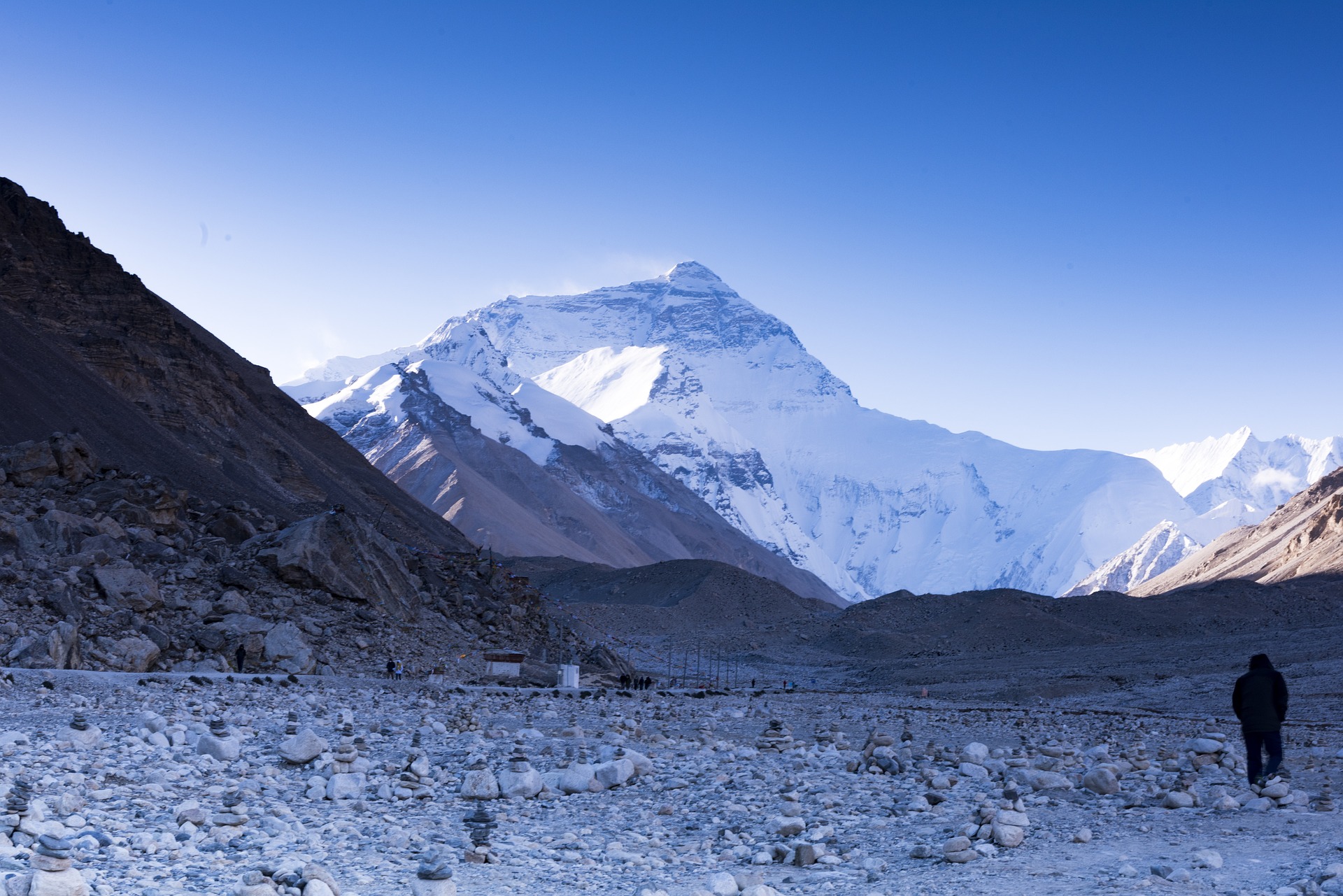
Everest Base Camp Trek
Ebc hike overview.
In this detailed Everest Base Camp trek article, you will find information on the typical route and its variations; a day-by-day itinerary breakdown of the trek; practical information on accommodation, meals, permits, equipment and insurance; as well as guidance on the best time to trek Everest Base Camp.
Key Highlights
Highlights on the trek include: unforgettable mountain views from Kala Patther , including Mt. Everest; the chance to see the famous Everest region Sherpas and Sherpa town – Namche Bazaar; sightseeing in the Sagarmatha National Park – a World Heritage Site; glimpses of the highest Buddhist monasteries in the world; and a sneak preview into the inner workings of the base camp to the world’s highest mountain.
Everest Regional Map
The Everest Base Camp trek is situated in the Everest, or Khumbu region of Nepal (see map below). It is the most popular trek in the region, if not the country.
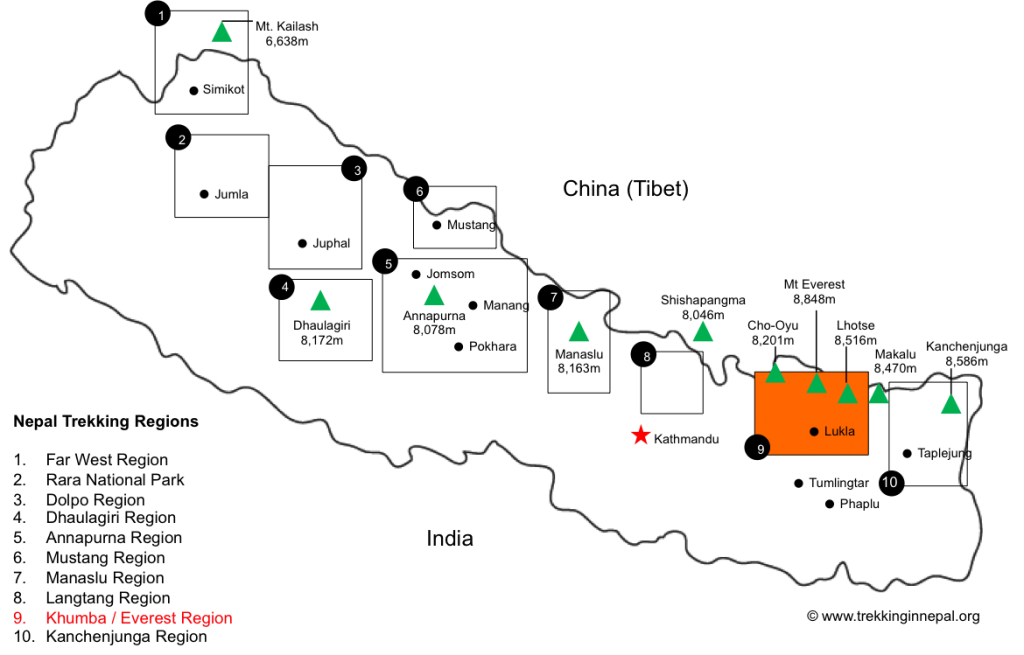
EBC Recommended Map
This map is one of the better representational schematics of the Everest Base Camp trail (we believe it is from GlobeTrekker but can’t be certain as there are many maps scattered across Google Images).
The map above shows the classic Everest Base Camp trek running up from Lukla to Namche Bazaar and then veering North-east up to Periche / Dingboche. From Dingboche / Periche the trail turns North-west to Lobuche before heading north gain to Gorak Shep. From here Everest Base Camp can be seen to the East and Kala Patthar in the North-west.
The map also shows the route to Island Peak in the East, via Dingboche and Chhukung, and the Gokyo Lakes in the West.
Please Note: The above recommended map is not to scale and should not be used as an accurate representation of the Everest Base Camp trek route. We provide links below to excellent maps of the Everest region.
EBC Trek Itinerary
Most trekkers fly from Kathmandu to Lukla Airport to begin their Everest Base Camp trek. The ‘classic’ or typical route follows straight up the Khumba Valley and through the Sagarmatha National Park to Everest Base Camp.
Variations via Gokyo Lakes or Chhukhung Valley are also popular (see the variations section below).
The typical Everest Base Camp trek duration is between 14-16 days (including transfers between Kathmandu and Lukla). The trek itself (excluding sightseeing in Kathmandu and transfers) usually lasts about 12 days with acclimatisation days at Namche Bazaar and Pheriche.
Here is a brief overview of a typical itinerary on an EBC trek, with approximate trekking times and altitudes.
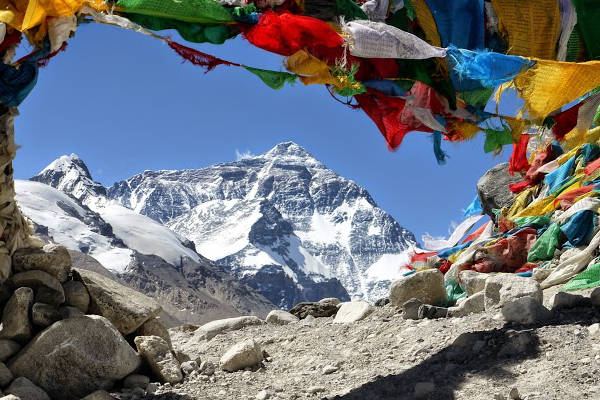
Day 1: Arrive Kathmandu
Arrive in Kathmandu. Rest and tour Kathmandu (often your tour operator will have pre-organised tours around Kathmandu).
See more in our guide on things to do in Kathmandu .
Day 2: Fly Kathmandu to Lukla. Trek to Phakding
Fly from Kathmandu to Lukla (expect a slightly scary landing at Lukla but rest assured the pilots are very experienced!). Weather can sometimes be a problem, so delays are common.
The flights afford great views of the Everest region, so have your camera ready. Try to sit on the right side of the plane to see Mt Everest. Upon arrival you will be transported to the trailhead and take a relatively easy trek from Lukla (2,800 meters) to Phakding (2,652 meters).

Namche Bazaar, Khumbu District
Day 3: Trek from Phakding to Namche Bazaar
Phakding (2,652 meters) to Namche Bazaar (3,440 meters) via Monjo (2,840 meters) and the beginning of Sagarmatha National Park. Weather permitting you might get your first glimpses of Mt Everest from the steep trail to Namche.
Day 4: Acclimatisation in Namche
This is usually a rest acclimatisation day in Namche (3,440 meters). If you are lucky enough to be in Namche on a Saturday, then make sure to visit the weekly market. Most operators will encourage you to take an acclimatisation trek to the Everest View Hotel (3,880 meters) where you can have lunch and capture views of Mt. Everest.
Day 5: Trek from Namche to Tengboche
Trek from Namche (3,440 meters) to Tengboche – also written Thyangboche (3,860 meters), home to the largest gompo (a Buddhist ecclesiastical fortification of learning). The trek is an undulating one which provides great views of beautiful mountains including Everest, Nuptse, Lhotse and Ama Dablam. Some treks go via Thame to visit the Thame Monastery, before continuing to Tengboche.
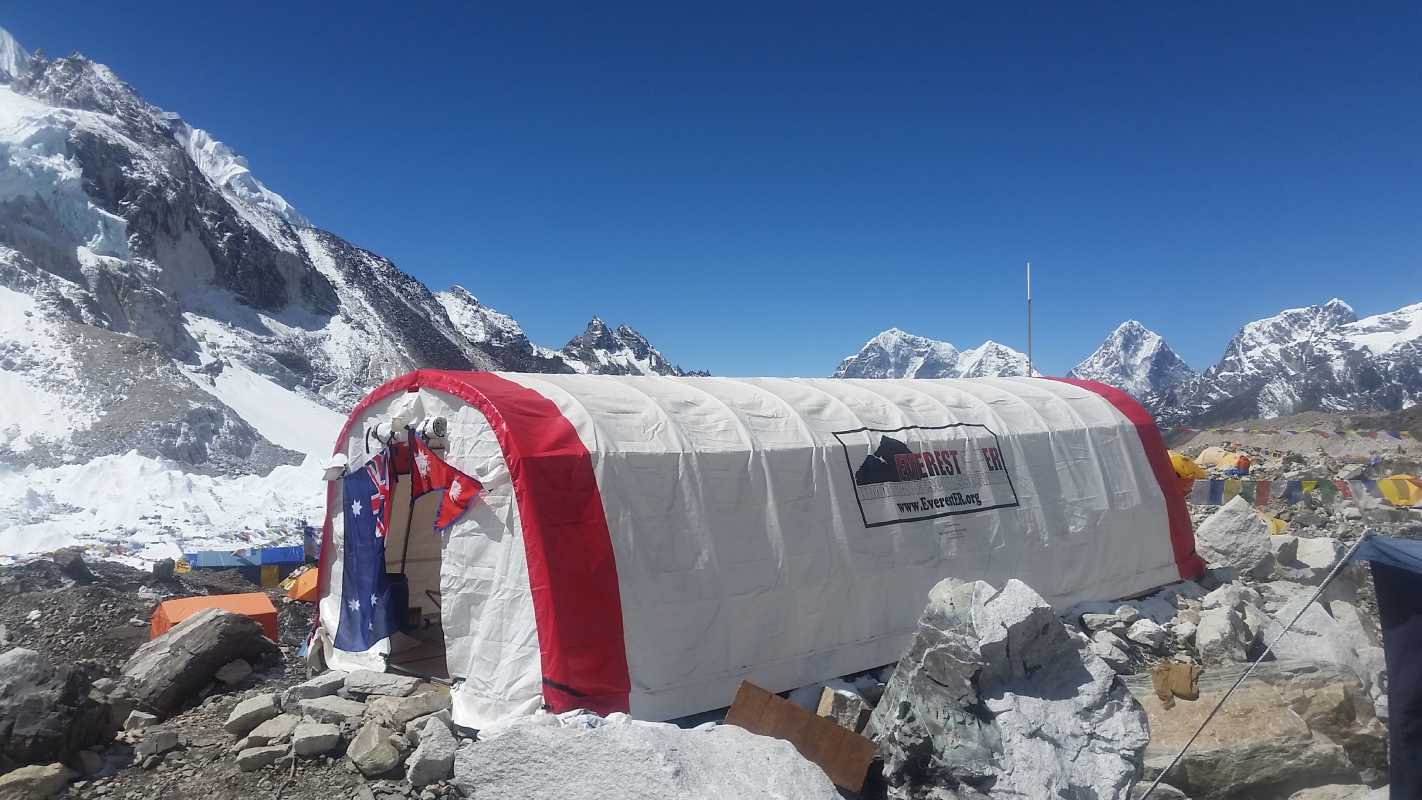
Day 6: Trek from Tengboche to Periche
Trek from Tengboche (3,860 meters) to Periche (4,280 meters) via the town of Pangboche. The Himalaya Rescue Association are based here, and it is well worth visiting them if your operator hasn’t already organised a tour.
Day 7: Acclimatisation day in Periche
Periche (4,280 meters) is usually used as the location for your second rest and acclimatisation day. Depending on your operator you will likely visit the Tshola Tsho Lake and then take a short trek towards Dingboche (4,360 meters) where you will get great views of the south face of Mt. Lhotse and Island Peak.
Day 8: Trek from Periche to Lobuche
A fairly long and steep trek from Periche (4,280 meters) to Lobuche (4,940 meters) via the Khumbu Glacier. You will see Sherpa Memorials built of stone cairns in remembrance to the many Sherpas and climbers that have died climbing Everest.
Day 9: Trek from Lobuche to Gorak Shep
Trek from Lobuche (4,940 meters) to Gorak Shep (5,170 meters) where you will have lunch and then onto Everest Base Camp (5,364 meters).
Most treks are not allowed to stay at Everest Base Camp without specific permission. The rules and regulations have changed around this issue over recent years, so it is worthwhile checking with your tour operator.
Visits to the icefall require mountaineering permits and are usually not part of a standard Everest Base Camp trek. After visiting Everest Base Camp you will return to Gorak Shep for the night.
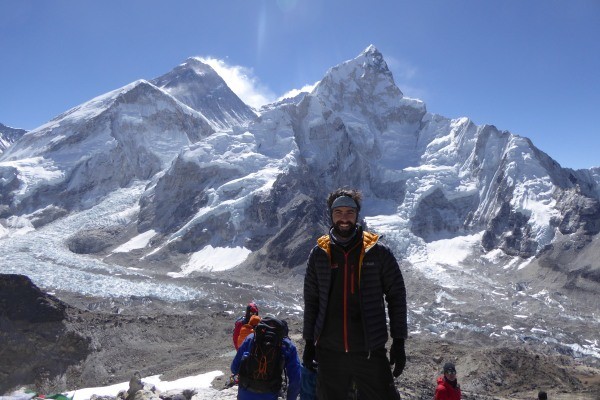
Kala Patthar
Day 10: Trek from Gorak Shep to Kala Patthar and EBC (Return to Dingboche)
A trek from Gorak Shep (5,170 meters) up the steep slopes to Kala Patthar (5,554 meters), a peak west of the Everest Base Camp which affords the best views of Mt. Everest, Nuptse Nup II and Changtse; as well as the northern flank and summit of Lhotse. You will leave Gorak Shep early to reach Kala Patther before the clouds roll in.
On a typical Everest Base Camp trek, Kala Patthar will be the highest altitude you will reach. It is also home to the worlds highest webcam – Mount Everest Webcam. From Kala Patthar, you then descend all the way back to Dingboche (4,360 meters).
Day 11: Trek from Dingboche to Namche
Trek from Dingboche (4,360 meters) to Namche (3,440 meters) via the rhododendron forests around Tengboche.
Day 12: Trek from Namche to Lukla
Trek from Namche (3,440 meters) all the way back to Lukla (2,800 meters) – a long and tiring walk to finish what is an incredible Himalaya trek.
Day 13: Fly from Lukla to Kathmandu
Fly from Lukla to Kathmandu.
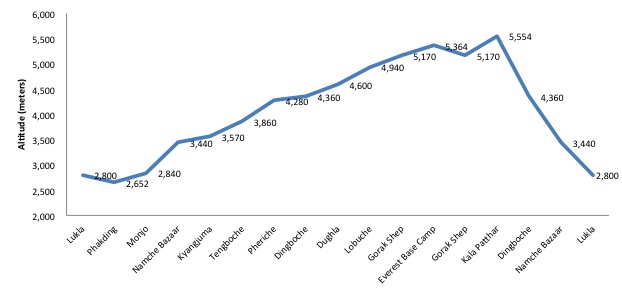
EBC Route Altitude Profile
Above is an altitude profile chart for a typical Everest Base Camp hike. The highest peak is Kala Patthar, at a staggering altitude of 5,554m.
Everest Route Variations
Below are typical route variations for the Everest BC hike.
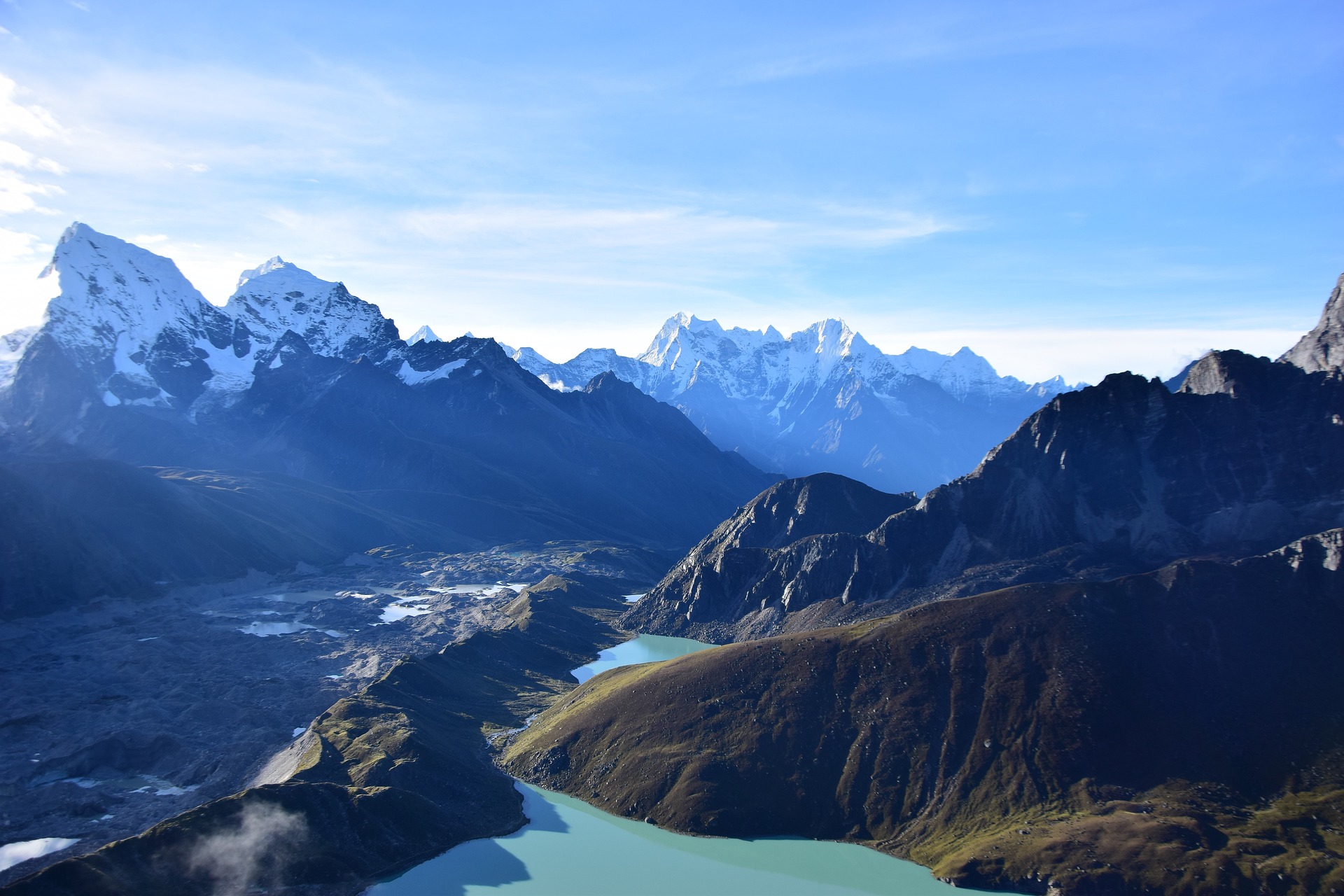
Gokyo-Ri glacier
Gokyo Lakes
The Gokyo Lakes or Gokyo Ri Trek is a fantastic variation on the Everest Base Trek. The route begins in Lukla and follows the traditional EBC trek itinerary for the first three days up to Namche Bazaar. Here it veers off to the North-west via the towns of Dole and Machemo, up to the stunningly beautiful Gokyo Lakes . The trail then ascends Gokyo Ri (5,483 meters) and traverses Cho La Pass (5,420 meters) before joining back up with the classic base camp trek at Lobuche.
The variation adds 2-3 days to an average Everest Base Camp trek but provides an excellent opportunity to avoid the crowds on the busy everest trail, as well as gives one the opportunity to trek up and down on different routes.
Chhukhung Valley
The Chhukhung Valley sits east of Dingboche and provides an alternative and longer passage to Lobuche than the traditional Everest Base Camp trail. Trekkers stay a night in Chhukhung (4,730 meters) before returning to Lobuche via Kongma La Pass (5,535 meters), an epic Himalayan pass .
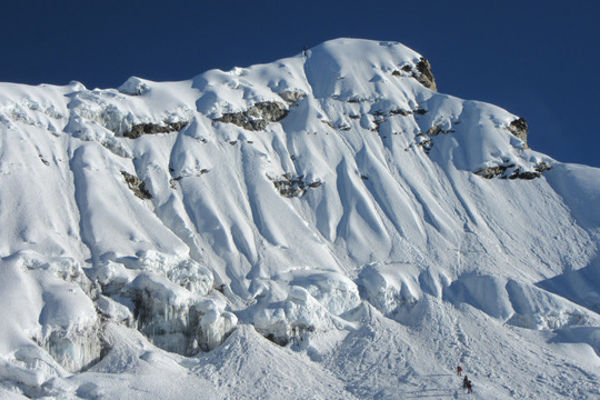
Island Peak headwall
Island Peak
Island Peak is one of Nepal’s 33 trekking peaks. Standing at 6,189 meters, Island Peak is a real challenge in terms of altitude, but only requires beginner level climbing skills (you will need to be comfortable with ice axes and crampons though). Most climbers use the traditional Everest Base Camp trek to acclimatise for Island Peak.
Returning from Everest Base Camp, you can either trek to Cchukhung via Dingboche from Lobuche or veer South-east from Lobuche traversing the Kongma La Pass to Cchukhung (4,730 meters). From here you can trek to Island Peak Base Camp (5,120 meters) in preparation for their trek / climb up to Island Peaks summit. The summit typically takes 2 days and the total trip, including Everest Base Camo, between 18-20 days.
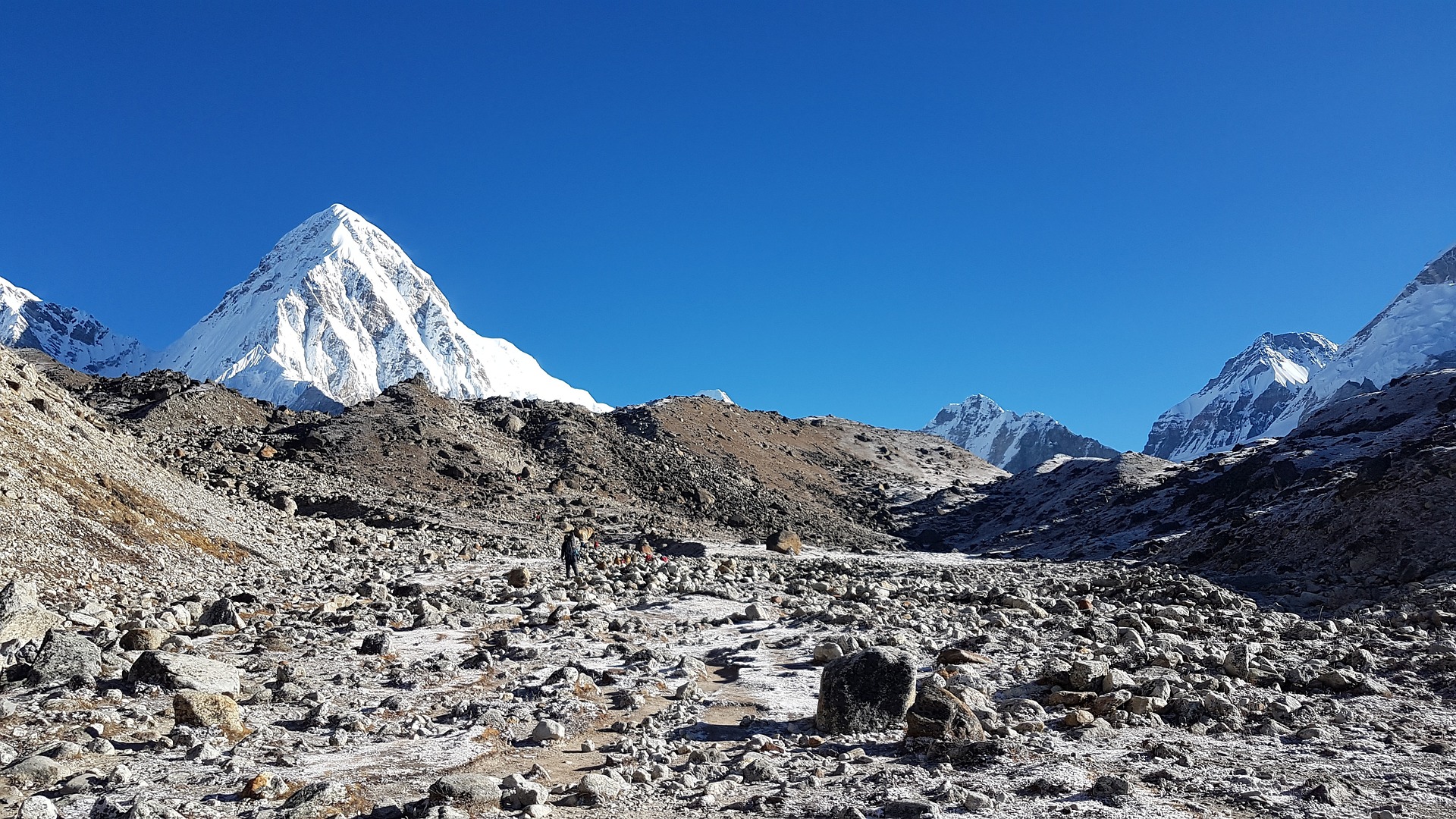
Everest Base Camp Trek FAQ
How much does the ebc trek cost.
Like many treks in Nepal, there are three ways you can plan your Everest Base Camp trek. See more in our guide on a detailed breakdown on the cost of an Everest Base Trek .
Below are four options for Everest Base Camp treks and their estimated costs.
Independent Trekking
Here you organise your trek. You will need to get yourself from Kathmandu to Lukla (a flight is the fastest and easiest; there are buses but these are rather unpleasant). You can employ the services of a porter or guide in Lukla or indeed in Namche, but it is important to note that as an independent trekker, it is illegal to use a guide or porter that is not licensed as a trekking agent through TAAN, or affiliated with a licensed trekking agent. You will need a Green TIMS card (costing NPR 2,000), money to buy food and water, a reliable and accurate map, and negotiations skills to book teahouse accommodation.
The estimated cost for an independent trek excluding flights is between $500-$800.
Local Tour Operator
There are many local tour operators in Kathmandu who organise guided Everest Base Camp treks. Generally local Nepal trekking companies are quite good. You will join a group of trekkers (up to 15 people) and have a team of porters, assistant guides and lead guides (who can speak English) of a similar size to the trekking group.
It is important to check that your local operator is a licensed trekking agent. We recommend shopping around and asking for recommendations from other trekkers. The cheap local operators tend to be the least reliable, often only providing tent accommodation or access to old and poorly run teahouses. Their ethical standards towards staff and the local environment may not be to the highest standard as well.
The estimated cost for an Everest Base Camp trek organised by a local tour operator is between $800-$2,000.
Western Run / Operated Tours
There are many Western run companies that offer Everest Base Camp treks. Most of these Western companies have their own ground teams or strong relationships with the best local tour operators who they outsource their on-the-ground operation to, whilst managing the overall tour experience.
The best Western companies own their on-the-ground operations. Expect a well-run tour with either a Western guide or a very well-trained local guide who understands the subtle service nuances expected of a Western trekker.
The estimated cost for an Everest Base Camp trek organised by a Western run tour operator is between $1,200-3,000.
Everest Climbing Expedition
A fourth option of joining an Everest climbing expedition is also possible. Major climbing operators like Adventure Consultants, Jagged Globe or Alpine Ascents usually offer Everest Base Camp trekking spaces on their Everest climbing expeditions. Securing a trekking space can be a little pricey but offers one an incredible insight into an Everest expedition as well as the chance to spend a night or two at Everest Base Camp.
If you think a base camp trek is expensive, wait till you hear how much it costs to Climb Mount Everest !

Are permits required for the EBC trek?
Yes, there are two permits you require for standard treks from Lukla to EBC. They are:
1. Trekkers Information Management System (TIMS Card)
TIMS cards are issued by the Tourism Agency Association of Nepal (TAAN). There are three different types:
- Organised TIMS Card (Blue in colour, USD 10). If you are trekking with an organised tour these will be arranged for you. You will need to provide your passport number and one passport photograph
- Individual TIMS Card (Green in colour, USD 20). If you are trekking independently (without support) you will need to get one of these TIMS cards from the Nepal Tourism Board in Kathmandu
- SAARC Country TIMS Card (Red in colour, USD 3). These cards are for nationals from the South Asian Association for Regional Cooperation, i.e. India, Bhutan, Pakistan, Sri Lanka, Maldives, Bangladesh and Afghanistan.
2. Sagarmatha National Park Entry Permit (USD 30 + 13% Govt. Tax)
The Sagarmatha National Park or Solukhumbu is the region through which the EBC trek runs. A National Park entry permit is required to enter Sagarmatha. Permits can be acquired at the first checkpoint along the route, north of Lukla called Monjo. The cost is US$30 + 13% tax for trekkers using a trek operator or agency, as well as for independent trekkers. Permits can also be acquired in Kathmandu, but we recommend getting it in Monjo as it is more straightforward.
For treks from Jiri to Everest Base Camp, there is another permit required called the Gaurishankar Conservation Area Project permit. It costs US$20 (no discount for independent trekkers or SAAEC nationals). The checkpoint is at at Shivalaya (just after Jiri). We recommend getting the permit in Kathmandu before departing as the cost is double if they have to issue the permit in Shivalaya.
As a rule of thumb, we recommend bringing at least 4 passport size photographs for all your permit requirements.
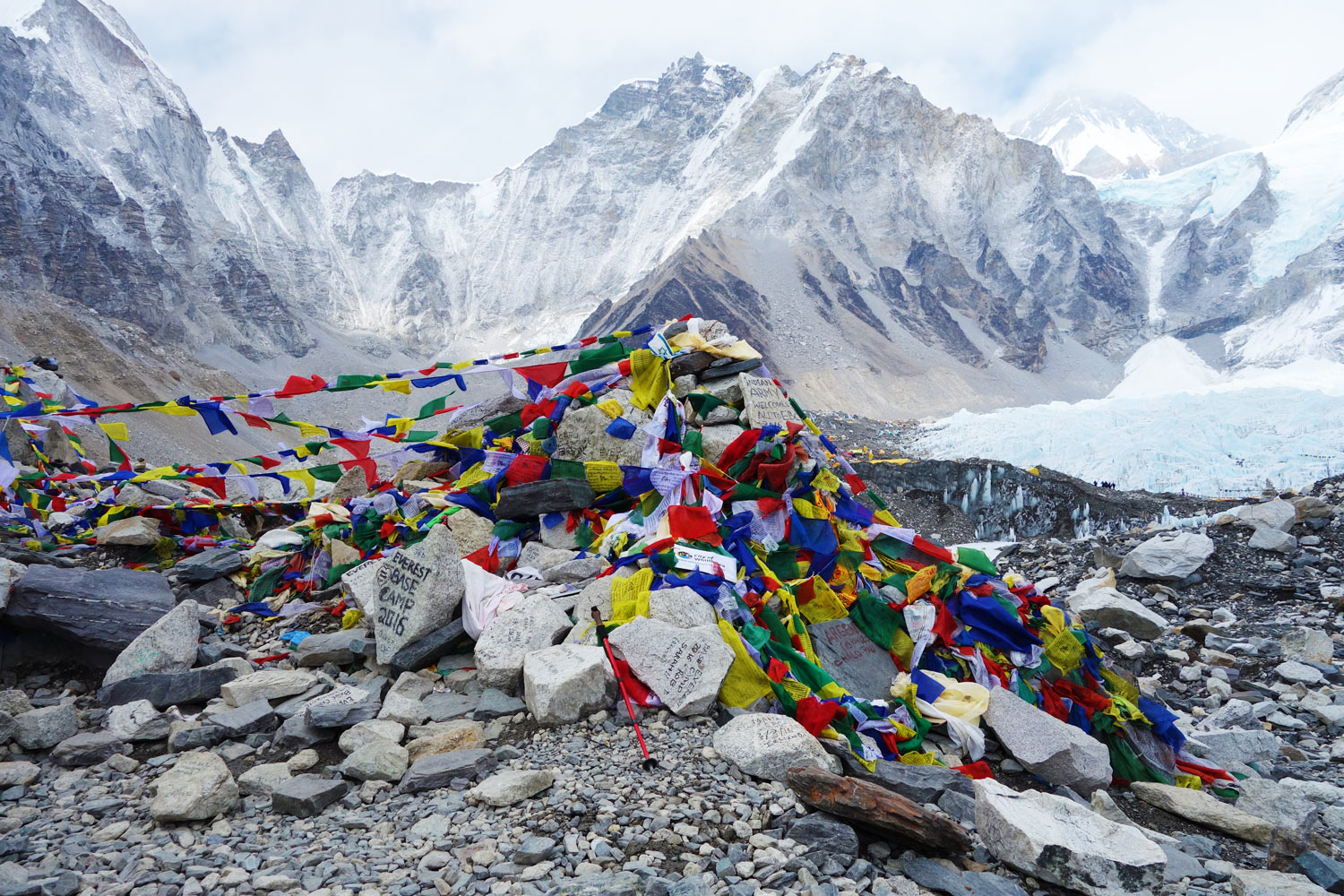
When is the best time to trek to Everest Base Camp?
The best time to trek Everest Base Camp is during the dry and warm months of September through November of March through late May / Early June.
The monsoon rains arrive in mid-late June and get into full swing for the months of July and August (as seen in the average rainfall map below). The route is really too wet for trekking and you would be better placed to explore treks in rain shadow areas like the Upper Manang, Mustang, Annapurna or Dolpo region.
December, January and early February are very cold. Treks run during these periods but be prepared for freezing temperatures and possible snow flurries. The upside is that the route is a lot quieter than in the peak seasons.
The chart shows average temperatures and rainfall in Nepal (data from 1960-1990 compliments of the Climate Change Knowledge Portal at the World Bank ).

Is altitude sickness a risk on the Everest Base Camp hike?
Yes, altitude sickness is a risk on the Everest Base Camp route. The trek takes one from a moderately high altitude, 2,800 meters in Lukla, to high altitude, over 5,300 meters at Everest Base Camp and over 5,500 meters at Kala Patthar. At these higher altitudes, the body needs to have acclimatised to the lower saturation of oxygen in the air in order to avoid the symptoms of altitude sickness (or what is sometimes referred to as Acute Mountain Sickness – AMS).
The good news is that a typical Everest Base Camp hike has a slow ascent profile which maximises the amount of time available to acclimatise. Nonetheless, every year 100s of people suffer altitude sickness symptoms and some need to cut their trek short due to more severe complications.
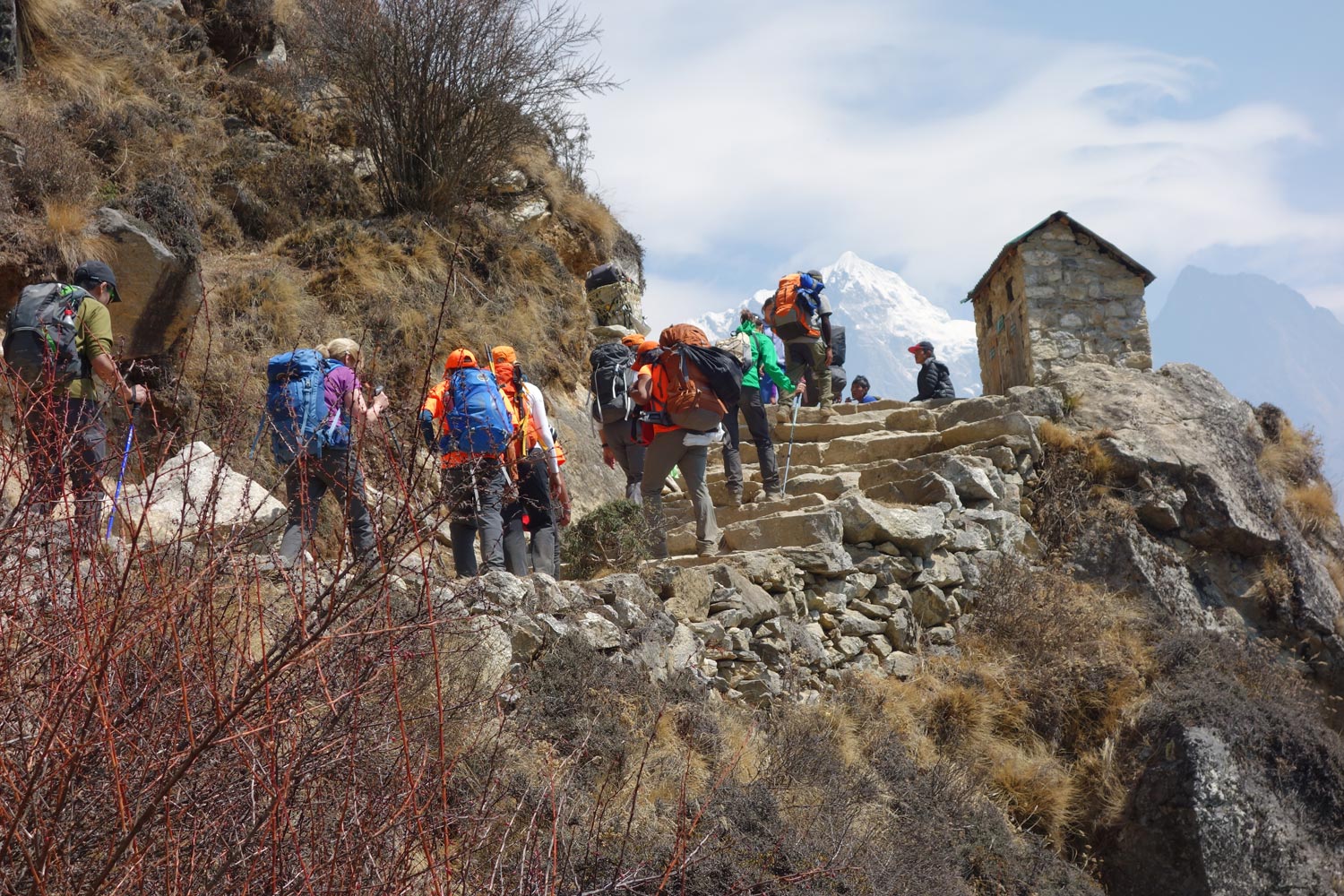
How difficult is the Everest Base Camp Trek?
The difficulty of the Everest Base Camp Trek is relatively low. It should be noted that the Everest Base Camp trek requires no climbing expertise and there are certainly no technical climbing sections. With determination and a basic fitness level, you should be able to trek the route. We have seen old and young, overweight and underweight complete the trek – all with a smile on their face!
With that being said, there are certainly some factors that should be considered prior to your trek, such as altitude, length and training that will enable you to better understand what you are getting yourself into before deciding.
What gear do I need for the EBC Trek?
One of the most frequent questions that we get asked is what gear should be packed for an Everest Base Camp trek.
To make your life a lot easier we have written a very detailed Everest Base Camp packing list article. The list is fairly exhaustive but includes all the absolutely necessary items of clothing and outdoor gear that you should bring with you.
You will have the opportunity to either buy or rent gear in Kathmandu, Lukla or even in Namche Bazaar, but in general we recommend you bring with you the main items (i.e. hiking daypack , hiking boots, warm down jacket, sleeping bag and sleeping mat , trekking poles , appropriate trekking clothes, headgear and headlamp and gloves etc.)
What travel insurance do I need for the EBC hike?
Trekking Everest Base Camp comes with obvious risks. We recommend you get travel and trekking insurance for all treks in Nepal .
On the Everest Base Camp route, you will reach a maximum altitude of 5,416 meters, so it is important you choose an insurance package that covers you up to that altitude.

Are there any recommended guidebooks for the Everest Base Camp Trek?
Absolutely. There are some great guidebooks and trekking maps to choose from when doing the Everest Base Camp Trek.
The classic EBC trail itself is well-worn, but there are many smaller yak trails that can confuse people.
We recommend taking a detailed trekking map. The region is sparse, and it is possible to get lost in the many valleys that lie on either side of the main trail. The most recent Lonely Planet Trekking in the Nepal Himalaya provides the most up to date information and maps of the region.
Sian Pritchard-Jones and Bob Gibbons’s book: A Trekking Guide to Everest is also rather good.
For a more general guide to Nepal, you may want to check out the Nepal Lonely Planet Travel Guide .
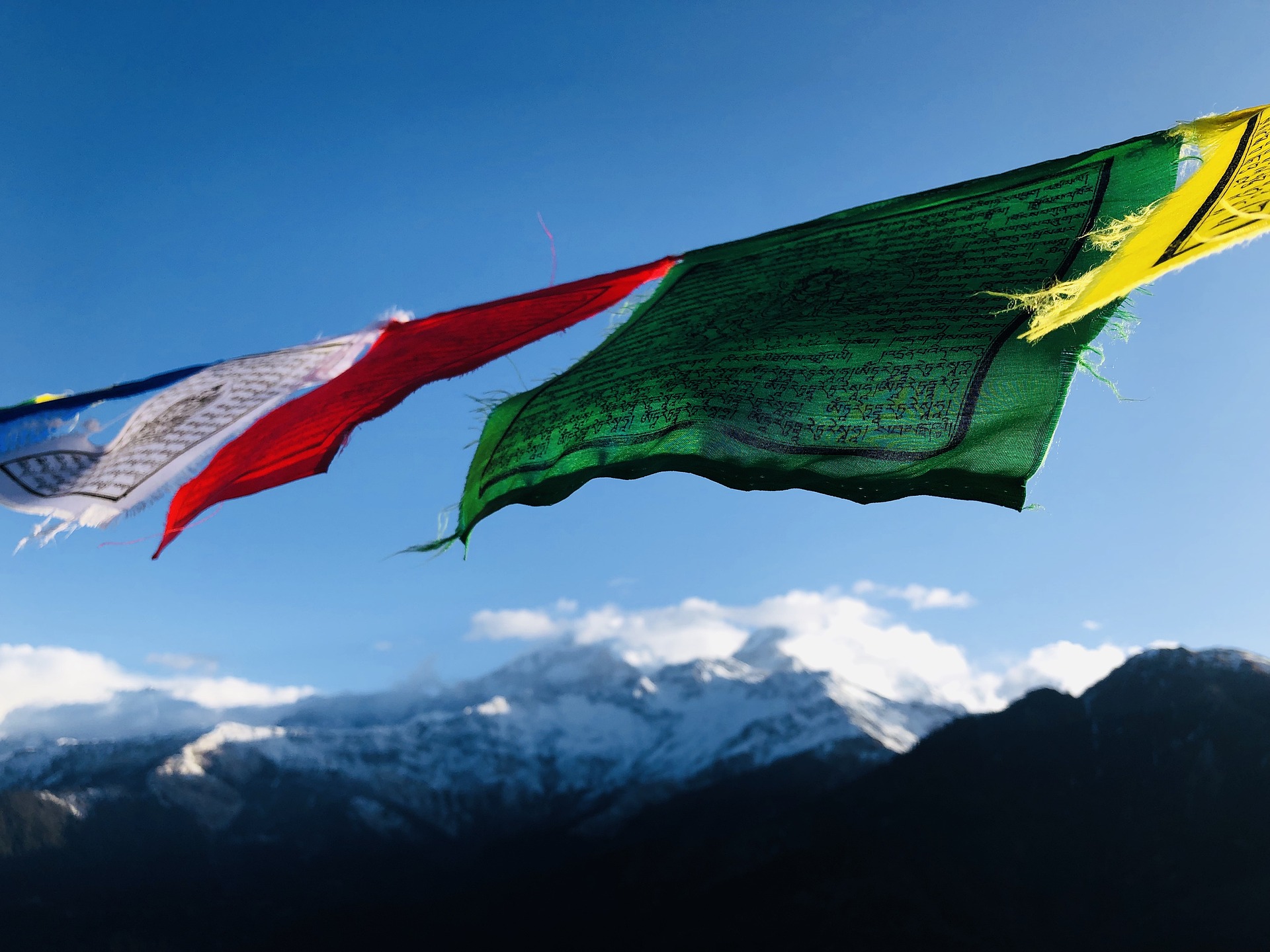
Are there any other hikes in Nepal you would recommend?
Yes, there are many other hikes in Nepal that I love.
Some of the most popular alternative Nepal trekking routes are the Annapurna Circuit Trek , the Langtang Valley Trek and the Manaslu Circuit Trek . If you're looking for some easy Nepal hikes , then check out the Poon hill hike or the Royal hike . For short Nepal hiking routes see the Helambu hike , which is near Kathmandu.
Continue browsing
See more information on Nepal . Or check out these other Everest/Nepal articles:
- Best Climbing Mount Everest Tips
- Food on the Everest hike
- Internet Access on EBC hike
- Everest Base Camp Trek Deaths and Statistics
- Best Places to Visit in Nepal
- What to Expect in Nepal Tea Houses
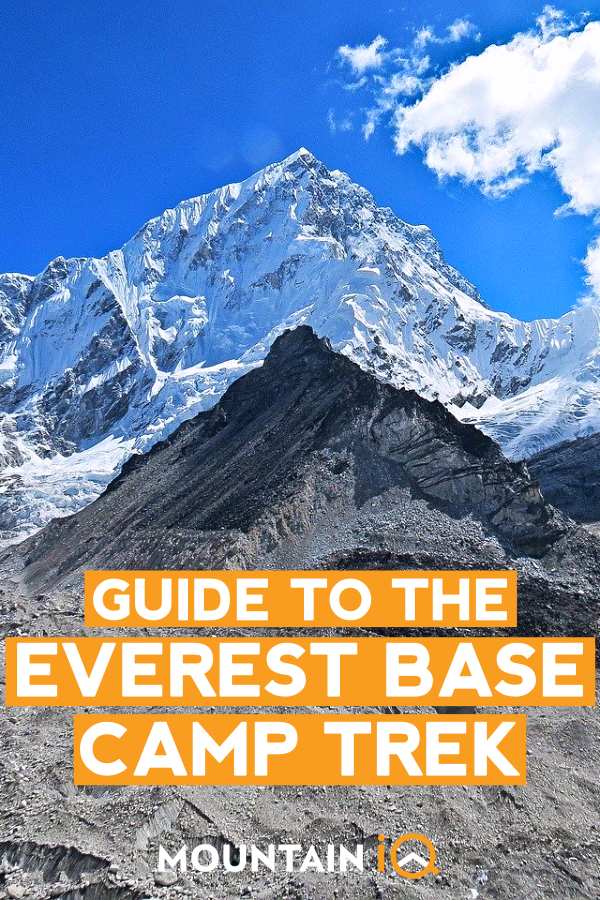
About the author
Mark Whitman
Mark has trekked extensively in Asia, Europe, South America and Africa. He founded Mountain IQ in 2014 with the sole aim to be the best online information portal to some of the most popular mountain destinations around the world. When not writing for Mountain IQ, Mark is out exploring the outdoors with his wife!
Leave a Reply
Your email address will not be published. Required fields are marked
Nice article. Full of true information and very supportive for new trekkers.
We work with local guides to offer great value adventures at unbeatable prices
Book with confidence .
15% off on EBC Trek for 2024

Everest Base Camp Helicopter Return Trek
Everest Base Camp Short Hike -11 Days
Jiri to EBC Trek
Gokyo Lakes Trek
- Manaslu Circuit Trek
- Annapurna Base Camp Trek with Helicopter Return
Everest Base Camp Trek
- Ghorepani Poon Hill Trek
Everest Three High Passes Trek
- Makalu Base Camp Trek
- Annapurna Circuit Trek
- Annapurna Base Camp Trek
Everest Round Trek
- Annapurna Panorama Trek
- Short Annapurna Base Camp Trek
- Tsum Valley with Manaslu Circuit Trek
- Tamang Heritage Trail Trek
- Mustang Tiji Festival Trek
- Helambu Trek
- Langtang and Gosaikunda Lake Trek
- Nepal Family Adventure Tour
- Annapurna Circuit with Tilicho Lake Trek
Everest Base Camp Luxury Trek
- Jomsom to Muktinath Trek
- North Everest Base Camp and Lhasa Tour
- Kailash Mansarovar Tour
- Khopra Ridge Trek
EBC, Gokyo and Chola Pass Trek
- Ghorepani Poon hill Luxury Trek
- Mount Everest Panorama View Trek
- Mardi Himal Trek
- Short Mardi Base Camp Trek
- Bhaktapur Day Tour
- Nepal Culture Tour
- India and Nepal Tour
- Sikkim and Darjeeling Tour
- Bhutan Cultural Tour
- Nepal Tibet Bhutan Tour
- Lhasa to Kathmandu Tour
- Kathmandu Day Tour
- Annapurna Family Hike
- Chandragiri Hill Short Hiking
- Nagarkot Hiking Tour
- Chisapani Nagarkot Hiking
- Short Annapurna Luxury Trek
Mount Everest Flight in a Helicopter
- Pokhara Day Tour
- Pisang Peak Climbing
- Lobuche Peak Climbing with EBC
- Mera Peak Climbing
- Island Peak Climbing with EBC
- Chitwan National Park Tour
- Nepal Adventure Photography Tour
- Nepal Photography Tour
- River Rafting Tour
- Mountain Biking Tour of Mustang
- Upper Mustang Jeep Tour
- Everest Base Camp Trek - 14 days
- Everest Base Camp Luxury Trek - 16 days
- Everest Base Camp Short Hike - 11 Days
- Everest Three Passes Trek - 20 days
- Everest Gokyo Lake Trek - 12 days
- Everest Base Camp Heli Trek - 12 days
- Mount Everest Helicopter Flight -1 Day
- Everest Chola Pass Trek - 18 days
- Jiri to EBC Trek - 20 Days
- Everest View Trek - 07 days
- Everest Trekking Trip (3 High Passes, EBC & Gokyo Ri) - 19 Days
- Dhaulagiri Circuit Trek - 20 days
- Kanchenjunga Base Camp Trek - 24 days
- Makalu Base Camp Trek - 18 days
- Pikey Peak Trek - 09 days
- Annapurna Base Camp Trek - 15 days
- Short Annapurna Luxury Trek - 08 days
- Short Annapurna Base Camp Trek - 6 days
- Annapurna Panorama Trek - 10 Days
- Annapurna Circuit Trek - 18 days
- Annapurna Family Hike - 09 days
- Annapurna Base Camp Helicopter Trek - 10 days
- Ghorepani Poonhill Luxury Trek - 08 days
- Mardi Himal Trek - 10 days
- Short Mardi Himal Trek - 08 days
- Ghorepani Poon Hill Trek - 10 days
- Annapurna Tilicho Lake Trek - 17 days
- Khopra Ridge Trek - 13 days
- Island Peak Climbing - 17 days
- Lobuchhe Peak Climbing - 19 days
- Mera Peak Climbing - 20 days
- Pisang Peak Climbing - 20 days
- Tsum Valley Trek - 17 days
- Manaslu Circuit Trek - 14 days
- Tsum valley with Manaslu Circuit Trek - 21 days
- Jomsom to Muktinath Trek - 14 days
- Upper Mustang Trek - 18 days
- Upper Mustang Jeep Tour - 10 days
- Mountain Biking Tour -10 Days
- Mustang Tiji Festival Trek - 17 days
- River Rafting Tour - 05 days
- Langtang Valley Trek - 11 days
- Langtang Gosaikunda Trek - 14 Days
- Tamang Heritage Trail Trek - 10 days
- Helambu Trek - 09 days
- Chisapani Nagarkot Hiking – 03 Days
- Nagarkot Hiking Tour - 01 day
- Chandragiri Hill Short Hiking - 01 day
- Kathmandu Day Tour – 5-6 Hour
- Pokhara City Tour – 04 Hour
- Chitwan National Park Tour - 03 Days
- Nepal Cultural Tour - 7 Days
- Why Heaven Himalaya?
- Company Overview
- Our Mission
- Responsible Tourism Statement
- Legal Document
- Cookies Policy
- How to Book a Trip with Us
- How to Make a Payment
- Book With Confidence
- How to get to NepaL?
- Trek Grading
- Flight Delays in Nepal
- Packing List for Trekking
- Best Time to Trek in Nepal
- Geography of Nepal
USD $1399 $1520 Per Person
- Trip Overview
- Cost And Dates
- Includes/Excludes
- Photo Gallery
- Clients Reviews
Trek through Nepal's iconic landscapes in Khumbu to Everest Base Camp (5,364 m/17598 ft.), explore the Khumbu glacier, climb Kala Patthar (5,545 m/18,192 ft.), and back to Kathmandu in just 14 days.
- Trip Grade: Moderate
- Max Elevation: 5550 M
- Max Group Size: Min. 1 Person
- Best Time: March - May & Sep - Dec
Group Discounts
We would like to inform you that Lukla's domestic flights from Kathmandu are diverted to Ramechhap Airport during the popular trekking months (including March, April, May, October, and November) because of the air traffic congestion in Kathmandu. Thus, if you're planning a trip during these months, we will have to drive 4-5 hours from Kathmandu to the Manthali Airport in the Ramechhap district to board the flight to Lukla. During the remaining months (including January, February, June, July, August, September, and December) , you will have a normal flight from Kathmandu to Lukla .
Please be aware that Lukla flight decisions solely depend on the airlines and the Civil Aviation Authority in Nepal. Further, weather complications, natural calamities, and airport traffic congestion are some reasons for the delay or cancellation of flights.
Thus, in such cases, you have two options: either take a helicopter ride from Kathmandu or increase the itinerary time frame. The emergency fund we mentioned above comes in handy in such situations. We do not cover the helicopter ride or extra days. We hope the weather is good every day. But if the situation persists and you have no option for either a helicopter ride or extra days, then our team will work with you to arrange alternate plans.
Kiandra Buchanan
EBC Trek Major Highlights
Looking for the highlights of the Everest Base Camp trek? Well, there are many:
- You take a trip to the Khumbu District of Nepal on an energizing and picturesque trip to Lukla.
- We pass an all-around, stamped trail to the Everest Base Camp, with fascinating Sherpa towns up and down the route.
- It is a chance to learn about Sherpa individuals, their conventional culture, and their way of life.
- The trail runs over the fringe of Sagarmatha National Park, a recreation center that stretches out over a wide scope of geological and altitudinal districts enhanced with assortments of vegetation and fauna.
- Namche Bazaar, a vivacious town in the Khumbu District of Nepal, is the only entryway to the Mount Everest region.
- Tengboche Religious Community—a spiritual focus while in transit to Everest Base Camp
- Everest Base Camp, the base camp of the world's highest mountain, Mount Everest (8848.86 m),
- Hike to Kala Patthar, from where one can enjoy the sunrise views amid the panoramic views of the mountains in the Everest region.
- Mesmerizing views of mountains, Gokyo lakes, glaciers, and Everest district from over the sky
Everest Base Camp Trek Overview
The Everest Base Camp Trek, also known as the EBC Trek, is a comprehensive trekking package that takes you from Nepal’s capital to the south base camp of Mount Everest.
Adventurers worldwide have this hike high on their bucket lists because it offers a magnificent close-up view of towering Mount Everest (8848.86 m), the world’s highest peak. Not only that, you get stunning views of surrounding peaks like Cho Oyu (8188 m), Lhotse I (8516 m), Nuptse (7861 m), Pumori, and Ama Dablam.
Our EBC trek also allows you to explore the hidden gem in Khumbu, the attraction center of the Himalayas. You will witness the stunning views of the Khumbu glacier . It’s a heavenly joy. During peak climbing season (March–May, and September–November), you get to catch a glimpse of the colorful tents set up by mountaineers against the backdrop of the vast landscape.
Are you one of the fortunate hikers willing to seize the opportunity to book our 14-day trekking itinerary to Everest Base Camp?
This is your moment.
At Heaven Himalaya, we have experienced high-altitude mountain guides who have led countless trekking groups to the base camp. Since our establishment, we have helped over 1,000 adventurers complete their EBC trek. Our travel packages are available for tourists of all ages and are customizable according to fitness levels.
First, you fly to Kathmandu, the capital of Nepal. Next, you take a flight to Lukla Airport, either from Ramechhap or Kathmandu. After Lukla, the trail takes you through Sherpa villages such as Phakding, Namche Bazaar, Tengboche, Dingboche, Lobuche, and Gorakshep, ultimately leading you to Everest Base Camp.
The two best months for a walking tour to EBC are generally April and October due to favorable weather conditions.
As for the difficulty of the Everest Base Camp Trek, it is considered a moderately challenging hike on a well-established trail. However, it does involve walking in mountainous terrain and at high altitudes.
Route Choices for the EBC Trek
There are two base camps, the North (5,150 m) and South (5,364 m), and the southern part of Nepal is more popular than the Chinese side, which requires a complex permit system.
The EBC Trek in Nepal is one of the most popular adventure trips worldwide, with multiple routes available to choose from based on your length of stay, adventure plans, and determination.
The traditional walking route to EBC starts in Jiri and leads to Lukla. But our standard Mount Everest Base Camp Trek begins at Lukla and passes through villages like Phakding , Namche, Tengboche, Lobuche , and Gorakshep to reach the base camp. It’s a more popular route, making it relatively safer. Thus, you encounter several fellow trekkers and tourists on the way.
In this travel package, we offer the classic and most popular Everest Base Camp Trek itinerary, which is a fantastic choice for any adventurer.
One-way Everest Base Camp Trek with Helicopter return to Kathmandu
Suppose you have fewer days available or are reluctant to exhilarate your body harshly via long days of trekking activity. You can use a helicopter to return to Kathmandu after your base camp summit. There’s a helipad near Gorakshep (5164 meters) from where you fly directly to Kathmandu airport.
This is a more comfortable and relaxing way to experience trekking to the highest mountain.
The Best Everest Base Camp Tours and Alternate Trekking Packages
The Mount Everest Base Camp Trek is an incredible journey that offers breathtaking views of the landscape, mountains, and hills. You experience the chill of fresh mountain air coming down from the world’s tallest peak during this once-in-a-lifetime trek. If you have time constraints, then we have an 11-day short Everest Base Camp Trek .
For those seeking an even greater challenge, you can choose to go on an amazing Mt. Everest expedition or heli tour up to or from the base camp. We also have other trekking tours that include a tour of the EBC, such as the Three High Passes Trek , EBC, Gokyo, and Chola Pass Trek .
If you’re looking for a luxurious experience during the EBC Trek in Nepal, we offer a luxury lodge trip with 5-star hotel accommodations. Alternatively, if you’re short on time or want a more comfortable trek, you can take the Everest Base Camp Trek with a helicopter return . With this, you trek to base camp and fly back to Kathmandu after the tour.
Finally, for those who want to climb the 6,000-meter peaks along the way, we allow Island Peak Climb after the EBC hike .
All the Mount Everest trips that connect with the base camp offer new, raw experiences. However, the several interconnected and challenging trails may confuse you, leading you to get lost. Nevertheless, the end product is worth it.
With us, you can join a group tour or take a private trip.
When you choose to book an Everest Base Camp trek package with Heaven Himalaya, you'll already be ahead of other trekkers in terms of service and benefits.
A local mountain trekking guide with extensive knowledge of the routes will accompany you. Booking with us means you'll walk with Sherpa locals and support their livelihood.
While foreign companies offer similar trips to Everest Base Camp, they can't do it on their own. They hire government-registered companies like us in Nepal. Booking with them means you'll pay intermediaries' fees out of your pocket.
By planning your trip with us, you'll pay the lowest cost with no commission fees. Additionally, you'll benefit from:
- A focus on clients' safety, with our trip organized with the utmost safety in mind
- The best price guarantee
- Free transfers from the airport to the hotel and back in a private vehicle
- Trained, government-licensed local guides who have an entire knowledge of local routes
- Support for locals to earn their living through tourism
- An oximeter for monitoring oxygen levels while on a high-altitude EBC trek
- Guides with medical kits to handle situations that may arise
- Arrangements for sleeping bags and down jackets
- Free storage at the Heaven Himalaya office store for extra luggage during your tour
- A duffel bag to transfer your items from luggage to be carried during the journey
- A free porter to help carry your heavy bags.
If the 14-day EBC itinerary doesn't fit your vacation timeframe and you would like a bespoke itinerary for the Everest Base Camp Trek, then please let us know. We can help you with that as well.
Quick EBC Trek Itinerary
Day 01: Arrival at international airport in Kathmandu (1,400 m) and transfer to hotel. Overnight at a hotel.
Day 02: Flight to Lukla (2,840 m) from Kathmandu – 35 minutes or drive to Manthali/Ramechhap (474 m) – 5 to 6 hours and a 20 minutes flight to Lukla, and then trek to Phakding (2,652 m) – 3 to 4 hours. Overnight at a guesthouse.
Hiking trail distance: 9.3 kilometers (5.8 miles) approx.
Day 03: Trek from Phakding to Namche Bazaar (3440 m/11283 ft) - 6 hours. Overnight at a guesthouse in Namche
Hiking trail distance: 9.4 kilometers (5.84 miles) approx.
Day 04: EBC Acclimatization or the Rest Day
Early morning, you will hike to Everest View Hotel (3,962 m/12995 ft.) - 3 to 4 hours and descend to Namche. Overnight at a guesthouse in Namche
Day 05: Trek from Namche Bazaar to Tengboche (3860 m/12680 ft.) - 5 hours. Overnight at a guesthouse.
Hiking trail distance: 9.2 kilometers (5.72 miles) approx.
Day 06: Trek uphill from Tengboche to Dingboche village (4410 m/14464 ft.) - 5 hours. Overnight at a guesthouse
Hiking trail distance: 9.1 kilometers (5.65 miles) approx.
Day 07: EBC Acclimatization Day or rest day
Hike to Nagerjun Hill and come back to Dingboche - 4 to 5 hours. Overnight at a guesthouse.
Day 08: Trek from Dingboche to Lobuche (4910 m/16105 ft.) - 5 hours. Overnight at a guesthouse.
Hiking trail distance: 11 to 12 kilometers (6.8 to 7.5 miles) and straight line distance: 7 km (4.3 miles).
Day 09: Trek from Lobuche to Gorakshep (5181 m/16990 ft.) and then to Everest Base Camp (5364 m/17594 ft.), and descend to Gorakshep again - 8 hours. Overnight at a guesthouse.
Day 10: Trek from Gorakshep to Kala Patthar (5545 m/11283 ft.) and back, then descend to Pheriche (4210 m/13810 ft.) during the day - 7 hours. Overnight at a guesthouse.
Day 11: Descend from Pheriche to Namche (3440 m/11283 ft.) - 7 hours. Overnight at a guesthouse.
Day 12: Descend from Namche to Lukla (2800 m/9184 ft.) - 7 hours. Overnight at a guesthouse.
Day 13: Fly back from Lukla to Kathmandu/Ramechhap Airport and then transfer to a hotel in Kathmandu
Day 14: Farewell and drive to Kathmandu Airport for final departure.
EBC Trek 2024/2025 Cost and Dates
Our Everest Base Camp Trek costs include all-ground costs, fully personalized benefits, and a free porter. We are a local tour operator, so the quote you get is the best price, with no mid-commission fees.
Kindly note that the Start Dates are your dates of arrival in Nepal, and your End Dates are the dates of leaving Nepal.
We specially quoted and specified the below list of Everest Base Camp Trek start dates for the group joining option. Let us know if the below start dates do not work for you—we will surely add your available days to fit your interest.
Besides, the trekking fees mentioned here cover your 14-day itinerary. An additional cost will be generated if you have extra days in Kathmandu or would like to add or subtract the number of trekking days.
Read the cancellation and rescheduling terms and conditions .
Upcoming Trip Start Dates for Mount Everest Base Trek
- Guaranteed - We guarantee a Gokyo trekking trip to run.
- Available - The trip is available to run when the minimum group size is met.
- Limited - Hurry, o nly a few seats are available.
EBC Trek Trip Inclusion
- Cost Includes
- Cost Excludes
- Round-trip flight (Kathmandu-Lukla) with departure taxes
- All ground transportation for the entire Mt. Everest Base Camp Trek on a private vehicle, including the airport transfers.
- 2 nights' accommodation in a 3-star category hotel in Kathmandu with a breakfast plan
- 12 nights and 13 days of accommodation in the best guesthouses available (on a twin-sharing basis) after leaving Kathmandu until you are back here again. We also provide personal bathrooms with hot showers in Phakding, Lukla, and Namche.
- 12 daily meals with breakfast, lunch, and dinner throughout the EBC trekking journey
- Snacks of fresh, seasonable fruits on the trekking days
- National Park and Heritage Sites entry tickets
- Two trekking permits (SNP and KPL Rural Municipality Permit)
- A licensed, English-speaking, experienced Everest trekking guide
- Porters to carry your baggage during your Everest journey (1 for two clients)
- All the costs for food, accommodation, salary, and other equipment for the guide and porter, including accidental insurance
- Duffel bag and sleeping bags to use during trekking
- Heaven Himalaya T-shirts, route map, and a travel completion certificate
- All paperwork and other applicable government taxes and service charges.
- First aid kit
- Meals (lunch and dinner) in Kathmandu
- International airfare
- Travel Insurance
- Soft drinks, including mineral water bottle
- Personal refreshment items like cold drinks, snacks, etc.
- Personal utility items like laundry, telephone expenses, electricity charges, etc.
- Hot showers in other places along the route except in Namche, Phakding, and Lukla.
- Personal Everest Base Camp Trekking Gear
- Internet, or phone calls unless they're free to use.
- Tips for guides and porters
Everest Base Camp Trek Itinerary
Please find below the day-to-day itinerary for the Everest Base Camp Trek. This itinerary guide will give you a general idea of how to go to EBC.
Day 01: Arrival in Kathmandu, Nepal, at Tribhuvan International Airport
Welcome to the capital city of Nepal, Kathmandu. The valley is the land of pure mysticism and spirituality. Kathmandu is known as the "city of temples." Whether you come by road or by air, our representative will greet and warmly receive you.
If you come via air, our staff will wait for you outside of the airport terminal. Please look for someone with a placard with your and the company’s names written on it. After he or she welcomes you, they will then support you with the transportation to transfer from your booked hotel to Kathmandu.
You will have nothing planned for the day, so take a rest and gather the energy to walk on the trails. Otherwise, if you have some personal gear to buy, you can go shopping in Thamel in the evening. You will spend a night in a hotel.
Accommodation: Hotel Meal: Breakfast (included)
Day 02: Flight to Lukla and start EBC trekking to Phakding (2652 m/8699 ft); walking duration: 3 hours.
After breakfast at the hotel, our guide will come to pick you up for an exciting flight to Lukla. All the flights to Lukla will either be from Kathmandu Airport or Ramechhap Airport and are scheduled in the morning. It’s because the wind picks up in the afternoon and it becomes hard to fly.
The flight to Lukla is itself a rare adventure and will chill your bones. As soon as you leave Kathmandu, you will be greeted by the green hills and the surrounding mountains. The scenery is worth watching. The Tenzing Hillary Airport is one of the most extreme high-altitude airports in the world. So, flying between the high green hills and landing on a narrow lane at the base of the mountains will surely skip your heart a bit.
After a thrilling flight, you will start your trek to Everest Base Camp. Before the start, you will meet porters at the airport who will carry most of your loads.
After you make yourself ready, the tour guide will make his way along the busy street to the start of the trek down to Phakding. You will walk along the Dudh Koshi River and the alpine forest with the amazing sounds of nature. You will then cross the suspension bridge to reach Phakding. Walking above the swinging bridge will add a thrill to your journey.
Then, head to a local teahouse and rest your bags. Later, visit nearby villages or chill in the teahouse. We will have a long hiking day tomorrow. So, take enough rest. Tonight, you will spend your time in the best guest house available.
Flight Duration: 30 Minutes Walking Distance: 8 kilometers Duration: 3 hours Accommodation: Guest House Meal: Breakfast, Lunch, and Dinner (Included)
Day 03: Phakding to Namche Bazaar (3440 m/11283 ft), duration: 6 hours
After breakfast, you will start your Everest trekking journey and make your way to Namche Bazaar. It’s a strenuous walk uphill, but the beautiful scenes, pristine air, and the quest to reach the top keep you going.
We will stop multiple times on the way to soak in some stunning views. As you reach Monjo, you will pass Sagarmatha National Park, a UNESCO World Heritage Site. The national park is rich in endangered flora and fauna. If you are lucky, you will have a glimpse of some.
On the way to Namche, you pass some attractive Sherpa villages, Monjo, and Jorsale. Namche Bazaar itself is an attractive town in the Khumbu region of Nepal.
Known as the gateway to Everest, Namche is a Sherpa town where you can do your last-minute shopping. The place has various shops, cafeterias, a cyber café, hotels, lodges, and guest houses. The banks, ATMs, money exchanges, and lively local markets invite tourists traveling to the Everest Region of Nepal.
Tonight, you will end your day at a local teahouse owned by the Sherpa family. Enjoy a hot shower and a delicious dinner before you go to sleep.
Walking Distance: 10–12 kilometers Walking Duration: 6 Hours Accommodation: A local tea house (owned by the Sherpa family). Meal: Breakfast, Lunch, and Dinner (Included)
Day 4: EBC Acclimatization Day: Hike to Everest View Hotel (3,962 m/12995 ft.), walking distance of 3 to 4 km, duration of 3 to 4 hours.
Today is the rest day for your body. It’s a day kept aside for adapting to a new environment at Namche Bazaar. In the days to come, you will trek to high altitudes with thin air so it’s very important to make your body adapt to a new environment. Your guide will take you around Namche to the viewpoint and Sherpa Museum.
Following the panoramic views of the highest mountains, you will hike to the Everest View Hotel, one of the highest-situated hotels in the world.
The views are clearer as you hike uphill. Enjoy the spectacular views of the majestic mountains, Ama Dablam, Mt. Everest, Lhotse, Nuptse, Thamserku, Khumbila, and Kwangde, from the place near the hotel. And then we head down to Namche, as it’s an acclimatization day, so we won’t be gaining altitude.
Later today, you will visit the Everest Photo Gallery, Museum, and many more in Namche.
Spend a night at a guesthouse in Namche.
Walking Distance: 3–4 kilometers Duration: 2–3 hours Accommodation: Guest House Meal: Breakfast, Lunch, and Dinner (Included)
Day 5: Trek to Tengboche (3860 m/12680 ft), a walking distance of 10 to 11 km, duration of 5 hours
Leaving Namche, we follow a trail to Tengboche. Trekkers refer to the track from Namche to Tengboche as the most scenic hiking route in the entire Everest Base Camp Trek.
At first, we descend to the Dudh Koshi Valley at Phungi Thanka and make our way uphill to Tengboche at a slow pace. You will be officially standing between the mountains.
Mt. Ama Dablam, Mt. Lhotse, Mt. Nuptse, and Mt. Everest are some of the highest mountains that will watch you hike the beautiful trail. You will hike across the Imja Khola to the spiritual center of the Khumbu Region, Tengboche.
At Tengboche, you visit the famous Buddhist shrine, Tengboche Monastery. It’s an old monastery at a high altitude that offers some incredible views of the Everest region. Make sure you see the amazing murals and statues in the monastery.
Further, one can see Ama Dablam just above the monastery. Surrounded by pines and azaleas and backed up by Ama Dablam, one cannot imagine a location more beautiful than this. Tonight, you will spend a night at Tengboche, a locally operated guest house.
Walking Distance: 10–11 kilometers Duration: 5 hours Accommodation: Guest House Meal: Breakfast, Lunch, and Dinner (Included)
Day 06: Tengboche to Dingboche (4410 m/14464 ft), walking a distance of 11 to 12 km, duration: 5 hours
After breakfast, we will continue our Everest Base Camp Trek journey with an amazing ascent with beautiful views of gigantic mountains and passing deep valleys.
Before leaving, forget the cozy warmth of your bed and get outside to catch the once-in-a-lifetime experience of the sunrise over Ama Dablam Mountain. It will be a wonderful moment to cherish throughout life.
After the sunrise moment, we descend the Imja River and follow a trail to the high-altitude Sherpa village of Dingboche. We follow a scenic path full of mountain views and picturesque landscapes to Pangboche village from the river.
At an elevation of 3900 meters, the village is in a dramatic location with appealing pictures of mountains in the background. Enjoying the views of gigantic mountains such as Everest, Mt. Ama Dablam, Mt. Lhotse, etc., we keep on walking to the hamlets of Dingboche.
Mani walls, prayer flags, prayer wheels, agriculture fields, and settlements of yak herders guard the trails to Dingboche.
Dingboche is referred to as Summer Valley. As you reach the vast pasture, you will see yaks grazing in it. As you reach Dingboche at a height of 4,410 meters, you may feel the effects of thin air at a high altitude. Calm down and drink plenty of liquids. Keep yourself hydrated all the time.
Here, our trekking guide will check your oxygen level with an oximeter and monitor if you are fit to trek. Otherwise, he will give you some medications to prevent you from getting altitude sickness. The best thing we can do here is slow down and don’t ascend further if you are showing symptoms of altitude sickness.
Have a positive mindset and a firm determination to trek to the base camp of the world’s highest mountain, Mt. Everest. Tonight, spend your time at a local guest house and have a night of cozy, warm sleep.
Walking Distance: 11–12 kilometers Duration: 5 hours Accommodation: Guest House Meal: Breakfast, Lunch, and Dinner (Included)
Day 07: EBC Acclimatization Day: Hike to Nagerjun Hill and Return; Walking Distance: 5 to 6 km; Duration: 4 to 5 hours
It’s another day set aside for acclimatization. As we keep passing high altitudes, we need to acclimatize to ensure our health and safety. Today, adjust yourself to the high altitude and prepare yourself for the stimulating hike to Everest Base Camp.
In the daytime, after breakfast, we hike to nearby Mount Nagerjun to catch some panoramic views of the mountains around us. At a height of 5100 meters, Nagerjun Hill is a beautiful viewpoint in the Everest locale.
From Nagerjun, we relish some fantastic views of lofty peaks such as Lobuche, Thamserku, Taboche, Kangtega, Mt. Ama Dablam, Nuptse, Cholatse, and many others in the range.
The hike is also a golden opportunity to get a striking glance at Mt. Makalu, the fifth-highest mountain in the world. After some refreshing moments spent on the hill, we get down to exploring the settlements in Dingboche.
Tonight, you rest yourself at a guest house.
Walking Distance: 5–6 kilometers Duration: 4-5 hours Accommodation: Guest House Meal: Breakfast, Lunch, and Dinner (Included)
Day 08: Dingboche to Lobuche (4910 m/16105 ft), walking a distance of 11 to 12 km, duration: 5 hours.
With every passing day, you are making your way closer to Everest Base Camp. As we continue taking elevations, you might find yourself tussling a bit. Maintain a slow pace and communicate everything you feel with your guide.
Today, after breakfast, we will start the trek to Lobuche at an elevation of 4910 m. First, we follow a trail between wide valleys until we get to Dughla. After passing some yak pastures, we reach Lobuche.
Now, the trails are bare and filled with snow. You are now trekking above the treeline. So, you will feel the absence of trees and green hills. All you see is snow and bare hills. You can’t find any permanent Sherpa settlements over here in Lobuche. The striking views of high mountains just beside the tea houses will surround you.
Enjoy the views and have a warm sleep early in the night. Tomorrow, you will trek to your final destination, Everest Base Camp, the base camp of the world’s highest mountains.
Day 09: Lobuche to Gorakshep (5181 m/16990 ft), Everest Base Camp (5364 m/17594 ft), and back to Gorakshep, walking a distance of 14 to 15 km, duration: 8 hours.
Finally, the wait is over.
Now, you are into the most routine days of your entire journey. After an early breakfast, we head to Gorakshep, at a height of 5181 meters. The place is also sparsely populated, with only a few guesthouses that operate during trekking seasons.
As we reach Gorakshep, the guide will take you to a guest house where you can leave your heavy gear. As you get back to Gorakshep to spend the night, you can choose to leave your heavy gear at a guest house.
Then we make our way to Everest Base Camp. It’s a moment of pride for everyone. It’s been a week since you've been waiting for the day.
You trek through the Khumbu Glacier, the world’s highest glacier, at a height of 4900 m. The glacier resembles a moon and is 12 kilometers long. As you walk through the ice formations and small pools of water, you will have your best moment.
Be careful; you may hurt your foot in scree and your heart in joy. Soon, you reach the final destination of the trek, i.e., Everest Base Camp.
You explore the area and witness the glory of the highest peaks rising just before you. Wander around the base camp and capture the moment in photos. Celebrate the moments with your teammates and guides. You are now standing in the base camp of the world’s highest mountain, Mt. Everest.
You cannot see Mt. Everest from the base camp, as it hides between Mt. Lhotse and Mt. Nuptse. After we collect memories around the expedition trails, the campsite of the Sagarmatha expedition group, and the Khumbu icefall, we return to Gorakshep.
Tonight, spend a cozy, warm sleep. Tomorrow, we will see Mount Everest with our own eyes.
Walking Distance: 14–15 kilometers Duration: 8 hours Accommodation: Guest House Meal: Breakfast, Lunch, and Dinner (Included)
Day 10: Gorakshep-Kala Patthar (5545 m/11283 ft), then trek back to Pheriche (4210 m/13810 ft); walking distance: 13 to 14 km; duration: 7 hours.
Today, you will have the closest view of Mt. Everest through the naked eye. It’s the other most-awaited day of your EBC trekking journey.
So, wake up early before the sun and head towards Kala Patthar at 5545 meters. It’s the highest point of your trekking journey. Soon, you will reach the highest vantage point. As the sun peeks through the highest mountain, you will forget all the distress.
From Kala Patthar, we catch the golden rays of the sun falling over Mt. Everest’s glittering snow, along with other towering peaks in the range. Bless yourself at the feet of the majestic mountains on earth.
Take photos and videos of the moment to show it to the world. You then trek back to Gorakshep. After breakfast, start trekking downhill to Pheriche.
There’s a small settlement in Pheriche. There's a clinic run by the Himalayan Rescue Association (HRA). As you arrive at Pheriche, enjoy the nearby views and go into your room to rest after a Himalayan dinner.
Walking Distance: 13–14 kilometers Duration: 7 hours Accommodation: Guest House Meal: Breakfast, Lunch, and Dinner (Included)
Day 11: Pheriche to Namche (3440 m/11283) Walking Distance: 14 to 15 km; Duration: 7 hours.
Wrapping up your peak climbing journey, we head back to Sherpa Town in Namche. The trail is long. The mountain views don’t end yet. So, stop at intervals to grasp some more views of the Everest region.
Appreciating the mountains, we descend slowly from communities like Orsho, Somare, Pangboche, and Tengboche to Namche.
After you arrive at Namche, take a hot shower and end your day. You may ask your guide to take you to some local cafes to enjoy the baked cookies or your favorite coffee.
Tonight, spend a warm night at a guesthouse, recalling base camp while looking at your photos and videos.
Walking Distance: 14–15 kilometers Duration: 7 hours Accommodation: Guest House Meal: Breakfast, Lunch, and Dinner (Included)
Day 12: Namche to Lukla (2800 m/9184 ft) Walking Distance: 18 to 19 km; Duration: 7 hours
With the impressive mountain sights behind you, you descend to Lukla. We descend along Jorsale, Monjo, and Phakding to Lukla. The lush forests and amazing mountainous terrain will keep us engaged throughout the trek. Remember to take in the last-minute views of the gigantic mountains and enjoy the last minutes of your Everest hiking.
In the evening, celebrate the success of your EBC with all your crews and teammates. Thank everyone, especially the porters who helped carry your goods. There will be a celebration moment among the hiking crew.
Sing and dance along with the porters and guides with boundless local brew rounds. You may also offer tips as an encouragement to your porter, guides, and assistant guides before the night. You will meet most of the porters and assistant guides for the last time in Lukla.
Tonight, have some good sleep, recalling the Everest memories.
Walking Distance: 18–19 kilometers Duration: 7 hours Accommodation: Guest House Meal: Breakfast, Lunch, and Dinner (Included)
Day 13: Fly back from Lukla Waving to the EBC Trail.
Your trek concludes with an adventurous flight. Enjoy the sights and bid farewell to the mountains and hills. The flight from Lukla Airport will either be to Ramechhap or Kathmandu Airport, depending on the time of year. Either way, you will fly again with a sight of the highest mountains. You will recognize most of them through your window.
After spending so many days in the mountains, the city of Kathmandu will surprise you again. After you land in TIA, our guide will transfer you to your hotel. Enjoy your day walking around the streets of Nepal's capital.
There are some great restaurants in Thamel and other places as well. Enjoy the food of your choice, as you may not find all the dishes you want in the mountains throughout your EBC journey.
Flight Duration: 20 Minutes (Ramechhap to Lukla) and 40 minutes (Lukla to Kathmandu) Accommodation: Hotel Meal: Breakfast (included)
Day 14: End of Everest Base Camp Trek (Farewell)
Bidding farewell to the capital city, you head to the airport. One representative from our team will transfer you to the airport to catch your scheduled flight.
If you want to extend your Nepal holiday for a longer session, you may let us know. We will help you with the plans.
We trust that you shared some incredible memories with us. Thank you, and have a safe journey home.
Breakfast is included.
Our intention is always to work on the mentioned Everest Base Camp itinerary. But, because of the nature of travel, we are sometimes forced to make a slight change to the itinerary. It may be because of some unforeseen circumstances, such as weather-related cancellations or delays of domestic flights, natural disasters such as landslides, recently enacted laws, political unrest, trekkers' health issues, including altitude sickness, etc. The itinerary is brief and fixed, but it also has some flexible areas. Thus, we also expect our travelers to be flexible for a few extra days in Nepal.
We highly recommend that you arrive one day before the commencement of the trip to allow yourself time to rest and purchase any necessary clothing, gear, and equipment for the hike. Additionally, you can use the extra day to do a sightseeing tour in Kathmandu , acclimatize in Kathmandu, or use a spare day to reschedule international flights in case of potential weather delays or domestic flight cancellations.
Need more information?
DOWNLOAD TRIP GUIDE
EBC Trek Photo Gallery
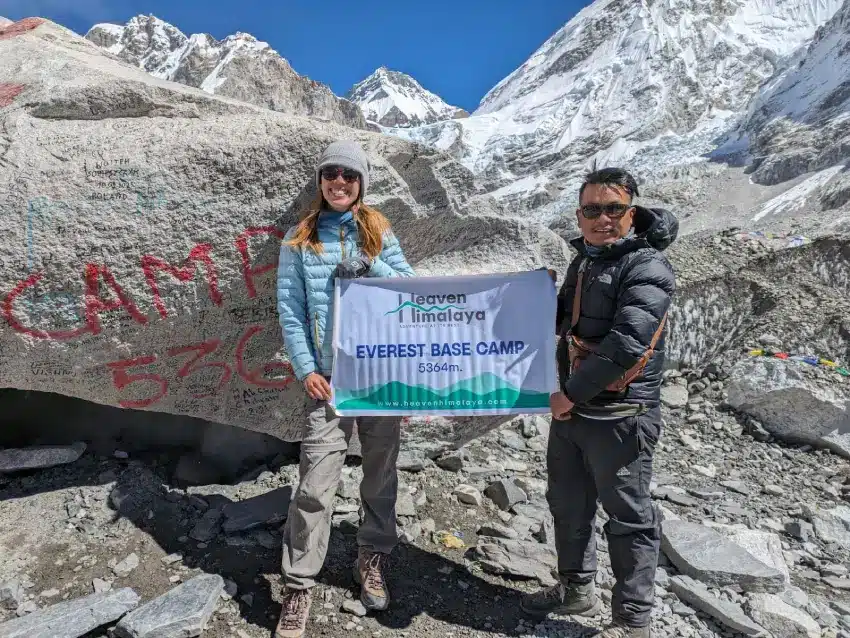
EBC Trek Equipments and Gears
First, you need a base layer of clothes for the EBC Trek, depending on the weather. A warm white layered jacket, summer pants, a thick layered jacket well insulated for winter, and a raincoat for the rainy season
Likewise, other gear includes trekking shirts, hats, sunglasses, gloves, sunscreen, wool socks, hiking boots, and hiking sandals. It is better to use hiking poles for steep, slippery, and uneven roads.
Also, here's a list of gear for the Everest Base Camp Trek.
Head, face, and neck
- Sun hat or cap (day)
- Fleece beanie/woolen cap (night)
- Balaclava (optional)
- Moisturizers
- Neck gaiters
- T-shirts (preferably quick-dry and breathable) (day)
- Parka /windbreaker (day)
- Rain gear/poncho
- Inner thermal (at night)
- Fleece T-shirts (night)
- Fleece jacket
- Down jacket (night)
- Undergarments
- Trekking pants (preferably stretchable, quick-dry, and water-resistant) (day)
- Fleece/wool pants (night)
- Light/outdoor gloves (day)
- Warm winter gloves, fleece or woolen gloves (night)
- Thin socks (day)
- Warm woolen socks (at night)
- Hiking boots (preferably GORE-TEX) with spare shoelaces
- Floaters or sandals
- Knee support (optional)
- Essential Items
- Extra passport-size photos (min. 2) for trekking permit
- Cell phone and charger
- Backpack and rain jacket
- Duffel bag*
- Rain cover and a day pack (30L)
- Trekking pole
- Sleeping Bag*
- Personal medicine
- water bottle
- Toothpaste and toothbrush
- Facial wash, soap, and shampoo
- Tissues or wet wipes
- Toilet rolls
- Hand sanitizer
- Quick-dry towel
- Handkerchiefs (optional)
- **Basic first-aid kit
Others (Optional)
- Thermo flask
- Portable water filter/purification tablets
- A Universal Adaptor
- Camera, memory card, and charger
- Reading books or maps
The items with a "*" sign are the special equipment that can be provided to you by Heaven Himalaya upon your request. You can ask for items like duffels and sleeping bags. You shall return these items upon completion of the trek or climb.
We will also provide you with a basic first-aid kit. However, if you are a regular user of medicine and have your own, you can bring them with you.
Please refer to the female packing list if you are a girl and to the Nepal packing list for more general information.
Safety and Security
Heaven Himalaya prioritizes the safety of its visitors. While on the trail, our trained guide will accompany you. Kindly note that , if there are any safety concerns, we may customize or cancel your itinerary.
You will also have some free time to explore on your own after we accomplish the goal of that day. So, during that free time, you can explore on your own.
But, remember, do not go far away from the guide. Except for the representative from Heaven Himalaya, don’t give your belongings to someone to carry or support you along the journey.
We strongly recommend that you keep your important documents and valuable items with you safely. You might also want to use a neck wallet or a money belt to keep them safe. However, hotels we use in cities have a deposit box with a lock, which is more secure to keep your important things. But, along the EBC route, you might not find a deposit box, so keep them locked in your bag.
Although you will have a porter to carry your duffel bag, keep important documents with you and carry them yourself. While sharing rooms in guesthouses, keep your important things next to you and in a safe place.
Unexpected medical emergencies
If you are a regular user of any medicine, carry it with you under your doctor’s prescription. If you feel you need some medical help or are allergic to anything, explain it to your guide. He will help you out. If it’s a very urgent situation, we will use helicopter evacuation to bring you to Kathmandu for a check-up.
Also, always have a better understanding of altitude sickness. If you think you have any symptoms and cannot continue the trek, you can tell your guide. We will figure out a solution for that.
Protests and demonstrations
Although there are no protests or demonstrations along the Everest Base Camp route, you have to be careful about that.
If you find any such cases, do not enter them or leave the area immediately. Do not stay there looking for a wonderful photo opportunity.
Hotel Safety
All the hotels we use are very safe for travelers. However, if you plan to take any extra service on your own that’s not specified in the itinerary, it’s your responsibility to look after yourself.
Some cases include: Don’t go swimming if you don’t know how to swim. Similarly, while visiting the corners of Thamel looking to buy some souvenirs or something, keep your important things in the hotel. Do not carry them with you always.
Emergency Fund
Please make sure you have access to a few extra hundred dollars in case you need it the right way. It will come in handy in circumstances that are beyond our control, such as landslides, earthquakes, etc. Also, it will help you if you want to buy something, like some souvenirs or paintings, that fascinates you and you can’t leave it there.
We take all measures into account for your safety. If you have any questions, you can call us at +977 9851273867 or email us at [email protected].
Emergency Contact
We will ask you for the details of a person to be used as an emergency contact at your side. So, while filling up the form, make sure you fill in the correct details of the person and his or her relationship with you.
Risk and Respond
What happens when you have altitude sickness?
Mild symptoms of AMS , such as mild headaches, nausea, and general discomfort, are normal in the mountains. If you feel any discomfort in your breathing, let your trekking guide know about it. The guide who accompanies you is a well-trained and certified high-altitude mountain guide.
Besides, the leader will have an oximeter with them and he will be regularly checking your pulse at intervals. If you have general symptoms, our guide will decide whether to stay at the same point or move ahead. If you show severe complications, the helicopter will rescue you and bring you to Kathmandu.
What happens if there’s bad weather?
The weather in the high mountains is always unpredictable. We always try to keep the changing weather in mind and plan the itinerary accordingly. But it’s not the same every time. If there’s heavy snowfall, rain, or some other environmental factor that disturbs our itinerary, the guide will decide whether to proceed.
If you cannot complete the trek in the estimated number of days because of bad weather, you can still complete it by taking one or two extra days. But it should be well communicated with the trekking guide or the management team.
What happens if I have physical injuries while trekking?
You will walk through difficult terrain at some points. Minor injuries, such as leg sprains, bruises, bug bites, sunburns, cuts, and blisters, are common.
However, if you suffer any injuries, communicate them well with the guides. They will have a first aid box with them and are well known to handle such minor injuries. In serious conditions, a helicopter takes the patient to the nearest hospital or rescues him in Kathmandu.
What if I lose communication with other teammates and guides?
Although it’s very rare to lose communication with either teammates or guides, if you do, visit the nearest guesthouse or some known points and try reaching them out on the phone. You can also make a call to the Heaven Himalaya team in Kathmandu.
The best time to trek Everest Base Camp
Traditionally, the best months for the Everest Base Camp trek have been March, April, and May in the spring, as well as September, October, and November in the fall. These months typically offer stable weather conditions, clear skies, and more moderate temperatures, making for a more enjoyable trek.
However, climate change has been affecting weather patterns, including in the Himalayan region. In recent years, only April, May, October, and November have continued to be popular and recommended months for the EBC trek due to their relatively stable weather.
During spring (March, April, and May), the weather is calm, with a clear sky and bright days suitable for high-altitude climbs.
Likewise, colorful rhododendron flowers and trees with new leaves around the trail are eye-catching. One disadvantage of the spring hike to EBC is that the trail is crowded and busy.
During the autumn months ( September, October, and November) , temperatures are moderate with clear skies. Also, there’s less chance of problematic rain or snowfall. Although you may get a slight rainfall on some days, the scenic views after the rain are breathtaking. The autumn season is also one of the best times for trekking. People crowd this season.
Besides, if you travel in October, you may be part of the famous Mani Rimdu festival. Buddhists celebrate the ancient festival in monasteries like Tengboche Monastery for 19 days on Everest. Just as per tradition, the locals have specified the dates for the celebration of Mani Rimdu as the 20th, 21st, and 22nd of October.
Other than that, June, July, and August are the months of challenges. The roads are muddy and slippery. This is the off-season, so trekking is peaceful with less disturbance and has clear and stunning views of the Himalayas.
Finally, December, January, and February are the off-season because of the extreme cold in the mountains. The temperatures are as low as -17 °C. However, some also choose these winter months for the EBC hike, as it is the right time if you want to avoid crowds. If you wish to trek in the winter, you need to prepare more. Many eager travelers have trekked during this time as well.
However, choose any time for the trek, as Heaven Himalaya is always there for you to assist.
- Click here to learn more about the best time to visit Everest Base Camp
- Click here to learn more about permits for Everest Base Camp
Accommodation facilities at the EBC Trek
Depending on the level of service you choose, there are various accommodation facilities available on the EBC Trek . You will find some excellent hotels near local teahouses.
During the trek, we stay at various teahouses and guest houses, offering comfortable accommodation facilities. The rooms and restrooms at guesthouses are clean and comfortable, although they are quite simple. The lodges usually have a wooden-style bed with a sheet, cover, and pillow.
Likewise, there’s a communal dining area that serves healthy local food and some international dishes. For an extra cost, you can usually get additional amenities such as an electric blanket, Wi-Fi, and a hot shower. You can also buy snacks and drinks at the teahouses.
At lower altitudes, you may have access to Western-style toilets, but as you ascend, you will typically encounter squat toilets or more basic toilet facilities . Thus, it is advisable to bring your own toilet paper, as it may not be available in some lodges.
Weather and climate in Everest Base Camp
The weather and climate in Base Camp vary with the seasons. So, we divide the weather conditions and environment into four different seasons: spring, monsoon, autumn, and winter.
During spring (March to May), the weather is warm and dry. Visibility is clear, making it a perfect trekking season for Everest. Likewise, during the monsoon (June to August), the rain makes the path wet. Even the visibility is unclear because of patches of cloud. So, we do not recommend trekking during the monsoon.
Autumn (September to November) is also a perfect time for the Everest Base Camp Trek. During this time, the weather is dry and bright, and visibility is complete.
Winter (December to February) is too cold. The path is full of snow, which makes walking difficult. Do not expect the mountains to be warm. It is always cold on top. Afternoon: The weather gets windy with strong breezes. Still, trekking is possible during early or late winter in Nepal.

Mount Everest Base Camp Trek Difficulty
We classify the trip to the base camp as a moderate-level trek. One needs to walk for around six to seven hours on average for approximately twelve days.

Although it’s a moderate hike, there are many difficulties in the hiking routes. Walking is peaceful, but sustaining the rising elevation can be hard sometimes. It requires no techniques or experience for the trek, but previous experience may be an advantage.
Everest Base Camp Training Guide
Although training is not a compulsion for the trip, it requires a level of stamina and endurance capacity. Here, we will guide you to train for the Everest base camp .
As the hike demands a continuance capacity, routine exercises like walks and aerobics may help you maintain your body’s stamina. Likewise, we recommend hiking in some hilly areas for a few weeks before trekking. Besides, you can work on your cardio and strength endurance at a gym center.
Although it’s not a mountaineering activity like any marathon run, it might be hard sometimes. Waking at high altitudes with a scant amount of oxygen can challenge you with no experience of trekking. So aerobic training can be helpful for you to walk at high altitudes with low oxygen.
We have the habit of not carrying any heavy bags unless it’s a long adventure journey. So, hiking to some nearby hills with a rucksack on your back for at least a week before the commencement of the EBC trip is commendable.
Training for your Everest Base Camp Trek depends on your health and physical fitness. Besides, mental preparation and a powerful will to reach the destination are what you need to have for your successful journey ahead.
Everest Base Camp Trek: Distance and Time Required
The Everest Base Camp (EBC) Trek covers a total length of approximately 130 km or about 80 miles, round trip, starting from Lukla and returning. If starting from Namche Bazaar and returning, the distance is about 51.2 km. The straight-line distance from Kathmandu to Everest Base Camp is roughly 153 kilometers.
This trek is a long and iconic hiking adventure, well-known worldwide, that takes you to the foothills of Mt. Everest. It allows you to explore Sherpa villages and natural heritage sites along the way.
The time required to complete the Everest Base Camp hiking journey depends on the specific route and means of transportation you choose. If approaching from Nepal’s side, you can complete the trek in 8, 12, or 14 days. Alternatively, a helicopter ride from Kathmandu Airport takes just 45 minutes.
With Heaven Himalaya, the short Everest Base Camp trek will typically take 14 days, including 2 days allocated for acclimatization on the itinerary. The daily walking distance averages around 8 to 13 km, with a duration of 5-7 hours of trekking each day.
The starting point of this beautiful hike is Lukla . To begin the journey, you’ll need to take an early morning flight from Kathmandu or Ramechhap, depending on the time of the year. For treks during April, May, October, and November, you’ll fly to Lukla from Ramechhap, which takes about 20 minutes. According to the Civil Aviation Authority of Nepal (CAAN), there are no direct commercial flights from Kathmandu to Lukla during these months due to traffic congestion at Kathmandu Airport. However, for other months, you can take a direct flight from Kathmandu to Lukla, which usually takes around 45 minutes.
Upon your arrival at Lukla Airport (Tenzing Hillary Airport), known as one of the world’s most challenging airports, your trek will officially commence.
Food Options during Everest Base Camp Trek
Here’s what you will get for food during the Everest Base Camp hike .
We do breakfast around 7-8 a.m. Most of the tea houses offer French toast, honey toast, toast bread with eggs and cheese, plain toast, and egg items. Other options include chapati, oat porridge, fried or mashed potatoes, etc.
These breakfasts are excellent for your hike to Everest Base Camp. We have other options on the menu, depending on the place or the accommodation you choose.
Lunch and dinner during the EBC Trek:
We get foods like cereals, grains, and rice, mostly for lunch and dinner. At lunch, they serve food containing carbohydrates in abundance. Although every item is available, we don’t recommend non-veg items during the tour. A vegan diet is fresh and also good for a hike.
We have lunch from around noon to 1 p.m. They typically serve traditional Nepali dishes such as Dal Bhat, which contains cooked rice, boiled lentils, vegetable curries, and pickles. However, you will also find noodles, momo items, pasta, macaroni, pizza, sandwiches, and spaghetti in some places.
We have dinner at around 7:30–8:00 p.m. You will get dinner according to the lodge menu, which includes traditional Nepali and some Western food.
Remember, food items vary from place to place, but the food we take is good enough for trekking.
Besides, if you are keen on trying some Sherpa food , you can try Su Chya (butter tea), Tsampa, or Tibetan bread for breakfast. Likewise, other Sherpa foods are Veg Shakpa (Sherpa Stew), Shyaphale, Veg Thukpa (noodle soup), Riki Kur (potato pancakes), Ting Momo, and Rilduk (soup with potato lumps).
Tipping after EBC Trek
Tipping is expected in Asian countries. It’s a way of showing appreciation to the workers that helps to make your tour outstanding. We don’t have the exact amount allocated as tips.
Hence, you can offer any price to our guides and porters when the trek ends in Lukla.
Drinks on the Everest Base Camp journey
You can get a variety of beverages during your EBC Trek. Most of the teahouses and hotels serve a wide range of coffee, tea, hot lemon, hot juice, chocolate, milk, etc. Some hotels offer cappuccinos, Americanos, and café lattes. Avoid drinking and smoking during your trip.
For water facilities, during the trek to EBC, you can get tap water everywhere, but it’s not safe to drink, so it’s better to keep a water purification tablet with you. The local government has banned plastic bottles since January 2020.
Better yet, bring your reusable bottle and make sure your bottle can hold hot water as well. You can also get bottled water , but it will cost you some money. Also, you need to pay for the hot water. So, it’s better to carry some Nepalese cash with you.
Boiling water is preferable as you go to high altitudes, and it is also safe and convenient. As you go up, altitude sickness might take place, so keep yourself hydrated and have a sip of water from time to time.
Internet, wi-fi facilities, and charging facilities during the EBC Tour
Since 2010, there has been a 3G connection on the Everest Base Camp Trek route. The Swedish company TeliaSonera has installed multiple base stations in different spots along the trek. This starts with Lukla and provides connectivity for the entire EBC trail.
NTC and NCELL mobile networks are best for you during your journey. When you arrive in Nepal, get a Nepalese SIM card and buy tourist data packs.
Besides, most of the lodges provide Wi-Fi services, charging $5–6 for an unlimited package, and some of them also provide free Wi-Fi services.
Another option is to enroll in the Everest Link Card, which is easily available at stores in the Everest region. Purchase cards of 50 MB to 100 MB, which is enough for your trip. The price of the card varies from place to place.
Charging phones and other electronic gadgets on the route
The battery gets drained quickly at high altitudes because of the cold, so you need to charge your devices more. You can charge your phone and other electronic gadgets at the lodge, but you need to pay an extra fee for the lodge you stay in. The cost also varies from place to place.
Sometimes there won’t be electricity or there’s low voltage, so carry batteries that last for three days. The best option for charging gadgets on the Everest Base Camp Route is to carry a portable power bank and a solar charger with you.
Guide to Things not to do
- High-altitude regions are risky zones. So do not trek alone. Always travel with a friend or a guide. It’s because we never know what might happen and when in the high-altitude regions.
- Avoid walking too fast. Take your time and stroll gradually. Walking fast may tire you at once. It is because, with each step, we get closer to Mt. Everest; we gain some altitude. Hence, it may harm your health.
- Acclimatization days are beneficial to cope with rising elevation and prevent altitude sickness. Thus, do not skip the days set for acclimatization.
- Do not go to restricted areas. Always stay on the trail.
- Don’t leave plastics and other waste on the trekking trail. Ask your guide to dispose of it for you.
- Always respect locals and behave pleasantly.
- Don’t trespass in excitement, seeing the high-altitude mountains around you. Everyone feels excited and happy to see the world’s high mountains right in front of them. Enjoy the adventure, but do not trespass in the risky areas. Otherwise, it may keep you at risk and ruin your Everest Base Camp trekking journey.
Before you go
- The last point of the Everest trek, where an ATM is available for collecting money, is at Namche Bazaar.
- Varieties of food within a fixed menu are available during the trek. However, it is recommended to opt for vegetarian and local Nepali food during the EBC trek.
- Be alert to the symptoms of altitude sickness. If you notice any, consult with your trekking guide and opt for preventive measures.
- If you do not find any gear for Everest Base Camp trekking in your home country, then do not worry; those are readily available for sale or rent in Kathmandu.
- Make sure you go through the complete Everest Base Camp Trek Guide before stepping into Lukla.
- If you are a regular user of any kind of medicine, explain it to your guide beforehand.
- Drones are not legal in the mountains, so if you are looking forward to capturing outstanding pictures or videos with drones, seek permission from the local government.
So, get ready to experience the thrill of trekking on one of the world’s best treks. Heaven Himalaya is here to make your dream come true.
Drone rules on Everest Base Camp Route
Everest is a highly restricted area for flying drones. Most of the trekking route falls inside the Sagarmatha National Park which is why the drones are highly regulated and require special permissions from the concerned authorities. Also, the Everest locale is one of the highest-trafficked flight routes for helicopters.
Although it’s harder to get permission, you can still fly drones on the Everest Base Camp route.
Registration and Authorization
According to current legislation in Nepal, registration with the Civil Aviation Authority of Nepal (CAAN) is mandatory for all drone categories to obtain a flying license.
1. First, visit the Flight Safety Standard Department in Sinamangal, Kathmandu.
2. Submit necessary paperwork, including a completed form as per guidelines.
- Copy of the drone’s handbook specifications.
- Copy of a valid passport.
- Copy of a certificate of company registration (if applicable).
- Clear image of the drone displaying its brand, color, and serial number.
- Overview of drone applications.
- Copy of customs clearance certificate for imported drones.
- Copy of the retailer’s VAT bill for locally purchased drones.
3. The Flight Safety Standard Department will carefully review the submitted documentation about your drone
4. If your registration is approved, a certificate verifying entry, including a Unique Identification Number (UIN), will be issued within two to three business days and will be valid for a year.
Even though you get a flying permit, there are certain rules and regulations that you should follow when flying along the trekking route.
Frequently Asked Questions
What kind of nepal visa is required for the everest base camp trek.
For the EBC trek, you need a tourist visa. And you can easily get an arrival visa upon your arrival at Tribhuvan International Airport in Kathmandu.
You can get a multiple-entry tourist visa suitable for 30 days. This will cost you 50 USD or the equivalent in foreign currency.
Similarly, you can also get multiple-entry tourist visas for 90 days for a fee of 135 USD. Please don't forget to bring two passport-size photos with you. You can find other Nepalese visa details here .
Further, refugees with travel documents and some nationals from the following countries are not eligible for a visa on arrival.
Citizens from the above nations should get a visa from a nearby embassy. If you have any difficulties getting a visa, the Heaven Himalaya team will guide you through the process.
How do I plan for the Everest Base Camp Trek?
Planning for the Everest Base Camp Trek in Nepal is very easy with Heaven Himalaya. Click on the Book Now button at the top of the page and make a booking according to your available dates. If you need to customize the trip, simply send us an inquiry about your new requirements.
However, here are a couple of things to follow before you plan for the Everest Base Camp Trek in Nepal.
Choose the best time.
While you plan a trek to Everest Base Camp, choosing the right weather and the best time is necessary. If you are trekking in the wrong season, the experiences you get may not live up to your expectations. So choose the right time wisely.
Decide on a luxury trip or a budget Everest Base Camp tour.
Second, decide with your team whether you want a budget tour or a luxury trip to Everest Base Camp . A luxury trip includes staying in luxury five-star hotels in Kathmandu and other routes along the journey.
Likewise, a normal budget tour includes three-star hotels in Kathmandu and the best guesthouses during trekking days.
Check the Everest Base Camp Trek Package Inclusions and Exclusions.
Before you jump in to make a booking, check the inclusions and exclusions in the package details. Most international companies don't provide porter service or meals during the trekking days. So, their display cost turns out to be cheaper.
Train for the high-altitude EBC walk.
Although the Everest Base Camp Trek is moderate in its trek grade , it requires a level of stamina and endurance capacity. Also, long daily walks can hurt your feet if you are not prepared beforehand.
Check your health status with a doctor.
Completing the Everest Base Camp Trek is itself an enormous achievement for a trekker. It requires firm determination, mental capacity, and good health.
So, if you are a regular user of some medicines or have any health complications, consult your doctor before you go on the trials.
Get a basic knowledge of altitude sickness.
Although you have trained trekking guides in Heaven Himalaya, always by your side, you should know the basics of altitude sickness. Mild illness is common for trekkers above 3000 m. Hence, read about the symptoms, complications, and medications of altitude sickness beforehand.
Get Everest Base Camp Insurance Coverage
Buying the right insurance package with emergency helicopter evacuation coverage is necessary before you plan for the Everest Base Camp Trek in Nepal.
Henceforth, buy insurance coverage from travel insurance companies before taking a flight to Nepal.
Buy the right gear.
Having the right gear allows you to enjoy any trip to the fullest. So, before you plan to take a flight to Lukla for the Everest Base Camp trek, make sure you have all the gear.
You can bring the equipment from your home country and rent it or buy it in Kathmandu. Get a packing list and buy things accordingly.
Wear your hiking boots beforehand.
Having new hiking boots is okay, but make yourself habitual with the shoes. When you wear new boots on the trails, you are likely to get blisters and minor injuries on your feet.
Customize the Everest Base Camp Trek itinerary
Check the add-ons on the package itinerary and add your destination to the list. Add a trip to Gokyo Lakes or book a trek to EBC with a flight back from Kalapatthar. Besides, if you have extra days, you can also choose to do the Chola Pass Trek, which includes both EBC and Gokyo Lakes.
How hard is it to walk to EBC?
Difficulty depends on people's health, hiking experience, and training. Those who did long-distance hiking earlier find it relatively easier, but beginners may feel some difficulty. People of all age groups have completed the EBC hike within the past few years with some preparation and training. So, you can also do it.
This trek doesn't require any technical expertise or mountaineering skills, as it's simply a long altitude hike. The total length of the trek is 130km, so anyone can complete this trail within 14–16 days, including acclimatization days.
But hikers need to be more careful while trekking above 3000 m, as the journey goes to an altitude of 5500 m. Some may suffer from altitude sickness at this stage. Thus, prepare beforehand and gain an excellent knowledge of altitude sickness. Also, keep yourself hydrated while going uphill. When trekking with Heaven Himalaya, you will have a trained mountain guide, so it won't be a major concern for you.
Do you need crampons during your trek?
No, crampons are unnecessary during your EBC trek. But if you are trekking in the off-seasons, like winter, then bring one if you have it. Always wear comfortable hiking boots that protect you from the cold. You can use waterproof hiking boots. Wearing new boots might give you a cut or blister, so wear those shoes before hiking.
Likewise, bring woolen or synthetic socks as per the temperature and weather.
Do we get altitude sickness during the EBC Trek?
Altitude sickness may occur as per the fitness level of an individual. Altitude sickness symptoms in Nepal start at a height of 3000 m for some people. It's quite common, as we have to trek to the maximum altitude of 5550 m.
Many people experience symptoms such as coughing, insomnia, shortness of breath, loss of appetite, sore throat, diarrhea, vomiting, dizziness, and exhaustion.
The body reacts differently for different people. Most people don't get any symptoms. If you feel these symptoms or any other uneasiness in your body, immediately contact your trekking guide. He will sort out your problem and provide you with some medicine. If you feel good, then continue; if not, take a rest in your current place.
The best way to avoid altitude sickness is to keep your body hydrated. Thus, take a sip of water every time. You can also have foods that are rich in calories and fiber.
Do some regular exercise, breathing exercises, and some simple workouts before starting your trek. Also, avoid drinking and smoking until the journey is completed.
We have the following guide to help you prevent altitude sickness during the Everest Base Camp Trek:
- Ascend slowly and gradually. Do not rush on the trail. Maintain your average speed while walking.
- Proper acclimatization is vital to avoid altitude sickness.
- Avoid the intake of alcohol, tobacco, and cigarettes because these products’ consumption may decrease the water level in your body and make you feel tired and lethargic.
- Drink plenty of water
- Take plenty of healthy food
- Prepare your mind mentally for the trek.
How much money do I need for the Everest Base Camp trek?
The actual amount depends on you. Heaven Himalaya covers the price of food (breakfast, lunch, and dinner), accommodation, a guide, and other expenses for you.
Furthermore, if you choose to have some extra snacks or food, you have to pay for it. Other individual costs may include the cost of charging electronic gadgets, Wi-Fi, hot water, hot showers, and many others. The price for these extra services varies from place to place and also rises at higher altitudes.
Last, other expenses for you also come with tips for guides and porters. Your guides and porters expect tips from you as they work hard to make your trekking journey outstanding and memorable. There's no exact amount for tips; you can allocate them yourself.
Do we find money exchanges on the EBC Hike?
For Everest trekking, you need local currency (Nepalese rupee). However, some stores also accept payments in American dollars.
ATMs are available in Lukla and Namche Bazaar, but it's difficult for you to use them as there will be many trekkers on the line. Sometimes, it doesn't work as well. So, you can't rely on them completely.
Therefore, visit money exchanges in Kathmandu and get the amount in Nepalese currency. Also, it's difficult to convert your Nepali rupee back to your currency. So, exchange your currency as per your needs.
Which currency is acceptable along the Everest Base Camp route?
The local currency, i.e., Nepalese rupees, is acceptable locally along the route. Also, USD is widely accepted.
Can I book the Everest Base Camp trip with my kids?
Sure, EBC Trek can also be done with your family and kids. Studies show that children have a similar rate of altitude sickness as adults. No evidence shows children are more likely to get altitude sickness.
If your kid is physically and mentally fit for an altitude trek, go with them. But your children should be able to walk at a high altitude for around 5-7 hours a day on average.
Remember to always do some simple workouts and breathing exercises while traveling. Stay away from junk food and include a balanced diet more often, including carbs and fiber in your food. It's not advisable to bring small kids, but children over 13 years of age can attempt to complete the hike.
Is it mandatory to get a guide on the EBC trip?
When you travel with an agency like us, we care about your safety. So, you will have a licensed and well-trained trekking guide to help on your journey. They will give you a better option for selecting a hotel, a ticket, permits, and porters, and will assist you in managing your entire journey.
Also, mountain guides are of great help when there's altitude sickness or a medical emergency. They are familiar with the local environment and wildlife areas and can assist you in learning about the area's major cultures, history, and traditions. It's not compulsory, but trekking guides are highly recommended.
Can beginners like me attempt to do the trek?
Yes, beginner hikers can also do the Everest Base Camp Trek if they are physically and mentally prepared. To do this, just do simple training enjoy swimming, breathing exercises, jogging, or walking to build stamina. Also, eat healthily and be prepared for long walks.
The major fear for beginners is the inability to walk for a long time in high altitudes and the risk of altitude sickness. So, if you prepare well to overcome these, you are ready.
Do I have to learn the Nepali Language to do the EBC Trek?
No, it's not necessary to learn the Nepali Language while going for the Mt. Everest Base Camp Trek. You will have a trekking guide who understands English to communicate. Also, most of the locals in hotels, and shops understand English.
However, if you want to communicate with kids, and the sherpa locals in the villages, then learn a few Nepali words for travel . Nepali is not that hard to learn, give it a try.
Do we need travel insurance for the Everest Base Camp Trek?
Travel insurance gives a feeling of safety during the trip. Also, as EBC Trek includes trekking to high altitudes, it's advisable to buy trekking insurance before attempting to go on the journey. Nobody can predict the future. Also, in some rare cases of emergencies, travel insurance comes in handy in saving your hard-earned dollars.
Travel insurance assures you of safety and helps you enjoy your trip with no stress. It covers luggage theft, flight cancellation, medical evacuation, and many other losses during your trek. Make sure that your travel insurance also covers your altitude incidents, such as helicopter rescues. If you suffer from severe AMS at high altitudes, helicopter rescue is the only way to get out of the mountains.
You will find insurance companies in various locations around the world. Google which insurance company is better for you and go with them.
Here is a list of insurance companies that our previous travelers have recommended. These are only for recommendation; we don't guarantee the way they operate.
If you come from the USA or Canada,
- Online Global Health Insurance
- Insure My Trip.com (Online Insurance Aggregator)
- Mondial Assistance
- Access America
- HCC Medical Insurance Services
- Good Neighbor Insurance (International Health)
- International Health
- Insuremytrip dot com
- Multinational Underwriters
- TIC Travel Insurance Coordinators Ltd
- Travel Assist
If you come from England,
- Specialty Group (UK) Limited
- FirstAssist Services Limited
- Harrison Beaumont
- Buy cheap travel insurance.
If you come from Europe or Slovenia,
- Assistance CORIS
If you come from Australia or New Zealand,
- Cover-More Travel Insurance
- CGU Insurance Limited
South African travelers,
- Travel Insurance Consultants, Pty. Ltd.
Besides, World Nomads are also widely used to get insurance for EBC Trek.
Everest Base Camp (5363m) is one of the best attractions
Base camp trek itself was amazing, wonderful ebc trek, first inquiry to end, the ebc trek service was incredible..
Paul Kolej,
I booked the EBC Trek for late November
Kiandra Buchanan,
14 days Everest Base Camp with Bishal
Unforgettable experience in himalayas, memorable trek, wonderful journey, thrilling trip to ebc, add a review.
- Full Name *
- Email Address *
- Your Image Accepted file types: jpg, jpeg, png, gif.
Make An Inquiry
Similar Packages
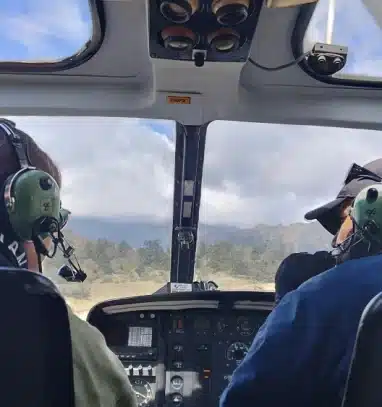
How To Do The Everest Base Camp Trek In Nepal
The Mount Everest Base Camp Trek in Nepal is one of the world’s best bucket list hikes. In less than 2 weeks, you can trek to the foot of Mt Everest and other snowy peaks in the Himalayan mountains.
The good news is that it’s not a super difficult hike, and you don’t need a big budget to do it. The EBC trek is worth it for the fun and accomplishment alone, but you also get views of the Himalayas that are out of this world.
This travel guide will explain how you can do the Mt Everest Base Camp hike independently (with or without a tour guide), along with a recommended packing list and everything else you need to know before you go!
Best Everest Base Camp Tours
First of all, if you’d rather skip the hassle of planning your own EBC Trek, Klook has Everest Base Camp Tours starting as low as $900 USD for a full 12-day trek.
You may be able to find something cheaper than this once you land in Kathmandu, but booking online with a vetted tour company has some big advantages, and the reviews on their website are very positive.
We’ve used Klook for lots of tours and activities around the world, and they’re great! Highly recommended.
Book Now: Everest Base Camp Tours

When To Do The EBC Trek
The Mt Everest region has 4 different trekking seasons:
- March – May: High season. Best weather, with stable temperatures and bright sunny days, but the trails can get crowded. During these months you may share the EBC trail with pro climbers on the way to go summit Everest.
- June – August: Monsoon season. There’s a lot more rain during these months, and the trails are mostly empty.
- September – October: Clear days and busy trails. This is one of the most popular trekking seasons.
- November – February: Coldest season, but the weather is stable and dry. The trails are mostly clear.
I trekked in early February, and even though it was nice having the trail mostly to myself, the cold in the evenings and mornings was straight up misery.
My home state of Missouri can get very cold in the winter, but the cold has just never been my thing. If I could go back and change it, I would definitely do my Everest Base Camp hike later in the season.

Everest Base Camp Weather
Temperatures on the Mt Everest Base Camp Trek can range from 5 °C (40 °F) to 20 °C (70 °F) depending on month, and as low as -30 °C (-22 °F) at night during the winter months.
If you trek during the warmer months (Mar-May and Sep-Oct), the cold is not a big problem and shouldn’t be hard to cope with. Winter is a different story. Your snot will freeze in your nose at Gorak Shep.
Sunshine is key for winter trekking in Nepal, and thankfully you should have lots of sun in most months outside of the monsoon season. On my February hike, I often found myself shedding all my layers while trekking because I was heating up in the sun.
If you do your Everest Base Camp hike during the winter, the biggest issue is staying warm in the evenings and at night. For this, you’ll definitely want a top quality down jacket and sleeping bag.

All About Everest Base Camp Trekking
My everest base camp itinerary.
- Day 1: Kathmandu to Lukla to Benkar .
- Day 2: Benkar to Namche Bazaar .
- Day 3: Namche Acclimatization Day .
- Day 4: Namche to Deboche .
- Day 5: Deboche to Pangboche .
- Day 6: Pangboche to Dingboche .
- Day 7: Dingboche Acclimatization Day .
- Day 8: Dingboche to Thukla .
- Day 9: Thukla to Gorak Shep .
- Day 10: Everest Base Camp .
- Day 11: Kala Patthar to Gorak Shep to Pheriche .
- Day 12: Pheriche to Namche .
- Day 13: Namche to Lukla .

If you ever need motivation to keep going on the Everest Base Camp hike, just look at how much the porters are carrying!

Mount Pumori as seen from the Kala Patthar viewpoint, just a short distance from Mt Everest Base Camp.

Ama Dablam, one of my favorite mountains on the Mt Everest Base Camp Trek.
EBC Trek Packing List / Gear
This isn’t a complete list of everything to bring on a Mt Everest Base Camp Trek, and you may have to change things up a little depending on what month you go, but these are just some of the basics.
You can find most of this gear in Kathmandu, but in my opinion you’ll get higher quality and a wider selection if you order online.
- Beanie: I only wore this at night, but it definitely helped keep my ears warm.
- Down Jacket: Bring the biggest, warmest DJ possible. This is your most important piece of gear. You can use it as an extra cover at night.
- Fleece Sweater: This is the only jacket you’ll need to wear while trekking most days, especially if it’s sunny.
- Shirts: Something comfy with quick dry material.
- Trekking Pants: Something lightweight and breathable.
- Thermal Underwear: May not be needed if you trek in the warmer months.
- Gloves: I only wore these at night, but they definitely helped keep my hands warm.
- Socks: Merino wool is best for staying warm and stopping moisture.
- Headlight: Smart to have at least a small one, just in case.
- Tumbler: 1 liter water bottle to refill daily on the trek.
- Sunblock: It’s easy to sunburn at high altitudes. A small bottle is plenty.
- Sunglasses: Good for snow. May not be necessary unless you plan to hike a mountain pass like Cho La.
- Hat: I wore old faithful throughout the hike.
- Watch: An altimeter watch would be fun to play with here.
- Camera: Duh. You can’t do the Mt Everest Base Camp Trek without taking lots of pictures.
- Power Bank: Bring a big power bank and you might only need to recharge it once on the whole trek.

Everest Base Camp Trek Cost
For a 13 day trek, I paid about $21 USD per day for food, drinks, and room. Porter/guide was an extra $25 per day, although it’s not a requirement. Flights to Lukla were $330 return, but again not a requirement if you hike in.
You can read the sections below for more info on the daily trekking costs and what you get for your money. It’s not a very expensive trek, all things considered!
Keep in mind, these numbers are from 2020. They’ll go up a little over time. Exchange rates may also vary, so check the latest rates .

The flight to Lukla from Kathmandu is $165 USD each way. You can shop for flights to Lukla at Skyscanner.
If your budget is tight or you have extra time, you can skip this flight by hiking from Jiri to Lukla rather than flying. It only adds a couple days to the itinerary.

Guide / Porter / Solo
You can do the EBC trek with a guide, porter, OR independently (solo).
A guide will show you the way to Mt Everest Base Camp and help with lodging, navigation, advice, taking pictures for you, etc. A porter-guide will do these same things and also carry a 20 kg (45 lb) pack for you.
A porter or guide is NOT a requirement to do this hike, especially if you go in the warmer months when you may not need as much gear. In 2023, they were supposedly introducing a guide requirement for EBC, but so far that has not been enforced at all, thankfully.
With that said, there are some good advantages to hiring a guide, and it’s pretty cheap by Western standards. A porter is only $15 or $20 USD per day, and a porter-guide is $25 per day. A popular arrangement is to hire one porter for two hikers, splitting the cost and still making things easier for both of you.
In the end, this all depends on your budget and hiking preferences.

Hiking Fees
If you’re hiking EBC independently, you’ll need to be aware of two fees you have to pay near the start of the trek.
There’s a local government tax that they’ve now started collecting in Lukla. This one is currently 2,000 Rupees ($17 USD).
There’s also an Everest park fee/ticket you have to pay at the Sagarmatha National Park entrance just beyond the small village of Monjo, Nepal. This one is currently 3,500 Rupees ($30 USD).
No TIMS card is needed anymore for independent hikers. That fee has been retired for the Mount Everest Base Camp Trek.

Accommodation & Amenities
Throughout the Everest Base Camp hike, you’ll stay and sleep at small guesthouses along the way, called teahouses.
This is where you get your meals and drinks for the trek, along with the occasional amenities like showers, charging, or WiFi. The teahouses start out decent, but quickly get more shabby as you go further up the trail.
You have to pay for everything you use, of course, and the prices get quite high as you go, because everything has to be hauled up on the backs of the poor porters.

Guesthouses
The teahouses on the EBC trek are cold and dingy, with drop toilets and cracks in the walls. Don’t expect luxury.
Most rooms are free as long as you buy your meals there (the meals are how they make their money). If you stay at a lodge and don’t eat there, you’ll be expected to pay for the room.
In some cases, I was charged 500 Rupees for a room on top of my meal costs. I’m not sure why some teahouses do this and others don’t, but I never paid more than 500 Rupees for a room, and most were free with the meals.

Food & Drink
I’m happy to report that the food and drinks on the Everest Base Camp hike are top notch, especially after you’ve worked up an appetite trekking.
You have western food choices, or the standard local staples like veggie fried rice, steamed momos (dumplings), and mushroom soup. Everything was hot and fresh. Meal prices for these ranged from 250 to 750 Rupees depending on altitude. Not too bad.
For drinks I tried hot chocolate, lemon/apple/mint tea, and occasionally bottled water for my tumbler. These ranged from 100 to 400 Rupees. If you want to avoid plastic bottles, there’s usually boiled water available and this is safe to drink too.
Getting enough water on the trek is never a problem. Just fill up a 1 liter tumbler in the morning, and this will last you until evening, especially since you’re likely to pass more tea houses along the trail as you’re hiking throughout the day.

Showers are only available at a few lodges, depending on the season and how high up you are, and they cost 600 to 1200 Rupees. In the winter, water higher up will be frozen most of the time.
I never had a shower on my February EBC trek, and that seems to be the norm (although I got one or two opportunities in Namche). Yes, it’s gross. I could smell myself by trek’s end, and it wasn’t pretty.
But aside from the fact that I hate to fork out money for something as basic as a shower, I also never really got close to other people for very long on the trek, so I didn’t feel too guilty about it.
Most days were cold enough that the thought of stripping down for a shower was not really appealing, either. Your best bet is baby wipes and deodorant.

WiFi / Cell Service
WiFi costs anywhere from $5 to $10 USD per day if you buy it from the teahouses.
Alternatively, you can buy a 10 GB/30 Day Everest Link WiFi card in Namche Bazaar and use this for the entire EBC trek. During my Mount Everest Base Camp Trek the WiFi was down across the whole region, so unfortunately I wasn’t able to use either of these options.
I bought an Ncell local SIM card in the Kathmandu airport and had 3G service for half the days of the Everest Base Camp hike. Coverage is still improving in the area, so if you need to stay connected I’d definitely bring a local SIM.

Electricity
All of the teahouses on the way to Mt Everest Base Camp sell outlet charging for electronics, and the prices range from $2 to $10 USD for a full charge, depending on how far up the trail you are.
The key is to bring a big power bank and then use this to charge all of your other electronics (phone, camera, etc). I did this and only paid once to recharge my power bank on the whole trek.

How Much Cash To Bring
Everything you buy during the Everest Base Camp hike (meals, WiFi, charging, etc) will have to be paid for with cash. Credit cards won’t work. There are no ATMs outside of Lukla and Namche Bazaar (Days 1-4), and even the ATMs there are not reliable.
What this means is that you’ll have to withdraw enough cash (Nepalese Rupees) at an ATM in Kathmandu to cover your entire trek. The ATM fees will bite you, and I hate to carry large amounts of cash, but it’s not really avoidable here.
All up, I spent about $20 USD (2,400 Rupees) per day on the Mount Everest Base Camp Trek, and never spent more than $25 USD in a single day. With that said, I didn’t splurge on WiFi, showers, charging, or alcohol. The only things I bought were the bare necessities: room, food, and drinks.
If you hire a porter/guide, you don’t need to factor that into your daily cash carry. That’s paid before the trek starts. But do reserve a little cash for a decent tip.

Mount Everest Base Camp Trek Difficulty
I’m not going to lie, this is a difficult trek. And if you do it in the winter like I did, it’s even harder. With that said, if you are in decent shape, determined, and obey the guidelines for altitude sickness prevention (more on that below), then you’ll have no problem reaching base camp.
There is a lot of elevation gain and loss on this hike. At times near Lukla, the constant ups and downs will make you feel like you’re hiking a roller coaster, but the trail is never too steep or dangerous. After Namche, it’s mostly a slow uphill plod.
This trek has been completed by old seasoned hikers in their 70s, and young kids in their pre-teens. It’s also been flunked by healthy 20-30 somethings who try to push through it quickly without enough acclimatization to altitude.
Patience and discipline are key for trekking to Everest Base Camp. Slow and steady wins the race here.

Trekking Distance
The one way trekking distance from Lukla to Mt Everest Base Camp is about 65 kilometers (40 miles).
That means the total roundtrip distance of an EBC Trek is about 130 kilometers, even if you don’t do any of the detours.
Don’t let that scare you off. It’s a lot of hiking, but every step is worth it.

Altitude Sickness
By far your biggest danger on the Mount Everest Base Camp Trek is altitude sickness, also known as Acute Mountain Sickness (AMS).
No one is immune to this, and it doesn’t matter how fit you are. If you gain altitude too fast, you can get sick and in some cases even die. Plenty of people have died from AMS on the EBC Trek.
The problem is that overzealous hikers push the envelope on this hike all the time, and a lot of them end up needing a very expensive helicopter evacuation to lower ground.
The best way to avoid altitude sickness is to go slow . At altitudes above 3,000 meters (10,000 feet), don’t increase your sleeping elevation by more than 300-500 meters (1,000-1,500 feet) per night.
Every 1,000 meters (3,000 feet) you should also spend a second night at the same elevation. If you get a bad headache, dizziness, or nausea, descend to a lower altitude until you feel better. As long as you follow these general guidelines, you shouldn’t have any issues.
You can take Diamox (acetazolamide) on the trek for extra AMS prevention. This medication can be found in Kathmandu or Namche. I bought mine in Namche and it seemed to help my headache and slight foggy feeling. I didn’t have any side effects aside from the usual tingling toes/fingers.

Everest Base Camp Altitude
The Mount Everest Base Camp altitude is 5,364 meters (17,598 feet). At this elevation, there is 50% of the oxygen at sea level.
However, most treks also go to Kala Patthar, a viewpoint even higher than base camp where you can get the best views of Mount Everest.
The elevation at Kala Patthar is 5,644 meters (18,519 feet). From there, you’ll be rewarded with an incredible panorama of Mount Everest and other icy peaks like Pumori, Lhotse, and Nuptse.
Happy travels!

If you’d rather skip the hassle of planning your own EBC Trek, Klook has Everest Base Camp Tours starting as low as $900 USD for a full 12-day trek.
You may be able to find something cheaper than this once you land in Kathmandu, but booking online with a vetted tour company has some big advantages, and the reviews on their website are very positive for this Mt Everest Base Camp tour.
More Nepal Travel Tips
Hopefully you were helped by this guide for the Everest Base Camp Trek. Let me know in the comments below if I can help answer any questions.

You may also like
Fulidhoo island guide: shark & stingray beach in maldives, how to visit dhigurah island: budget paradise in maldives, 10 best hikes in aruba: family friendly trails, how to visit tanjung puting national park in indonesia, sanur bali travel guide: 23 best things to do, coron vs el nido: which is better all differences explained.
So much useful detailed information.
Thanks for the straight forward information. Beautiful photos

Leave a Comment Cancel Reply
Save my name, email, and website in this browser for the next time I comment.
Hrmm. Looks like you're using an older browser, which means some site features may not work they way they should. For the full gadventures.com experience, we recommend upgrading to the most recent version of your browser . It's worth it! Honest!
View all tours
North America
Central america & caribbean, south america, north africa & middle east.
Few travellers make it to this icy continent, but the lucky ones who do get to explore a frozen Eden ruled by the elements and teeming with wildlife.
G Adventures Land
G adventures sailing & cruises, g adventures private travel.
Whether it’s a family retreat or a girls trip, you can surround yourself with a hand-picked crew and customize a tour that fits you all perfectly.
The Geluxe Collection
Our new line of premium active adventures is officially here. With perfectly paced itineraries, one-of-a-kind accommodations and elevated dining, this is adventure at its finest.
National Geographic Journeys
Go deeper into the cultures and habitats of the places we explore. More is included and you’ll enjoy greater hands-on exploration, interactions with local experts, and freedom to roam.
National Geographic Family Journeys
Are you an adventure-loving family in search of meaningful ways to discover the world together? These tours are specially designed for travellers seven and up and their inquisitive families.
Jane Goodall Collection
Step deeper into the animal kingdom while respecting all of its inhabitants. Our incredible collection of wildlife-focused tours is endorsed by the world-renowned ethologist.
Roamies by Hostelworld
The thrill of adventure. The awesomeness of hostels. Get ‘em both on these immersive small group trips for 18 to 35-year-old travellers.
Why choose us
As the leader in small group travel for 30 years, we know how to do it right: flexible itineraries, freedom to roam, safety, peace of mind, and locally based guides.
Change the world just by having the time of your life. When you travel with us, you become a force for good by acting responsibly and creating positive impact.
Together with our non-profit partner, Planeterra, we ensure local communities touched by our tours benefit from our visits in as many ways possible.
Trees for Days
Leave your destination even greener than you found it! For every day on tour, we’ll plant a tree in your honour and ensure that our forests get to live their best lives.
Travel resources
Last minute deals.
Looking to have the time of your life in the next 90 days or so? You can save big if you’re ready to book now.
Loyalty discount
Back home from a G Adventures tour? Submit a quick trip evaluation to save 5% on your next tour with us.
Student discount
Got proof that you’re pursuing higher learning? Then we’ve got a travel voucher with your name on it.
All travel deals
New ways to save pop up all the time. Here’s where you’ll find every hot deal in one easy place.
Everest Base Camp Trek
15 days, kathmandu to kathmandu.
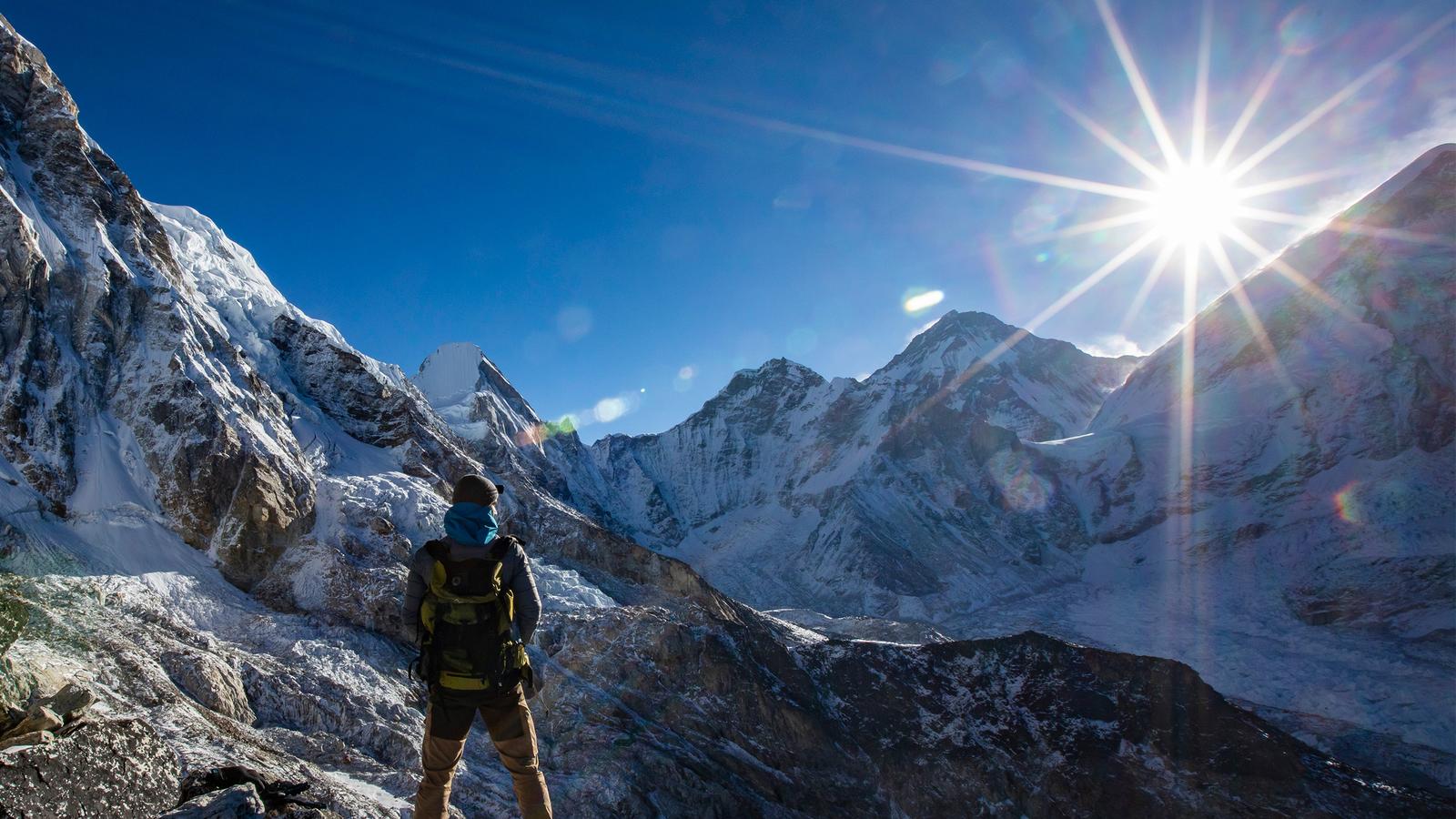
- Full itinerary
- Tour details
Everest is more than a mountain and the journey to its base camp is more than just a trek. Along a route dubbed by some as "the steps to heaven," every bend in the trail provides another photo opportunity — beautiful forests, Sherpa villages, glacial moraines, and foothills. For active adventurers not afraid to break a sweat, our full trekking support staff will bring you close to local cultures before opening a window to the top of the world.
Kathmandu to Kathmandu
Special offers, is this tour for me, travel style: active.
Hiking, trekking, biking, rafting, and kayaking adventures all over the world, made for outdoor types.
Service Level: Basic
Simple and clean hotels and hostels; affordable public and private transport; lots of optional activities.
Physical Rating: 5 - Challenging
Serious high-altitude hikes, cycling, or other instances of heavy exercise. Come prepared to sweat a bit.
Trip Type: Small Group
Small group experience; Max 15, Avg 10
Age requirement: 12+
All travellers under age 18 must be accompanied by an adult.
Check Your Visa Requirements
Before booking, use our handy entry requirements tool so you know which documents you need to enter and travel through the countries on your trip.
See how your trip uplifts communities
In a number of impactful ways, your adventure directly benefits the local people and places we visit.
Help us spread love around the world with Trees for Days. Together with Planeterra, we'll plant one tree in your name for every travel day.
Trees planted for this trip: 15
Ripple Score
Create ripples that change lives. The higher the Ripple Score percentage, the more money stays in the local communities you visit.
Ripple Score for this trip: 100
More from Everest Base Camp Trek

Places visited
Ready to hike the Himalayas? Get familiar before you go.
Day 1 Kathmandu
Arrive in Kathmandu at any time. Attend the group welcome meeting.
Exclusive Inclusions:
Day 2 kathmandu/phakding.
Catch the mountain flight to Lukla, enjoying stunning views of the Himalayas. Meet the Sherpas and begin the trek to Phakding.
Day 3 Phakding/Namche Bazaar
Hike to Namche Bazaar, gateway to Everest Base Camp and spend two nights acclimatizing for the trek. The group will hike mostly uphill today from Phakding and it will take around 6 hours to reach Namche Bazaar.
Day 4 Namche Bazaar
During today's acclimatization day the group will hike up to Syangboche at 3860m. Weather permitting, you will be able to spend some time here and enjoy tea or coffee while viewing the mighty Himalayas and of course Everest Peak. Return back to Namche where the remainder of the day is yours to rest as you please.
Total time spent hiking today will be around 3 hours.
Day 5 Namche Bazaar to Tengboche
Set out on a 5–6 hr trek through pine and rhododendron forests before arriving in Tengboche. Tengboche is a small village, and home to the famous Tengboche Monastery, the largest monastery in Khumbu region.
Day 6 Tengboche to Dingboche
Trek to Dingboche, crossing bridges and rivers with sweeping views of the Himalayan region. Walk through forests and alpine meadows and search for wildlife along the way. The group will spend 2 nights in Dingboche to acclimatize.
Day 7 Dingboche
Today is an acclimatization day. Opt to hike to Chhukung or Nagarzhang Peak.
Day 8 Dingboche/Lobuche
Hike through alpine meadows and summer yak pastures towards the end of the moraine of the Khumbu Glacier to Lobuche, which has spectacular views of Nuptse. Today the group will walk for around 5 hours gradually following the trail uphill along a glacial river and through small settlements at Dughla and Thukla.
Day 9 Everest Base Camp (Gorak Shep).
Today includes a challenging climb past the Khumbu Glacier, arriving in Nuptse. From there the group will cross the Changri Glacier to Gorakshep, and then finally enjoy the highlight of reaching Everest Base Camp.
Day 10 Gorak Shep/Pheriche
Enjoy an early morning trek to Kala Pattar for stunning sunrise views of Everest and surrounding vistas. Later, trek to Pheriche along a mostly downhill route.
Day 11 Pheriche to Kenjuma
Today the group descends through Pangboche, the highest permanent settlement in the region, with its great gompa. The trek finishes in Kenjuma. After a long day on the trail, the evening will be spent resting and recouping
Day 12 Kenjuma to Monjo
Continue our trek, following a path that has both ascents and descents. The group will finish today’s downhill trek in the evening upon arrival to the small village of Monjo.
Day 13 Monjo/Lukla
The final day of our trek takes us back to Lukla, where we have a chance to relax after the rigorous adventure we just undertook.
Day 14 Lukla/Kathmandu
Catch the short flight back to Kathmandu, where the rest of the day is free for shopping, sightseeing, or relaxing in one of the many rooftop cafés.
Day 15 Kathmandu
Depart at any time.
What's Included
- Your Welcome Moment: Welcome Moment - Meet Your CEO and Group
- English-speaking local guide and assistants for the trek
- All necessary permits for trekking
- Porters included on the trek
- Trekking to Everest Base Camp
- Internal flights
- All transport between destinations and to/from included activities
Accommodations
Hotels/guesthouses (2 nts), teahouse lodges (12 nts).
No meals included Allow USD360-470 for meals not included.
Transportation
Plane, bus, walking.
Staff & experts
CEO (Chief Experience Officer) throughout, trekking support staff.
Make it a private tour
Book this tour as a private departure, with your own CEO and all the benefits of a G Adventures group tour.
.webp)
Everest Base Camp Trek
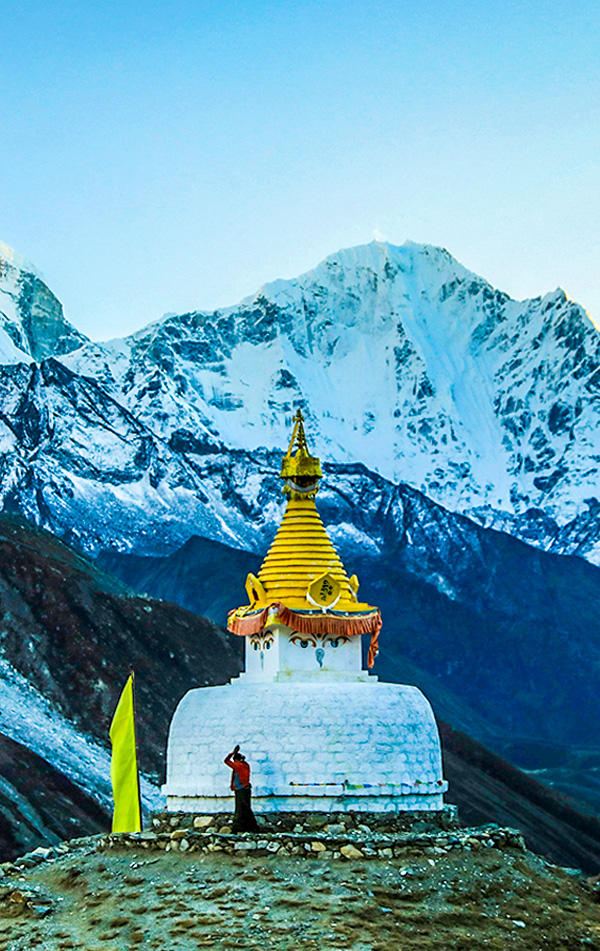
Kathmandu |
Kathmandu | Nepal
Max Altitude
Trekking Km
Help & Support
67000 /person $ /person.
- October-2024
- November-2024
- USD 1500 +5% GST for Non-Indians
- +5% GST (Goods and Services Tax)
- Services Kathmandu to Kathmandu
- Lukla flight, Food & Stay in Kathmandu included
Offload 5300
Backpack offload is optional
Choose add-ons during booking. If missed, log in and add them later.
Book off-load at least 10 days before the trek.
For offline bookings at the base camp, a convenience fee of Rs. 6500 applies.
Cancellations made before the trip date will receive a full refund.
For more information. Please complete this form.
Help & Support
Trek Name: Everest Base Camp Trek
Adventure Type: Trekking
Base Camp: Kathmandu
Season: Summer | Autumn |
Month: March | April | May | September | October | November |
Country: Nepal
Altitude: 18200 Ft.
Grade: Difficult
Rail Head: Kathmandu is not connected to any Railways
Stay: Hotel and teahouse
Food: Meals while on trek & at Hotel/Guesthouse (Veg & Eggs)
Location: Kathmandu
Distance: 108 Km.
Trail Type: One way trail | Camping in various locations, starting and ending at the different point.
AirPort: Kathmandu (Tribhuvan International Airport)
Why Everest Base Camp Is A Must-Do Trek
When it comes to trekking in the Himalayas, Mt. Everest is the most celebrated peak and not just in our country but all across the globe. For avid trekkers and mountaineers, getting up close to the highest mountain peak in the world is a once-in-a-lifetime experience. This classic trek takes place in the Bagmati Zone of Nepal and allows you to experience the immense beauty of the surroundings. Along your trek, you will get to witness 4 of the 6 highest mountain peaks in the world — Cho Oyu (8,201 m), Mt. Makalu (8,470 m), Mt. Lhotse (8,516 m), and Mt. Everest (8,848 m).
Everest Base Camp is a teahouse trek, which means you will stay at some of the highest villages in the world and get a close look at their cultures and traditions, and life in the remote corners of the Himalayas. Staying at the Sherpa villages you will get to learn a lot about the mountain lifestyle and how inextricably the people are connected to the mountains. There are many notable junctures throughout the trek and Kala Patthar is one such point. Standing at an altitude of 5,500 m it offers an astonishing view of Mt. Everest . EBC trek presents a wonderful opportunity to experience the grandeur of the Himalayas, the imposing challenge and thrill of the climb, and the charming culture of Nepal.
Trekking in Nepal is all about trekking amidst the biggest mountain ranges and on this trek, you will see mountains surrounding you. All along the way, you can feel the sense of legacy left behind by the greatest mountaineers. Crossing the route beyond Namche Bazaar, you will come across, Tenzing Norgay Stupa, a tribute to the great mountaineer, who was the first to scale Mt. Everest along with fellow mountaineer Edmund Hillary. Also, just near Dughla on Everest highway, there are memorials for distinguished mountaineers who dedicated their lives on the slopes.
Reaching Everest Base Camp means trekking through the traditional Sherpa villages, with warm and friendly villagers, hidden Gompas, picturesque mountain views, and exceptional natural beauty. Those who take part in such a trek will never forget the amazing experience.
About The Trek
Your journey will start at Kathmandu from where you will take a short flight to Lukla. The iconic trek starts at Lukla in the southern part and the trail weaves towards Namche Bazaar in the north. We will stay a day here, acclimatizing to the higher altitudes. It then diverges in the northeast direction towards Pheriche and Dingboche. Once we reach Dingboche, we will spend a day at Dingboche as a rest day. From Dingboche, the route continues to Lobuche. Everest Base Camp is a little further east from here and the Kala Patthar viewpoint can be seen towards the west.
There are other variations to the trek route as well, where the trek bifurcates towards Gyoko Ri early on at Namche Bazaar. The route then follows the left side to arrive at the Base Camp. Sometimes people also prefer trekking from Jiri village instead of Lukla, Jiri is a short bus ride away from Kathmandu. However, trekking from Jiri adds a couple of days to the trek as Jiri is considerably further away from Lukla. The EBC trek follows a gradual ascent up to the base camp, following which there is a steep descent. The entire journey lasts for 13 days and in between, we also have acclimatization days as well.
What Can You Expect At The Trek
It is a difficult grade trek. Trekking to the Everest Base Camp requires exceptionally high physical fitness and while the trek is not dangerous, you need to prepare well for it. A variety of factors add to the difficulty of the trek like the terrain, the duration of the trek, the distance covered every day, and the number of days spent at high altitude and a difficult exit in case of emergencies. While all trek is not especially tricky but it is surely an endurance test.
It is a high altitude trek and as such chances of AMS are quite high but with adequate hydration, proper rest, and a well-planned itinerary taking into consideration the acclimatization criteria will help counter such issues. Our trek leaders are mountaineering-certified individuals with a keen understanding of AMS and other high-altitude issues. They can detect the signs of AMS early on and adopt necessary measures for the prevention of the same. Our Trek Leaders are also all Wilderness First Aid Responders, who are diligent in handling emergencies.
The trek from Lukla to Everest Base Camp is 50 km and it takes 13 days to complete the trek starting from Kathmandu. To mitigate the risks of being at a higher altitude for such a long time, we have incorporated acclimatization and rest days in the itinerary. Mt. Everest can be spotted multiple times on the trek even in the initial part of the trial.
In cold conditions, batteries drain pretty quickly be it phones, cameras, or Kindles. Make sure to bring spare batteries with you. Some teahouses allow you to charge your phone and other electronics but they will charge you for it.
Be prepared for extreme weather conditions as the weather at high altitudes is unpredictable. Layer properly to regulate your body temperature and stay comfortable while trekking. When its sunny, the weather can get quite warm and you may even have to discard a couple of layers in the first few days of trekking, however, the temperature at night drops pretty quickly. Make sure to drink a lot of water to stay hydrated and avoid altitude sickness. Also, remember that sunburn happens much quicker at higher altitudes so always wear sunscreen and keep your sunglasses ready.
Accommodations at Everest Base Camp will be in teahouses in Sherpa villages or mountain lodges. Also, keep enough cash with you as there are no ATMs in Lukla. Also, if you want to do some last-minute shopping for trekking gear and equipment, Kathmandu is a good place to do so.
- Who can Participate
- Important Links
- How to Reach
- Trek Essential
Who Can Participate
- Age; 15 years.
- Experience of any high altitude trek, at least 1 treks of 4,000m/13,100ft.
- The climber must be fit and have sufficient stamina to cover 6 km of distance in 35 minutes without stress.
- The climber should be able to carry a 12-16 kg backpack.
Arrive At Kathmandu
- Altitude: 1,400 m/ 4.600 ft.
- Spend the day exploring Kathmandu.
- A short briefing session in the evening.
- Stay in a hotel (included in cost).
Welcome to trekkers’ paradise, Nepal. Nepal is characterized by beautiful Himalayan summits, rich natural biodiversity, and beautiful culture and history. Once you arrive at Kathmandu airport, you can take a taxi to the booked hotel in Kathmandu. There are loads of taxis available at the airport and you can easily find one to drop you off at the hotel. Once you check in to the hotel, you can freshen up, and in the evening, you will receive a briefing session where you will learn about the trek and your schedule for the upcoming days. If you have any questions about the trek, then you can clear them at the time of the briefing session. Post the briefing session, you can explore Kathmandu and do some last-minute gear and equipment shopping if you want.
Note that, from April 2019 most flights have been diverted to Ramechhap airport due to construction and crowding at Kathmandu Airport. Ramechhap is a small Airport Ramecchap in Manthali and 4 hrs drive away from Kathmandu. In this case, your flight will be booked for the next day. So take an early night flight to Kathmandu and get ready to leave Kathmandu City by 1 o’clock so that you can take an early morning flight from Ramechhap airport.
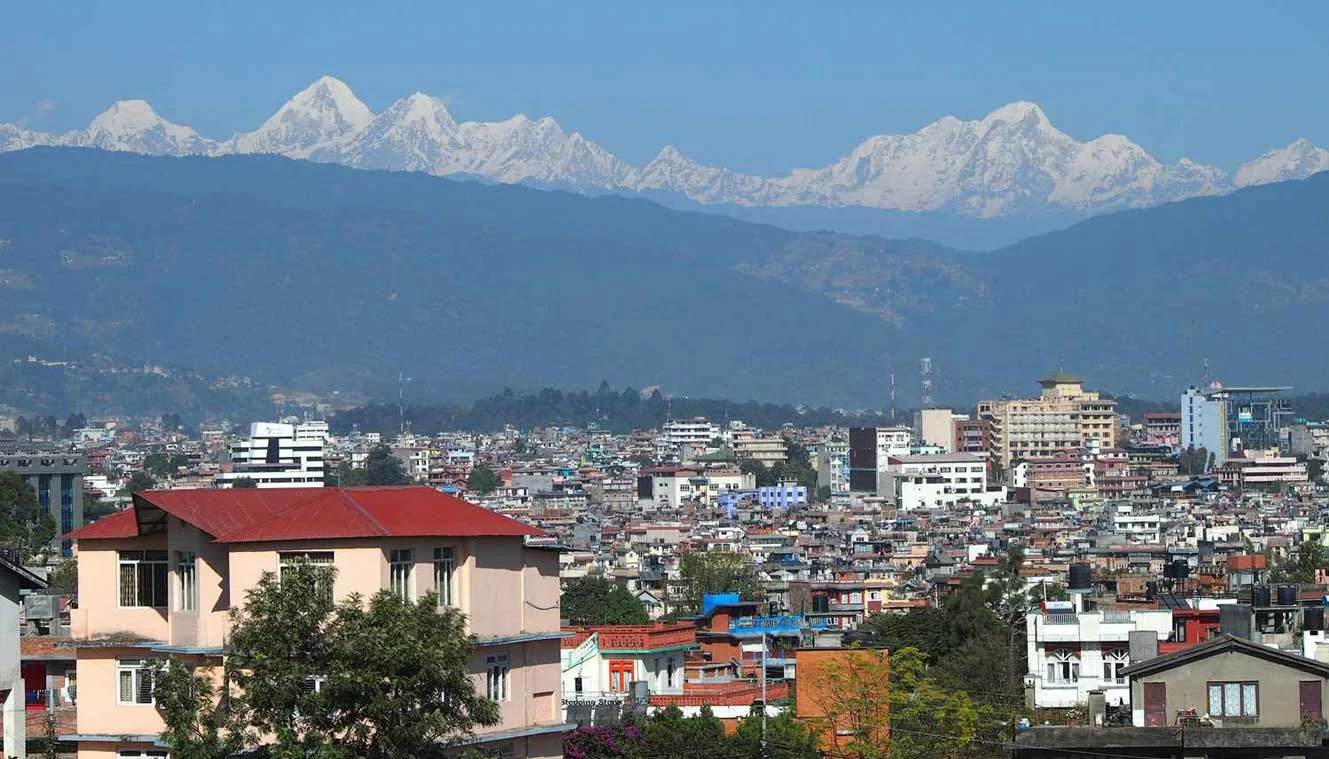
Fly to Lukla, Trek To Phakding | Enjoy A Scenic Flight Journey
- Altitude: Lukla - 2,850 m/ 9,350 ft; Phakding - 2,600 m/ 8,500 ft.
- Altitude Gain: 1200 m/ 3,900 ft.
- Early morning flight to Lukla (30 minutes).
- Trek to Phakding: 9 km | Duration: 4 to 5 hrs.
- Easy and gradual descent.
- Cheplung village lies en route from where you can see Mt. Khumbila.
- You can buy or refill your water bottles from teahouses on the way.
Get ready for a beautiful flight from kathmandu or ramechap to Lukla. Its a short flight of about 35 minutes that will take you over a panoramic landscape. On these flights, the planes are quite small but the journey is quite scenic. Our representatives will meet you at Lukla airport and this is where your trek towards Everest Base Camp starts.
After arriving at Lukla, we will start our trek towards Phakding after some refreshments. The trail is 9 km long and passes through Nepali mountain villages, green mountains, suspension bridges, and forests to Phakding. It takes about 4 to 5 hrs to complete the trek. From Lukla, the trek begins with a gradual ascent, with a few ups and downs along the way. Along the route, you will witness amazing views of Kusum-Kanguru as you cross a suspension bridge on your way. After a short climb, you will arrive at Ghat Village and after another one and a half hours of gradual walking, you will arrive at Phkading. En route, you will also spot boulders that are carved with Buddhist Prayers. We will stay overnight in Phakding.
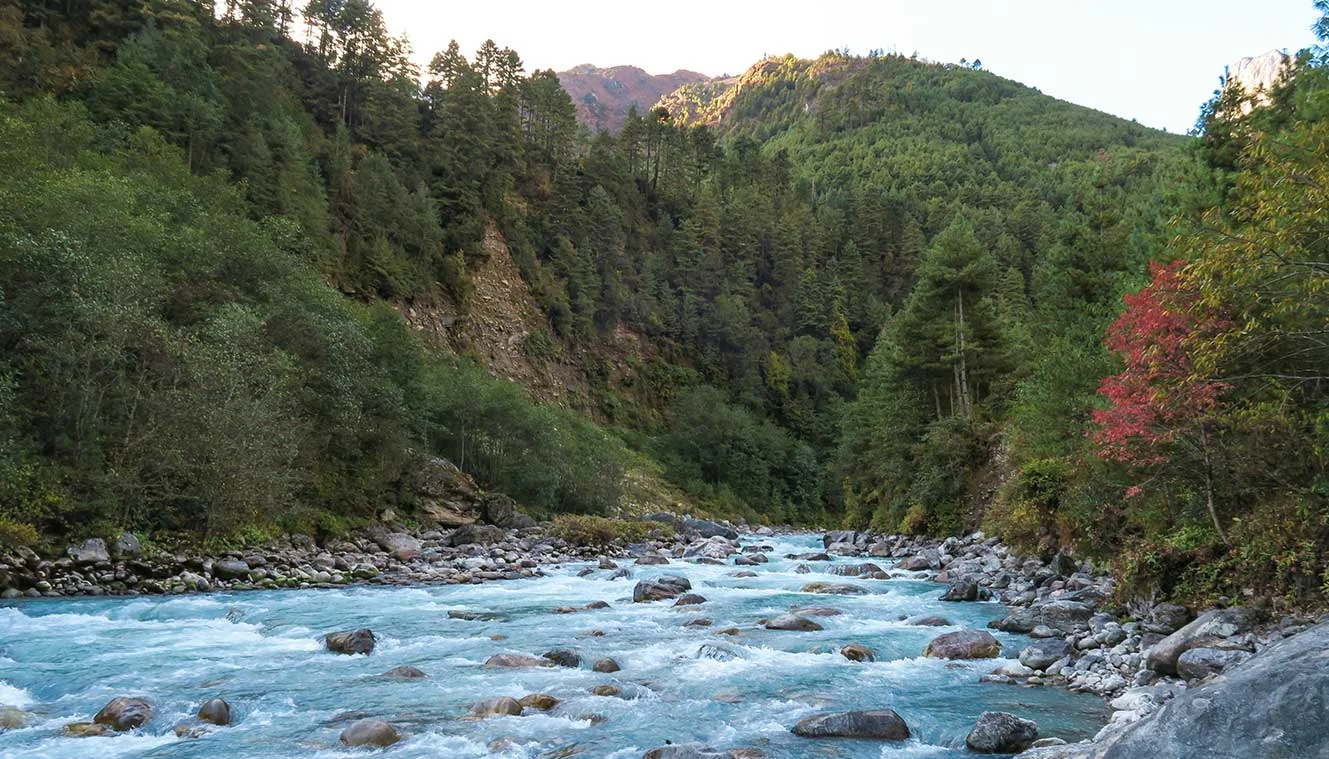
Phakding To Namche Bazaar | A Major Trading Hub In Khumbu
- Altitude: 3,450 m/ 11,300 ft
- Trek Distance: 10 km | 7 hrs.
- Altitude Gain: 850 m/ 2,800 ft.
- Moderate level of climb and steep climb before Namche Bazaar.
- Namche Bazaar is the capital of the Khumbu region.
- You will get the first views of Mt. Everest today.
- You will spot Kongderei and Thamserku Peak.
- Monjo village is the mid-point of the trek.
- A Swiss suspension bridge on the Dudhkosi River. It is one of the major attractions.
- Dudhkosi River is considered the lifeline of the Khumbu Region.
- Today you will enter the Sagarmatha National Park (a UNESCO World Heritage Site).
Post breakfast, we will start our trek toward Namche Bazaar. The route today is surrounded by green mountains and will take you through suspension bridges over the Dudh Koshi and Bhote Koshi rivers. Before entering the Sagarmatha National Park, you will have to obtain permits and then the trail follows a steep ascent before arriving at Namche Bazaar. Namche Bazaar is an important trading hub of the Khumbu region.
We will start our trek early in the morning from Phakding and soon you will cross a suspension bridge over the Dudh Koshi River, the walk from here is easy and pleasant with short uphill and downhill climbs. You will cross another suspension bridge over the Bhote-Koshi River. It is a busy area and you may notice a multitude of trekkers and porters here. After a 20-minute climb from this area, you will arrive at Monjo. Monjo is a pit stop for many trekkers and many people also camp here. At Monjo, you will see interesting watermills that are used to grind barley, a staple diet of the Sherpas. Monjo is situated right below the majestic Thermasarkhu peak (6,608 m) and quite close to this village is the entrance to the Sagarmatha National Park.
Treading along the Dudh Koshi River, you will arrive at the Sagarmatha National Park. At this point, your trekking permit will be checked and the officials will keep a record of all the trekkers going ahead. Sagarmatha is a UNESCO World Heritage Site that showcases stunning mountain views and rich biodiversity. Here, you may spot rare Himalayan species like snow leopards and the lesser panda. The presence of Sherpa settlements with their unique culture makes the trek even more interesting. A gradual walk from Sagarmatha National Park will lead you to Namche Bazaar. From Namche Bazaar, you will catch the first glimpses of Mt. Everest. Namche Bazaar is a historic trading center of the Khumbu area and you can stock up on essentials from this point. At night we will stay here at a guesthouse.
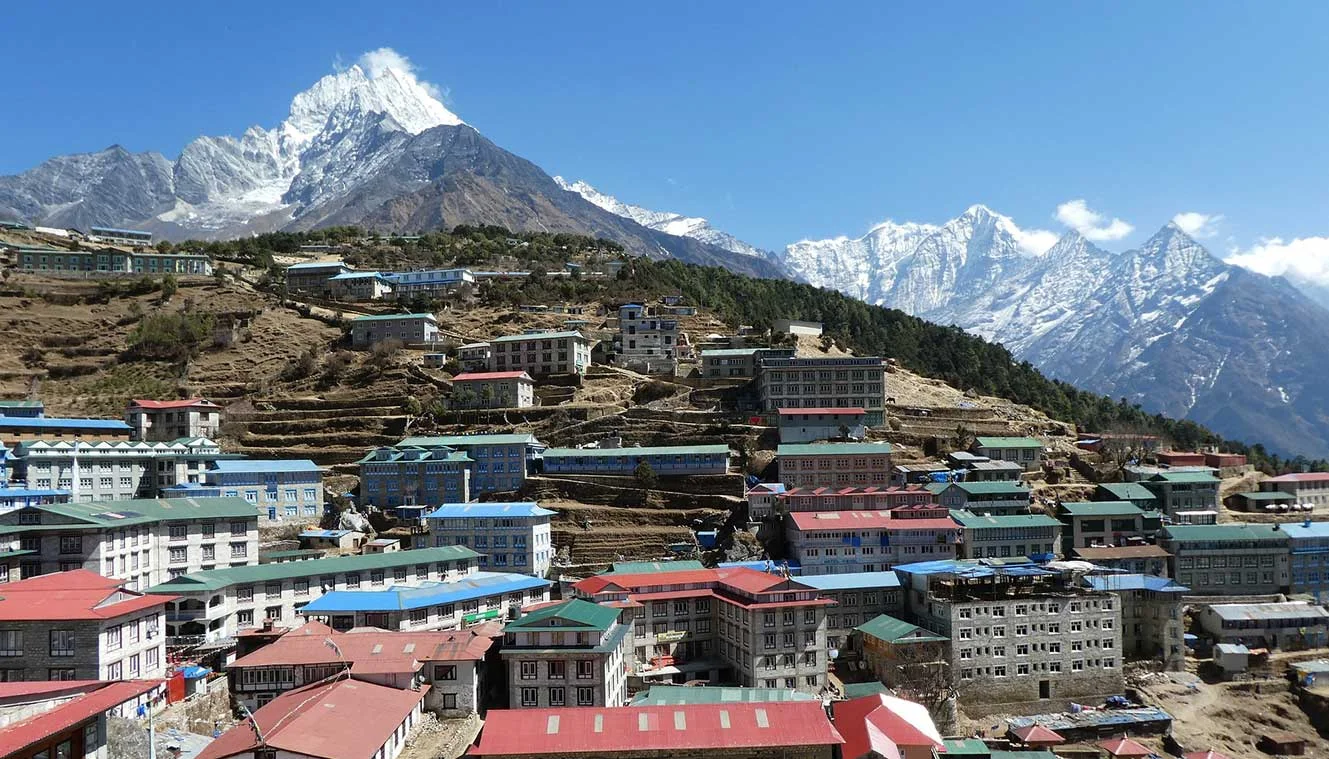
Acclimatization Day | Explore Namche Bazaar
Wake up to the beautiful views of the highest Himalayan peaks and enjoy a delicious breakfast. Today we will stay in Namche Bazaar allowing our bodies to acclimatize to high altitudes. You can spend the day exploring the surroundings and enjoy the culture and hospitality of Nepal. Namche Bazaar is a commercial hub so you can do any last-minute trek shopping from here. The market has a vibrant atmosphere and there are a couple of restaurants and coffee shops as well.
You can do a short hike to Sagarmatha National Park headquarters. From here, you can get a good view of Ama Dablam, Mt. Everest, and other Khumbu peaks. Sherpa Cultural Museum is close by and lies just above Namche Bazaar. The museum gives you a fair amount of details about the history of the Himalayas, the geographic and cultural aspects, mountaineering history, and information about the various flora and fauna in the region. You will see many pictures of Tenzing Norgay and Edmund Hillary from their climb and maps detailing their trails as well. In the evening, take acclimatization walks around the market, preparing your body for higher altitudes. Soak in the Nepalese Buddhist culture, food, and traditions. Namche Bazaar gained popularity during the time when Tibetan salt was traded for grains from Nepal\\s lowlands. Nowadays, you can see a roaring trade of rugs, clothing, dried meat, and salt in the village center. There are many shops that also offer locally made handicraft items, you can buy them as souvenirs or gifts for your friends and families. You will stay the night at a guesthouse in Namche Bazaar.
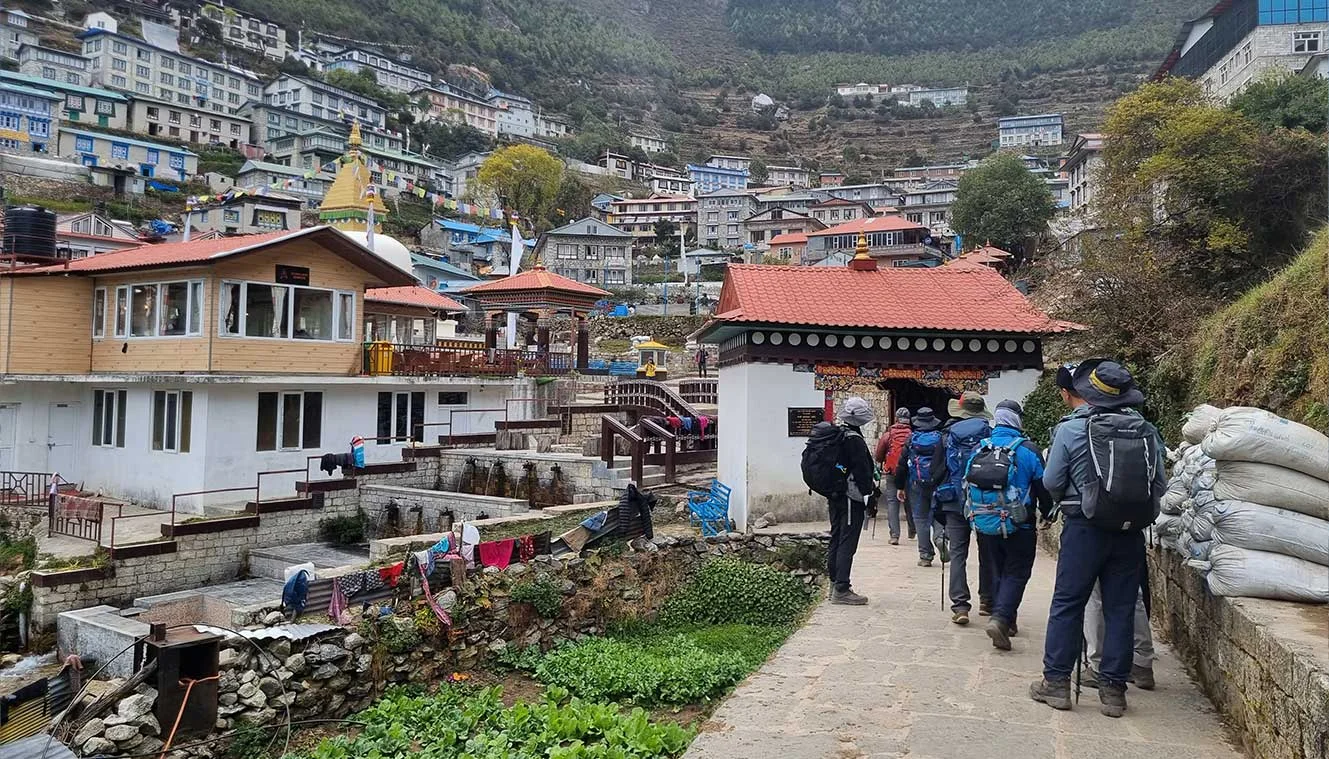
Namche Bazaar To Tengboche | Visit The Largest Buddhist Monastery Of Khumbu
- Altitude: 3,850 m/ 12,650 ft.
- Altitude Gain: 400 m/ 1,350 ft.
- Trek Distance: 8 km | Duration: 5 to 6 hrs.
- Mixed ascent till Phunki Tenga.
- Steep ascent after Phunki Tenga to Tengboche.
- Tengboche has the biggest monastery in the area.
- You can attend a prayer ceremony held by the monks to invoke protection on your expedition.
- Cross another high bridge at the village of Phunki Tenga.
Start your day with a delicious breakfast and get ready for your trek to Tengboche from Namche Bazaar. It’s an 8 km long trail and is a fairly easy trek accompanied by the views of the majestic Himalayas. You will also spot Himalayan Wildlife on the way as well.
Tengboche is a small alpine valley that is situated at an altitude of 3860 m and the trek starts with an easy walk. The trek from Namche Bazaar to Tengboche is extremely beautiful and along your trek, you will get a bird’s eye view of Dudh Koshi River down below and the epic mountain views as Thamserku (6,608 m), Kantega (6,782 m), Ama Dablam (6,812 m), Lhotse (8,516 m) and Everest (8,849 m) comes into view.
A 20-minute walk from Namche Bazaar will take you to the top of Namche Bazaar. From here the trek descends to Khumjung, a Sherpa village and then climbs up the sides of the mountains through some stairs and then diverges from the Everest Highway at Sanasa. You will be able to catch glimpses of Lhotse, Nuptse, and Mt. Everest from here. This is probably the best view of Mt. Everest you will get until you reach Gorakshep when climbing to Kala Patthar. Two hours of pleasant walking will bring you to Sanasa. Up to Sanasa, it is a walk-through forest covers of Oak and Rhododendrons. It is a great location for bird watching and you may spot the Danphe Pheasant, the national bird of Nepal. Musk-deer and Himalayan Tahr, a Himalayan goat that looks like an antelope are commonly spotted in these areas. You will also spot the Tengboche monastery from here which you will reach in the later part of your trek.
Next, following a gradual descent, you will reach the Imajtse River at Phungitenga at an altitude of 3,250 meters. Phunki Tenga is a small Himalayan settlement with teahouses and army posts. The climb down can be a little tougher as the terrain is rocky and uneven. You will reach a suspension bridge over the river and after you make the crossing, you will need to get permits at a checkpoint to proceed further in your trek. From here it is a strenuous climb of about an hour that will take you to a Buddhist monastery just before Tengboche and finally to Tengboche village. This is the last part of today’s trek and you can expect the trail to be rocky with a couple of switchbacks. Don’t push yourself too hard, take it slow and steady as you make your trek uphill.
Tengboche Monastery, locally known as Dawa Choling Gompa is the largest monastery in the Khumbu region. It overlooks the beautiful region and the mountain landscapes around. There are daily prayers that occur around 7:00 am and once around 3:30 pm. You can take part in the prayers if you truly want a cultural experience. It is one of the important cultural aspects of the EBC Trek. Enjoy the serenity at this revered place of worship and at night your stay will be in the guesthouses at Tengboche.
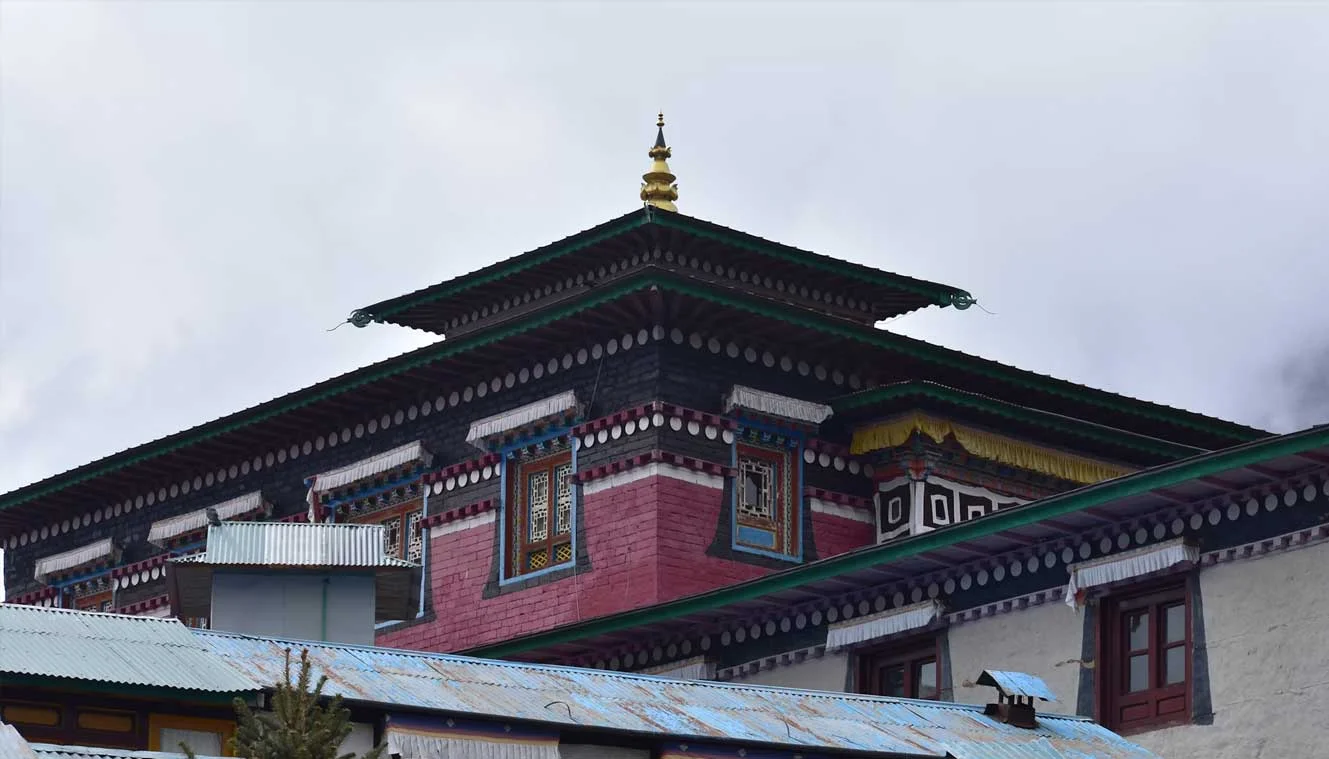
Tengboche To Dingboche | Stunning Views Of Ama Dablam
- Altitude: 4,350 m/ 14,250 ft.
- Altitude Gain: 500 m/ 1,600 ft.
- Trek Distance: 9 km | Duration: 6-7 hrs.
- Gradual descend and little bit of ascent after Lobuche River to Dingboche.
- The trail passes through lush forests of birch, conifer, and Rhododendron trees.
- The route offers amazing views of Ama Dablam standing over you.
- The trail crosses the Imja River to reach Pangboche.
- Continue along the Imja Valley and Lobuche River before ascending to Dingboche.
Today, we will begin our trek towards Dingboche. From Tengboche, cross bridges and rivers accompanied by beautiful mountain views all the way to Dingboche. Stone steps will lead you through forests of Rhododendrons, conifers, and birches, and at the bottom of the forest lies the Deboche village. From here, the trail rises up and enters into the alpine meadows and Dingboche. Dingboche is the only place in the entire Khumbu region where barley is grown. The views of the Himalayas are amazing from Dingboche. Start your trek from Tengboche and walk towards Pangboche Village, you will get to see some beautiful views of Mt. Ama Dablam and from Pangboche we will trek towards Pheriche and to Imja Valley. The beautiful Lobuche River passes through Imja Valley and from here a steep hike will take you to Dingboche. The trek takes about 6 to 7 hrs and for the most part, the difficulty is moderate.
At the beginning of the trail, you will first descend into a forest trail passing the small settlement of Deboche. As you trek from Tengboche to Dingboche, the scenery changes as you gain altitude, greenery slowly giving way to barren landscapes, and the trails gradually becoming more rugged and it will also start getting cold and windy. In the initial part of the trek, you will pass by a wall with stone inscriptions and a small stream will keep you company along the trail. You will have to cross the stream to the left-hand side of the valley. The majestic Ama Dablam dominates the skyline ahead of you. About two hours into the trek, you will arrive at Pangboche, a mountain village, where you get beautiful views of Mt. Everest. From Pangboche, you will hike upwards towards the valley and throughout the trek, you will slowly gain elevation. Although the trek is mostly uphill, the slope is relatively easy without extremely steep inclines. Ama Dablam continues to stay in view, however, you will only get to see a tiny silver of the top of Mt. Everest. Lhotse and Nuptse become quite prominent now.
Soon you will arrive at the village of Shomare, your last village before Dingboche. Ama Dablam still remains in view but now you will get to see a different angle of the mountain from what you have seen before. The trail continues winding to the valley side and you will cross another river before entering Dingboche village. Dingboche is a lovely Himalayan hamlet and you will see agricultural fields protected by stone walls. Once at the village, we will check into a guesthouse and we will stay the night in the guesthouse.
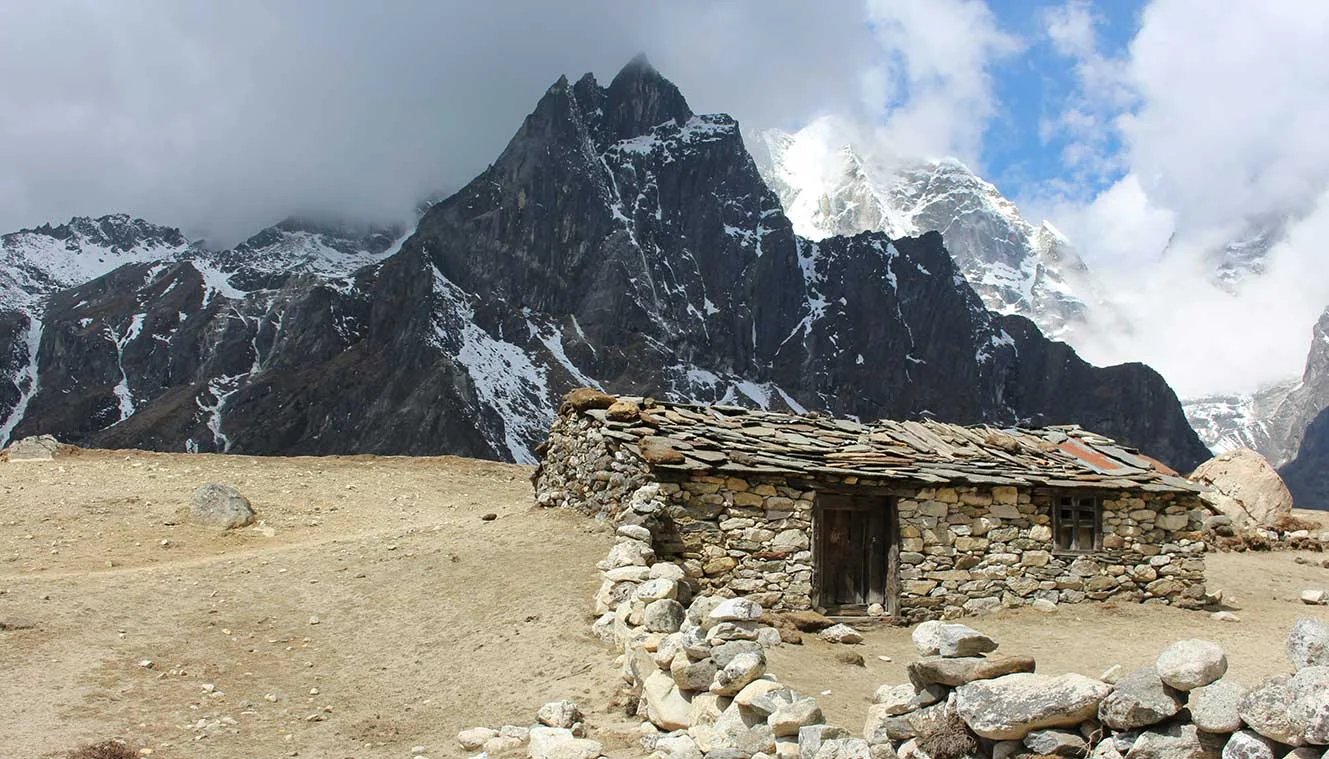
Dingboche (Rest Day) | Acclimatize To Higher Altitudes
Today is a rest day at Dingboche, which will help us acclimatize to the high altitude. As we exert a good deal of energy on the trek, our body needs to get accustomed to less oxygen at higher elevations. So instead of taking a rest day, if continue to gain elevation it can result in altitude sicknesses like dizziness, nausea, and headache or potentially even more dangerous conditions like cerebral or pulmonary edema. To prevent these issues, we start our acclimatization process at the 11,500 ft mark. Since Namche Bazaar is quite near that elevation, we start our acclimatization process from Namche Bazaar itself.
For acclimatization, you can walk around the village. Dingboche village has many farms and crop fields sparse across the village, native crops include barley, potatoes, and buckwheat. You can also do a short hike around the village to Chukung. Its a 3 - 5 hrs trek that takes you to an altitude of 4,730 m. Chukung lies in the Imjatse Valley towards the east. Although the trek is gradual you can feel the effects of thinning air. Chukung has a couple of teahouses as well and you get a superb view of the surrounding areas from here. Some of the views are exceptionally beautiful as you continue to climb higher and higher. Explore the valley and the surrounding areas, return back to the guesthouse. This hike will prepare your body for the next few days at higher altitudes.
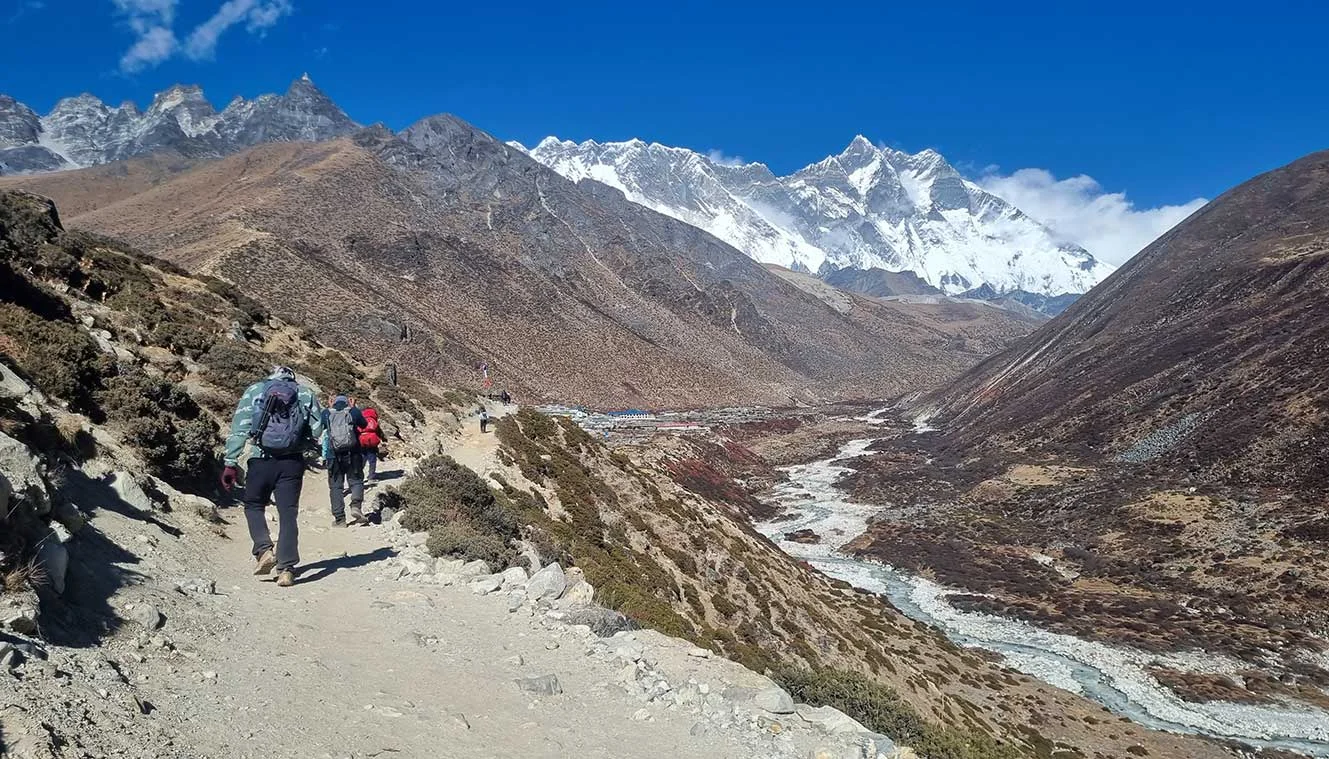
Dingboche To Lobuche | Pay Your Respects In Everest Memorial
- Altitude: 4,950 m/ 16,200 ft.
- Trek Distance: 7 km | Duration: 6 hrs.
- Altitude Gain: 600 m/ 1,950 ft.
- Tricky climb on moraine and rocky terrain.
- You can visit the memorial shrine.
- The top of the ridge is filled with prayer flags and stones which are memorial shrines for climbers who lost their lives on Mt. Everest.
- As you cross Khumbu Glacier, you will see Mt. Nuptse (7,861 m).
Today’s walk will take you from Dingboche to Lobuche through alpine pastures and in the summertime, you can see Yaks grazing in these pastures. You will trek towards the end of the moraine of the Khumbu Glacier offering spectacular views of Mt. Nuptse. At the moraine, you will see stone monuments, these are dedicated to six Sherpas who died in an avalanche along with monuments dedicated to other mountaineers. From here, it’s a steep climb towards Lobuche where you will get a magnificent view of Mt. Nuptse and the sunset over this mountain peak is even more spectacular. From Dingboche, you will have to ascend a small ridge behind the village, towards the north you can see Lobuche Peak (6119 m) and the snowfields of Cho La. Later you will cross Khumbu Khola, the huge glacier moraines of the Khumbu Glacier flowing from Everest. Crossing the memorial cairns, and following the valley stream, you will arrive at Lobuche in the early afternoon. The 6 hrs trek covers 7 km and brings us much closer to the Everest Base Camp.
Start the hike from Dingboche along the inclined path running alongside the mountain’s wall and go further into the valley. As you make your turn along the path and inside the valley, you arrive at the village of Pheriche, we will be staying here on our way back from the base camp. For the next 2 to 2.5 hrs, you will follow into the valley, while the incline is not very difficult but you are at a high altitude, so take it slow and steady and avoid using too much energy too quickly. A river lies in front of you and crossing the river, you will arrive at the village of Thukla. This is a great spot to rest for a couple of minutes, refuel yourself and continue on the trek.
The next part is going to be the toughest part of the trek today as you climb to Lobuche. The climb takes you along a zig-zag path all the way to the Thukla Pass and it becomes steeper and steeper as you climb until you reach the edge of the Khumbu Glacier and the Everest Memorial. The oxygen gets less and less from here and the temperature also starts to get lower. The remaining part of the trek follows the left side of the glacier as you reach the village of Lobuche and you will also gain a little elevation from the glacier as you arrive at Lobuche. In front of you, you get to see a beautiful view of Nuptse in front of you. Lobuche is a small Himalayan village with only a handful of teahouses. We will stay the night here before we head out to the last village on the trek tomorrow.
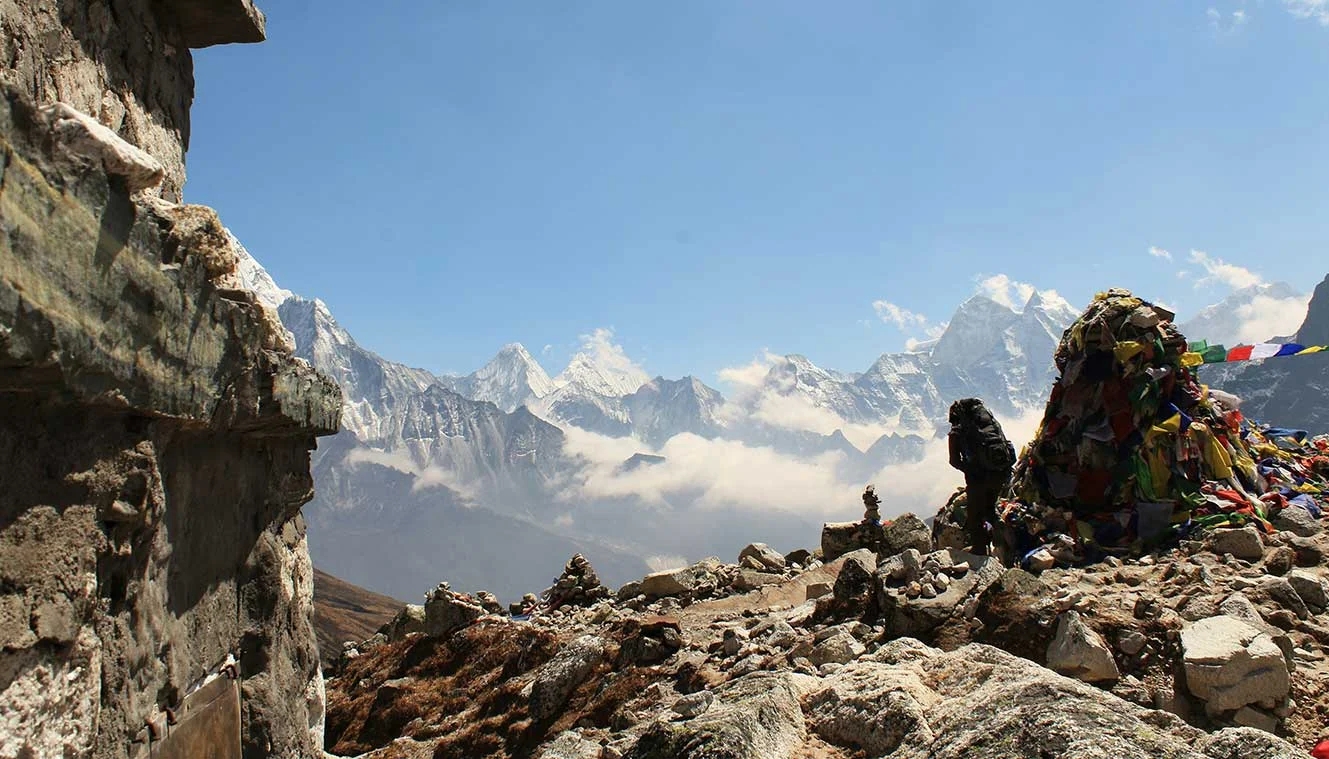
Lobuche To Gorkhashep | Excursion To Everest Base Camp
- Altitude: Gorakshep - 5,150 m/ 16,900 ft & highest point - 5,350 m/ 17,750 ft.
- Altitude Gain: 200 m/ 700 ft.
- Lobuche To Gorakshep: 6 km | Duration: 4 hrs.
- Gorakshep To EBC: 3 km away each.
- It’s Everest Base Camp Day Today.
- Good steep climb to Gorakshep.
- It takes about 3 to 4 hrs to reach Gorakshep.
- Lunch is at Gorak Shep.
- A steeper climb to Everest Base Camp.
- The trek to Everest Base Camp is not very difficult.
- Trekker\\\\\\\\s stop point is just below the actual base camp.
- Most tour groups are not allowed to enter or stay in EBC.
- Make sure you carry your day pack since you will need water.
- You can enjoy amazing views of Nuptse, Khumbutse, and Pumori mountains from the base camp.
- Overnight stay in Gorakshep.
Note: Drinking water in Gorakshep is chargeable. We don’t include drinking water on the trek which you can buy from a number of places between $1 to $3 a bottle (it gets more expensive towards the base camp). The better alternative is to buy water tablets in Kathmandu/Pokhra for around $2 and treat the water.
Today is the most exciting day of the trek as you make an excursion to the Everest Base Camp. An adventurous journey and a great trekking experience await you. Waking up early, have your breakfast, and gear yourself up. We will follow the trail from Lobuche through narrow gaps in the mountains and glacial moraines along the Khumbu glacier to Gorak Shep, the last village on the trek. Post lunch in Gorak Shep, we begin our trek to the Everest Base Camp, the ultimate adventure of this entire journey. We follow the lead of Sherpas as the trail changes every season as the glaciers move. It takes about 7 hrs of walking to reach Everest Base Camp. Spend some time at the base camp, celebrate your victory, capture some stills and descend back to Gorakshep. Overnight stay will be at Gorakshep.
The trek today can be broken down into two parts, the first part is the trek from Lobuche to Gorak Shep and the second part is an excursion to EBC and back to Gorak Shep. After breakfast at Lobuche campsite, we begin our trek towards Gorak Shep. It is a 6 km hike that takes about 4 hrs. Walking along the sandy and rocky parts, you will gradually gain elevation as you walk alongside the Khumbu Glacier. Mt. Nuptse looms on the horizon in front of you. Some sections of the trail are a little steeper than others. On the way, you will pass Sherpa flag monuments indicating that you are getting closer to the Everest Base Camp.
The last section of the trail directs into a glacier before you reach Gorak Shep. the terrain is rocky and uneven with inclines and declines. Be cautious and watch your step in this part and always pay heed to the trek leader\\\\\\\\s advice to complete the patch safely. You can see a sliver of the top of Mt. Everest from here, right behind Nuptse. Soon the village of Gorak Shep comes into view guarded by Kala Patthar and Pumori in the back. Make your way into the guest house have some lunch, reenergize yourself and get ready for the next part of the trek.
From Gorak Shep, you will walk right along the Khumbu Glacier, the Everest Range lies right behind it. It is a vast glacier and as you continue walking along the side of the glacier, you will constantly gain elevation until you reach the base camp. The incline is not very steep and is slightly moderate. A technical terrain lays ahead of you with a mixture of sand and rocks and it can get pretty slippery at some points as well. As long as you watch your steps, you will be good. Continue on and you will reach a point where the Khumbu icefall comes into better view as it winds down from the mountain to the valley. More Sherpa prayer flags mark the way to the base camp. In the final stretch of the trail, you will see numerous prayer flags flowing in the wind and the popular Everest Base Camp Rock. You have made it to the Base Camp, congratulations! While this is not the actual base camp, it is a trekker’s base camp. Most tour groups are not allowed to enter or stay in EBC. Once you have had enough time to enjoy the area around EBC, it is time to head back to Gorakshep. Follow the rocky trail back to Gorak Shep. We will stay the night in Gorak Shep.
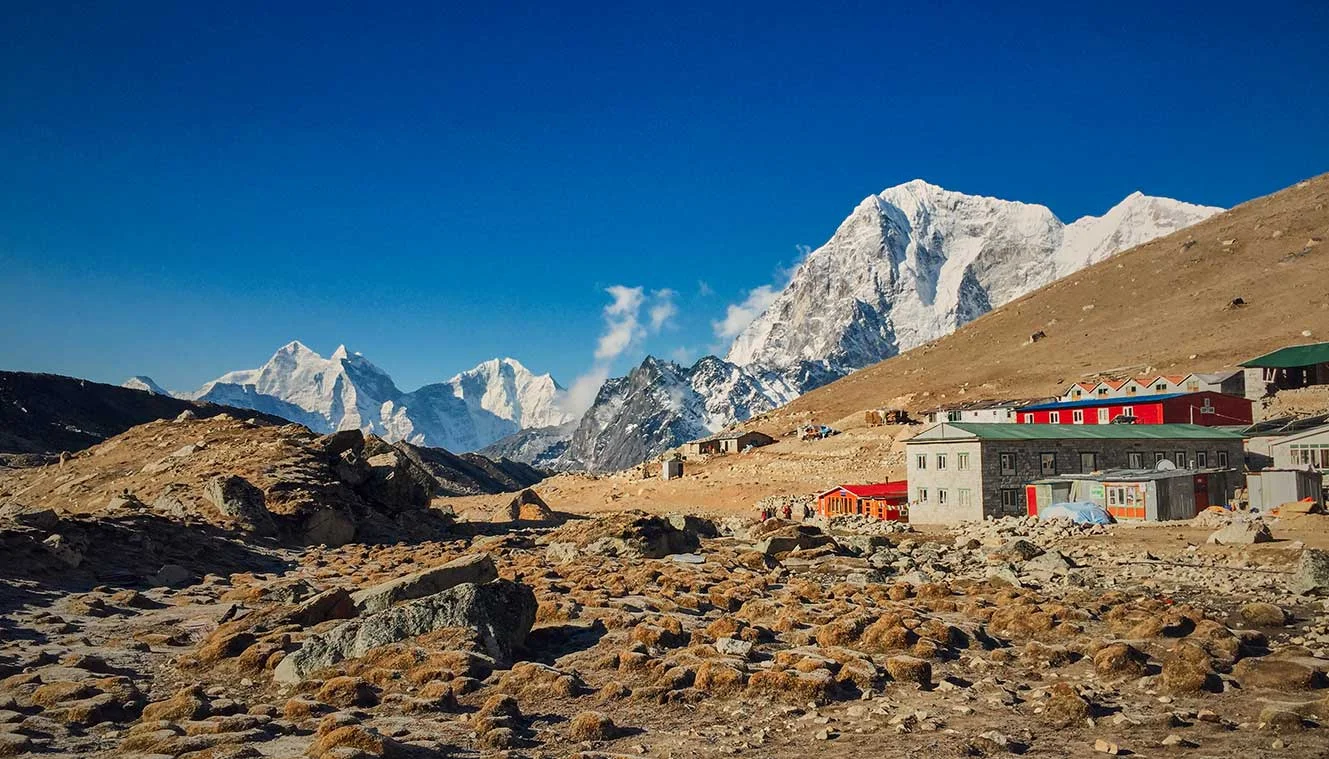
Hike To Kalapatthar And Retreat Trek To Pangboche | Enjoy Arresting Views Of Mt. Everest
- Altitude: Kalapatthar - 5,550 m/ 18,200 ft Pangboche - 4,300 m/ 14,100 ft.
- Gorakshep To Kalapatthar: 2 km each way | Duration: 3 to 4 hrs.
- Gorakshep To Pangboche: 25 km | Duration: 6 hrs.
- Altitude Loss: 850 m/ 2,800 ft
- Steep climb to Kalapatthar (difficult).
- Gradual descent to Pangboche.
- Start early in the morning to avoid early morning clouds.
- Kala Patthar is the rocky hilltop below Pumori.
- Views from the summit: Everest, South Col, Lhotse, Makalu, Khumbu Glacier & icefall, Pumori & Everest Base Camp.
- Breakfast at Gorakshep after Kalapatthar hike.
After your trek to EBC and back to Gorakshep, you are now ready to climb Kala Patthar. Gorakshep is also a good place to roam around, it has a couple of teahouses and it also used to be the base camp for climbing Mt. Everest in the 1950s. The trek starts with an easy walk from Gorakshep and you will be walking on sandy fields. After this, there is a steep climb of 45 minutes. After the strenuous climb, you will come to level fields and the walk is easy and gradual. You will have the comfort of walking for the next one hour, post which there is another steep climb to Kalapatthar for about half an hour. Mt. Everest from this point looks closer than you can imagine. From here, you will trek down to Pangboche.
Start your day early and leave your stuff at Gorakshep, only carry a daypack with the essentials as you will return to Gorakshep. As you cross the sandy trail and begin ascending, you will notice the Gorakshep village and Khumbu Glacier behind you including Ama Dablam. The top of Mt. Everest begins to peek out above the surrounding mountain ranges. The more you gain altitude the more Mt. Everest will come into view. The best part of today’s trek is that all along the trek you can enjoy the landscape of the surroundings and not just on the summit. The higher you get, the rockier and trickier the trail gets. Be mindful and watch your steps. The last patch is especially rocky.
The summit is a little difficult to navigate as well. You will know you are near the summit when the Sherpa prayer flags and weather reading device come into view. Take your time and dont rush to the summit to avoid any accidents. Once you reach the summit, you will get to see the breathtaking views of the entire Sagarmatha National Park but the main attraction is of course Mt. Everest itself. You will get the best view of Mt. Everest from here. Below Everest lies the Khumbu icefall that feeds into the Khumbu Glacier and to the right is the face of Mt. Nuptse. On the opposite side of the lake, you will see even more glaciers, lakes, and mountains, as far as your eyes can see. After spending some time at the top, descend the same path that you came in. When you are back in Gorakshep have a nice meal and refuel yourself as we will descend to Pangboche.
On the trek down, the first village will be Lobuche and throughout the trek, you will again be alongside the Khumbu Glacier. You have already completed this section while ascending up so you now have an idea of what to expect. The trek is a little tricky till Sagarmatha National Park sprawls out in front of you and the rest of the part is manageable. You can have some snacks at Lobuche before heading down to Pangboche.
As you descend, you will come to the intersection where one path diverges towards Dzonghla village, Cho la pass, and Gyoko Ri, and the one on the left heads towards Pangboche. Stay on the left side of the trail and you will come across another difficult patch of the trek. You will head down from the moraine wall of the Khumbu Glacier and descend to the Thukla Pass. Crossing the Everest Memorial, begin a tricky hike down to the river below and soon you will arrive at Pangboche.
Pheriche lies just below Dingboche so after crossing Thukla, you can take the lower path towards Pheriche instead of taking the higher path towards Dingboche. Once we arrive at Pangboche, you will check into a teahouse, have your dinner, and rest for the night before heading down to Namche Bazaar the next day.
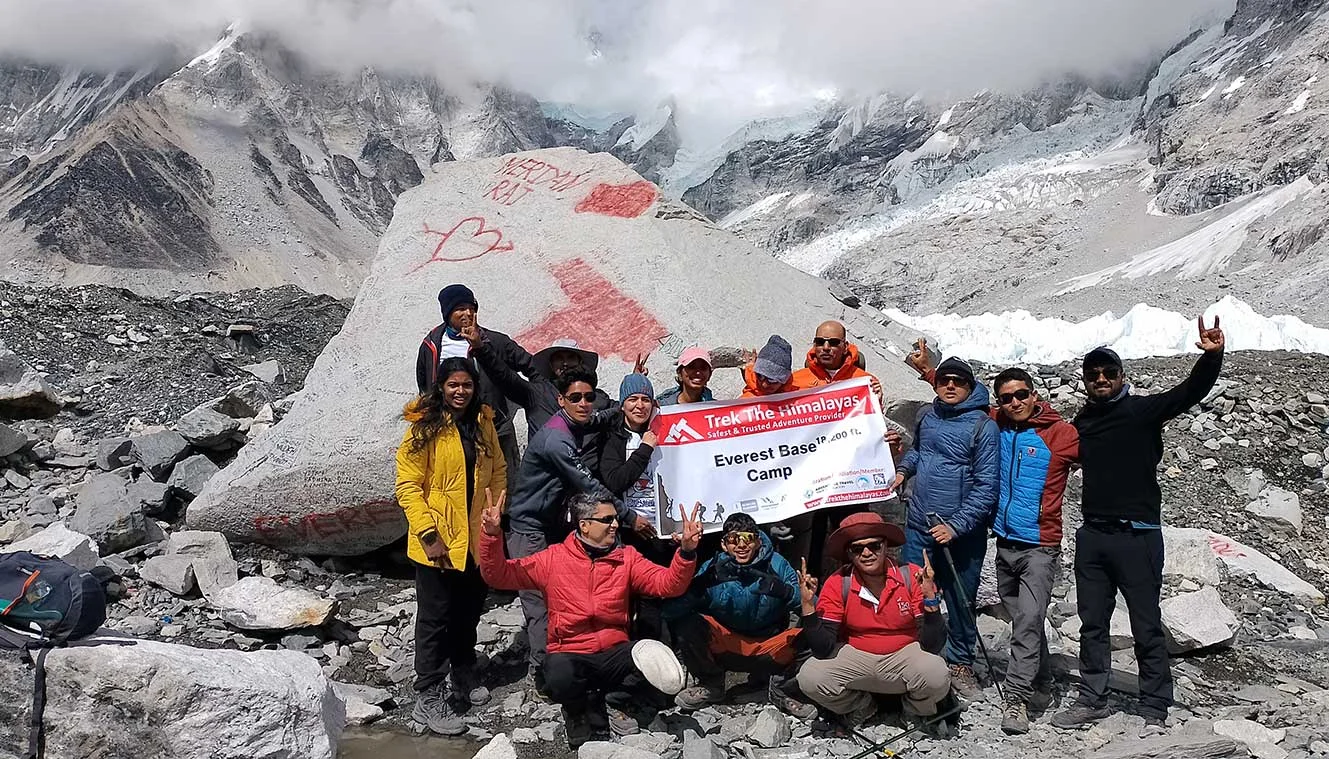
Pangboche To Namche Bazaar | Buy Some Souvenirs
- Altitude: 3,450 m/ 11,300 ft.
- Trek Distance: 15 km | Duration: 6 to 7 hrs.
- Altitude Loss: 850 m/ 2,800 ft.
- Moderately, continuous descent and short ascent just before Namche Bazaar.
After your descent to Namche Bazaar, the cumbersome part of the trekking is almost over. From here on the descent will be easy after having the Everest Base Camp trek. But we recommend starting early as it is a long walk. Start the journey by heading down to the village, across the river, and again climbing back up the valley wall. You can rest here for some time, catch your breath before resuming your decline down the valley.
Once you have declined the path, you will cross a suspension bridge followed by a 2 km incline along the valley wall. As you zig-zag up towards the trail, it becomes forested and once you have completed the uphill ascent, it is a fairly smooth walk for the remaining 5 km to Namche Bazaar. The path to Namche Bazaar is etched on a valley wall and there’s the river below. Soon the path bends inwards and you are welcomed with views of Namche Bazaar. Descend down to the village below and check into a teahouse. Rest well. Tomorrow will be the last day of your trek.
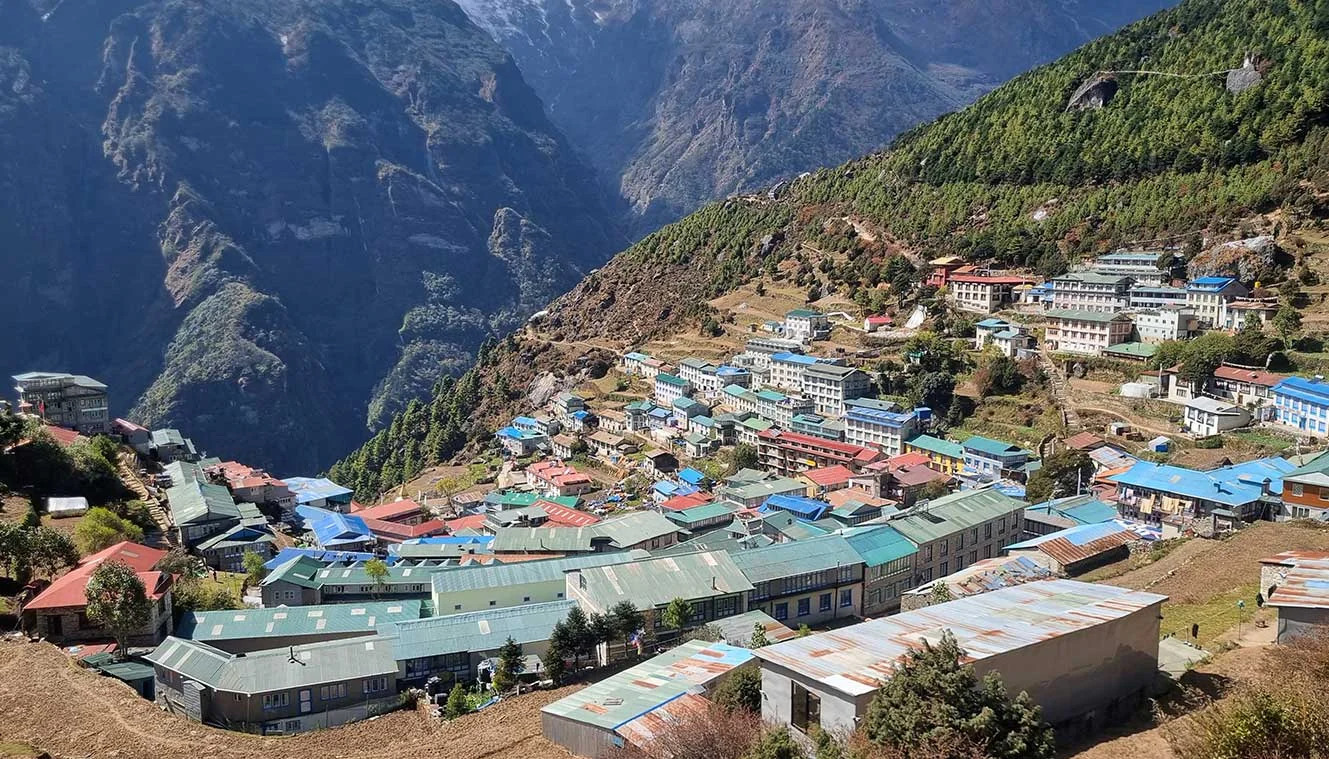

Namche Bazaar To Phakding To Lukla | Last Day Of Trekking
- Altitude: Phakding - 2,600 m/ 8,500 ft, Lukla - 2,850 m/ 9,350 ft.
- Altitude Loss: 600 m/ 1,950 ft.
- Trek Distance: 19 km | Duration: 7 to 8 hrs.
- Moderate, continuous descent till Phkading and gradual ascent to Lukla.
- Start your trek early in the morning as it is a long day trek.
- Stop at Phakding for lunch.
- Stay in Lukla.
Waking up to the lovely weather at Namche Bazaar, you can visit the place and roam around a little bit. You can explore the market and buy souvenirs from your trip to the Everest Base Camp and buy gifts for your friends and family. There are several local handicraft stores in Namche Bazaar as it is the biggest trade hub in the Khumbu region. You can also take a small walk-in around the Sagarmatha National Park and enjoy the local cuisine as well. Post which treks down to Phakding, it is an easy trek down to the village. The beauty of the distant mountains with several waterfalls adds to the beauty of your journey. This is the beauty of Nepal trekking, there will be a few uphill climbs but you will manage it very easily. The lush green beauty and forests will take your pain away. After this easy walk, you will reach Lukla. This will be your last day with the Sherpas and other crew members, so you would like to enjoy the day with a delicious dinner and a few drinks.
Right at the beginning of the trek, you will begin to lose elevation, after about 45 minutes of walking, you will arrive at a rest stop, the same that you came in on when ascending towards the basecamp. This is where you will get the last glimpses of Mt. Everest. After this point, there are no mountain views anymore only little peeks from behind the forest covers. You will cross a few suspension bridges and continue alongside the river as the initial steep decline eases into a more moderate decline. While most of the trek is downhill, there are a few uphill climbs as well. Pass by Sherpa stones into the village of Phakding. You are more than halfway to Lukla by now. We will stop at Phakding for lunch before descending further down the valley with river views, mountain ridges, and suspension bridges. You will also have several stair sections and an incline path all the way through. Passing by a few more villages, you will arrive at Lukla, your final stop for the day.
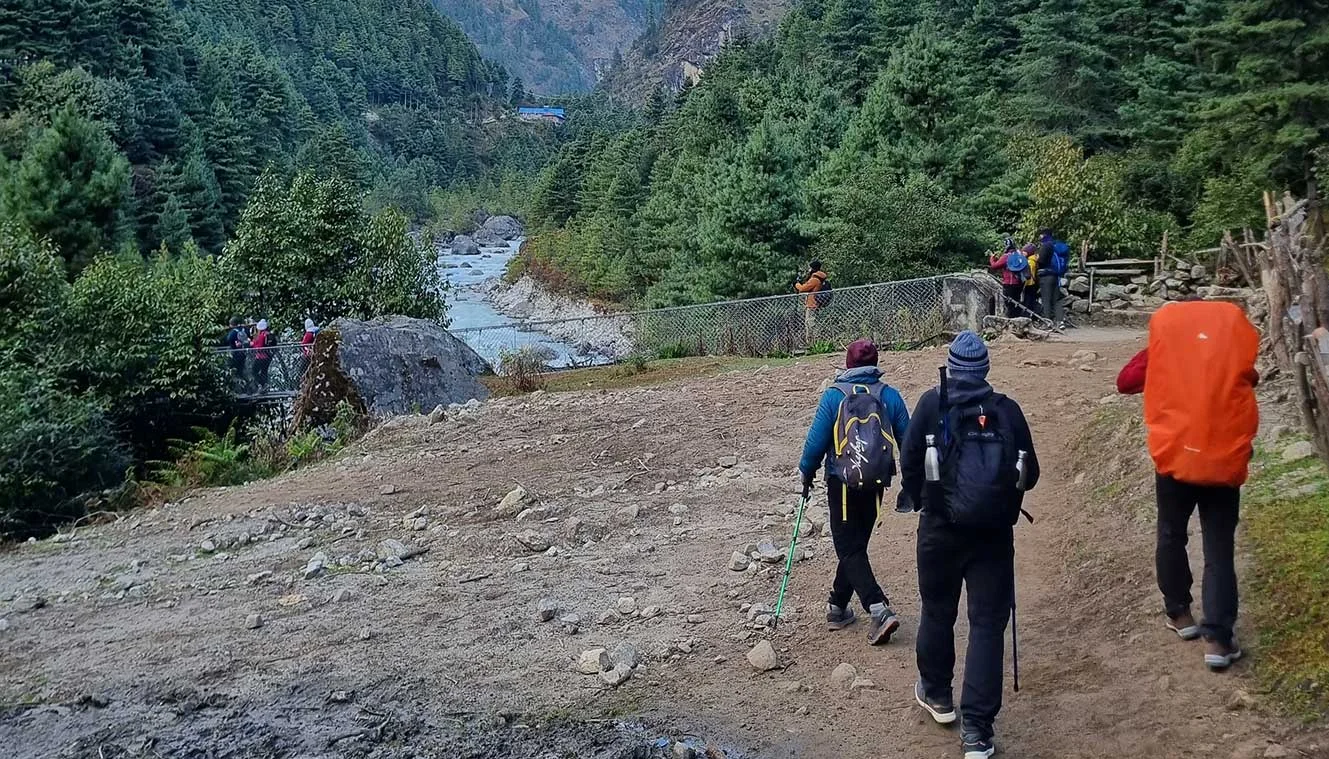
Fly Back To Kathmandu | Bid Adieu To The Mountains
Today you will have to wake up early as flights to Kathmandu are generally scheduled in the morning. This is because during the daytime, the weather is generally windy and there might be a delay in the flight timings. However, you can expect a slight delay in your early morning flight as well if the weather is not suitable. As you make your way through the security checks and your flight takes off from Lukla airport, you will have a magnanimous view of the surroundings. Drive back to Kathmandu from Ramechhap Airport and overnight stay in a hotel. You can book your further journey from here. We wish you a great journey towards your home with lots of memories.
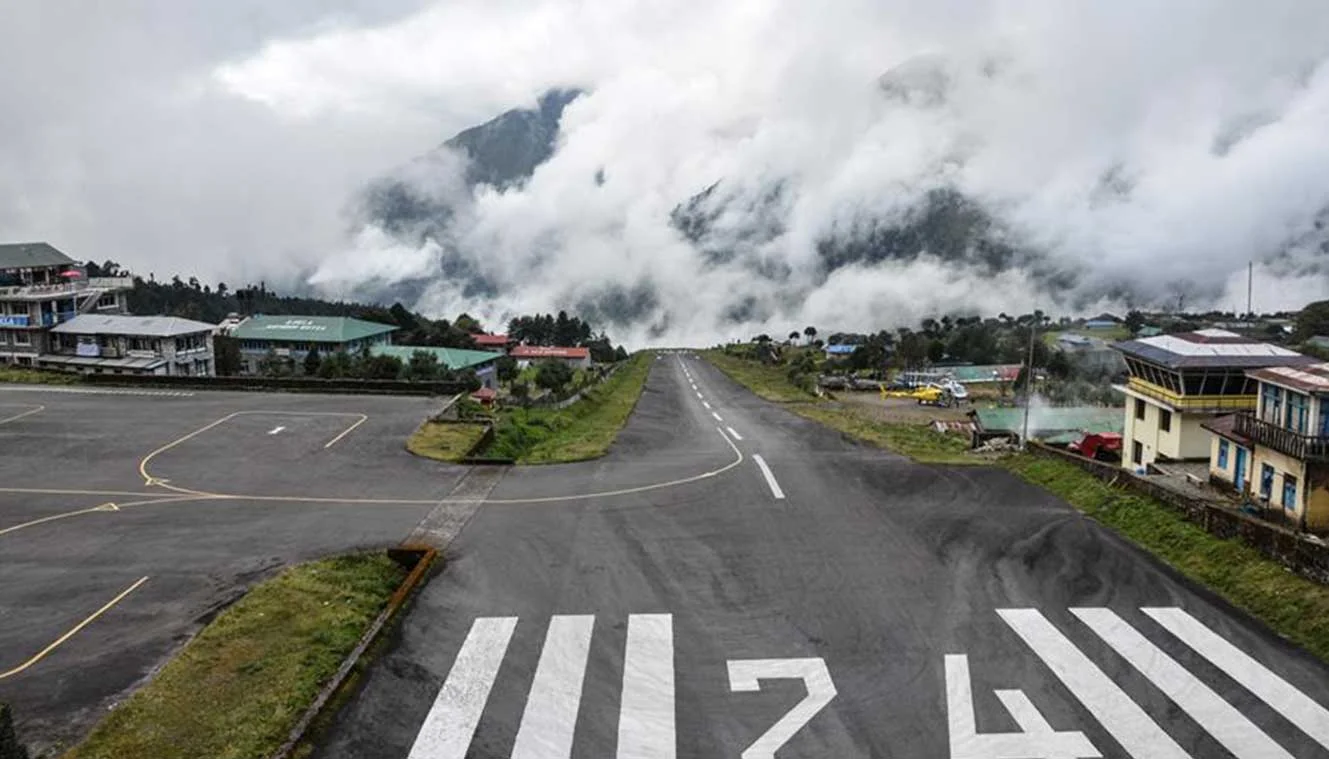
Day-1: Arrive At Kathmandu
Day-2: fly to lukla, trek to phakding | enjoy a scenic flight journey.
- Altitude: Lukla - 2,850 m/ 9,350 ft | Phakding: - 2,600 m/ 8,500 ft.
- Trek Distance:
Note: Flights to Lukla are prone to delay due to weather, keep one or two buffer days in your plan.
Day-3: Phakding To Namche Bazaar | A Major Trading Hub In Khumbu
- Trek Distance: 10 km | 7 hrs.
Day-4: Acclimatization Day | Explore Namche Bazaar
- Today is acclimatization day.
- You can hike up to Sherpa Cultural Museum to get a view of Everest and Ama Dablam.
- It’s worth exploring the town, a good place to buy trekking gear.
- ATMs, internet cafes, shops, and restaurants are available at extra cost.
- Stay in the guesthouse.
Day-5: Namche Bazaar To Tengboche | Visit The Largest Buddhist Monastery Of Khumbu
Day-6: tengboche to dingboche | stunning views of ama dablam, day-7: dingboche (rest day) | acclimatize to higher altitudes.
- Rest Day helps you acclimatize well to high altitudes.
- A small hike today will show you the world’s six tallest peaks including Lhotse (8,516 m), Makalu (8,463 m), and Cho Oyu (8,188 m).
- From another location, you can see the Imja Khola Valley and Dingboche Valley.
Day-8: Dingboche To Lobuche | Pay Your Respects In Everest Memorial
Day-9: lobuche to gorkhashep | excursion to everest base camp, day-10: hike to kalapatthar and retreat trek to pangboche | enjoy arresting views of mt. everest, day-11: pangboche to namche bazaar | buy some souvenirs, day-12: namche bazaar to phakding to lukla | last day of trekking, day-13: fly back to kathmandu | bid adieu to the mountains.
- Morning flight to Kathmandu.
- Your trek to Everest Base Camp is over.
- Spend the day in Kathmandu or fly back to your onwards destination.
- Hotel accommodation in Kathmandu is included in the cost.
Note: Weather conditions may cause flight cancellations. Delays are possible any time of the year but are more typical on summer departures. Keep one or two buffer days.
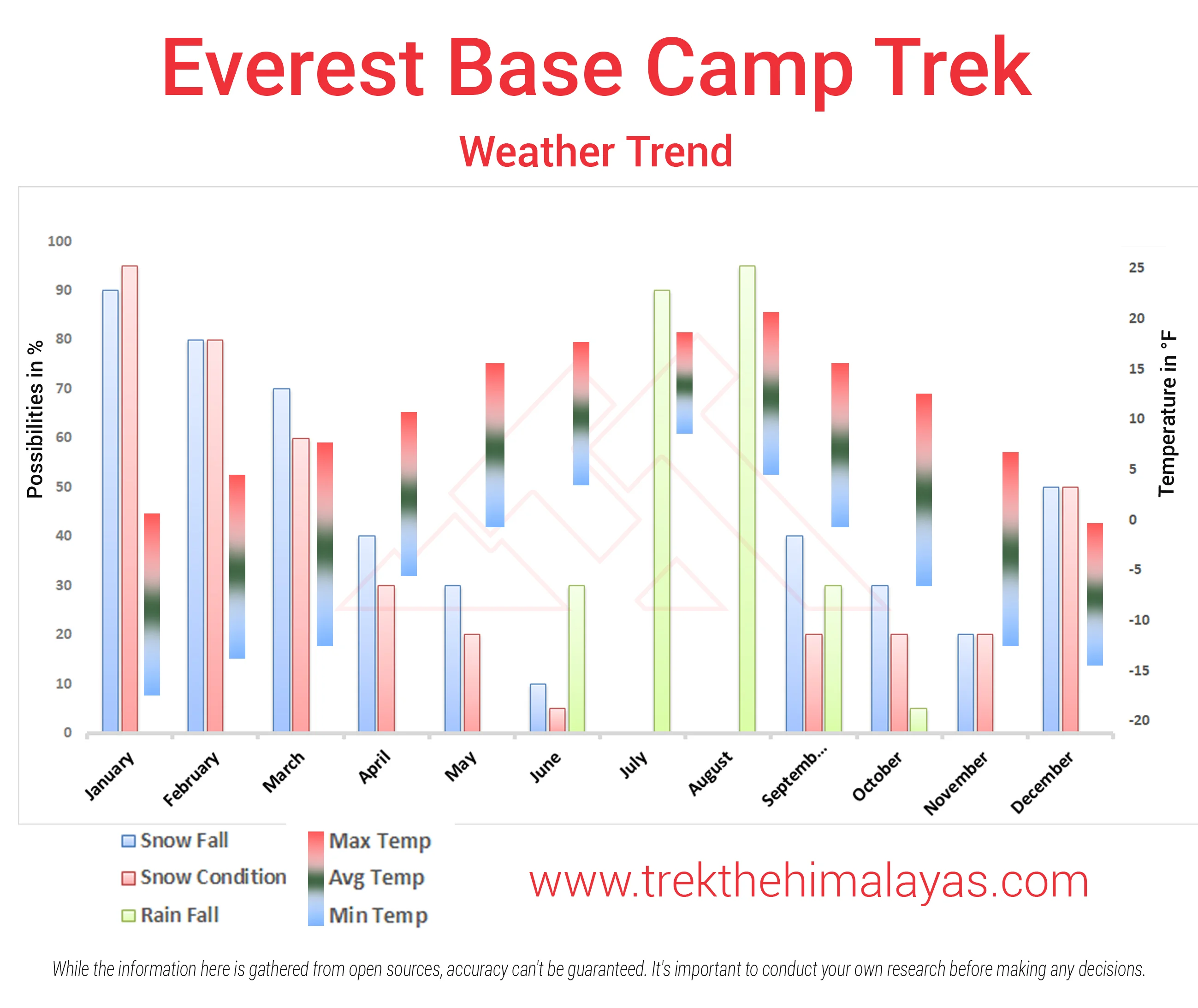
Pulse rate at rest must be in between (60 to 90 beats per minute).
Blood Pressure Reading must be in between (DIASTOLIC 70 – 90, SYSTOLIC 100 - 140 mm Hg).
Respiratory rate at rest must be in between (12 to 20 breaths per minute).
Should not have Liver and kidney issues.
Should not have Diabetes Mellitus, Bronchial Asthma, Heart problems, Hypertension, etc.
No pacemaker implant.
People with Sinus issues, Epilepsy please contact to trek coordinator before booking the trek.
If your BMI is not normal, Please contact our Trek coordinator before Trek booking.
Medical & Disclaimer Form (Mandatory Documents) Click here to download Medical & Disclaimer Form
- Government Employees can avail the benefit of Special Casual Leave (SCL) when they join us for a trekking expedition. As per the rules of the Pay Commission, Special Casual Leave can be availed for up to 30 days in a calendar year for trekking/mountaineering expeditions through a registered organization. Trek The Himalayas is a registered adventure tour operator by the Indian Mountaineering Foundation (IMF) and the Ministry Of Tourism (MOT).
- Trekkers have to apply for leave at least 20 days before the trek departure date.
- This service is exclusive to Indian government employees and is applicable only for treks within India.
- Do mail at info@trekthehimalayas to apply and mention your booked trek date and trek name.
Junior trekkers (below 15 years) should have a company of parents/guardians.
Trekkers between 15 to 18 years can come solo with the disclaimer form signed by parent/guardian.
- Medical & Disclaimer Form (Mandatory Documents) Click here to download Medical & Disclaimer Form
Exercise For Difficult
Fitness Regime For:
Calculate Your Bmi
Your BMI value is
Congratulations, your body is in good conditions!
Medical & Disclaimer Form (Mandatory Documents) Click Here.
How To Reach
It is essential for everyone to arrive at Kathmandu (1:00 pm).
Upon booking the trek, you are required to come to our hotel. Your trek coordinator will provide you with details such as the name of the Kathmandu hotel, its location, and the contact person's number.
Options to reach Kathmandu.
The best way is to fly to Kathmandu Tribhuvan International Airport, which receives airlines mostly from South-east Asia and Europe. A number of direct flights fly from Delhi, Mumbai, Kolkata, Bangalore and Varanasi to Kathmandu. Popular airlines that operate regularly are Jet Airways, Air India, IndiGo and Nepal Airlines.
Delhi to Kathmandu by train + bus :-
Day 1: Take a train from Delhi to Gorakhpur. The Vaishali Express leaves Delhi at around 19:45 and arrives at Gorakhpur Junction at 09:10 next morning, or there's another train from New Delhi at 17:20 arriving Gorakhpur at 06:35 next morning. The fare is around Rs. 2440 (£35 or $54) in AC1, Rs. 1240 (£18 or $27) in AC2, Rs. 785 (£12 or $18) in AC3 or Rs. 315 in Sleeper Class - check current times and fares at www.indianrail.gov.in or www.irctc.co.in.
Day 2: Take a bus or jeep from Gorakhpur to the Nepalese frontier at Sunauli (Indian side) and Bhairawa (Nepalese side, often also called Sunauli). Journey time about 3 hours, Rs. 55 (£1 or $2).
Walk across the frontier, it's then a few minutes’ walk to the Bhairawa bus station. Take a bus or jeep on to Kathmandu. Buses take 9 to 12 hours, cost about 120 Nepalese Rupees or 230 Indian Rupees (£1 or $2). There are many buses daily, either daytime buses leaving regularly until about 11:00 or overnight buses leaving regularly from about 16:00 until 19:00. Indian rupees may be accepted here in Bhairawa, but not further into Nepal.
It's also possible to travel via Varanasi An overnight train links Delhi & Varanasi. Buses link Varanasi with the Nepalese border.
For your return journey from Kathmandu, you have the flexibility to choose between road or air transport options. Please note that our services extend only to the hotel, and the standard hotel check-out time is 11:00 am.

1. Accommodation (as per the itinerary):
- Day 1 and Day 13 Hotel Accommodation in 3 Star Hotel in Kathmandu with Bed & Breakfast.
- Day 2 to Day 12 Accommodation in Teahouse.
2. Meals (Veg + Egg):
- All meals Lukla to Lukla from Day 2 Lunch to Day 13 Breakfast
- Fresh fruit after dinner every day.
3. Support:
- 1 Versatile base camp manager: handles communication and deploys extra manpower in emergencies.
- 1 Mountaineering & First aid qualified professional trek Leader.
- Local experienced guides (Number of guides depending on the group size).
- Enough support staff.
4. Trek equipment:
- Sleeping bag.
- Gaiters & Crampon (if required).
5. First aid:
- Medical kit, Stretcher, Oxygen cylinder, Blood pressure monitor, Oximeter, Stethoscope.
6. Transportation (as per the itinerary):
- Arrival Departure Airport Transfer as per itinerary.
- Domestic airport transfers for Lukla.
- Kathmandu to Ramecchap /Lukla, and back.
7. Mules/porters to carry the central luggage.
8. Clock room facility available at the base camp for additional luggage.
9. All necessary permits and entry fees, Upto the amount charged for Indian.
10. Services from Kathmandu to Kathmandu .
11. TIMS card.
12. EBC Map.
13. Farewell Dinner in Kathmandu.
14. Trek Completion Certificate
15. Complementary Trekking Kit Bag (Duffle bag if opted for Porter facility).
1. Insurance (Mandatory).
2. Food during the transit.
3. Any kind of personal expenses.
4. Mule or porter to carry personal luggage.
5. Emergency evacuation, hospitalization charge or etc.
6. Anything not specifically mentioned under the head Inclusion.
8. Extra Expenses.
- Porters for the personal bag*.
- Wifi, charging batteries and hot showers.
- Customary gratuities for guides & porters.
9. Nepal entry visa (approximately $40 USD, Bring Two Passport Size photos) only for foreigners (Not for Indians).
10. Unforeseen costs due to flight cancellation, weather conditions etc.
11. Extra night accommodation Kathmandu.
Things can be provided on demand and availability (participant has to pay extra for these things).
1- Satellite phone/set phone - is a type of mobile phone that connects via radio links via satellites orbiting the Earth instead of terrestrial cell sites like cellphones. Therefore, they can operate in most geographic locations on the Earth's surface.
2- Gamow/PAC HAPO Bag (Portable Hyperbaric Bag) - is a unique, portable hyperbaric chamber for the treatment of acute mountain sickness (AMS), also known as altitude sickness.
3- AEDs (Automated External Defibrillators) - are portable life-saving devices designed to treat people experiencing sudden cardiac arrest, a medical condition in which the heart stops beating suddenly and unexpectedly.
Cancellation terms:
Cancellations prior to 25 days from the start of the Trip
Refund options
- 5% deduction of trek fee
- 100% cash voucher for any trip till one year
- Transfer your trek (any trek, any date) to your friend
Cancellation between 24 days and 15 days to the start of the Trip
- 30% deduction of trek fee
- 100% cash voucher for same trip till one year
- 85% cash voucher for any trip till one year
- Transfer your trek (same trek, any date) to your friend
Cancellation between 14 days and 10 days to the start of the Trip
- 50% deduction of trek fee
- 80% cash voucher for same trip till one year
- 70% cash voucher for any trip till one year
- Book the same trek, in the same season, with any other batch
Cancellation less than 9 days to the start of the trek
- No cash refund
- 20% cash voucher for the same trip till one year
- 10% cash voucher for any trip till one year
- Transfer your trek (same trek, same date) to your friend
Note- If a booking is made using a voucher or discount code, the policies related to vouchers and discounts cannot be modified.
In the unlikely event that TTH cancels a trek prior to the scheduled departure date:
While it is extremely rare for TTH to cancel a trek, we understand that unforeseen circumstances or natural disasters may occasionally require us to do so before the scheduled departure. These circumstances could include continuous rain or snow, thunderstorms, snowstorms, landslides, floods, earthquakes, or any other natural calamity that poses a risk to the safety of our trekkers. Additionally, unforeseeable events such as local riots, curfews, pandemics, lockdowns, government orders, or any similar situations that compromise the safety of the trekking experience may also necessitate a cancellation.
In the event of such a cancellation, TTH will provide you with a voucher equivalent to the amount you paid for the trek. This voucher can be redeemed for any of our treks within the next year, allowing you to still enjoy an adventure with us at a later date.
The issuance of a voucher is not applicable in situations where you are required to descend from the trek for any reason. The trek leader may make the decision to send you down from the trek due to factors such as insufficient fitness level, symptoms of Acute Mountain Sickness (AMS), high blood pressure, exceeding the designated turn-around-time, health concerns, or if you are found smoking, drinking, or violating the rules set for the trek. In such cases, the provision of a voucher does not apply.
In the rare event that TTH shifts a trek:
We would like to emphasize that weather conditions in high-altitude areas are highly unpredictable and can undergo sudden changes at any time, irrespective of the day. Additionally, circumstances beyond our control, such as natural disasters, political unrest, pandemics, and lockdowns, may impact the feasibility of conducting a trek. In cases where we are unable to proceed with an event due to such circumstances that are beyond our direct control, we will make every effort to provide you with an alternative trek that is safer and more suitable.
In such situations, we will issue a voucher to offset the cost difference between the originally scheduled trek and the alternative trek. This voucher can be redeemed at any time within one year from the date of issue. Please note that a refund fee or reimbursement of the cost difference is not applicable in these cases.
- Change of trek batch is dependent on the availability of seats in the batch
- In case of transferring a trek to a friend, he/she should satisfy all the mandatory requirements put forward by TTH
- TTH holds the right to change/cancel the policies, without prior notice
- Cash refund is applicable only in case of bookings made without using any promotional offer code or vouchers
Cash Voucher Terms:
- This is a non-transferable voucher
- The voucher cannot be merged with any other offer of Trek The Himalayas
- The voucher is valid for Trek booked directly with Trek The Himalayas in India
- To avail the voucher please use your register phone number or e-mail id
- All the other Terms of booking a trek with Trek The Himalayas are applicable to the voucher
- Trek The Himalayas holds rights to add/remove any of the Terms and Conditions without prior notice
Itineraries are based on information available at the time of planning and are subject to change. "Trek The Himalayas" reserves the right to change expedition dates, people or itineraries as conditions warrant. If a trip must be delayed or the itinerary changed due to bad weather, road conditions, transportation delays, government intervention, airline schedules, sickness, or other contingency for which TTH or its agents cannot make provision, the cost of delays and/or other changes are the responsibility of the participant. TTH reserves the right to decline, or accept, any individual as a trip member for any reason whatsoever.
Trek Essentials
PDF Of Trek Essential Download
Frequently Asked Questions(FAQ)
How to register/create an account with tth.
To register with TTH, visit our website - www.trekthehimalayas.com and create your account. To create your account you will need to use your email address and fill in all the details, set your unique password and your account is ready to use.
How to book a trek?
- To book a trek with TTH, you first need to register with us and create an account.
- Choose the trek that you want to do and click on available dates.
- You will land at the login page, fill in the required details.
- Add Participants, choose add-on services click on the Pay now button, choose your preferred payment method, and make the payment. TTH accepts multiple payment options, including credit/debit cards, net banking, and UPI.
- You will receive a confirmation email from TTH with all the necessary details about the trek, including the meeting point, transportation, accommodation, and other important instructions.
Made a payment but did not receive any confirmation.
please send an email to us at [email protected] or reach out to the numbers provided in the Help and Support section of your Trek Page. We will ensure that your issue is promptly resolved.
How to book off-load luggage and transportation?
To book services such as off-load luggage and transportation, you can find them listed as add-ons. These additional services can be booked at the time of your initial booking. If you miss booking add-ons during the initial reservation, you can log in anytime and easily book 4 days before the departure date add-ons through the platform.
If I have booked the wrong trek or date, how can I make changes?
In such a situation, please log in to your account and transfer your trek or date to the desired one within 12 hours or drop us an email at [email protected] 10 days before the departure date of the trek. After the initial 12-hour period, any changes will be processed according to the cancellation policy.
I am a beginner and confused which trek to book.
We recommend visiting our "Suggest Me a Trek" page. By filling out the form, our experts will contact you with the best possible trek options based on your preferences and experience level. Alternatively, you can reach out to us via email at [email protected] or give us a call using the numbers provided on our website for personalized assistance and recommendations.
How is family trek different from regular trek?
Family treks differ from regular treks by focusing on ease of difficulty, offering shorter durations for younger participants, Kid-friendly and easily digestible foods, child-friendly activities, maintaining a higher guide ratio for diverse age groups, and implementing additional safety measures for families.
Ideal treks for children.
Family Trek with Kids recommendation Only Dayara Bugyal and Chopta Chandrashila Trek.
Minimum age for children to trek with TTH.
Minimum age for TTH treks is typically 7 years, though this may vary depending on the specific trek.
Can we take children to high altitudes with their guardian?
Yes, you can take a kids to a high-altitude trek with a parent. Discuss with a trek expert before booking a trek.
Can we send kids without Parents/guardian?
Medical & Disclaimer Form (Mandatory Documents) Click here to download medical and disclaimer form
How to prepare a child for a high altitude trek?
Physical Fitness: Ensure your child is physically fit. Engage them in regular exercise, outdoor activities, and hikes to build stamina and endurance. Hydration: Emphasize the importance of staying hydrated at high altitudes. Encourage your child to drink water regularly, even if they don't feel thirsty. Proper Nutrition: Provide a well-balanced diet with sufficient carbohydrates for energy and foods rich in iron to prevent altitude sickness. Adequate Sleep: Ensure your child gets enough sleep in the days leading up to the trek. Quality rest is crucial for altitude adaptation. Educate on Altitude Sickness: Teach your child about the symptoms of altitude sickness, such as headache, nausea, and dizziness. Encourage them to communicate any discomfort immediately. Appropriate Clothing and Gear: Dress your child in layers to adjust to changing temperatures. Ensure they have appropriate trekking gear, including sturdy footwear. Positive Mindset: Foster a positive mindset. Encourage your child, and let them know it's okay to take breaks when needed. Medical Check-Up: Schedule a medical check-up before the trek to ensure your child is fit for high-altitude activities. Consult with a healthcare professional about any potential health concerns.
Kind of food will be served during the trek for children.
TTH takes special care to provide wholesome and nutritious food for children on treks. Here are some of the foods that are typically served for children: Breakfast: For breakfast, TTH serves a variety of options like porridge, cornflakes, bread, butter, jam, honey, boiled eggs, omelettes, and pancakes. Children can choose from these options to fuel themselves for the day's trek. Lunch: For lunch, TTH serves lunch which includes rotis, vegetables, rice, dal, and salad. The rotis are usually made fresh on the trek and are a good source of carbohydrates. The dal and vegetables provide protein and other essential nutrients. Snacks: TTH provides healthy snacks like fresh fruits, dry fruits, energy bars, cookies, and biscuits to keep the children energized throughout the day. Dinner: For dinner, TTH serves a hot and wholesome meal which includes soup, rice, dal, vegetables, and a non-vegetarian dish (if requested in advance). Children can also choose from a variety of desserts like custard, jelly, and fruit salad. Dietary requirements: If a child has any special dietary requirements, TTH can cater to those needs as well. For example, if a child is lactose intolerant or allergic to nuts, the kitchen staff can make arrangements to accommodate those requirements.
How to choose the right trek?
Choosing the right trek for a beginner can be a bit overwhelming as there are many factors to consider such as distance, elevation gain, terrain difficulty, weather, and time of year. Here are some tips that can help you choose the right trek for a beginner:
1. Determine fitness level: Assess the fitness level of the beginner to understand their physical capabilities. This will help you select a trek that is challenging but not too difficult.
2. Choose a well-traveled trail: A well-traveled trail will have more amenities such as signposts, water stations, and shelter. It is also safer as there will be other hikers on the trail.
3. Consider the length of the trek: For beginners, it is recommended to start with a shorter trek that can be completed in a day or two. This will help them get acclimatized to trekking and build their confidence.
4. Look for gradual elevation gain: Choose a trek with a gradual elevation gain rather than steep ascents. This will make the trek easier and more enjoyable.
5. Check the weather: Check the weather forecast before selecting a trek. Avoid treks during the monsoon season or winter when the trails can be slippery or dangerous.
6. Research the trail: Read about the trail to get an idea of the terrain, altitude, and difficulty level. This will help you select a trek that is suitable for the beginner.
7. Consult with an expert: If you are unsure about which trek to choose, consult our trek expert Mr. Nitin (+91 70600 59773) between 10 AM to 6 PM (Tuesday - Friday). Mr. Nitin will provide you valuable advice and guidance.
Overall, it is important to choose a trek that is enjoyable, challenging but not too difficult, and suitable for the beginner's fitness level and experience.
Can a beginner choose a tough trek?
It is not recommended for a beginner to choose a difficult Himalayan trek. Trekking in the Himalayas can be physically and mentally challenging, especially if you are not used to the high altitude, steep slopes, and rugged terrain. Choosing a difficult trek without the proper experience, fitness level, and preparation can be dangerous and put you at risk of altitude sickness, injury, and other hazards.
If you are a beginner, it is recommended to start with an easier trek and gradually build up your skills and experience. This will help you understand the challenges of trekking in the Himalayas, and also prepare you physically and mentally for a more difficult trek in the future. It is also important to choose a trek that matches your fitness level, experience, and interest.
What is the age limit for a beginner trekker?
There is no specific age limit for a beginner trekker. However, it is important to consider your physical fitness, health condition, and personal interests before embarking on a trek. Trekking in the Himalayas can be physically and mentally demanding, and requires a certain level of physical fitness and endurance.
If you have any pre-existing medical conditions or are above a certain age, it is recommended to consult with a doctor before embarking on a trek. It is also important to listen to your body and take breaks as needed during the trek to prevent exhaustion or injury.
If I am solo, can I join the trek in a group?
Yes, you can join the trek. We have fixed departure groups where you can simply book your trek and we will take care of curating a group.
How does my family get updated about my Trek?
Before you start the trek, it is recommended that you make all the necessary phone calls as during the trek you may or may not receive network coverage, once you come back to the Base Camp, you can reconnect with your family via phone once again. You can share your trek coordinator contact detail with your family members to get the latest updates about your trek batch.
What food can I expect?
At TTH, we provide wholesome and nutritious meals during the trek. The food is vegetarian and includes a variety of dishes such as rice, dal, vegetables, chapati, paratha, pasta, noodles, and soup. We also offer snacks such as biscuits, and salty, and dry fruits during the trek. Special dietary requirements such as vegan, gluten-free, or Jain food can also be arranged if informed in advance.
I am allergic to some foods.
If you are allergic to some foods, you need to let us know in advance so that we can make arrangements accordingly.
How safe is trekking with TTH?
TTH is a trekking company that prioritizes the safety of all its participants, including women trekkers. They have a comprehensive safety system in place, which includes a dedicated team of experienced and trained trek leaders and support staff who are equipped to handle emergency situations and provide first aid.
TTH also takes specific measures to ensure the safety and comfort of women trekkers. They have a separate tent accommodation for women trekkers, female trek leaders, and support staff. They also provide separate toilet facilities for women and encourage a safe and respectful environment for all trekkers.
Moreover, TTH has a strict policy against any kind of harassment and has a zero-tolerance policy towards such incidents. They have a designated Internal Complaints Committee (ICC) to investigate and address any complaints related to harassment or misconduct. Overall, TTH has a good reputation for safety and responsible trekking practices, and women can feel comfortable and safe while trekking with them.
How TTH will manage if I am the only woman in the group?
In case you are the only women in the group, we provide a single sleeping arrangement. Also, during the trek, the trek leader will always remain by your side to provide optimum safety and reassurance.
How can I know that other women are in the batch?
You can reach out to the trek coordinator to inquire about the number of female trekkers and their respective states who have booked the trek. Please note that the trek coordinator cannot disclose personal details of any trekker. Once you've confirmed your booking, a WhatsApp Group will be created for all the trekkers in your batch. This allows you to connect with fellow trekkers before the trek begins.
Can I know in advance, which trek is led by a women Trek Leader?
While many of our treks are led by female trek leaders, however, it is not possible to know which trek leader is assigned to which group. But nonetheless, whether the trek leader is male or female you can be completely assured of your safety and security with us.
Can I trek with periods? If yes, then where can I dispose of the sanitary pad?
Yes, it is possible to trek with periods. However, it is important to take some extra precautions and preparations to ensure a comfortable and safe trekking experience.
Here are some tips that can help you trek during your period:
1. Use menstrual hygiene products that you are comfortable with, such as tampons, pads, or menstrual cups. It is recommended to carry enough supplies for the entire duration of the trek.
2. Pack wet wipes, hand sanitizer, and plastic bags to dispose of used hygiene products.
3. Wear comfortable and breathable clothing that allows for easy movement and reduces friction. Avoid wearing tight or restrictive clothing that can cause discomfort.
4. Carry pain relief medication, such as ibuprofen or acetaminophen, in case of menstrual cramps.
5. Stay hydrated and maintain a balanced diet to support your energy levels and overall health.
6. Take breaks as needed and listen to your body. If you feel uncomfortable or experience any unusual symptoms, seek medical attention immediately.
It is also recommended to consult with a doctor before going on a trek during your period, especially if you have a pre-existing medical condition or are taking medication. By taking necessary precautions and being prepared, you can have a safe and comfortable trekking experience even during your period.
We provide proper disposal facilities for sanitary pad disposal during the trek.
How will the accommodation be during the trek?
We offer three person tents with twin-sharing for optimum comfort. A woman trekker will share a tent with another woman trekker and if you are the only woman in the group, you will be given a single accommodation for your comfort and privacy.
Are trek poles, Jackets and other equipment available for rent from Trek The Himalayas?
Yes, we do provide gears on rent. You can book it using you TTH account directly.
Who will be with us on the trek from Trek The Himalayas?
Mountaineering qualified Experienced and first aid certified Trek Leader, First Aid Certify local guide, Cook, helpers and supporting staff.
Who can not join the trek?
People suffering from Bronchitis, Asthma, High blood pressure, Epilepsy (got faints), TB , Heart problem or on higher BMI side are strictly not allowed to go on any Himalayan trek. Apart from this if you had any medical history, please let us know.
When it gets really cold can I consume alcohol?
No. Alcohol and smocking isn’t allowed while on trek. It is totally misconception that it will keep you warm. Your body need to acclimatize properly and for that eat properly and drink enough water; these things will keep you warm.
What type of toilet facility is TTH providing at the trek?
Toilet tents provide a convenient solution for answering nature's call in the great outdoors. Dry toilets, in particular, offer a highly sanitary approach. By digging a pit and utilizing mud and a shovel, you can easily cover up your waste. This method ensures cleanliness and hygiene while camping or exploring in the forest.
Remember to pack essential toiletries to complete your outdoor bathroom kit and maintain proper personal hygiene during your adventures. With these practices in place, you can enjoy nature while also respecting it.
How do I manage the negative temperatures on the trek at higher camps? Do I need special jackets?
Layer Up From Head To Toe Eat Full Meals, never sleep empty stomach You can keep warmee (if you’re more susceptible to cold). Use sleeping bag in right way and don’t leave free space in sleeping bag.
For upper body – Thermal layer – T-shirt (full-sleeves) – Fleece T-shirt (for extreme colds) – Fleece layer – Thick Jacket/Down Jacket – Waterproof or Windproof layer (outermost layer, when it is snowing or raining) - For Lower Body – Thermal layer – Hiking pants (normal) or Winter hiking pants
Based on how warm you feel you can skip any of the above layers. Your outer later should be windproof since it is windy at high altitude. The idea behind layering is that the more insulation you have the less cold you feel, and instead of wearing a very thick jacket if you wear multiple layers, your body will be better insulated against the cold.
Do you provide crampon/micro spikes and gaiters?
Yes, we provide micro spikes and gaiters, if required.
What documents need to carry on trek?
Mandatory documents: 2 xerox of ID having address (addhar card/driving license), 2 Passport size photographs, hard copy Medical form signed & sealed by doctor, disclaimer form sign by trekker and high altitude insurance.
If we come prior the trek date, Do you provide accommodation?
No. We don’t but we can suggest you good hotel/Stay nearby pick up location.
Do we get enough water for drinking?
Yes, trekker must carry 2 water bottles 1 litre each so they can refill it at campsite for drinking and keep themselves hydrate.
What kind of shoes we should buy for the trek?
You should buy shoes which has these three features –Good grip, Ankle Support and additional water resistant layers. Generally, we advise Quechua Trek 100, MH 500 and MH 100.
What happens if some members of the team need to turn back before the summit?
No one is forced to go on. There is always enough staff to split the party according to need and regroup later at the camp. Most people have no trouble reaching the highest campsite. If some members decide not to climb the final distance they can wait for the climbers to come back down the same way or take a lateral path to the descent route.
Where is Everest Base Camp located?
Everest Base Camp is located in the Khumbu region of Nepal, at an altitude of approximately 18,200 ft above sea level.
What is the altitude of Everest Base Camp?
The altitude of Everest Base Camp is approximately 18,200 ft above sea level.
How do I get to Everest Base Camp?
To get to Everest Base Camp , you need to first fly to Lukla from Kathmandu and then trek for around 8-12 days through the Khumbu region of Nepal.
Do I need a permit to trek to Everest Base Camp?
Yes, you need to obtain a Sagarmatha National Park Permit and a TIMS (Trekkers' Information Management System) card to trek to Everest Base Camp.
How long does it take to trek to Everest Base Camp?
It takes 13 days to complete Everest Base Camp, depending on your fitness level and the route you take.
What is the best time to trek to Everest Base Camp?
The best time to trek to Everest Base Camp is during the spring (March-May) and autumn (September-November) seasons when the weather is dry and stable.
What is the weather like at Everest Base Camp?
The weather at Everest Base Camp can be unpredictable and harsh, with temperatures ranging from -20°C to 15°C (-4°F to 59°F) and strong winds.
What type of accommodations are available at Everest Base Camp?
There are teahouses and lodges available at Everest Base Camp that offer basic accommodations and food.
What kind of food is available at Everest Base Camp?
The food at Everest Base Camp mostly consists of Nepali and Tibetan cuisine, including dal bhat (rice and lentils), momos (dumplings), and noodle soup.
Is it safe to trek to Everest Base Camp?
Trekking to Everest Base Camp can be challenging and there are risks associated with high-altitude trekking, but with proper preparation and guidance from experienced guides, it can be a safe and rewarding experience.
What are the risks associated with trekking to Everest Base Camp?
The risks associated with trekking to Everest Base Camp include altitude sickness, hypothermia, falls, and avalanches.
Do I need any special gear to trek to Everest Base Camp?
Yes, you need to bring proper trekking gear, including warm clothing, trekking boots, a sleeping bag, and a backpack.
What physical fitness level is required for trekking to Everest Base Camp?
Trekking to Everest Base Camp requires a moderate to high level of physical fitness, as you will be trekking 8 for several days at a high altitude.
What are some other popular trekking destinations near Everest Base Camp?
Other popular trekking destinations near Everest Base Camp include Gokyo Lakes, Cho La Pass, and Island Peak.
- Date and Price
Rent A Gear
Trek Articles
Quick Links
Trekking & Hiking
Mountaineering
Multi Sports
Himalayan Pilgrimage
Website Privacy
Terms & Condition
Contact Info
Get in touch with us. E-mail us Monday-Saturday (10 AM to 6 PM)
Address: Trek The Himalayas, Kaintura Plaza, Badrinath Road Tapovan, Rishikesh - 249201 Uttarakhand
Phone: 8191004846
Email: [email protected]
2010 Trek The Himalayas. All rights reserved

- Why Do you Choose with Us?
- Everest Trekking Routes
- Legal Document
- Term & Condition
- Ghorepani Poon Hill Trek 4 Days
- Ghorepani Poon Hill Trek
- Annapurna Base Camp Trek 5 Days
- Annapurna Base Camp Trek 7 Days
- Annapurna Base Camp Short Trek
- Annapurna Base Camp Trek
- Annapurna Base Camp Trek 10 Days
- Annapurna Base Camp Trek Solo
- Annapurna Circuit Trek
- Mardi Himal Trek 5 Days
- Mardi Himal Trek
- Khopra Ridge Trek
- Annapurna Tilicho Lake Trek
- Jomsom Muktinath Trek
- Australian Camp Hike
- Dhampush Sarangkot Trek
- Ghale Gaun Trek
- Budget Annapurna Base Camp Trek
- Nar Phu Valley Short Trek
- Nar Phu Valley Trek
- Langtang Trek 7 Days
- Langtang Valley Trek
- Langtang Gosaikunda Trek
- Langtang Tamang Heritage Trek
- Langtang Valley Solo Trek
- Langtang Ganja la Pass Trek
- Helambu Circuit Trek
- Shivapuri Nagarkot Trek
- 12 Days Manaslu Circuit Trek
- Manaslu Circuit Trek
- Short Manaslu Circuit Trek
- Manaslu Circuit Trek Solo
- Manaslu Tsum Valley Trek
- Everest view Trek 7 Days
Everest Base Camp Trek 10 Days
Everest gokyo lake trek.
- Everest Base Camp Trek
- Everest Base Camp Trek 12 Days
Everest Cho la Pass Trek
- Everest Three Passes Trek
- Everest Base Camp Trek 14 Days
- Everest Base Camp Trek Budget
- Everest Base Camp Helicopter Tour
- Phaplu to Everest Base Camp Trek
- Upper Mustang Trek
- Upper Mustang Jeep Tour
- Kanchenjunga Base Camp Trek
- Ruby Valley Trek
- Rara Lake Trek
- Lower Dolpo Trek
- Upper Dolpo Trek
- Manaslu Annapurna Circuit Trek
- Arun Valley Trek
- Chepang Hill trek
- Dhaulagiri Round Trek
- Ganesh Himal Trek
- Guerrilla Trek
- Makalu Base Camp Trek
- Manaslu Rupina La Pass Trek
- Rolwaling Tashi Lapcha Pass Trek
- Sherpeni Col Pass Trek
- Kathmandu valley Sightseeing
- Pokhara Day Tour
- Kathmandu Chitwan Tour
- Kathmandu Chitwan Lumbini Tour
- Kathmandu Pokhara Bandipur Tour
- Kathmandu Nagarkot Dhulikhel Tour
- Annapurna Base Camp Helicopter Tour
- Pokhara Muktinath overland tour
- Bungee Jumping in Nepal
- Dhorpatan Hunting Tour
- Family Tour in Nepal
- Helicopter Tour in Nepal
- Mountain Flight in Nepal
- Island Peak Climbing
- Chhukung to Island Peak Climbing
- Lobuche Peak Climbing
- Dingboche Lobuche Peak Climbing
- Mera Peak Climbing
- Chulu West Peak Climbing
- Chulu East Peak Climbing
- Tent Peak Climbing
- Nayakang Peak Climbing
- Amadablam Expedition
- Pokalde Peak Climbing
- Tourist Visa for Nepal
- Trekking Equipment List
- Jeep Scorpio Rental Service in Nepal

- [52+ booked]
- Share the trip
Message for Travelers flight to Lukla!
During the main season (March-May and September-November ) , all the Lukla flights will be held via Manthali Airport in Ramechhap due to the air traffic and in Kathmandu domestic airport.
which after the other month’s regular flights from Kathmandu to Lukla and Lukla to Kathmandu.
Due to Bad Weather Conditions in Lukla
During the Monsoon season from June to September is weather forecast big change. So, this situation needs to wait another day or take a helicopter from Kathmandu to Lukla or Lukla to Kathmandu. Therefore you need to take some extra days to use that bad weather situation.
The Ultimate Guide to Conquering the Everest Base Camp Trek
Are you ready for the adventure of a lifetime? The Everest Base Camp Trek is a bucket-list experience that draws thousands of adventurers each year. But conquering this challenging feat requires more than just physical endurance; it takes careful planning, preparation, and knowledge of the terrain and weather conditions. That’s where this ultimate guide comes in. As a seasoned trekker and expert in all things Everest, I’ve put together a comprehensive resource that covers every aspect of the trek, from choosing the right gear to navigating the trails to acclimatizing to the high altitude. Whether you’re a seasoned hiker or a first-time trekker, this guide will provide you with the tools and information you need to successfully summit the base camp of the world’s highest peak. So, strap on your boots, grab your backpack, and get ready to embark on an unforgettable journey to the top of the world!
– Experienced guides and porters – Fully supported trek with all meals and accommodation included – Trek through the Sagarmatha National Park, a UNESCO World Heritage Site – Visit the famous Namche Bazaar and Tengboche Monastery – Trek to the base camp of Mount Everest at 5,364 meters (17,598 feet)
– Experience the adventure of a lifetime – Challenge yourself physically and mentally – Immerse yourself in the unique culture and hospitality of Nepal – See some of the most stunning mountain landscapes in the world – Create memories that will last a lifetime
Food and water on the Trek
Food and water are essential for your energy and hydration during the trek. Most teahouses and lodges offer a variety of meals, including Nepali, Tibetan, and Western cuisine. The meals are usually hearty and filling, with plenty of carbohydrates and proteins to sustain you during the long hours of walking.
It is advisable to carry water purification tablets or a water filter to purify the water before drinking. You can also buy bottled water, but it is not environmentally friendly and can get expensive.
Altitude sickness and how to prevent it
Altitude sickness is a common condition that affects trekkers at high altitudes. It can cause symptoms like headache, nausea, dizziness, and shortness of breath. To prevent altitude sickness, it is essential to acclimatize properly by following a gradual ascent and taking rest days to allow your body to adjust to the altitude.
You can also take medication like acetazolamide to prevent altitude sickness. However, it is advisable to consult a doctor before taking any medication.
Packing for the Trek
Packing for the Everest Base Camp Trek can be overwhelming, but it is crucial to pack wisely to ensure that you have everything you need for the journey. Here are some essentials you should pack:
- Hiking boots: Invest in a good pair of hiking boots that are comfortable and provide adequate support and traction.
- Warm clothing: Temperatures can drop significantly at high altitudes, so pack warm layers, including a down jacket, fleece, and thermal wear.
- Sleeping bag: You will need a good quality sleeping bag suitable for cold weather conditions.
- Backpack: Choose a backpack that is lightweight and has ample space to carry your essentials.
- Headlamp: A headlamp is essential for navigating in the dark.
- Water bottle: Carry a reusable water bottle to stay hydrated throughout the trek.
Remember to pack light and carry only the essentials. You will be carrying your backpack for long hours, so avoid overpacking.
Best time to trek to the Everest Base Camp
The best time to trek to the Everest Base Camp is from March to May and September to November. These are the peak trekking seasons when the weather is stable, and the skies are clear, allowing for stunning views of the Himalayas.
During the peak seasons, the trails can get crowded, and the accommodation can get fully booked. Therefore, it is advisable to book your trek well in advance to secure your spot.
If you prefer a quieter trek and don’t mind the colder weather, you can also trek during the winter months of December to February. However, be prepared for colder temperatures and possible snowfall, which can make the trek more challenging.
Safety and emergency procedures on the Trek
The Everest Base Camp Trek can be dangerous, and it is essential to take safety precautions and be prepared for emergencies. Always trek with a guide or a porter who knows the terrain and can help you in case of an emergency.
Carry a first aid kit with basic medication and supplies like bandages, antiseptic cream, and pain relievers. It is also advisable to have travel insurance that covers emergency medical ev
HOW TO PREPARE YOURSELF FOR THE TREKKING AND EBC TREK?
Preparing yourself physically and mentally for the trek to Everest Base Camp is essential to ensure a safe and enjoyable experience. Here are some tips to help you prepare for the trek:
- Start training early: The Everest Base Camp Trek is a physically demanding one, so it is important to start preparing yourself well in advance. You can start with regular cardio exercises, such as jogging, cycling, and hiking, to build your endurance and stamina.
- Strength training: Strengthen your leg muscles with exercises like squats, lunges, and calf raises, as they will be the primary muscles used during the trek. Also, work on your core and upper body strength with exercises like push-ups, planks, and dumbbell rows.
- Acclimatize: The altitude can be a challenge during the trek, so it is important to acclimatize properly. Plan your itinerary to allow for a gradual increase in altitude, and take rest days to help your body adjust to the altitude.
- Eat a healthy diet: A nutritious and balanced diet will help you build your energy levels and strength for the trek. Focus on high-carbohydrate and high-protein foods, such as whole grains, lean meats, fruits, and vegetables.
- Stay hydrated: Drinking plenty of fluids, especially water, is essential to stay hydrated during the trek. Carry a water bottle with you and drink at least 3-4 liters of water per day.
- Pack smart: Pack light but with essential items for the trek, including proper hiking boots, warm and comfortable clothing, rain gear, and a good quality sleeping bag.
- Mental preparation: The trek can be physically and mentally challenging, so it is important to prepare yourself mentally. Set realistic goals, maintain a positive attitude, and be mentally prepared to handle unpredictable weather and challenging terrain.
- Consult a doctor: Before embarking on the trek, it is important to consult with a doctor, particularly if you have a pre-existing medical condition. Get any necessary vaccinations and carry essential medication for the trek.
By following these tips and taking the time to prepare yourself physically and mentally, you can increase your chances of having a safe and enjoyable trek to Everest Base Camp.
Tips for a successful Everest Base Camp Trek
Here are some tips to help you have a successful Everest Base Camp Trek:
- Trek with a guide or a porter who knows the terrain and can help you in case of an emergency.
- Follow a gradual ascent and take rest days for acclimatization.
- Stay hydrated and eat well.
- Pack light and carry only the essentials.
- Familiarize yourself with the terrain, weather conditions, and altitude.
- Be prepared for emergencies and carry a first aid kit and travel insurance.
Relatate Picture Gallery

Trip Itinerary
Outline itinerary, day 01: arrival in kathmandu transfer to hotel, day 02: fly to lukla, trek to phakding (2,651m/8,700ft) 3 – 4 hours, day 03: phakding to namche bazaar (3,438m/11,280 ft): 11km, 5 – 6 hours, day 04: acclimatization day – namche bazaar: (3,440m/11,284ft), day 05: namche bazaar to phortse (3,870m/12,694ft): 10km, 5- 6 hours, day 06: phortse to dingboche (4,360 m/14,300 ft): 9km, 5 – 6 hours, day 07: dingboche acclimatization day, day 08: dingboche to lobuche (4910 m) 5/6 hours, day 09: lobuche to gorak shep (5170 m/16,961ft), visit everest base camp (5364 m/17,594 ft), day 10: gorak shep to kala patthar (5,545m/18,192ft) to pheriche (4,288m/14,070ft) 7-8 hours, day 11: pheriche to namche bazaar (3,440m/11,280 ft): 20km, 6 – 7 hours, day 12: namche bazaar to lukla (2,800m/9,186ft): 19km, 6 – 7 hours, day 13: fly to kathmandu 30 minutes.
- DAY 14: FINAL INTERNATIONAL DEPARTURE BACK TO HOME
Details Itinerary
After arriving in Kathmandu, a delegate from Everest Trekking Routes will meet you at the airport and transfer you to your hotel. In the afternoon, you may take a rest or visit the Everest Trekking Routes office. In the evening there will be a welcome dinner given by Everest Trekking Routes where you will be served Nepalese food which will introduce you to the country’s food culture.
Our Guide will transfer to Domestic airport and short Lukla flight 30 minute and introduce our local mountain porters. Kick off your beautiful trek through larges village Chourikharka and demented towards Dudhkoshi River and continue to Phakding (2652m. 8700ft.) we will have to stay acclimatization and we will stay overnight at lodge.
We trek to Namche Bazaar, the biggest village of Khumbu region, which is the most popular Himalayan city Touristic area same as Kathmandu and Pokhara. Trekking toward to Monjo Entering Sagarmatha National Park and Trekkers Information Management System Main Gate. Flow up Dudhkoshi River and crossing highest bridge bottom of the Namche. We have changed to see mt. everest on the trail and continue to Namche. Stay overnight at lodge.
Today Explore and Acclimatization day, after breakfast visit to Sherpa Museum which is popular by Khumbu region about the Sherpa culture and history and will have the hike to the top of the Everest viewpoint take the cup of tea or coffee at Everest View lodge. If the weather is perfect then will see Mt. Everest, Lhotse, Island Peak, Amadablam and Many Others Trekking peak. When we return from Everest Viewpoint visit to Khumjung Village and Admon Hillary high school take lunch and back to Namche, Little sightseeing stay overnight at lodge.
We will continue trek to Phortse medium beautiful Sherpa village. Beginning part flat and easy. after Sanasa moderate slide and stepping to Mongla situate 4000m. During the time of trekking, we will pass through the lush forest of Rhododendron, pine, and oak forest. We will have our lunch on the way and we will move towards Phortse. Take lunch that depends on choice and extremely descending to Phortse Tenga pass the bridge and end of our destination and we will stay overnight at lodge.
Today our destination is Dingboche, which is the massive viewpoint and chance to see lots of wild animals as Blue sheep, dear, Himalayan Thar, and Many of Domestic Yaks browsing grass. The Phortse to Dingboche is the most beautiful trail select by Everest Trekking Routes. Take lunch at Upper Pangboche or Somare and slowly trek to Dingboche and we will stay overnight at lodge.
Today is Acclimatization day at Dingboche just a light hike to Little Pick or a hike to Chhukung just a combination of acute mountain sickness and visit Dingboche Sherpa Villages. Will have to wear warm clothes and take lots of drinking water. Make sure could reach our Destination to EBC and stay the extra night at the lodge.
We start our trek towards Lobuche, over 4000 meters, have to most care health because before Lobuche slowly toward Thukla and take lunch and rest for while and hard part stepping and amazing Lobuche peak, Ama Dablam peak, Lobuche peak, Primary peak, and Nupse Peak. During the time of trekking, we will pass through the lush forest of Rhododendron, pine, and oak. Its make us enjoy and we will stay overnight at the lodge.
From Lobuche to Gorakshep takes more than 2 hours and must leave early morning, because take the hot drink as tea or coffee continue to Gorakshep and get accommodation to leave the bag. Before the visit to Everest Base Camp, we have to Breakfast and take with us light food. It is the hard and long day all most 8 to 10 hours. Return from EBC and we will stay overnight at lodge.
Early morning hike to Kala Patthar peak 5545m. We can see the world’s tallest mountain Everest along with other mighty Himalayan peaks. Which is our main destination sunrise and panoramic views front of Mt Everest and Pumori Expedition, the Magnificent Himalayan range return to Gorakshep take breakfast after that continue to trek to Pheriche or Pangboche and we will stay overnight at lodge.
Leaving Pheriche to Namche Bazaar after breakfast early in the morning. We trek toward the Hillary Suspension Bridge and then pass through several local villages toward to old Buddhist Tengboche monastery. We walk on winding trails followed by another walking through a forest before reaching Namche Bazaar. It takes 7/8 hour easy downhill and more traffic yaks and Porters Continue trek to Namche and stay overnight at lodge.
We leave Namche Bazaar for Lukla after having breakfast in the hotel and us easy downhill but more traffic yak, Jhopkyo, Porters toward to manjo. Before Lukla take light lunch and continue to Lukla, finally we will complete our trip and warm up with all team to say goodbye for local porters waiting for the flight to Kathmandu stay overnight at lodge.
We will be driven towards the local airport of Lukla to fly towards Kathmandu valley. Because some time very hard to get a flight and lots of people waiting. We must reservation for flight before our trip. When we arrived in Kathmandu explore and shopping souvenirs for your family. We will spend one night in Kathmandu valley.
Cost Details
Cost includes.
- Airport / Hotel / Airport pick up and Drop by private car/van/bus.
- Both Way Domestic Air Ticket Kathmandu to Lukla and Lukla to Kathmandu
- All standard meals: (12 breakfasts, 12 lunches, and 11 dinners ) during the trek
- All Trekking Permit (Sagarmatha National Park Permit) and Local Permit.
- All Tea House Accommodation : 11 Nights Lodge to Lodge Accommodation in trekking,
- Trekking Guide License Holder : Government License Holder Trekking Guide An experienced, helpful, friendly, and English-speaking Trekking Guide. His well-paid salary, meals, accommodation insurance, Flight ticket, etc.
- Trekking porter ( one porter for two members) No Porter for Solo Trekkers
- After the successful trip, Everest Trekking Routes will Provide an Adventure Certificate.
- Arrangement of Emergency Helicopter service which will be paid for by your Travel insurance company.
- All Government Taxes and Service charges.
Cost Excludes
- All Meals & Hotel in Kathmandu (If you need we arrange you)
- personal expenses (bar bills, beer, coke, a bottle of water, hot water, phone call, laundry service, Helicopter rescue, Electronic device recharge such as Mobile, Camera, etc.)
- Tips for guide, porters, and driver.

What is the Everest Base Camp Trek?
The Everest Base Camp Trek is a renowned trekking route in the Everest region of Nepal, leading trekkers to the base camp of Mount Everest. It offers stunning views of the Himalayan peaks and provides an opportunity to experience the Sherpa culture.
How long does the trek take?
The trek typically takes around 10 to 12 days, depending on the route chosen and the pace of the trekker. This duration includes acclimatization days to prevent altitude sickness.
What is the best time to do the trek?
The best time for the Everest Base Camp Trek is during the spring (March to May) and autumn (September to November) seasons. These periods offer stable weather and clear skies, providing excellent views of the mountains.
Do I need prior trekking experience?
Prior trekking experience is not necessary, but it’s recommended to have a reasonable level of fitness and stamina. The trek involves walking for several hours each day at a high altitude, so some level of physical preparation is advisable.
What permits do I need for the trek?
Trekkers require two permits: the Sagarmatha National Park Entry Permit and the Khumbu Pasang Lhamu Rural Municipality Entrance Permit. These permits can be obtained in Kathmandu or directly in the Everest region.
Is altitude sickness a concern?
Yes, altitude sickness is a potential risk due to the high altitude of the trek. It’s essential to acclimatize properly by ascending gradually and staying hydrated. Trekkers should be aware of the symptoms of altitude sickness and be prepared to descend if necessary.
What is the accommodation like on the trek?
Accommodation options along the trekking route range from basic tea houses to more comfortable lodges. Tea houses provide simple rooms with shared facilities, while some lodges offer private rooms and attached bathrooms. It’s advisable to book accommodation in advance during the peak trekking seasons.
What should I pack for the trek?
Essential items include trekking boots , warm clothing layers , a sleeping bag , a waterproof jacket , sunscreen , sunglasses , a first aid kit , and personal toiletries . It’s also crucial to carry sufficient snacks and water bottles during the trek.
Are there any communication facilities along the trek?
Mobile phone coverage is available in some parts of the trekking route, but it can be unreliable. Many tea houses and lodges offer Wi-Fi for a fee, but the connection may be slow or intermittent.
Do I need a guide/porter for the trek?
While it’s possible to trek independently, hiring a trekking guide and/or porter is recommended for safety and convenience, especially for those without prior trekking experience. Guides provide valuable assistance with navigation, cultural insights, and emergency support, while porters can help carry heavy backpacks, allowing trekkers to focus on enjoying the journey.
Join Upcoming Trips 2024
Latest customer reviews.

Mark Gamboa
Vancouver, british columbia,, everest base camp trek with suk bahadur gurung.
Searching for the perfect company to embark on the EBC trek was not easy when doing research on who to go with. I happen to have really lucked out by choosing to go with Everest Trekking Routes, because they were great, through and through.
I did the trek in November but started inquiring with them back in February. Rabin is the CEO of the company, and he has helped me in every way possible. He was prompt in answering my questions via email and meticulously arranged the EBC trek , which felt customized to all my needs. In person, he was kind and courteous. And my guide Suk was friendly and helpful throughout the hike. He had brought all the necessary medication for me and asked every day how I was feeling. Suk is also a very good card player and was grateful for his company on the 12-day hike/ Kathmandu City Hike.
I’m sure most of you reading this have gone with some tour company elsewhere in the world, and perhaps you might agree that most of them have treated you as simply a commodity in the assembly line. By going with Everest Trekking Routes, I never felt that. Rabin and Suk took care of me from beginning to end, and I sing all their praises for getting me to Everest Base Camp, which was a major deal for me and my friends and Family. Rabin and Suk became family to me. Thank you for everything, guys!

Antonia Carol Suning
Sabah malaysia,, everest base camp & lobuche peak with rabin gurung.
It was such a hard fight to join this trip. Because I had to work hard to find funding for this training. It is the first summit I attended team NOBAT ( No Boundary Adventurers Association Sabah ) to the Himalayas with AMG ( Adventure Mountain Guide Rabin Gurung ), I gained a great experience, which Mr. Rabin Gurung was very friendly and kind as a mountain guide who experience he made this trip so enjoyable, and build a better friendship.
I would like to thank him for giving the best service to us, this is the first time I walk for 21 days hahaha. In every step, he remained faithful to accompany and not leave us, even though there are 2 people in our group who did not succeed, and he sent us back to our high camp Lobuche to support the spirit reaching the summit of Lobuche Peak Climbing .
Nice trip and good services such as tents, food, and stories you tell about your family, it is good, and I enjoyed the trip because you protected me and my team so much.
Keep up the good work you AMG! I am happy to see and to know you! Good luck! * extra bonus able to speak Bahasa Melayu! hehe

Jaistin Tamin
Everest base camp, island peak, lobuche peak & chulu west peak with rabin gurung.
Sewaktu saya ditugaskan oleh persatuan NOBAT untuk mendapatkan khidmat ‘trekking guide’ bagi ekspedisi NOBAT Himalaya 2013, saya telah menghubungi beberapa ‘trekking agent’ di Kathmandu melalui emel. Saya tertarik dengan laman web Rabin Gurung dan ‘testimonial’ dari beberapa individu yang penat mendapatkan khidmatnya. Rabin memberikan tawaran kos yang paling berpatutan. Dari raut wajahnya saja saya yakin dia adalah orang yang jujur dan’friendly’. Satu kelebihan lain ialah dia boleh berbahasa Malaysia.
Apabila bertemu dengan Rabin buat pertama kalinya di Kathmandu, memang sah bahawa kami telah membuat pilihan yang tepat. Sepanjang trekking, Rabin sangat professional dalam khidmatnya. Beliau flexible dan mudah diajak berunding. Kami tidak lagi menganggapnya sebagai pemandu jalan tetapi sebagai sahabat..kepada sesiapa yang ingin trekking di Himalaya, sila dapatkan khidmat Rabin. Saya percaya anda bakal membuat pilihan yang tepat. Email: [email protected]

Henry Leung
Hongkong china,, everest base camp trekking with rabin gurung.
A professional guide with a passion brought us going to EBC , Kala Patthar and Island Peak Summit. He can manage all the matter letting us trek with no worry. There were three days no flight from Lukla back to Kathmandu due to bad weather, but we can still on schedule. Thanks for his help and made this trip memorable. He is Rabin Gurung.
Visited April 2017
Email: [email protected]

Everest Base Camp and Island Peak Climbing

Christopher Masson
London, uk,, everest base camp trek 12 days including kala patthar.
This was my first time trekking and the whole experience was unforgettable thanks to the help of my guide phul and organised by Rabin gurung from Everest trekking routes . Anything I needed he was more than happy to help. I would recommend this trek to anyone wanting a once in a lifetime experience in Nepal.
Source by: TripAdvisor

Breathtaking! - in every possible way Everest Base Camp
My once-in-a-lifetime experience with colleagues from Everest Trekking Routes Pvt. Ltd. started in the early season in 2023 in mid-February. After planning the trip without any problems and answering all the necessary questions via email or WhatsApp, I was met by Rabin (the boss of the trekking agency) at the airport in Kathmandu and then taken to the hotel, where I was finally able to meet my guide for the 12-day tour to Mount Everest Base Camp. Su Sil is an ideal hiking companion who, in addition to his profound knowledge of the region around Mount Everest, has a friendly and cheerful manner. The hotel, where I stayed the first night, left nothing to be desired and corresponded to an upper class hotel by Napalese standards.
The next morning, the flight left for Lukla at 7am as planned, Su Sil -my travel guide- had all the necessary documents for the flight ready and the adventure towards Mount Everest began…
My booking included an all-inclusive service, so you got 3 meals a day plus a fruit plate to cover your vitamin needs. The accommodation (tea houses) was chosen by the guide in a sensible and appropriate way along the way. In addition, Su Sil always had all the necessary documents for entering the national park at hand. From an altitude of 5000m above sea level, the altitude slowly began to affect me and I suffered extremely badly from altitude sickness, which manifested itself in headaches, loss of appetite and sleeplessness. However, Su Sil had all the necessary medication with him to reduce the effects of altitude sickness to a minimum. Su Sil could speak and understand English without any problems and could also respond to deep thought processes and follow other conversations without any problems. I also came into contact with other trekking groups, as the open-hearted nature of the trekking guides, often in the evenings by the fireplace in the tea house, led to conversations with people from all over the world, which were intensified by the positive mood of the guides among themselves.
At the end of the almost 2-week trek and after successfully climbing the first base camp of Mount Everest and Kala Patthar (5644m), I was again accommodated in the hotel from the first night for one last night. The hotel also has a spa and wellness area, which was logically used directly. The trekkers’ massage is highly recommended!
All in all, the 12-day trip was an absolutely incredible experience. After having been around the world a lot, my expectations were initially a bit low, but in the middle of the trip they were completely fulfilled by the friendliness of the people, the Nepalese culture and the incomparable beauty of the mountain ranges. I was also able to build up a very friendly relationship with my guide, in which we support each other, talk positively to each other and use every conceivable minute for the most diverse conversations.
Thank you for this experience and I will definitely be back!
Source by: Tripadvidor

Christin Kunath
An unforgettable trip with a perfect team with everest base camp trek.
The english communication per E-Mail an WhatsApp with Rabin was obviously struktured. The Time schedule was individually created to our needs. Possible Additions to the Trip were disscussed and added, if they are possible. The Services, which are inclueded on the Trip, are clearly defined, so no misunderstandings could arise. Our Guide Sushil was so courteous and very helpful. All in all an unforgettable Trip with a perfect Team.
We could recommend the relaxed Offseason at EBC in February/March.
Source by: Tripadvisor

Judith Janoschka
Beste agentur.
Rabin kümmert sich von der ersten Kontaktaufnahme bis zur Verabschiedung am Flughafen außergewöhnlich gut und verlässlich um seine Gäste. Er ist bei Fragen immer erreichbar und kümmert sich um individuelle Planänderungen. Seine Freundlichkeit und seine Versorgung der Gäste ist ganz besonders hervorzuheben. Mit dem Guide Samuel hatte ich eine tolle und professionelle Begleitung auf meiner Tour. Ich würde immer wieder über Rabin und seine Agentur buchen. Danke Rabin!
Sources by: Tripadvisor

Patrick Peh
Ebc trekking with family.
We did a 12 days EBC trek with our guide Dhansingh Gurung (his whatsapp number is +977-984-34512310 on 17 Nov to 29 Nov 2023. We would like to thanks Dhansingh for making this trip possible because we are a family of 2 adults and 3 children, aged between 14-16 years old. Dhansingh had make our trekking more pleasant and easier by encouraging and taking care of the younger trekkers. I strongly recommended those people who intends to bring their younger family members to engage Dhansingh as your guide. Prior to the trip, many people discouraged me from bringing the young ones to trek 12 days to EBC! But I did not adhere to their advises and carry on the plan. Dhansingh and his team were to professional and attentive to our needs, even on the first day of arrival to Kathumuda. I reckon that there is no regrets to bring the young ones to explore the truly nature of Nepal during the 12 days EBC trek. Please contact Dhansingh if you have any questions and doubts about travelling with young family members to EBC.

Related Trips

- Challenging/high Pass

- Moderate/Hiking

- Moderate/Challenging

Everest Three Pass Trek
- Challenging/High Pass


The Ultimate Everest Base Camp Trek Itinerary: How to Get from Lukla to Everest Base Camp
Are you planning a trip to Everest Base Camp? Sitting at 5 380 m, the EBC trek in Nepal is one of the most iconic hikes in the world and tops any adventurer’s bucket list!
But walking over 130 km from Lukla to Everest Base Camp is tough! Mentally, physically and emotionally. Every day of your expedition will push you to your limits.
The reality is that no matter how intense your preparation is, it’s not your fitness levels or even your age that will determine whether you reach Everest Base Camp. It’s about how your body adjusts to a higher altitude.
Some people struggle, others don’t. This is why the acclimatization schedule in your Everest Base Camp trek itinerary is so crucial.
After successfully reaching base camp, I put together this comprehensive guide which includes step-by-step details of the best Everest Base Camp route to take, including the trekking time, the highlights, the best tea houses, how to deal with altitude sickness and so much more!
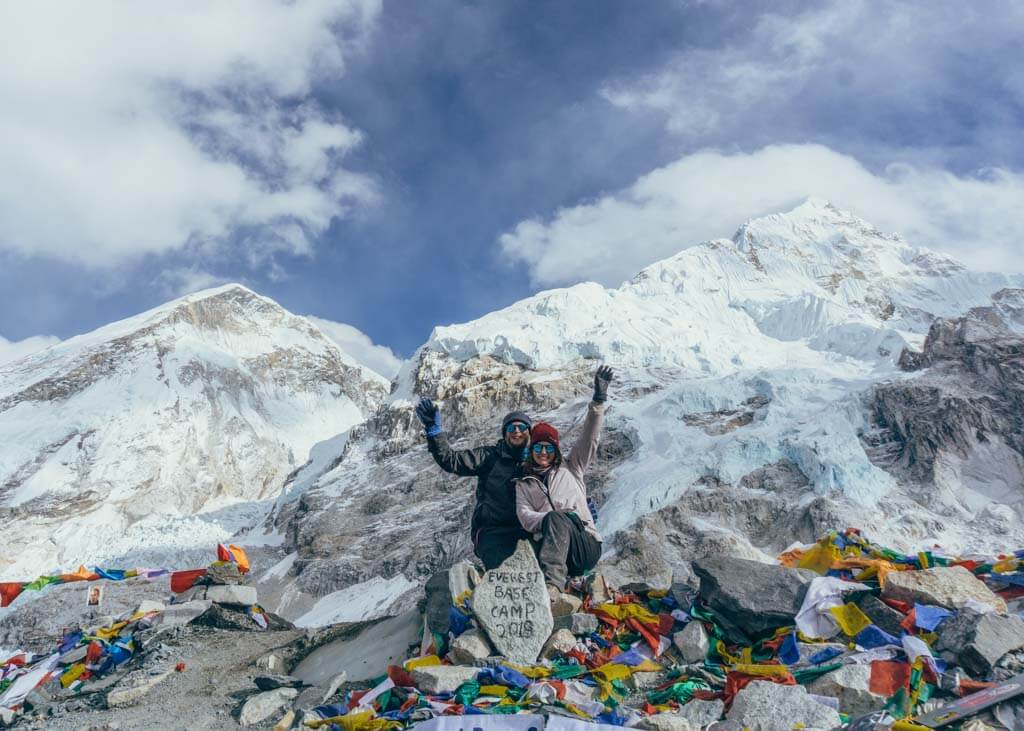
Quick Navigation
When to plan your Everest Base Camp Trek itinerary
April to May (Spring) and October to November (Autumn) are the most popular hiking months in Nepal offering perfect conditions for your Everest Base Camp trek.
But these months also attract scores of travelers looking to take on the Himalaya mountain ranges and so the trail does get busy.

Everest Base Camp Trek Route
If you follow my Everest Base Camp trek itinerary, you’ll need 12 days to start and return to Lukla. You will reach Everest Base Camp on day 9 which is enough time for your body to adjust to the higher altitude.
Day 1: Kathmandu to Lukla to Phakding
Day 2: phakding to namche bazaar, day 3: namche bazaar (acclimatization day), day 4: namche bazaar to khumjung, day 5: khumjung to phortse, day 6: phortse to dingboche, day 7: dingboche (acclimatization day), day 8: dingboche to lobuche, day 9: lobuche to gorak shep to everest base camp to gorak shep, day 10: gorak shep to kala patthar to pheriche, day 11: pheriche to namche bazaar, day 12: namche bazaar to lukla.
I did not take altitude sickness medication such as Diamox but I walked slowly, extremely slowly – probably the slowest anyone’s ever walked to EBC. This Everest Base Camp trek itinerary offers the best acclimatizing schedule to allow your body to naturally adjust to a higher altitude.
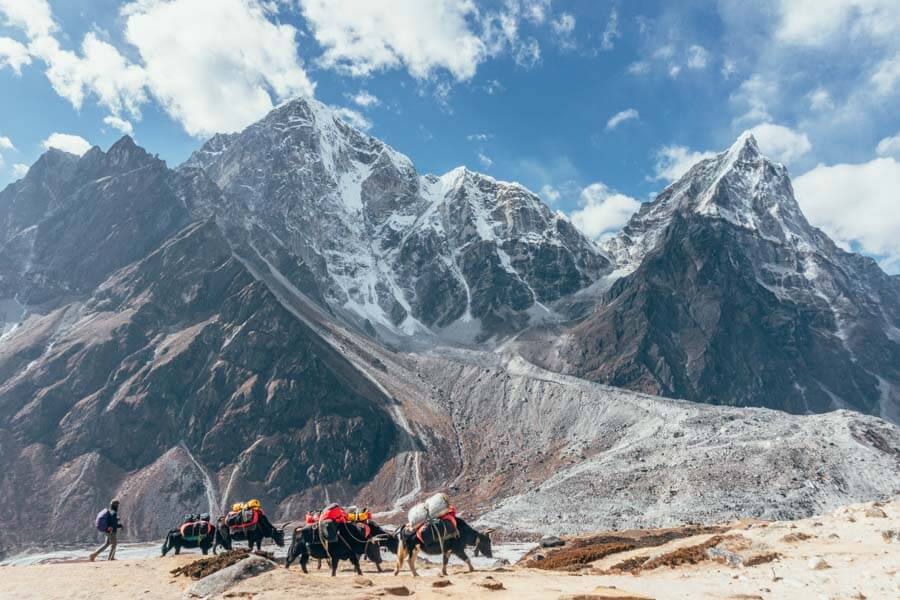
The start of your Everest Base Camp itinerary: Kathmandu
Your first few days in Nepal will be in the capital city, Kathmandu. Sitting at 1 400m above sea level, it’s recommended to spend at least 2 days here.
This allows your body to get used to the higher elevation, especially if you’re coming from sea level.
Kathmandu is a dynamic city with a rich culture and tradition, and you can easily spend a few extra days exploring if you have the time. Most tour operators include a day excursion to the nearby sights and temples within the city.
Make sure you stay in Thamel. It’s the hiking hub of Kathmandu with lots of eager trekkers choosing to base themselves here.
You can buy all your Everest Base Camp hiking gear in Thamel so don’t worry if you’ve forgotten something behind. Or if, like me , you arrived in Nepal with no hiking gear – only a pair of hiking boots! Thamel has got you covered.
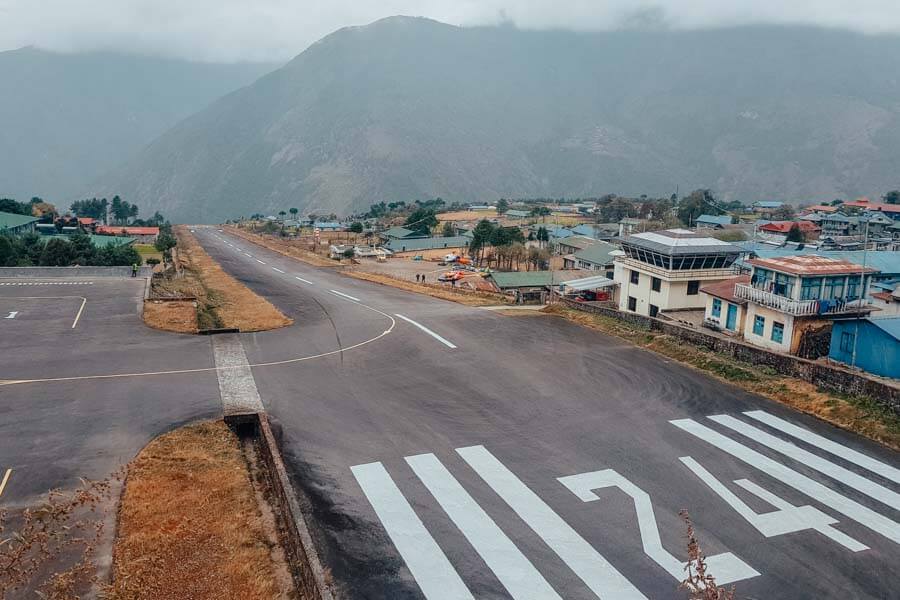
Altitude: Kathmandu (1 400m) – Lukla (2 860m) – Phakding (2 610m).
Trekking time: 3-4 hours | 7,4 km.
Difficulty: Easy with only a few uphill sections.
Highlight: Flight into Lukla.
Overview: The first day of your Everest Base Camp trek itinerary will start bright and early with a flight out of Kathmandu to the infamous Tenzing Hillary Airport in Lukla. From there, you’ll hit the ground running and hike just over 3 hours to Phakding, your stop for the night.
Tea house: Royal Sherpa Resort.
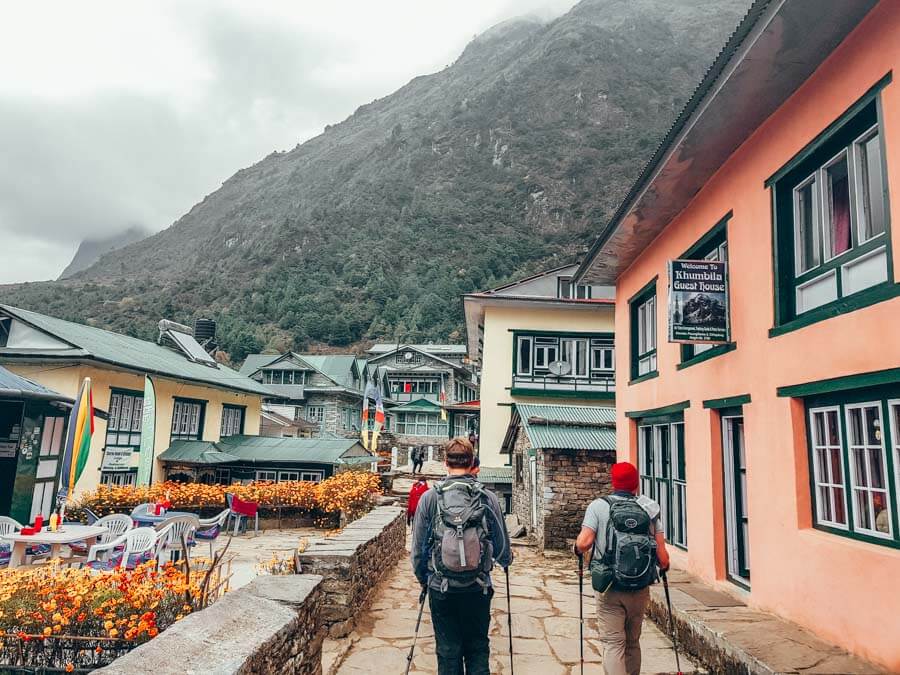
The day has finally arrived – The first day of your Everest Base Camp itinerary!
The flight from Kathmandu to Lukla is only 36 minutes but it relies heavily on the weather. Even if there’s slight cloud cover, the flights are delayed or worse, canceled. Lukla Airport is one of the most dangerous airports in the world after all.
My flight with Summit Air was due to leave at 9 am, but we only left after 3 pm due to the weather conditions. The planes are tiny, and you’re allowed no more than 15kg of luggage – in total!
The flight itself was thrilling but not as frightening as I anticipated. Although I did freak out every few minutes when there was a slight bump.
Lukla to Phakding
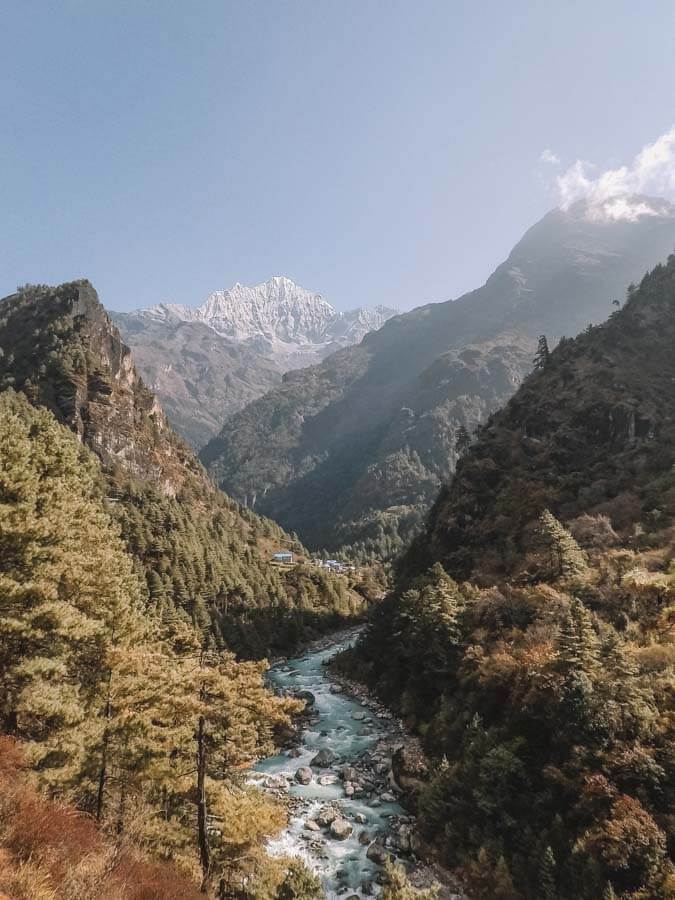
Once you’ve arrived in Lukla, grab a quick bite to eat before starting the afternoon trek to Phakding.
This section from Lukla to Phakding is an easy one and it’s the perfect introduction to the Himilaya mountain range. It’s an incredibly scenic trail that hugs the mountain and runs alongside a stream.
You’ll pass through several villages and will set your sights on the first yaks and mules of your Everest Base Camp trek.
Before you know it, you’ll have reached Phakding where you’ll spend the night in your first tea house. Don’t get too used to these comfortable conditions though. The further up you go from Lukla to Everest Base Camp, the more basic the amenities become!
Tip: There are ATM’s in Lukla (and Namche) but draw cash in Kathmandu as a back-up.
Tip: There’s cell reception (NCell) in Phakding and most tea houses offer free power to charge up your phone or camera here.
Tip: Try to eat well during the first few days as you’ll start losing your appetite from day 3 of your Everest Base Camp itinerary. Remember: “Dal Bhat Power – 24 Hour”

Altitude: Phakding (2 610m) – Namche Bazaar (3 440m).
Trekking time: 7-9 hours | 10,4 km.
Difficulty: Easy for the first section, steep and difficult for the second half.
Highlight: The views from the suspension bridges.
Overview: Day 2 is when the real hiking starts! You’ll begin with a slow hike before climbing a steep section leading to Namche Bazaar, one of the most iconic stops on your Everest Base Camp trek itinerary.
Tea house: AD Friendship Lodge.
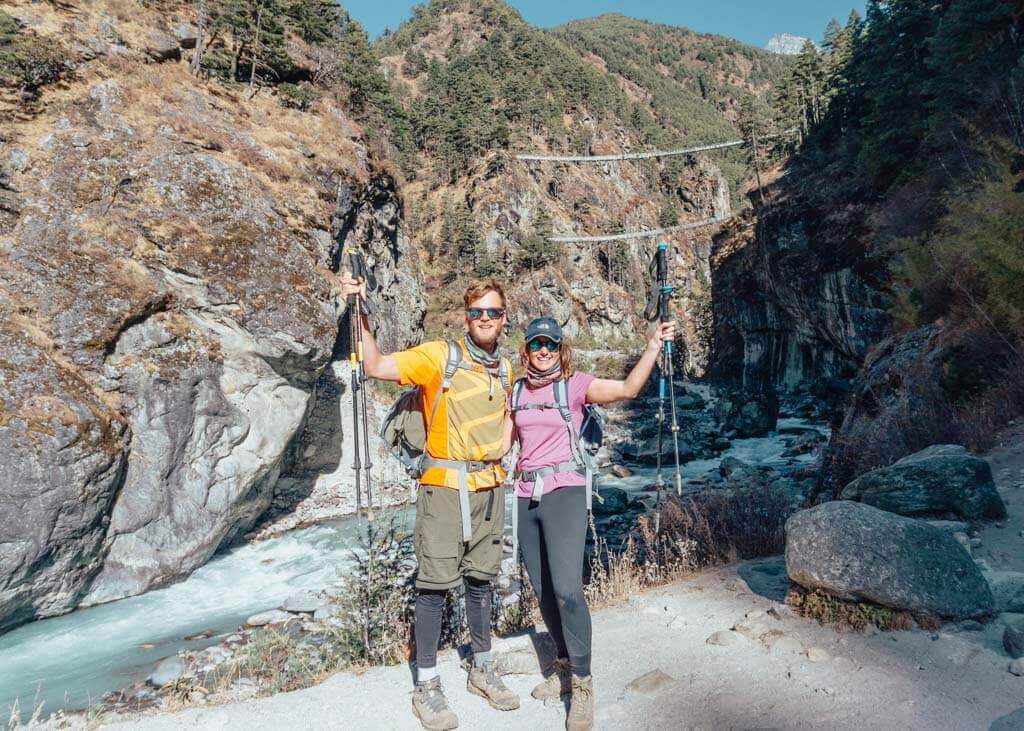
Day 2 is one of the most picturesque days of your Everest Base Camp trek itinerary. But you have a long day of hiking ahead of you so try to leave Phakding by 08:00 am.
The first part is an easy trek alongside pine forests and the excitement will begin to set in as you pass fellow trekkers making their way back down from Everest Base Camp to Lukla.
The glacial rivers are an impressive sight and you’ll cross several suspension bridges throughout the course of the day. These offer gorgeous views but they’re also terrifyingly high! Take in these beautiful surroundings as the landscape changes dramatically over the week.
After lunch, there is a sharp gain in elevation and the easy path suddenly becomes steeper. Take it slow to allow your body to adjust to this higher altitude.
En route to Namche Bazaar, you’ll also get your first glimpse of Mount Everest (If the weather conditions are on your side). You’ll also need to sign in at a checkpoint.
Namche Bazaar
Namche Bazaar is a picturesque village with a lively atmosphere. It’s the main trading center of the Khumbu region and a sherpa village. From Namche Bazaar it starts to get chilly but luckily there are plenty of tea houses with fireplaces to warm you up.
Tip: After you’ve arrived in Namche, pop into Hermann Helmers for their chocolate carrot cake. It’s life-changing!
Tip: Take a warm shower in Namche ($5) as it’s the cheapest you’ll find for the next 10 days!
Tip: Avoid eating meat after Namche Bazaar. Just think of it being carried up the mountain, during the heat of the day with no refrigeration. Don’t do it!
Day 3 of your EBC trek itinerary is your acclimatization day, a supposedly “rest day” to allow your body to slowly adjust to the high altitude. But that doesn’t mean you’ll get to sit inside and relax all day. Today, you’ll do an acclimatization hike to Everest View Hotel.
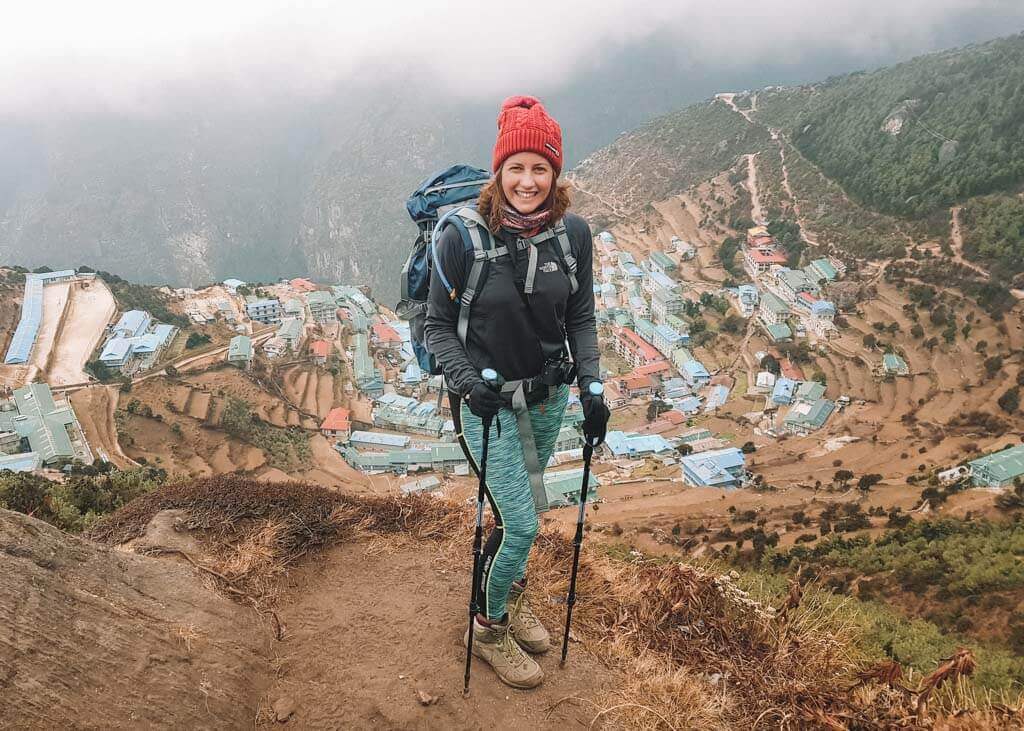
Altitude: Namche Bazaar (3 440m) – Everest View Hotel (3 880m) – Namche Bazaar (3 440m).
Trekking Time: 3 hours | 2.5 km.
Difficulty: The path itself isn’t too difficult, but with the elevation gain, you’ll begin losing your breath quickly.
Highlight: Watching Everest documentaries at Liquid Bar in Namche Bazaar (3 pm or 7:30 pm).
Overview: A short hiking day to Everest View Hotel and back, followed by free time to explore Namche Bazaar.
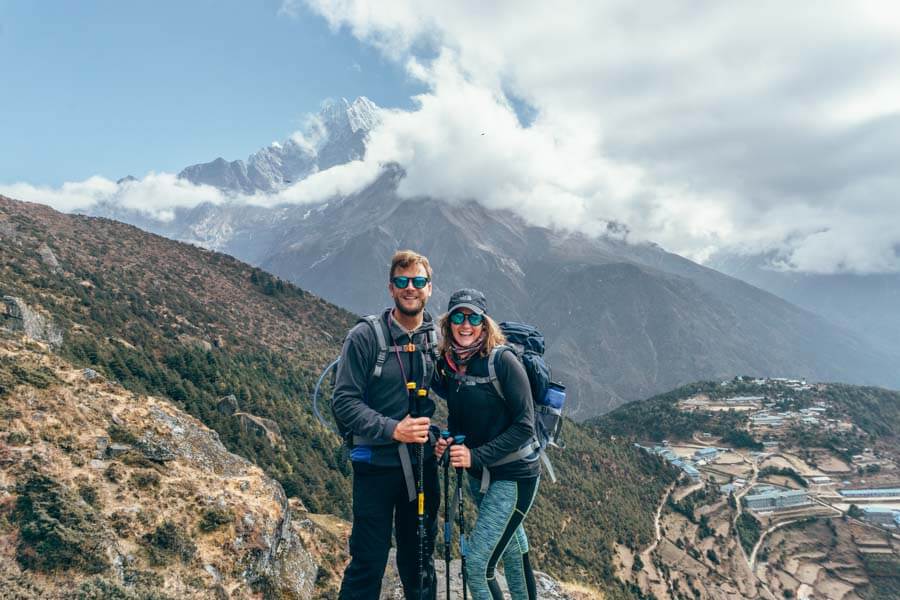
Even if you’re not feeling up to it, it’s important to get out and hike to a higher point, before coming back down to sleep at a lower altitude.
Today is also your second chance to get a glimpse of Mount Everest if you didn’t the day before. The trek is a tough one, and if you have not yet felt any symptoms of the higher altitude, you’ll soon begin to experience them.
Tip: There are many pubs and bars which show Everest documentaries. Make sure you watch one during your time in Namche Bazaar (But don’t drink alcohol on your way up – save that for when you return).
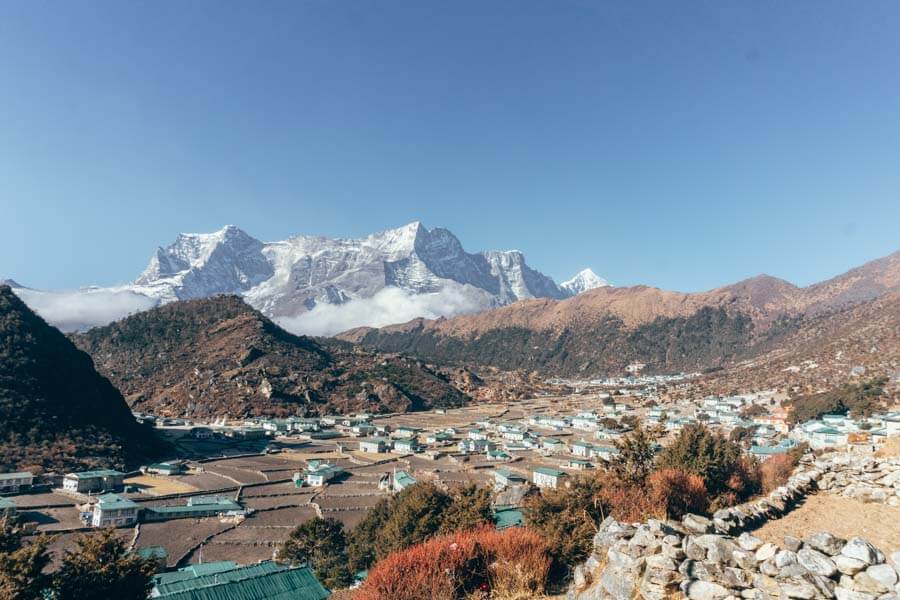
Route: Namche Bazaar (3 440m) – Khumjung (3 780m).
Trekking time: 4 hours | 4 km.
Difficulty: Moderately easy as it’s a short trekking day but from today the cold sets in.
Highlights: Playing card games in front of the fire, wrapped up in my sleeping bag because it was so cold.
Overview: You’ll go off the standard trekking route from Namche to Khumjung.
Tea House: Hill Top Lodge.
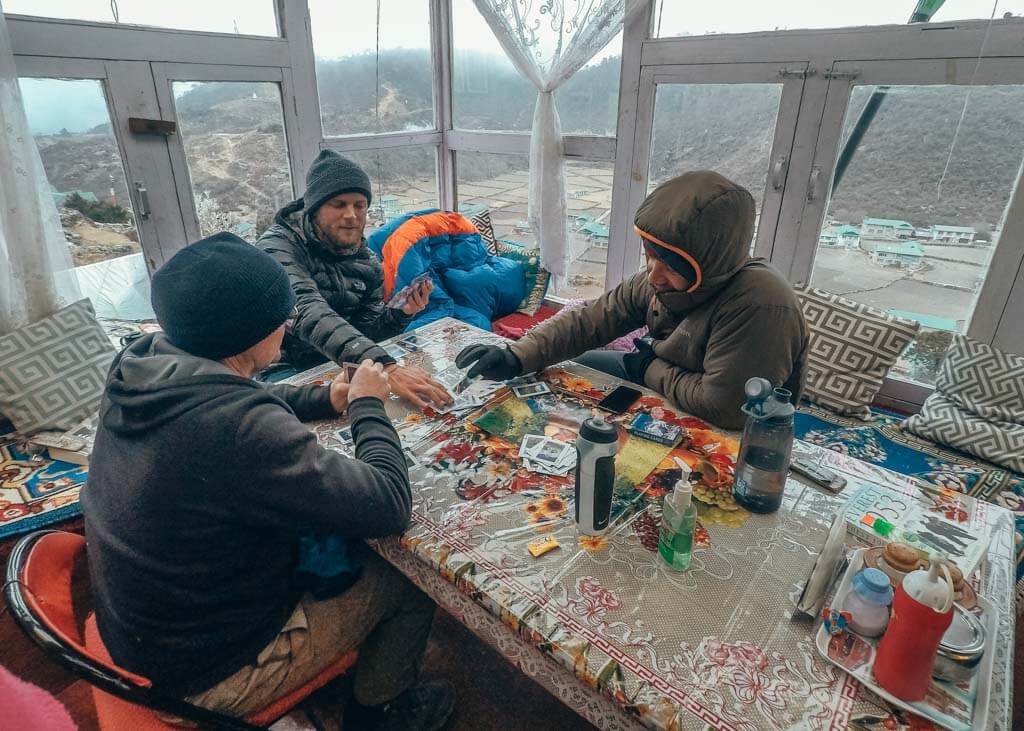
This is where most Everest Base Camp trek itineraries differ. From Namche Bazaar, there are two routes you can take both of which link up again in Dingboche on day 6 of your trek.
The first option (and most popular) is from Namche to Tengboche, before reaching Dingboche .
The second option (and my chosen route) is from Namche to Khumjung and Phortse which are on the other side of the river.
I chose the Khumjung route as it’s the less popular option. As a result, the hike isn’t as crowded, yet it offers the same sweeping views of the valleys below. But don’t worry, you’ll still get to experience the Tengboche route on your way back down from Everest Base Camp to Lukla.
Today was the first day that I layered up as it did get quite cold. You’ll pass a small local hospital as well as the famous Sir Edmund Hilary School before arriving in the small village of Khumjung.
When you get to Khumjung you’ll notice the change in the landscape. It’s far more arid and drier, with very few green luscious trees.
Tip: Ensure you have a pack of playing cards and a book with you. They’ll come in handy on short trekking days like today.
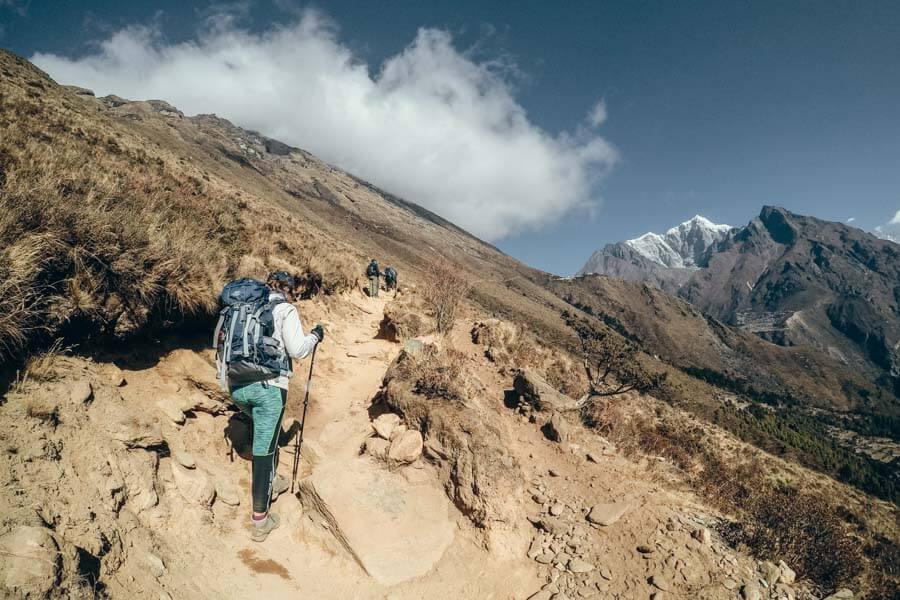
Route: Khumjung (3 780m) – Phortse (3 900m).
Trekking time: 6 hours | 7 km.
Difficulty: Although there isn’t much altitude gain today, there are still many sections where you walk downhill, before climbing back uphill so this constant up/down is strenuous.
Highlights: Today was the first day I began to feel the effects of the high altitude and I lost my appetite.
Overview: The trail from Khumjung to Phortse is incredibly scenic and you’ll walk alongside all the Himalaya giants.
Tea house: Phortse Resort.
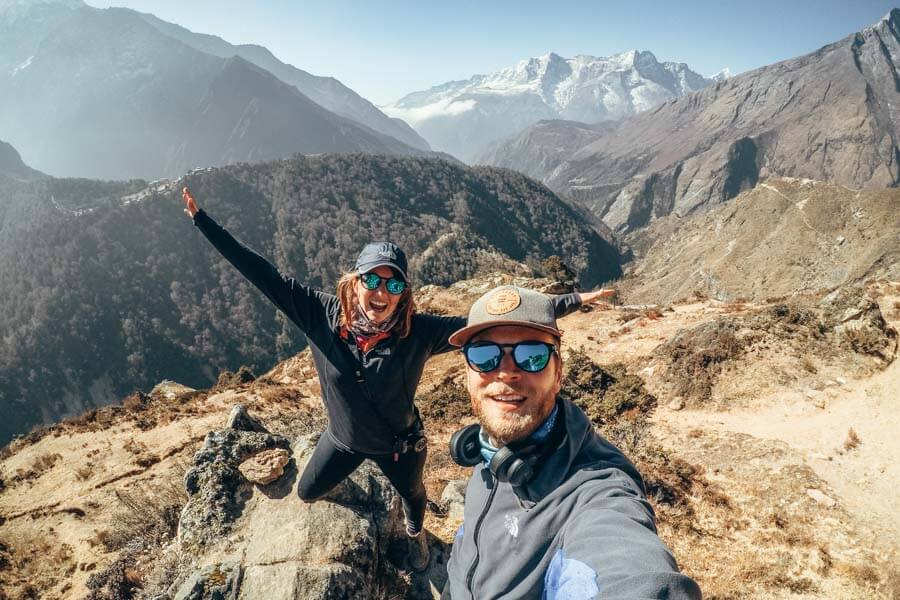
Day 5 of your Everest Base Camp trek itinerary will start with a 2-hour climb to Mongla (3 975m). You’ll then go back down to 3 800m which is the elevation of your next stop, Phortse.
You’re still on the “quieter” route so enjoy this path as it gets busier from tomorrow when you head to Dingboche.
Today is the day I started to feel the effects of altitude sickness and by the time I reached our lunch stop, I had lost my appetite and a terrible headache was setting in. I wrote this detailed guide to how hard Everest Base Camp is and it includes these moments where i felt horrible!
There is also a considerable drop in temperature – It was 4 degrees celsius when we started walking today. The pipes in Phortse were frozen and the guides start to give you hot water in the evening which will be your drinking water from here on out.
Tip: When you’re given hot water in your drinking bottles, put one inside your sleeping bag to act as a hot water bottle.
Tip: I took a headache tablet at lunchtime and after a good night’s rest, I was feeling much better. If you’re not feeling well, don’t be afraid to take a pain killer but make sure you communicate with your guide so that he knows to keep an eye on you.
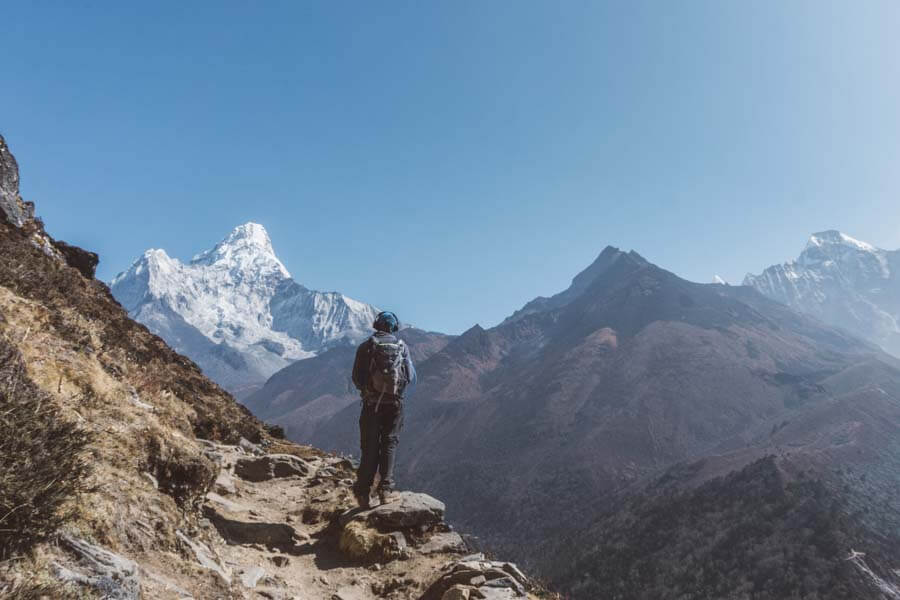
Altitude: Phortse (3 800m) – Dingboche (4 360m).
Trekking time: 8 hours | 9 km.
Difficulty: Today is a long, tiring day and breathing is difficult. The first few hours are tough, followed by an easier trek as you get closer to Dingboche.
Highlights: Arriving in Dingboche – today was a hectic day and I was so happy when it was over!
Overview: You’ll trek the entire day with a constant gradual incline until you arrive in Dingboche, where our EBC itinerary will meet up with the others who are coming from Tengboche.
Tea house: Sonam Friendship Lodge.
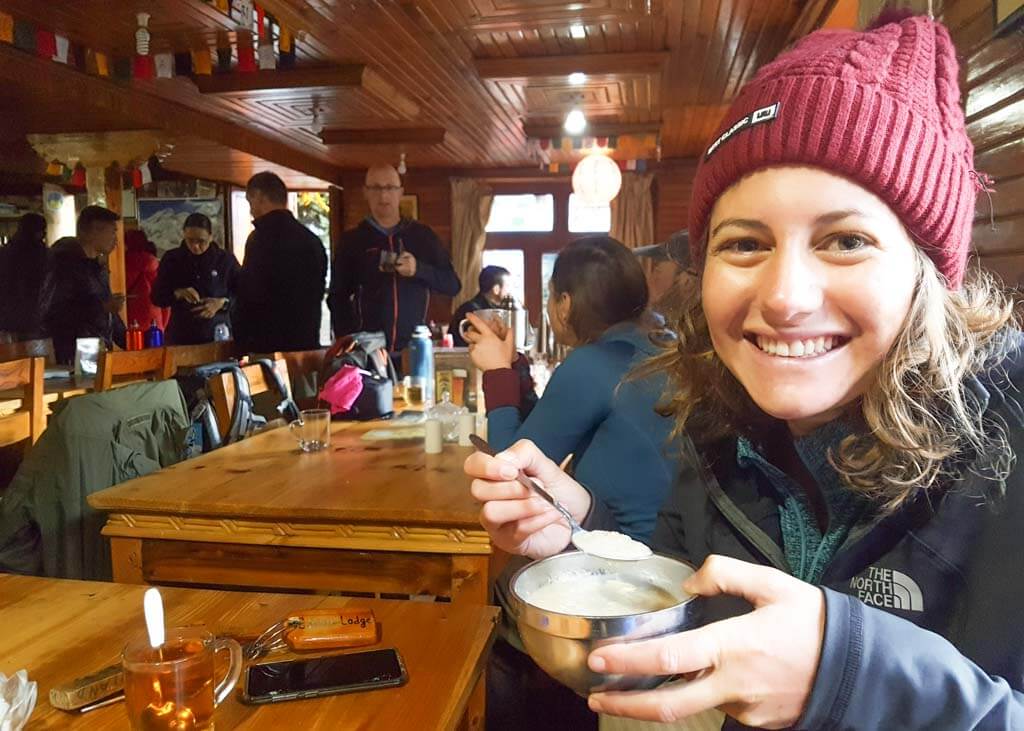
Today is a long trekking day!
When I woke up on day 6, I was feeling fit and strong (unlike the afternoon before) . I was extremely aware of how sick I had felt yesterday and despite feeling better, I took precautionary measures and walked extra slow with many breaks.
The first 5 hours involve constant uphill climbs, followed by downhill treks, before going uphill again! You’ll eventually pass the tree line, and the entire landscape becomes bare and rocky and resembles a desert.
Today you’ll be surrounded by all the Himilayan giants: Ama Dablam, Nuptse, and Cholatse, with unspoiled views of Mount Everest.
Throughout the day you’ll hear the sounds of helicopters making emergency rescues as trekkers begin struggling with the higher altitude and need to be taken back down to Namche Bazaar from Everest Base Camp. It’s quite scary to see how frequently people require this emergency assistance!
Luckily, the final stretch to Dingboche after lunch isn’t as tough as the section before.
Tip: There’s no cell reception as you get closer to Dingboche so enjoy the next few days going off the grid.
Tip: On day 6 of our Everest Base Camp itinerary, a few trekkers started taking altitude sickness medication as a precautionary measure. I didn’t take Diamox but my guide had in case I needed it. As always, be cautious of the altitude.
Tip: You’ll lose your appetite, but order boiled potatoes to get some food into your stomach.
Today is the last of your acclimatization days so you’ll spend a second night in Dingboche. Again, it’s important to do an acclimatization hike from Dingboche .
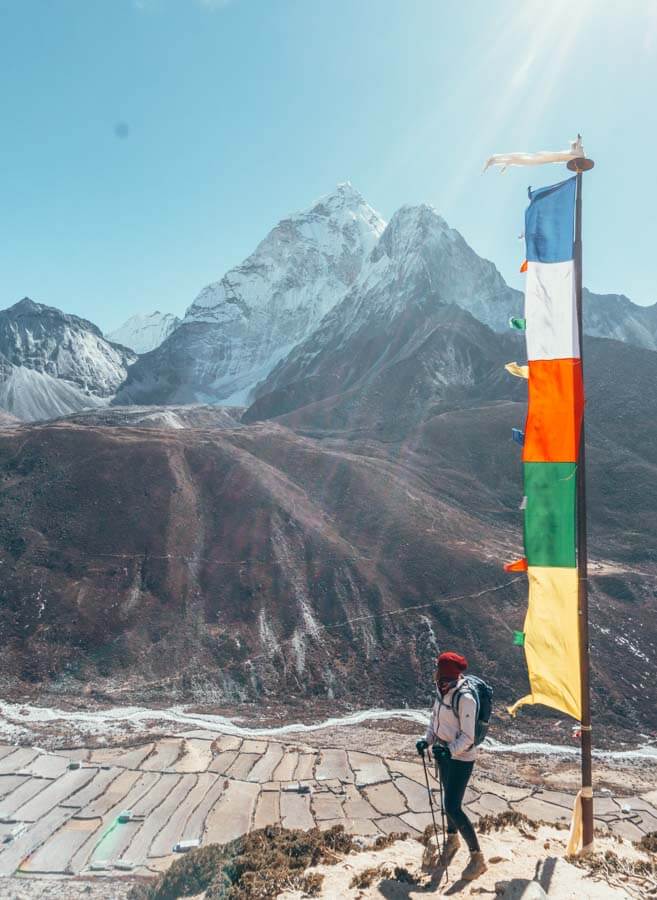
Altitude: Dingboche (4 360m) – viewpoint (4 900m) – Dingboche (4 360m).
Hike time: 3 – 5 hours | 3 km.
Difficulty: Short, but steep climb so take it slow and steady.
Overview: Today is a short acclimatization hike to a viewpoint and back.
Highlight: Views of the Chukhung Valley and Island Peak.
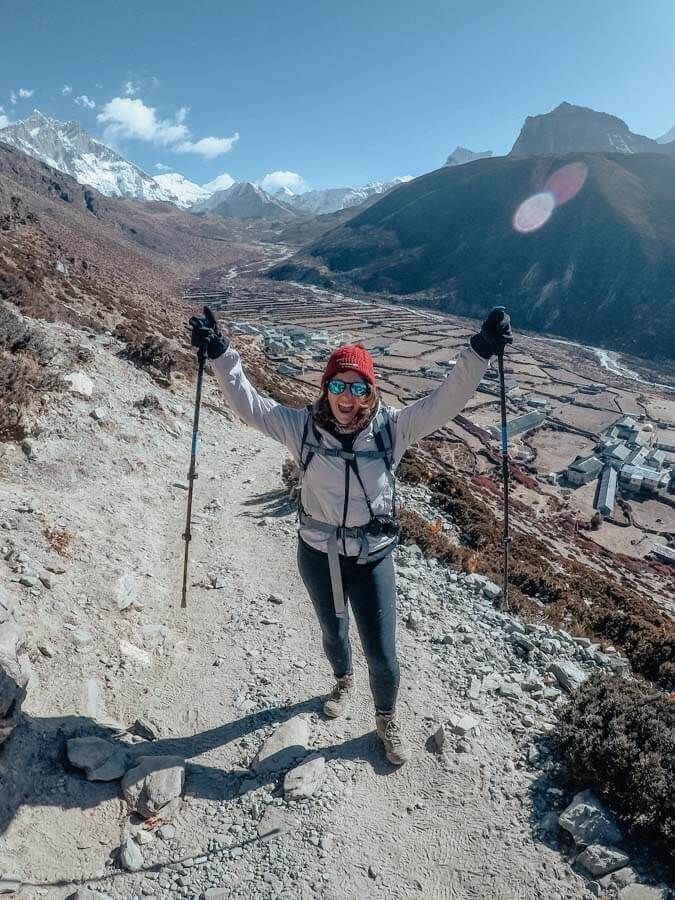
I woke up on day 7 of my EBC trek and I was feeling terrible. The Khumbu cough had really set in, I was freezing cold, my nose was constantly running and I was beginning to lose my voice.
When you reach Dingboche, the luxuries of warm water, comfortable beds, and flushing toilets are long gone, and this is when the mental challenge begins. But listen to your body and be honest with your guides about how you’re feeling.
During my time in Dingboche, a porter from a different tour group (who had hiked to EBC many times before) had gotten sick and had to be airlifted back to Lukla. This was a harsh reality of the effects of high altitude climbing and how it can happen to anyone, no matter your experience, fitness level, or age.
Dingboche Acclimatization Hike
Today you’ll go on an acclimatization hike to a viewpoint overlooking the Chukhung Valley. Going to this higher altitude, and then returning to Dingboche will make you feel so much better (as it did for me). So, gear up, pack your day bag, and head outside for a few hours.
The acclimatization hike from Dingboche to the viewpoint is pretty steep and rocky, but you’ll be hiking at a much slower pace than the previous days. All around you, you’re surrounded by towering mountains and peaks, and it’s a sight you won’t easily forget!
Once at the viewpoint, you’ll have the best views of Ama Dablam and Island Peak, as well as the symbolic prayer flags.
I added Island Peak to my Everest Base Camp itinerary (and I HIGHLY recommend you do the same). It’s 4 extra days of trekking after you’ve reached Everest Base Camp, and it was one of the best and most thrilling experiences of my life!
Tip: After returning from your acclimatization hike pop into Cafe Himalaya Bakery to watch their daily Everest movie.
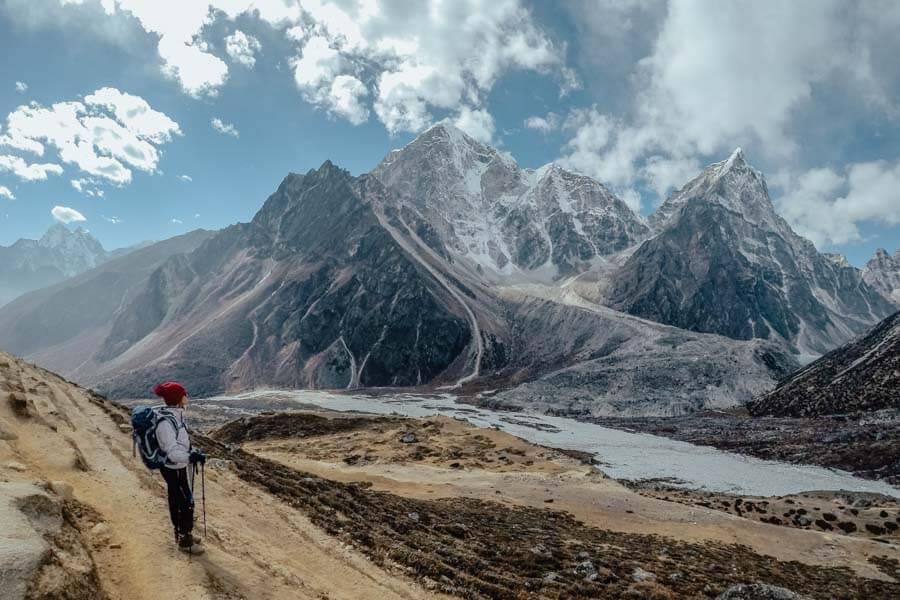
Altitude: Dingboche (4 360m) – Lobuche (4 930m).
Trekking time: 7 hours | 10.7km.
Difficulty: Hard! The section from the bottom of the icefall to the Everest memorial is brutal. It’s steep, and it’s far.
Highlight: The climb to the Everest memorial. It’s painfully steep and I struggled!
Overview: As you leave Dingboche, the first part of your trek is relatively easy. Until you reach Dukla! This is where the trail becomes steep. From there it’s an excruciating 2-hour climb before the path becomes flat again. You’ll walk alongside the Khumbu Glacier, the longest glacier in Nepal.
Tea house: Sherpa Lodge.
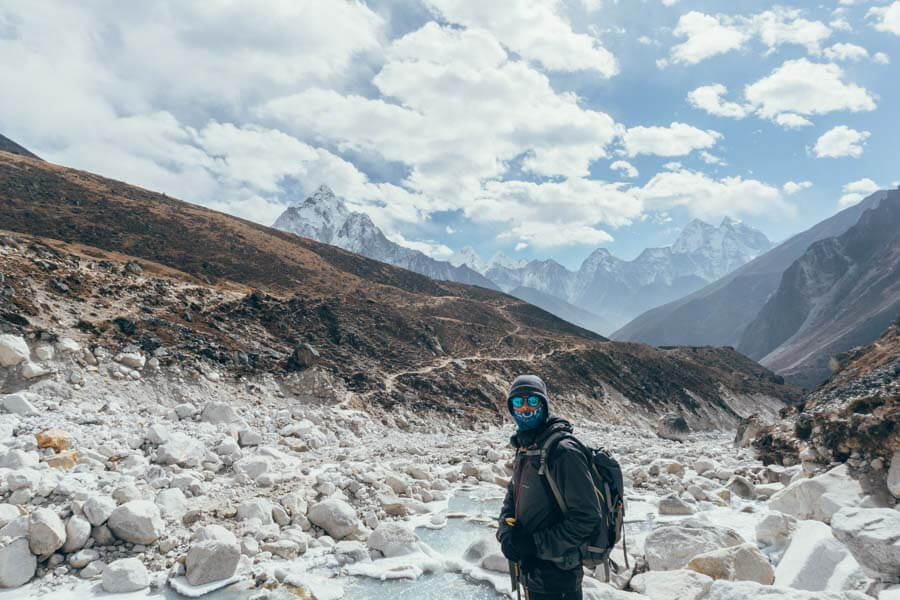
I kept a day-to-day journal of my Everest Base Camp trek itinerary, and in it, day 8 is highlighted (in capital letters with several exclamation marks) “ The hardest day EVER! ”
And thinking back to this day, it really was!
The first 3 hours include a gradual incline before crossing to Dukla which will be your lunch stop for the day. Enjoy the break, because you are going to be hating life for the next 2 hours – it’s a killer of a climb. Breathing at an altitude of over 4 500m doesn’t make it any easier!
You’ll pass many trekkers who are making their way back from Everest Base Camp. I was shocked to see the condition most of them were in. Many people were even getting carried down by mules! They looked like they had really taken strain – coughing, no voice, chapped lips, and no energy.
I was hoping and praying that wouldn’t be me in a few days (but unfortunately, it was – except I didn’t need to be carried down!)
Everest Memorial
At the top, you’ll reach the Everest Memorial for climbers who’ve lost their lives in their attempt to reach the summit of Mount Everest. There is a somber mood, and I get goosebumps thinking about all those climbers and their families.
From the memorial, it’s about a 1-hour trek alongside the Khumbu Glacier to Lobuche. This last section is far easier than the previous one. Again, take it slowly!
Tip: At this stage, everyone is feeling the effects of the altitude and the cold. You’re not alone! Just keep pushing through, it’s nearly over! (says me who wanted to turn back countless times) .
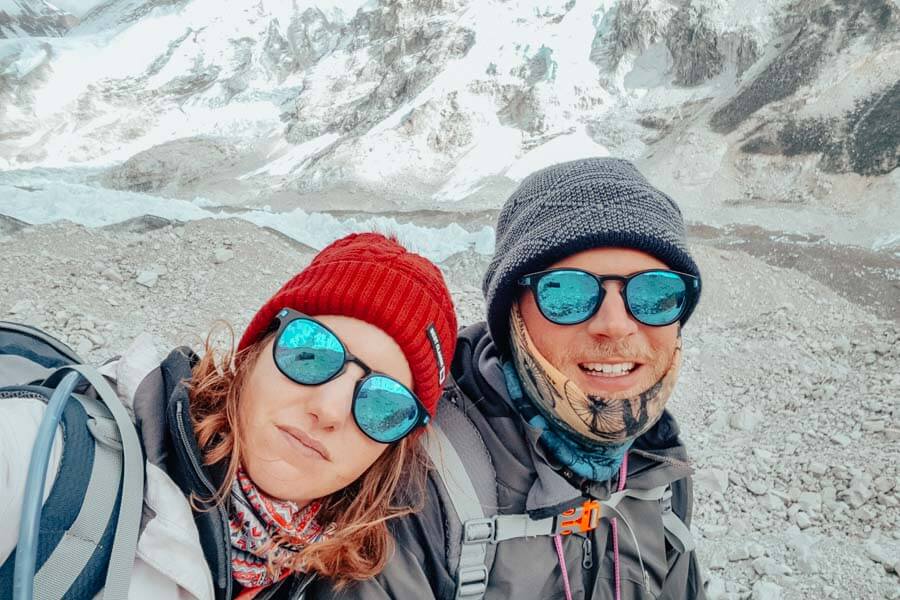
Altitude: Lobuche (4 930m) – Gorak Shep (5 160m) – Everest Base Camp (5 360m) – Gorak Shep (5 160m)
Time: 10 hours | 12 km.
Difficulty: Moderate with a steep climb towards Gorak Shep and an easy trail to Everest Base Camp. The difficulty lies in hiking time and the high altitude.
Overview: Today is the day you reach Everest Base Camp! You’ll arrive in Gorak Shep, drop off your bags and have lunch before departing north along the Khumbu Glacier to Everest Base Camp.
Highlight: It should be reaching Everest Base Camp, right?
Tea house: Buddha Lodge
Whilst the previous day’s hike from Dingboche to Lobuche was certainly the toughest and most physical section, getting to Gorak Shep, and then on to EBC and Kala Pattar were the most emotionally and mentally challenging sections of my entire Everest Base Camp trek itinerary.
Your day will start with a moderate hike leading to Gorak Shep from Lobuche. After about an hour into your hike, the path becomes steep with numerous boulders to pass. Whilst it isn’t a strenuous climb, the altitude will affect you and you’ll be walking very slowly.
Gorak Shep and Everest Base Camp
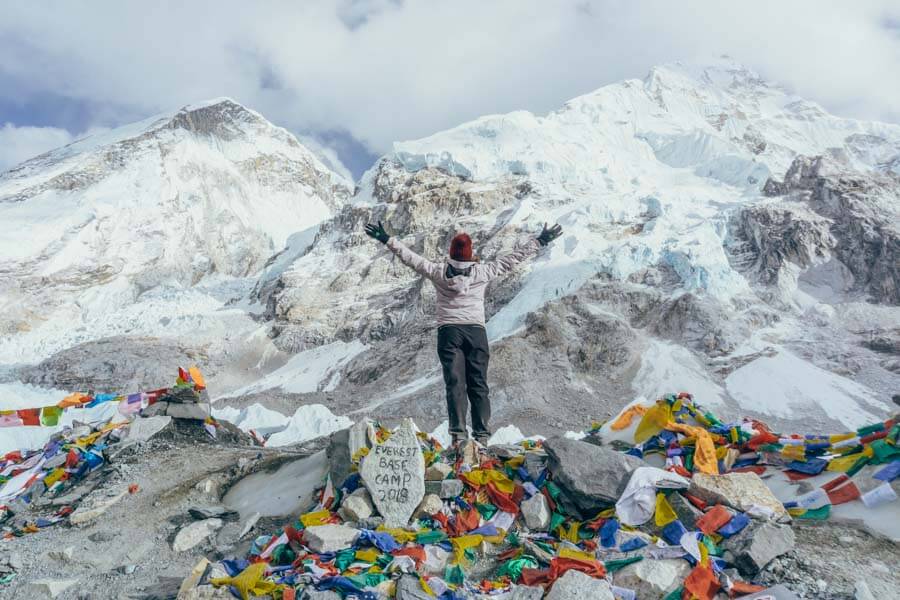
You’ll reach Gorak Shep at lunchtime where you’ll drop off your bags and prepare for the afternoon hike to EBC.
You don’t actually stay at Everest Base Camp. Gorak Shep is your base with the closest tea house to EBC.
After lunch, you’ll trek to Everest Base Camp. The path is made of rocky sections and loose stones. You’ll be exhausted at this point. But the adrenalin rush will keep you going. The excitement to finally reach Everest Base Camp will get you to the end.
Arriving at base camp is surreal. You can see the Khumbu Icefall in the distance, one of the most notorious sections leading up to the Everest summit.
It’s an eerie feeling reaching Everest Base Camp but absolutely gorgeous standing at the foot of the highest mountain in the world.
You’ll then make your way back to Gorak Shep which is where you’ll spend the night.
The reality
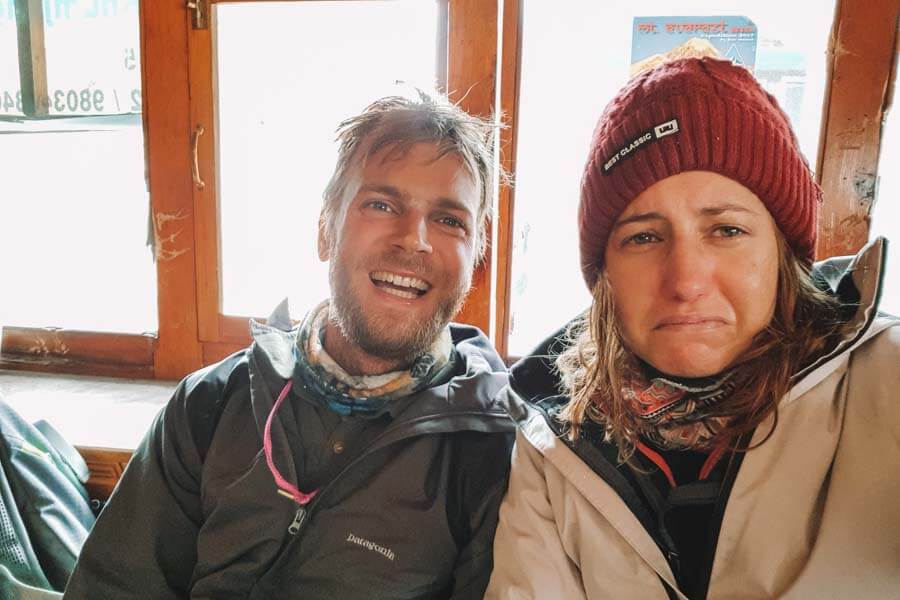
The most vivid memory I have of my entire Everest Base Camp trek is sitting in the tea house in Gorak Shep after returning from Base Camp.
The communal area of more than 60 people was quiet. You could only hear the sounds of loud coughing. There were no celebrations by those who had made it to Everest Base Camp and the atmosphere was not jovial.
Everyone was feeling sick and looking worse for wear. People were being helivaced from Gorak Shep to Lukla, others were on oxygen. You could see trekkers struggling to take a bite of their food.
I was so emotional because I was just so incredibly exhausted. You could sense that everyone was at their breaking point and had been pushed to their limits. Including me.
Tip: Don’t rush! Remember that you’re breathing in air with 50% oxygen. Many trekkers get excited as they’re so close to Everest Base Camp, but you still need to be careful. From what I saw, several people got sick and had to be put on oxygen AFTER they’d successfully reached EBC, perhaps this is because they’d taken it too fast.
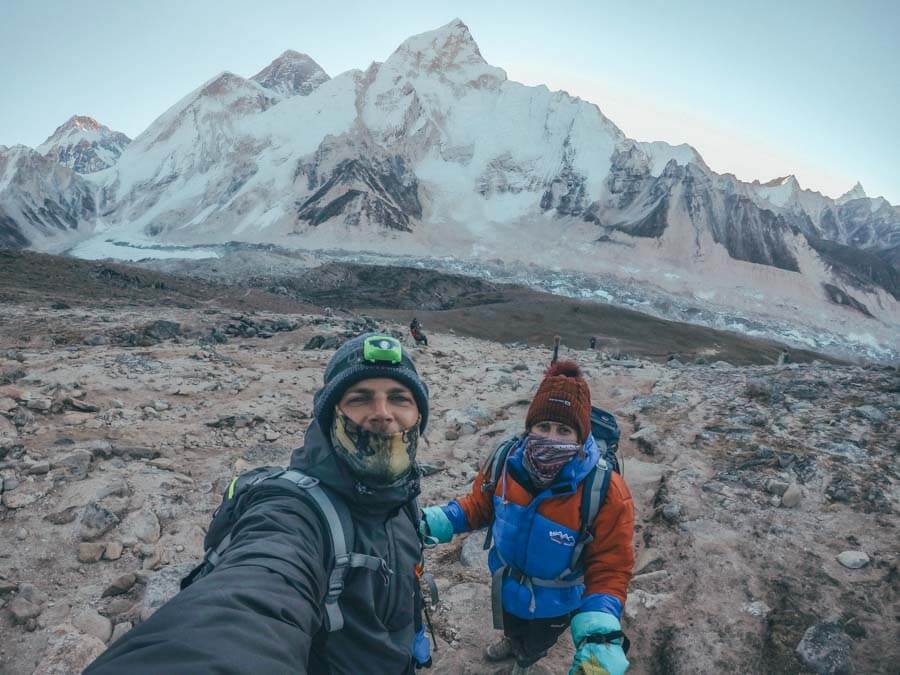
Altitude: Gorak Shep (5 160m) – Kala Patar (5 643m) – Pheriche (4 370m).
Trekking time: 7 hours | 13 km.
Difficulty: This day is difficult, only because of Kala Patthar! The rest is easy as you’ll be going down the mountain to a lower altitude.
Highlight: Everything about the trek up to Kala Patthar. The 5 am wake-up call, the ice-cold temperatures, the steep trail, the incredible view!
Overview: The day starts with an early morning trek to Kala Patthar for the best views of Mount Everest. After returning to Gorak Shep, you’ll head back down to Pheriche.
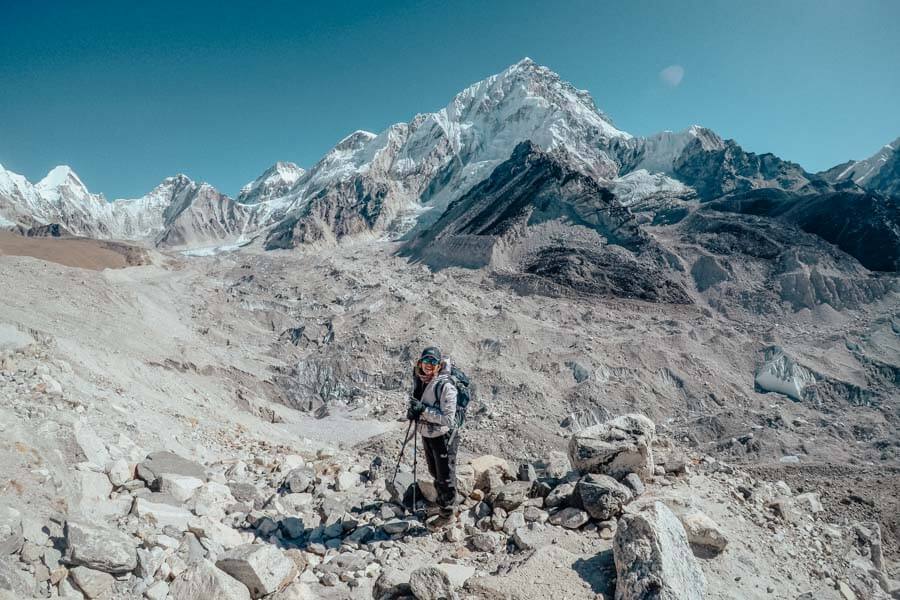
You can’t actually see Mount Everest from Everest Base Camp or Gorak Shep as Lhotse sits in front of it and blocks the view.
This is why people trek to Kala Patthar, which is a nearby viewpoint next to Gorak Shep.
Be prepared for a long and tiring day! Just when you thought it couldn’t get any tougher, day 10 of your Everest Base Camp trek will really push you to your limits.
Sitting at 5 643m, Kala Patthar is a small, rocky peak with a rewarding view of Mount Everest, Changtse, Lhotse, and Nuptse.
Your morning starts with a 5 am wake-up call as you prepare to hike to Kala Patthar. Some trekkers choose to skip this part of the itinerary because they’re too sick and just do not have the energy to make it to the top.
The main goal is Everest Base Camp, right? You’ve made it!
You don’t have to climb Kala Patthar. Listen to your body and if you’re not feeling well, don’t do it! I was incredibly slow, fatigued, and sluggish and only got about ¾ of the way to the top before our guide advised that we turn back.
If we didn’t, we’d fall behind on the day’s schedule.
After climbing Kalla Patthar, we arrived back at our tea house at Gorak Shep at about 9 am, had a quick breakfast then began our long trek past Lobuche and on to Pheriche.
My day hadn’t got off to a good start and I was feeling very weak hiking Kala Patthar, but as soon as we began our downhill climb, I regained my strength and felt like a different person!
Tip: If you’re feeling sick at Gorak Shep, make sure you monitor this but the moment you go to a lower altitude, you will feel stronger.
Tip: If you’re continuing to Island Peak, you can check out my Island Peak guide. To sum it up, from Gorak Shep, you’ll go to Dingboche ( and not Pheriche as this route goes) . After spending the night in Dingboche, you’ll go in a different direction to Chukhung and Island Peak Base Camp.
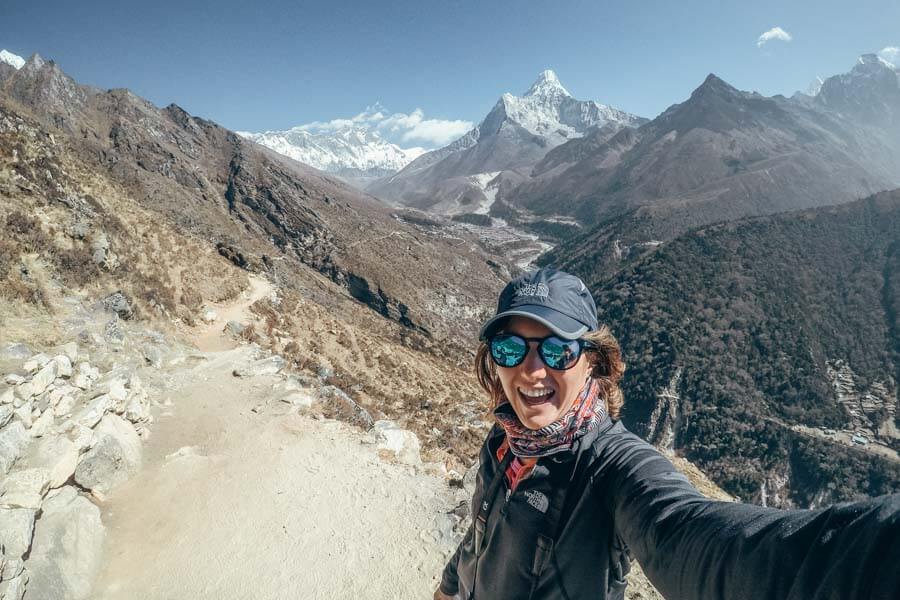
Altitude: Pheriche (4 280m) to Namche Bazaar (3 440m).
Trekking time: 14km | 8 hours.
Difficulty: Easy but a long day of hiking.
This day (and the next) are particularly long and you’ll want to get off the mountain ASAP!
You’ll be running down from Pheriche to Namche Bazaar as it’s so much easier to breathe as the elevation decreases. You’ll also be craving a hot shower, clean clothes, a proper meal, and a warm bed.
Soon, you’ll hit the tree line once again, cross over suspension bridges, and pass scores of mules.
After every corner, you’ll think you’ve reached Namche Bazaar, but it’s further than you expect, and the trail seems to go on forever. On your way down you still have sections where you climb up and down (yes, more climbing), but there’s no altitude gain so who’s complaining!
You’ll pass Tengboche, which is home to the largest monastery in the Khumbu region and the village where most trekkers stop on their way up the mountain (But we chose a different route on this Everest Base Camp trek itinerary).
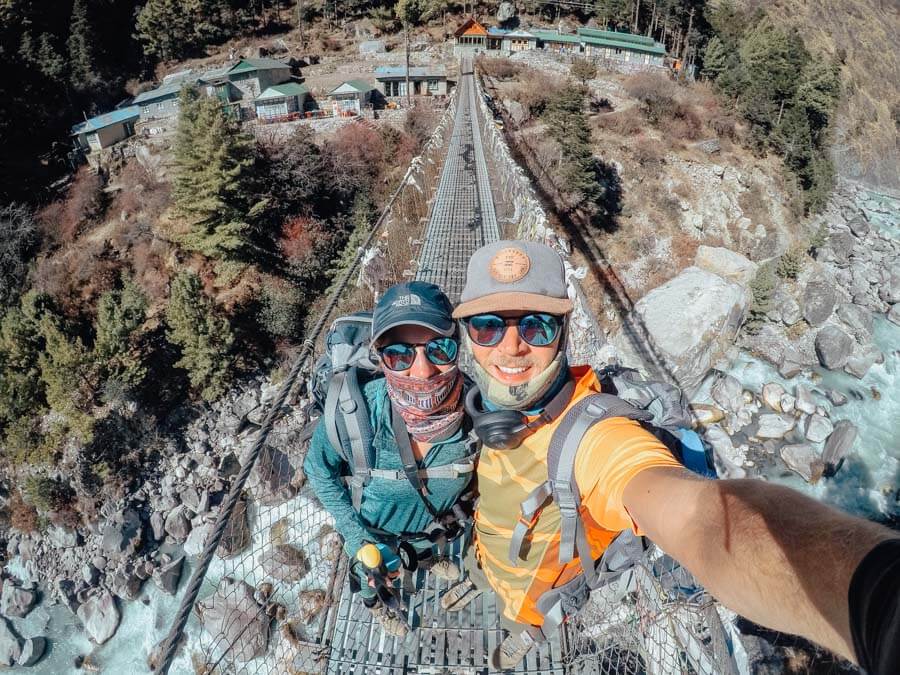
Altitude: Namche Bazaar (3 440m) – Lukla (2 860m).
Trekking time: 18 km | 8 hours.
Difficulty: Same as yesterday! A long day of hiking.
You’ve made it to the last day of your Everest Base Camp trek itinerary! Today you’ll retrace your steps from Day 1 and 2 (except this time you’ll cover the same distance in 1 day, and not 2!)
You’ll also see other trekkers ascending to EBC looking bright-eyed and bushy-tailed. If only they knew what was in store for them over the next few days! You’ll smile at them, and offer words of encouragement, but deep inside, you’ll just thanking your lucky stars that it’s them going up, and not you!
Enjoy your last lunch on the mountains in the village of Phakding before taking on the last section to Lukla. Spend the night in Lukla where you’ll celebrate with a delicious meal and a few cold beers!
Last day of your Everest Base Camp itinerary: Lukla to Kathmandu
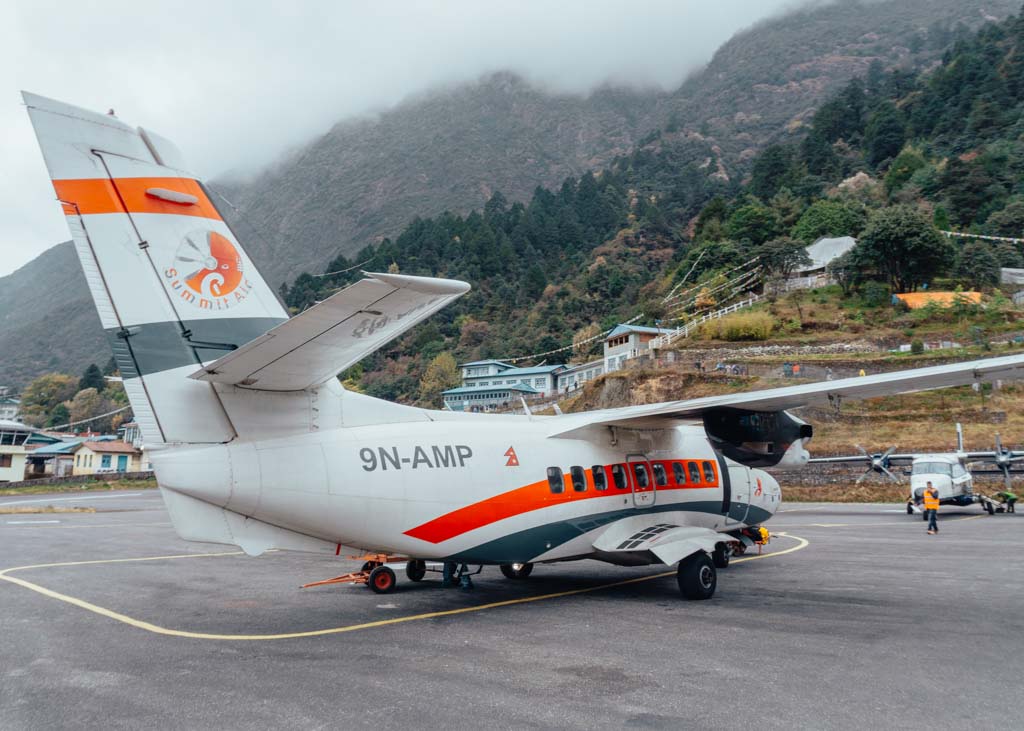
On the last day, you’ll be ready to say goodbye to the mountains! Once again your flight isn’t guaranteed to leave on schedule so one last bit of patience is required.
After I landed in Kathmandu, I went straight to my hotel, had the best hot shower EVER, ordered takeaways, hopped into bed, and didn’t leave my room for 24 hours! Those 24 hours of doing nothing were absolutely incredible!
Pictures speak a thousand words! After going through my EBC trek itinerary, check out my photo diary with includes all the highlights of my trek to Everest Base Camp.
Is Everest Base Camp trek worth it
Absolutely – But it’s not easy! From the terrifying flight into Lukla to the long trekking days, freezing cold tea houses, weeks with no showers, dealing with altitude sickness, and all the aches and pains that come along with it – It’s brutal.
But the experience is incredible and you’ll gain memories that will last a lifetime!
Should you plan your Everest Base Camp Itinerary with a tour or not
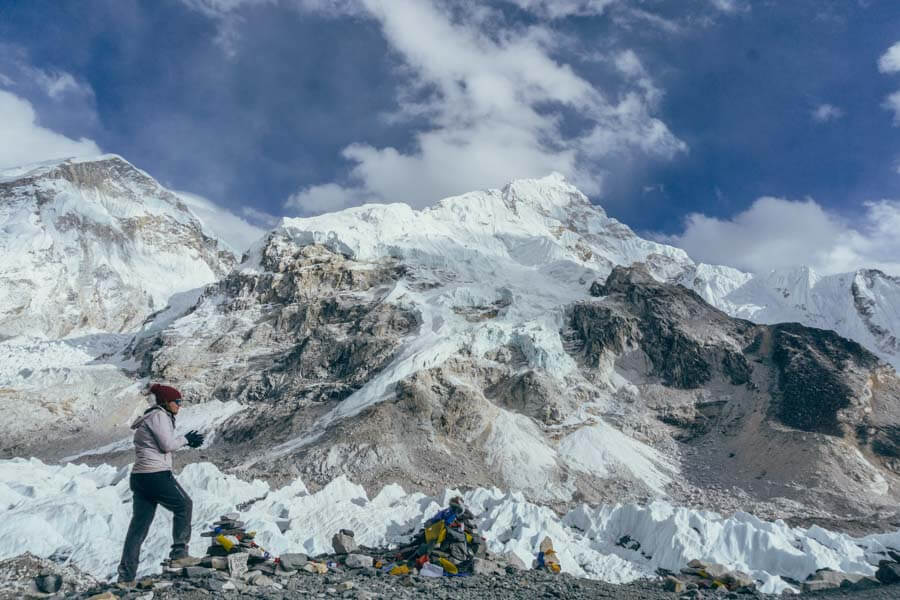
This one’s debatable!
In 2014 I summited the highest mountain in Africa, Mount Kilimanjaro . For this trek, you have to book a tour through an organized trekking company. I thought the same would apply to Everest Base Camp and wrongly assumed that attempting to conquer EBC independently was only for broke backpackers or highly experienced hikers.
I was wrong! You can definitely navigate the Everest region without a guide and many people do so.
However, I don’t regret booking through a trekking company, Mountain Monarch . Here’s why.
Why I booked my EBC trek with a tour group

Firstly, I added Island Peak to my Everest Base Camp itinerary. For this extra section of the trek, a guide is required. Whilst Everest Base Camp requires no technical climbing, Island Peak does and it’s intense.
If you’re up for the challenge, I highly recommend you add Island Peak to your Everest Base Camp tour. You can read about my climb to Island Peak here!
Secondly, I had previous experience with high altitude climbing and if it wasn’t for my skilled guide, I wouldn’t have made it to the summit of Mount Kilimanjaro. As with Kili, getting to Everest Base Camp is tough and reality is that it can be fatal. You need to pace yourself. Many people are put on oxygen and need assistance and those who trek independently don’t have immediate access to these emergency services.
And lastly, the fellow trekkers that I met on my Everest Base Camp tour were the best teammates anyone could ask for. I loved the support, the humor, the motivation, and having a small group of people who were there for me through thick and thin. As you get to the end of your Everest Base Camp trek, you’re going to need all the support you can get.
Final thoughts on how to plan a trek to Everest Base Camp
Trekking to Everest Base Camp is tough. Looking back, there are so many moments where I was thinking “ Why the F$%# did I sign up for this ” and “ With this money, I could’ve spent an extra 3 months backpacking instead of putting myself through this torture “.
But, challenging myself, my mind, my body – and crushing my goal and STILL going on to summit Island Peak – man, you cannot beat that feeling!
Are you planning a trip to Everest Base Camp? Looking for more information on how to get from Lukla to Everest Base Camp? Drop me a question in the comments section below!
Psst… Looking for epic adventures to add to your bucket list? Check out my other posts!
- Complete Guide To Island Peak Climbing in Nepal
- The Perfect Everest Base Camp Packing List
- 10 Things You Need To Know For Your Kilimanjaro Trek
- Everest Base Camp Trek Difficulty: 11 Key Things You Need To Know
- Everest Base Camp Trek with Island Peak Climbing: My Highlights and Photo Diary
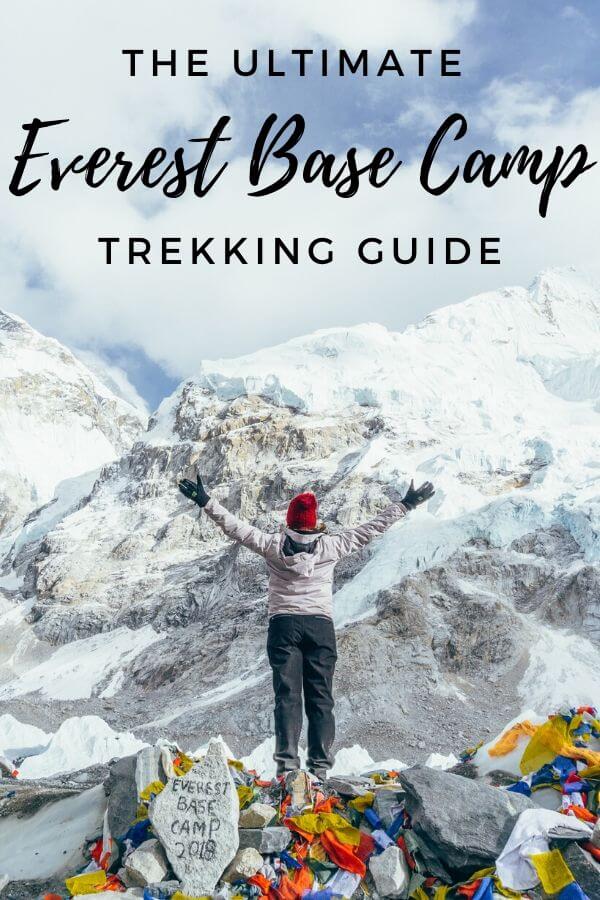
Hi, I'm Carryn. I’m an adventure travel blogger trying to figure out my way through life by traveling and exploring. Join me as I share my travel guides and tips for life abroad. Find out more about me here .
Backpacking Indonesia: 26 Things I Wish I Knew
Everest base camp trek difficulty: 12 key things you need to know, 24 thoughts on “the ultimate everest base camp trek itinerary: how to get from lukla to everest base camp”.
Wow! Sounds like such an adventure. I loved reading your in depth post about your Everest base camp itinerary. It sounds like there is so much that goes into preparing but definitely sounds like you had the adventure of a lifetime.
Thanks Ann. It sure was an adventure I’ll never forget!
Ok, this post was epic – so much information I have to save it. Thanks for sharing!
Thanks Laura! Glad you found it helpful.
this is absolutely breathtaking! i honestly don’t know if I would ever be prepared to do this myself, but your day by day break down was really helpful!
Thanks Claire! Looking back at the photos I’m still in shock that I managed to get to Everest Base Camp!
Amazing. What a trek and journey for your mind, body and soul!
It was indeed!
This is epic! Im going in April and I’m so excited. Ive done Annapurna base Camp and loved it so I’m sure ill love this too!
Hi Emma, Good luck for your trek! I’d love to hear how EBC compares to Annapurna.
So interesting to read about your experience! I’m going to Nepal soon to do the Annapurna base camp and mardi Himal. They have a lower altitude but I’m still a bit nervous because of the altitude sickness 🙆🏼♀️
Hi Nina, I’m sure you’ll love it. Just take your time and don’t be afraid to walk super slow (like I did)!
WoW! This sounds like one amazing trip and one I’m sure that you will never forget! Really inspiring
Thanks Lori. EBC tops my bucket list so now I’m looking for the next adventure to conquer!
Wow! This sounded so intense! What an experience to say that you’ve done it.
It was tough, but everyone goes through a different experience. I thought about turning back so many times, but I’m so glad I stayed strong and kept going!
Wow! What an incredible experience, I don’t know if I’m ready for it but you definitely gave me some things to think about, thanks for sharing!!
Thanks Meghan!
Amazing!!! Wonderful recap! EBC isn’t easy! That was my first dance with altitude! Need to get back to do Island Peak!!!
Hey Bridget, Island Peak is incredible and I’m so glad I added it to my Everest Base Camp itinerary. Congrats on making it to base camp!
BADASS! I love that you mentioned a longer itinerary to acclimatize (is that the right word? lol) naturally and a way to get off the beaten path for this popular trek! I hope to make the Everest Base Camp Trek in the coming years and this is definitely a guide I will come back to help plan (: AND CONGRATS on killing it on this hike! So epic!
Hay Aaren, thanks for the kind message! I’m so stoked that I made it to base camp. And you can to! If you ever decided to trek to EBC, let me know!
Congrats on choosing the High Scenic Trail via Mong La and Phortse instead of the crowded Tengpoche route 95% of trekkers use. The best kept secret in Khumbu is finally leaking out!
About helicopter traffic: Google [helicopter rescue scam Nepal] and be educated. Multimillion dollar business now, thousands of EBC trips destroyed every year with this insurance fraud.
Hi Petrus, Agree – the less crowded route is far better!
Leave a Comment Cancel reply

- Trekking In Nepal
- Everest Base camp Trek Packages
Everest Base Camp Trek
Everest Base camp Trek Packages , Mount Everest Trekking
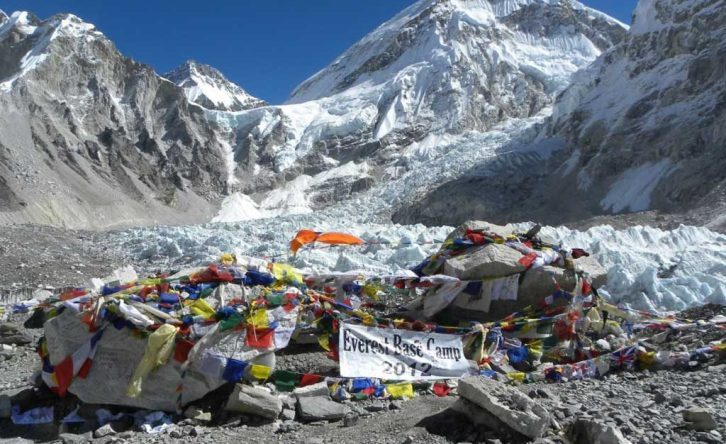
Number of Travellers
- Trip Itinerary
Cost Include/ Exclude
More information, cost & date.
Everest Base Camp Trek is the exciting exploration to the highest peak in the world, Mt. Everest [8,848 meters/ 29,032 feet], is one of the most renowned trekking adventures in the world.
This enriching Everest base camp trekking experience outshines other high-altitude adventures thanks to its unparalleled natural beauty, iconic landmarks, rich Himalayan bio-diversity, culturally enthralling Sherpa settlements, and breathtaking views of the several peaks that take top spots in the 8,000-meter class.
In this exciting journey, you will traverse across a diverse landscape, from forested trails decorated with dotted rhododendron flowers to peaceful meadows and alpine moraines. You will also get the opportunity to relish the rich bio-diversity of the Sagarmtha National Park, which has been conserving the rare species of flora and fauna of the region since 1976.
However, the best of this Himalayan exploration remains the beautiful and charming high-altitude settlements of the Sherpa ethnic group, the Himalayan natives who paved the way for the development of the mountaineering industry. In this Mount Everest Base Camp Trek, you will have a first-hand experience of the Sherpa people’s unique culture, traditions, and heart-warming hospitality.
Our 15 days EBC Trek start from Lukla, The Classic Everest Base Camp trek begins in Jiri, although many people opt to start from Lukla due to the convenience of a 40-minute flight from Kathmandu. However, it’s important to note that during the peak season, Lukla flights divert to Manthali Airport in Ramechhap.
Upon landing in Lukla, your journey officially commences as you join the main trekking route towards Everest Base Camp. The initial leg takes you to Phakding, traversing through picturesque settlements in the region. Namche Bazaar, a bustling trade market, becomes a significant stop where you’ll spend two nights for acclimatization. The following day involves trekking to Tengboche, home to the largest Buddhist monastery in the region.
Continuing your ascent, the next day’s trek leads to Dingboche, a captivating settlement nestled at an altitude of 4200 meters. To ensure a successful trek, an additional acclimatization day is incorporated here. After Dingboche, the journey progresses with an ascent to Lobuche, followed by a trek to Everest Base Camp and a return to Gorak Shep.
Post the base camp experience, you’ll ascend to Kala Patthar to witness the awe-inspiring sunrise over Mount Everest. The trek then retraces its path back to Pheriche, Namche, and finally Lukla, concluding your Everest Base Camp adventure in Nepal.
Highlight Of Everest Base Camp Trek
- Hiking to Base Camp of the World Highest Peak Mount Everest
- Spectacular views of the mountain ranges such as Mt. Everest, Mt. Ama Dablam, Mt. Thamserku, Mt. Makalu, Mt. Lhotse, and many more.
- Exploring the Sagarmatha National Park, UNESCO world heritage site.
- Walking to Khumbu ice fall and glacier along the way to the Everest Base Camp.
- Exploring the oldest monastery of the Everest region, Tengboche Monastery.
- Exploring Sherpa communities.
- Climb to Kala Patthar (5545 m) Overview of Mount Everest Sunrise and Sunset View
Everest Base Camp Trek Cost
Our 15-Day Everest Base Camp Trek Package costs start from USD 1300, This is the lowest price for groups of at least 6 people . For solo trekkers, the cost rises to USD 1800. Please note, for booking solo trekkers in peak season, you must send an email to confirm, as sometimes all of our guides can be booked for a group.
We organize both private and group join treks, For private treks, travel dates are flexible based on your request. However, for group join treks, we have specific dates available for anyone to join. The group size will be from 2 people to 12 people.
For Group Join Treks, We ensure that our fixed departure dates are guaranteed and fully confirmed. However, in the rare event of having fewer than 2 people, we will inform you 15 days prior to departure. At that point, clients can decide whether to withdraw from the trip or opt for a solo private trek by paying an additional cost.
Everest Base Camp Trek Packages
Mount Everest Base Camp Trek is, without a doubt, one of the most remarkable and popular Himalayan trekking adventures. What makes the experience even more enticing is that there are several ways to trek to this popular base camp, which also includes the explorations of the popular highlights in the surrounding region.
Adventure Great Himalaya 15 Day Everest Base Camp Trek package is a standard package with two acclimatization days along the trekking trail. If you are looking for a short variant of the exploration, you can go for the 10 Day Everest Base Camp Trek .
The short packages are designed for trekkers who have limited time on hand. in the 10-day package, the trekkers have to complete the adventure without acclimatization day.
For a more extensive experience in this mainstream trekking region of Nepal, we also offer trekking to Everest Base Camp, including the adventure to the side highlights of the region like:
- Everest Three High Passes Trek (21 Days)
- E verest Base Camp and Gokyo Lake Trek (18 Days)
We also customize the single highlight exploration packages like 14 Day Gokyo Lake Trekking or just a simple 7 Day Everest View Trek that doesn’t take you to the high elevation points of the region.
However, the trekking packages are not all that we offer; we also oversee the climbing peak adventures in the region that you can add to your trekking adventure. Some of our most popular trekking peak expeditions in the 6,000-meter class inside the Ev erest region are:
- EBC Trek with Lobuche Peak Climbing
- I sland Peak Climbing
- Mera Peak Climbing
Everest Base Camp Trek and Return Helicopter
If you are looking for a more comfortable trekking experience in this exhilarating trekking to Everest Base Camp, Adventure Great Himalaya also offers the 11 Day Everest Base Camp Trek Return by Helicopter .
This exciting trekking package follows the same mainstream trekking route of the general Mount Everest Base Camp Trek. Starting your trek after the Kathmandu to Lukla flight, you will trek through charming Himalayan settlements of Phakding, Namche, Khumjung, Tengboche, Dingboche, Lobuche, and Gorakshep before finally reaching the base camp.
Then, after hiking to Kalapatthar, you will take a helicopter flight back to Kathmandu, enjoying the incredible views of the Himalayan vistas. This exciting helicopter return package for Mount Everest Base Camp Trek is ideal for trekkers who are doing the exploration on a time limit.
As the helicopter return cuts off the return trek to Lukla for the flight back to Kathmandu, the difficulty level also significantly decreases. So, even trekkers who are concerned about the difficulty factors can take part in this exploration without the need to worry about the physical demand in the long haul.
Lukla Flight Information
For your Mount Everest Base Camp Trek, during the peak season months like October , November , March , and April , the flight to Lukla from Kathmandu will divert from Manthali Airport instead of Tribhuvan International Airport (TIA).
Manthali Airport is at a short driving distance of 4 hours from Kathmandu, so you will be able to swiftly transfer to Ramechhap without any delays. If you want to join the trekking trails on the same day as this scenic flight, you will have to get at 2:00 A.M. for the drive to Manthali.
This way, it won’t affect your itinerary plans in the trekking route, as after landing at Lukla, you will have to trek to Phakding for an overnight stay. But, there is also another efficient way to take the flight: you can drive to Manthali and stay there for the night, then take the morning flight to Lukla. more information about lukla flight information
Everest Base camp Trek Itinerary
Arrival in kathmandu (1,396 m.).
Upon your arrival, proceed to the outside of airport terminal, our representative will wait for you to take you to the hotel which taking around 20 minutes. Please look for your name which will be shown on signage. Overnight at hotel in Kathmandu.
Accommodation: 3 Star Hotel ( Kailash Kuttee or Similar) Meals : Dinner
Fly to Lukla and trek to Phakding (2,640 m., 3-hour)
Today we will take an amazing flight from Kathmandu to Lukla (2,827 m.) in the morning parallel to the huge Himalayan adjacent to Nepal and China. After 40 minutes, we will be landed in a runway and our caretaker will help us carry our belongings. Then we will walk down to the Dudh Kosi River, where we connect with the main path to Namche Bazaar. After moving all the way through the small area of Ghat (2550m), we will soon arrive at our tea house at Phakding.
Note: The peak season ( October / November and March , April) the lukla Flight will be divert to Manthali Airport Ramechhap )
Trek Duration : 3 Hour, Trek Distance: 8.2 kilometers Meals : Breakfast, Lunch, dinner , Accommodation: Twin sharing lodge / tea house
Trekking to Namche Bazaar (3,440 m., 6-hour trek)
Today, we start from Phakding and walk across the river to trek all the way through the area of rhododendron, blue pine forest and more which is really superb experience especially during the spring.
We go cross ways to the Dudh Kosi at Benkar and take pleasure from the scenes of snow-topped mountains Kusum Kanguru (6,369 m.), Thamserku (6,623 m.) and so on.
The way then becomes fairly difficult and includes a perpendicular climb to Namche Bazaar. You will now walk through upstream on flat land, on the bank, to the fusion point of the Dudh Koshi and Bhote Koshi rivers.
After crossing one of the suspension bridges above the river, we will ascend to Namche Bazaar. We get the most amazing vivid opportunities of gigantic peaks -Everest, Lhotse, Nuptse, Ama Dablam, Taweche is visible. Overnight at hotel in Namche Bazaar.
Trek Duration : 6 Hour, Trek Distance: 7 . 4 kilometers Meals : Breakfast, Lunch, dinner , Accommodation: Twin sharing lodge / tea house
Excrution Day at Namche Bazaar.
Today we will explore Namche Bazaar appropriate adaptation with the environment at the height. Namche is a prosperous village situated in a large protected hollow. And the amazing scene visible from here includes superb panorama of the Khumbu peaks and great views of Everest. Then, after having our breakfast, we also walk towards Thami (3,810 m.) over the amazing Bhote Khola River Valley or visit the national park headquarters to look at the strange displays of Sherpa culture and way of life. Over night at Lodge
Free Day : 4, 5 Hour, Trek Distance: 2, 3 Kilometers Meals : Breakfast, Lunch, dinner , Accommodation: Twin sharing lodge / tea house
Trek to Tengboche (3,800 m., 5-hour trek)
We will today descend down through the Khumjung community and move to the major path to Everest at Shanasa. We will walk further to Trashinga and then move down to go across the Dudh Koshi at Phunkitenga (3,250 m.).
In the daytime, it is a wide and vertical ascend through fir, black juniper, pine, rhododendron forest and reach Tengboche Monastery. Here we can see gigantic peaks AmaDablam, Kantega, Mount Everest etc. We stay at Lodge in Tengboche tonight.
Trek Duration : 5 Hour, Trek Distance: 5.9 kilometers Meals : Breakfast, Lunch, dinner , Accommodation: Twin sharing lodge / tea house
Trekking to Dingboche (4,410 m., 5-hour trek)
We will walk slightly down through the forest of birch, juniper, fir and rhododendron at Debuche. Here we only steady way up but due to the elevation we have to speed ourselves increasingly all the way through the day.
After passing the Imja Khola, the trail heads to Pangboche where we can see the beautiful mountain of Ama Dablam. Then our route is to climb all the way through unwrapped alpine hillsides prior to another crossing of the Imja Khola and reach Dingboche. Overnight Lodge .
Trek Duration : 6 Hour, Trek Distance: 9.1 kilometers Meals : Breakfast, Lunch, dinner , Accommodation: Twin sharing lodge / tea house
Acclimation Day in Dingboche.
Today you will have free for acclimation day.This day is rest day in Dingboche area. You can walk to explore Dingboche monastery and Climb to Nangkhartshang Peak (5083) while you are free for whole day. It is necessary to adjust with body and temperature in high elevation.
You can rest all the day with full of enjoyment of the panoramic views of Mt. Everest, Amadablam, Lhotse, Tawache, Nuptse, Kwangde etc. Stay overnight in Lodge.
Free Day – Meals : Breakfast, Lunch, dinner , Accommodation: Twin sharing lodge / tea house
Trekking to Lobuche (4,920 m., 5-hour trek).
Today, we go away Pheriche and the trail goes up to the drain of the Khumbu. Then after an hour, the path mounts up to the Khumbu Glacier. Almost half of the climb to the moraine is Dughla. Moving ahead from Dughla the trail keeps on ascending steeply to the crest of the moraine. The path now moves on flat level on the west part of the moraine prior to arriving at Lobuche. Overnight Lodge
Trek Duration : 6 Hour, Trek Distance: 6.6 kilometers Meals : Breakfast, Lunch, dinner , Accommodation: Twin sharing lodge / tea house
Trek to EBC (5356m) and back to Goraksheph 8-hour
Today is the day you have been waiting for the whole trek. A majestic view of sunrise will wake you up in Lobuche. The segment to Gorak Shep will be a short one and you can be there in no time from here. Once in Gorak Shep, you can lessen your bags and continue to the Base Camp.
We will arrive back here as it is the closest settlement/teahouses to the Everest Base Camp itself. You have multiple snow- covered as well as glacial sections to complete before the base camp.
The Everest Base camp will be marked by a large stone with some dozens of yellow camps to be seen in the distance. You can enjoy a great time here and take some pictures for the memory.
The views of amazing peaks so close to you will also make this trek worth it. On your return, you can enjoy some scenic views of the valley below and the Khumbu Glacier. Rest after a long day back in Gorak Shep. Overnight at Lodge in Goraksheph.
Trek Duration : 8, 9 Hour, Trek Distance: 11.5 kilometers Meals : Breakfast, Lunch, dinner , Accommodation: Twin sharing lodge / tea house
Hike to Kalapathar (5,545 m.) & back to Pheriche (4,240 m. 5-hour trek).
We will wake up early today to catch a glimpse of the sunrise view from Kalapather peak. It is one of the most popular natural viewpoints of the region to view Everest. Within a couple of hours of relaxed hiking from Gorak Shep, you will arrive at Kalapather.
The view of the Everest Massif alongside the Lhotse and Nuptse peaks unobstructed is mesmerizing. We will return to Gorak Shep for breakfast after some time in Kalapather. From Gorak Shep, it will take about 4 hours of leisure walk to reach Pheriche. This small village is known to provide a peek at the Sherpa Lifestyle in Khumbu. Overnight at a Lodge in Pheriche.
Trek Duration : 6 Hour, Trek Distance: 9.5 kilometers Meals : Breakfast, Lunch, dinner , Accommodation: Twin sharing lodge / tea house
Trek Back to Namche Bazzar (3,450 m., 6-hour trek).
You will start the return trek to Namche Bazar from Pheriche today. The trail adds a new perspective to the EBC trek and you can enjoy a relaxed walk. Stop and chat with the locals and you will reach Namche Bazar in no time.
You can head out and celebrate reaching the Everest Base Camp here as Namche has tons of cafes, pubs, restaurants, and hotels serving trekkers. Overnight at a hotel in Namche.
Trek Duration : 7 Hour, Trek Distance: 15 kilometers Meals : Breakfast, Lunch, dinner , Accommodation: Twin sharing lodge / tea house
Trek Back to Lukla (2,840 m., 6-hour trek).
The last day of the Everest Base Camp Tour offers you an opportunity to explore more of the local lifestyle in the Nepalese hills. In the small villages and settlements try the Himalayan delicacies and spend some time with the Sherpa community. Beside the Dudh Koshi River, you can have this magical view of the mountains of Khumbu one last time while trekking. Rest for the day after arriving at Lukla. Overnight at a Lodge in Lukla.
Trek Duration : 6 Hour, Trek Distance: 8.1 kilometers Meals : Breakfast, Lunch, dinner , Accommodation: Twin sharing lodge / tea house
Flight back to Ramechhap - Drive to Kathmandu
The flights to Ramechhap from Lukla are most likely to take place in the morning so be prepared. Once the plane arrives you can board it for another scenic flight back to Kathmandu.
After landing we will drive back to Kathmandu, It takes about 4 hour, Overnight at a hotel in Kathmandu.
Meals : Breakfast Accommodation: 3 Star Hotel ( Kailash Kuttee or Similar)
Trekking in the Himalayas can come with some challenges and it is wise to keep some extra days in your itinerary. We have this day separated to handle any complications like flight cancellation, delay, bad weather, or similar factors during the Everest Base Camp Trek.
If everything goes according to plan, you have a brief Kathmandu sightseeing tour for you. Visit the major attractions, monuments, sites, and heritage sites that this lively city has to offer for travelers.
Meals : Breakfast, Accommodation: 3 Star Hotel ( Kailash Kuttee or Similar)
Departure from Nepal
Our team will take you to the TIA (airport) sometime before your departure flight. With some amazing stories, memories, experiences, and adventures from the Nepalese Himalayas and the Everest Base Camp trek you can return to your home with delight. Stay connected with team AGH for your next great journey in Nepal.
Meals : Breakfast, Accommodation: No
Transportation: – Airport transfer
Include/Exclude
Service included.
- All Airport Transfer (Airport – Hotel – Airport)
- 3 Nights twin / Triple sharing at 3 star Hotel in Kathmandu with Breakfast
- Meals on the trek ( Breakfast, Lunch, Dinner)
- Hot Drinks – Tea / Coffee with meals
- Accommodation in Trekking – 11 Night twin sharing Lodge to Lodge Accommodation During the trekking,
- All Necessary Trekking Permit ( Sagarmatha national park,Khumbu Local Tax and TIMS Permit)
- Kathmandu – Lukla / Kathmandu Flight ticket Limit weight is 10 kg and hand- Cary 5 Kg
- Trekking Guide: An experienced, helpful, friendly English speaking trekking guide
- Trekking Porter – Carry your Luggage
- Guide, Porter, Insurance and well paid salary
- Trekking Equipment: Sleeping bag, Duffel Bag a.- Refundable after the trek.
- Oxe -Meter- To Check your oxygen saturation and heart rating
- Free Everest Trekking map.
- Souvenir Company T-Shirt, Hat
- All Government Taxes and Service charge.
Service excluded
- International Air fair and Nepal entry visa fee
- Travel insurance and emergency rescue evacuation.
- All bar bills, bottle of drinks, extra drink, tea, coffee etc
- Wi- Fi, Hot Shower
- Electronic device re-charge such as Mobile, Camera etc.
Everest Base Camp Trek Difficulties
Trekking to Everest Base camp straight forward with good and wide path, Walking 6, 7 hour each day from 7 am after breakfast to till 3, 4 pm. Anyone who is reasonably fit will be able to complete this trek. There are no specific exercises for the trek, but some cardiovascular training is always recommended. You should start Cycling, hiking, swimming, climbing or hill walking at least two weeks before the trek.
The trek has a complete itinerary of 15 days and therefore fit for those who have a long holiday planned and want to trek a leisurely pace. The long trekking days also ensure that all the trekkers are properly acclimatized and relaxed even with a long day of trekking.
The risk of altitude sickness is always present. If you are taking some medication, you should consult your doctor for advice for trekking in such high altitude regions. A right level of fitness will make the trek pleasant and comfortable.
Here are More information about EBC Trek difficult
Best Time to Everest Base camp Trek
Arguably, the b est time to Everest base camp Trek is the autumn season of September to November. The trek of Everest base camp from late September to November has many perks.
Some of the major highlights of the trek include the spectacular view of the mountains, moderate trekking temperatures, and unobstructed views of the mountains. There might be some instances of unfavorable conditions which is quite common. The weather around the Everest Base Camp is quite unpredictable in comparison.
The amount of precipitation is quite less in lower elevations and snowfall is less as you move higher along the trail. You should always check for weather conditions before you start the trek and prepare accordingly.
Besides this, the small window from March to May is also a great time to trek the Everest region. The trails look beautiful, and the rhododendron flowers bloom well over the hills painting the hills red and pink. The Everest region has an excellent climate and weather, and the moderate temperatures make for a great trekking experience.
Everest Base Camp Trek Route
There are generally two trekking routes for the Mount Everest Base Camp Trek: North Base Camp [5,150 meters/ 16,896 feet] on the Chinese side and South Base Camp [5,364 meters/ 17,598 feet] on the Nepali side.
The trekking to Everest Base Camp on the Nepal side is more popular than the Chinese side. Due to the complex permit system on the Chinese side, most trekkers prefer to do the trek to the southern base camp.
The incredible natural allurements, wide Himalayan vistas, diverse landscape in the trekking journey, Himalayan flora & fauna, and the culturally enthralling experience on the Nepali side attract thousands of trekkers every year.
This exciting highest base camp journey in the world starts from Lukla [2,827 meters/ 9,274 feet] and passes through the high altitude settlements of Everest region like Namche Bazaar , Tengboche , Lobuhce , Gorakshep and before the final hike to Everest Base Camp.
Adventure Great Himalaya Company also offers an immersive experience classical route of the Everest Base Camp Trek. The traditional trekking route to the base camp used to start from Jiri ; however, for a more convenient approach, the start point in an alternative trekking route has been moved to Phaplu .
You will be able to drive directly to Phaplu from Kathmandu and follow the gradually ascending route to join the mainstream route at Lukla.
Everest Base camp Trek Altitude Sickness & prevention
Typically, Trek to Everest takes you above 5000m elevation. So, altitude-related sickness is the most common problem you face during this journey.
Most travelers think AMS occurs when you travel above 3500 m, and this trip begins from 2800 m altitude. So, the chances of altitude sickness are high during Everest Base Camp Tour.
Headache, vomiting, nausea, dizziness, shortness of breath are some of the usual signs of altitude-related sickness. If you start to detect any of the symptoms, inform your guide and follow their instructions.
When suffering from AMS, do not continue the trek; instead, stay in the same destination or head to lower areas.
Trekking to Everest Base Camp is not an easy journey, but with some tips, you can make it a bit easier:
- Do not consume alcohol or smoke cigarettes
- Avoid eating meats in this trek as they are not fresh and hygienic.
- Keep yourself hydrated by drinking 3 to 4 liters of water each day.
- Walk slow and steady while covering 10 to 15 km each day.
Everest Base Camp Trekking Permit
Without trekking permits, you cannot complete your Everest Base Camp Tour journey. So, for this trip, you are required to carry two permits: Sagarmatha National Park Entry Permit and Khumbu Rural Municipality Entrance Permit.
Khumbu Rural Municipality Entrance Permit costs NRP 2000; $20 (for all visitors). Likewise, Sagarmatha National Park Entry Permit costs NRP 3000; $30 (for Foreigner) and NRP 1500; $15 (for SAARC).
Everest Base Camp Trek Distance
Everest Base Camp Trek, one of the iconic treks in the world, is about 130 km long in total. That means while you trek toward Everest Base Camp, you will cover 65 km. And 65 km more while returning from Everest Base Camp. You must cover a 130 km distance to complete it, starting and ending at Lukla.
The Everest Base Camp Trek distance is easy, moderate, or difficult. It depends on your experience level and preparation. If you have been on similar treks in the Himalayas, the trek’s distance is okay.
However, it can be a bit demanding and massive for beginners. You have to cover a distance of 15 km per day on average. The trail is rough, rocky, steep, slippery, and sometimes descends. The conditions might slow you down. Otherwise, 15 km a day is relatively easy. You’ll have around 6-10 hours daily to cover that distance. Come well-prepared to cover an average of 15 km per day. And you will have a walk of life.
Required Travel Insurance For Everest Base Camp Trek
Travel Insurance is mandatory if you want to begin your Everest Base Camp Trek Nepal. It is because no one can predict what mishaps can happen in the mountains, so having insurance covers these issues.
While choosing a company, make sure their plan covers all medical and travel problems like altitude sickness, emergency rescue, sprained ankle, and more. The insurance plan should be able to give you facilities like helicopter rescue, clinical attention, air ambulance, and so on.
Most importantly, many insurance companies do not cover treks above 4000 m, so make sure your cover trips above 5000 m altitude. With travel insurance, you can complete your expedition with no worries.
EBC Trek Sherpa Guide
Trekking solo is possible for Everest Base Camp Trek, but we recommend not to because the routes are mentally and physically challenging. So, if you dislike traveling in groups, you can hire experienced guides for extra comfort and a stress-free trek.
Having a guide will not only help you with navigation, but they will also take care of your security and safety. They will be your closest companion who helps you connect with local culture and communicate with the people.
Trekking Porter – For Carry Your Luggage
Having a porter lessens your baggage weight, as they carry all your heavy belongings allowing you to enjoy the trek without feeling fatigued. They are also the locals of these areas, so they know many shortcuts. Porters are less expensive in comparison with licensed guides and a great companion with basic English speaking skills.
Tip for Guide, Porter
Tipping is a lovely gesture to service providers around the world. And it is no new in Nepal’s trekking trails. After loving the service of their guides and porters, trekkers want to offer some tips to them. Tipping is not compulsory, but it can surely make your porter and guide’s day. It is all your choice.
As it is optional, there is no exact number for tipping. You can give as much as you like. Still, if we have to help with how much to offer, we would suggest you a suggestion. If your trek is ten days long, you can give them around USD 10 to 15 per day as a tip. So you can use this rate to tip your guide or porter. That is a standard tip amount. If you can give more or less, that is no problem.
There is no need to tip your team every day. You can just complete the trip and pay them at last. Make sure the given amount goes into the hands of the right people. You can use an envelope to give a gratuity.
Hot Shower Facility
Almost 95% of tea houses and lodges have a hot shower facility during the EBC trek. In lower areas like Namche, Phakding, you can quickly get a hot bucket or tap shower at a low price. However, the hot showers are expensive as you ascend above to Dingboche, Gorak Shep, Tengboche, etc. Getting running water is a challenge in the upper region, so bucket water is better.
How much Money Carry for EBC Trek?
Even though our package covers most of your costs like meals during the trek, accommodation, Guide, Porter, Lukla flight etc., it doesn’t cover your personal bills. So, you need to carry extra cash to pay for your beverages, restaurants, snacks, souvenirs, hot showers, and more.
Each day you might spend about $15 to $20, depending on your spending habits. So, carry the equivalent money for payment as the shops in the mountains do not accept visa cards or e-payment.
Toiletry and Room
Basically, Everest Base Camp Trek is a tea house trip, so all the accommodations provide simple facilities. The rooms are primarily twin-sharing, so you have to share them with other travelers. Each room consists of beds, pillows, and blankets, but they are warm and cozy. As for the toilets, you find attached bathrooms in lower regions, but you only find shared bathrooms as you keep ascending.
EBC Trek Equipment List
For the Everest base camp trek, The following Items are recommended for every trekker , This List is only for Guide. There are numerous option brands and versions of each piece of equipment. EBC Trek Packing list
Booking & Cancellation
Before preparing for your treks, you should carefully read the booking terms and conditions. If you wish to book your trip with us you should send a completed booking form and a scan of your passport along with a 20% amount of the trip.when you pay deposit then your trip is confirmed.
The trip deposit can pay by online, or pay directly through the bank, they impose a service charge. Please note that the initial booking deposit is not refundable if you cancel 45 days prior to departure
The remaining balance, you need to pay after arriving in Nepal. It is to be paid in USD or Nepalese rupees in cash before your departure. If you pay via debit or credit card, an additional fee of 13% will be charged to cover the tax and vat.
Read more for d etails term and condition
Why adventure great himalaya for you everest adventure.
Adventure Great Himalaya Company has been leading the Nepali trekking market as an expert for over a decade and houses expertise with over two decades of experience. In terms of quality of services and amenities, comfort, safety, and best value experience, you will be a leap ahead of other trekkers.
We are also an authentic Nepal-based trekking company and have been collaborating with the local experts of the region to add more enrich your overall experience. If you are planning to book the trek from foreign trekking companies, they don’t have the permit to organize the trip on their own and have to book services with a government-licensed company in Nepal.
So, you will only be paying the extra intermediaries fees for the same packages. Booking our services will ensure that you won’t need to pay any extra commission to a third party and will be able to enjoy an incredible excursion at the best-value cost.
Benefits of Hiring Services of Adventure Great Himalaya
- Trek packages designed to emphasize the utmost safety and comfort of the trekkers
- Best value price in the market
- Expert guides, government-licensed and with relevant number of experience
- Free airport pick-up and drop-off facilities
- Arrangement of sleeping bag and down jacket if necessary
- Free porter with 15kg weight limit per trekker
- Small group sizes allocation for a more immersive experience
- Customizable itinerary plans befitting your needs
- Transparent pricing and an extensive set of inclusions
- 24/7 available customer service and flexibility in itinerary adjustments
- Operation at a wide range of destinations
- Post trekking support
- Authentic testimonials and positive reviews
Note: The below Price and Travel date is for the Group Join Basis. If you take private trip all travel dates are guaranteed. Private Trip
How High is Everest Base Camp Trek?
Everest Base Camp lies at the height of 5364 m above sea level. You begin the journey from Lukla at 2860 m altitude and reach the base, then return down.
How Hard Everest Base camp Trek?
The trek has a moderate level of difficulty that requires some determination and mental stability. Each day walking 5 to 6 hours in the off-beat steep terrains is harsh for beginners. Get More information
When are the best months for Everest Base Camp Trek?
Generally, the trek is suitable throughout the year, but many prefer to visit during March, April, May, September, October, and November.
Is it necessary to have previous trekking experience?
No, it is not mandatory as we have many first-timers in our group, but having prior experience makes the trek easier.
Is the trek fit for everyone?
The trek is manageable by any trekker, whether they are beginners or experienced, as long as they are physically fit. There is no age limit inflicted for the Everest Base Camp trek.
Is this Himalayan trek safe for solo female travelers?
Yes, it is safe as our main priority is the welfare of our guests (both male and female). Our guides are always mindful of your whereabouts during the trek. In addition, we have a long, strong relationship with the lodges we visit, so they are reliable and safe as well.
Do I need to do Physical exercises for the trek?
It is best recommended to have a fit body, so do light exercise for this trek. You can go cycling, swimming, long-hour walks, running, etc.
What is the standard size of the trekking group?
We usually make small groups of 6 to 10 people as it is easier to travel and maintain continual contact. We also organize Private Treks for Solo , Couples and family
What is your payment method for the remaining deposit? Do you take US dollars or credit cash after I arrive in Kathmandu?
We accept all major currencies, allowing you to settle the remaining balance in cash. While online payments are also an option, please note that there is a 4% surcharge on top of the total cost, as per the regulations of Nepal’s banking system.
How much Do i Need extra csh For EBC Trek?
Yes, we recommend you to carry around $300 to $400 for extra expenses. Our packages do not cover your bar bills, snacks, Wifi, charging costs at tea houses, and other fees.
Can I use the Credit card on the trekking routes?
Generally, the use of credit cards is still limited in Nepal, so there is no ATM after Namche. Thus, it is better to carry enough cash for the trek.
Is insurance compulsory? If yes, where can I acquire it?
Yes, insurance is a must for this trek, and acquiring them is your responsibility.
What should I pack for EBC trek?
Bring clothes and equipment depending on the season you choose for travel. You can know more about it from the packing list.
What is the Lukla flight weight limit?
The overall luggage allowance for the flight from Kathmandu to Lukla is 15 kg, 10 kg for your main baggage and an additional 5 kg for your carry-on.
What kind of lodging can we expect on this ebc trek?
The trek primarily involves tea-house lodging, offering basic accommodation. Your stay typically includes a private room with two separate beds and a shared bathroom. For those seeking a more upscale experience, there are options for luxurious lodges with private bathrooms available at an additional cost.
Why Should I travel with Adventure Great Himalaya?
Our company has a highly experienced group of guides for mountains and a great ground staff team for Kathmandu. We not only believe in completing the trek but also care about your safety and entertainment. Our friendly and skilled personnel have years of trekking experience with hospitality and medic training.
Is hiring a guide necessary even if I have previous trekking experience?
Yes, it is mandatory because we have full-time guides that have finished many treks successfully. They will add greatness to your trip and make it unforgettable.
Can your guide speak English?
Yes, all of our guides are fluent in English as they have to deal with people from around the globe. They have a friendly nature and are good at connecting with travelers.
Are all your trekking dates guaranteed to run?
Yes, we guarantee you the trek will run, so be assured while making the deposits. Most of our out dates sales fast during peak season compared to off days.
What are the booking and cancellation policies?
Please read booking, terms & conditions for detailed information as given below link
How much Should i Tip for Guide and Porter?
Taiping For a guide between $10 to $20 per day. So, for a standard EBC trek that takes around 12-14 days, you might consider tipping your guide between $120 to $280 for the entire trek.
For porters, tipping around $100 to $150 per porter
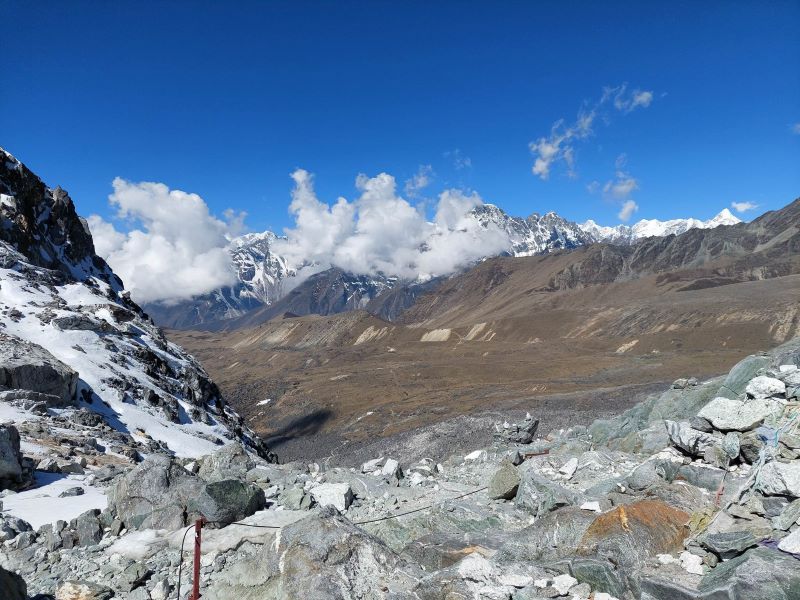
Reviews of Everest Base Camp Trek
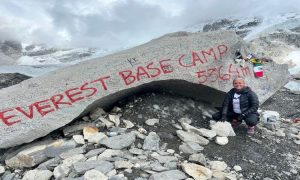
Echo Roburt
This was absolutely the most amazing trip. Adventure Great Himalaya took care of me from the time I landed in Kathmandu until I flew home. They are very knowledgeable about the city and the mountains and treat their guests like family. I’m hoping to go back in a couple of years and do another of their treks. I absolutely recommend using them for your next Himalaya adventure! Love this company!!
Source by Trip adviser

I just came back from an amazing experience i had with Adventure Great Himalaya and their guide Nabin. Everything was perfect, i cant think of anything which wasnt. All the lodges, the food, the service while organizing the whole trip via email , the service provided by nabin during trekking, everything was brilliant. I was trekking on the EBC trek to kala patthar which is summited, it has been an adventure of a lifetime and i can highly recommend adventure great himalaya, which is a highly professional, very fair and honest company. 100% Support!
And if you ever end up in the office of Mr. Karki , try the Masala Tea from next door, its probably the best in Nepal !
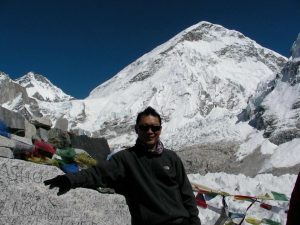
Trekking to Everest Base Camp was my lifetime ambitious. I fulfilled it in October 2011. It is my lifetime experience and my life’s most memorable moment. The moment I reached the Everest base camp and the top of Kala Patthar was really awesome. It was like you were on the top of the world….well, not quite, but the sense of achievement you felt was beyond words. All these would not make possible without Adventure Great Himalaya Trek & Expedition (P) Ltd. Thanks to Mr. Babu (Managing Director of Adventure Great Himalaya).
I traveled alone and joined with a group of 15 trekkers from UK. I felt very comfortable with the group I went with. They were friendly and not to mentioned very funny as well. We turned into friends almost instantly. There were a lot of fun traveling with them and I am glad to have their company on my trip.
Our trek was fantastic. Everything was very well organized. Even when we had bad weather in Lukla and could not fly back to Kathmandu, the tour guide and the Trekking company managed to rearrange everything and we flew back to Kathmandu next morning.
On our trek, breakfast, lunch and dinner were very well served. We chose what we want from the menu. Food was fantastic and cooked in “clean” and “safe” kitchens. Adventure Great Himalaya provides us with great porters and lovely guides. Guides are very knowledgeable and have great experience in the Himalaya region. They were friendly , spoke good English and great singers as well. They always made sure that we got the best rooms in the lodge. Every night after dinner, we were brief by guides on the journey ahead next day. I personally found this very useful and communicative.
In Himalaya region, everywhere you look, there is great view. The astonish view is way beyond words could description. The sheer size of the mountains and valleys is something I have never experienced. Thanks to Adventure Great Himalaya for making my EBC trek a wonderful and memorable experience. If I decide to go back for another adventure in Nepal, I will definitely go with Adventure Great Himalaya. NAMASTE.
Alexaler, Jakarta Indonesia
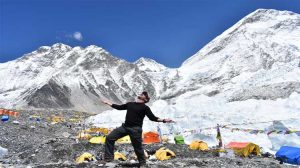
This trip from start to finish was an absolute adventure. I arrived later than I thought I would in Kathmandu and Great adventure Himalaya made it accommodating for me. Well, we started off from Kathmandu and met our Guide Santosh(amazing guide from start to finish) and got to the airport and flew to Lukla. From there the trekking began. My friend and I are fast hikers and made up incredible time. Santosh, our guide, really took amazing care of my friend and I. The price we paid was one of the best you’ll find out there. If your thinking about doing this without a guide, that would be stupid. 2 people died on the trail who didn’t have guides while we were there. Plus it was a lot of fun with ours.
This is a trip I will remember for the rest of my life.
Source by Trip Adviser
Adam Hill San Francisco U.S.A
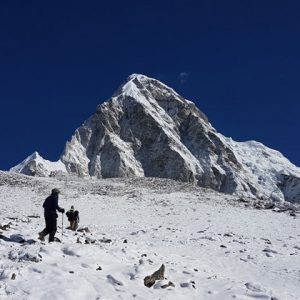
I did the E.B.C trekking with this company in March 2017. This is Very good company for Everest Base camp Trek. The Company professional, helpful and approachable. I booked the trek as a solo female traveler. I felt safe throughout my time with the company. The trek was amazing, a once in a lifetime must do trek. I was provided with a guide and a porter by the company, both of whom were professional and very helpful. The trek its self was medium to hard and tiring of course but worth it! The scenery is just amazing no words can describe it. All the arrangements were made by the company, hotel stays, return flights from KTM to Lulka, all food and drinks during the trek. I hope to book another trek with the company in the future. A dream come true thank Adventure Great Himalaya .
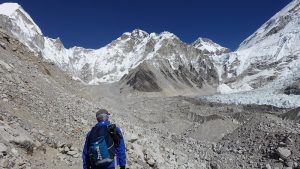
This is my second time engaged Adventure Great Himalaya for my trekking in Nepal, first in ABC and this time is Everest Base Camp Trek.
The company owner, Mr. Babu Karki, is a helpful and kind person, he will answer to all of your enquiry before you depart from your home country. His arrangement of the trip is perfect, immediately after you stepped out from the arrival hall of airport, his staff will be there waiting for you. During the trekking day, he will always keep in touch with the guide to ensure the condition and progress of the guest.
Mr Babu has very high requirement of the guides he employed, the guide that I got for this 15 days, Kirshna, is very professional and experienced. He is very familiar with EBC route, he knows exactly how long to take to reach to next pit stop. He even become the pace maker for us, he adjusted the trekking pace based on my physical condition, this is really helpful and I barely feel any tiredness after the everyday trekking.
Regarding the charges, I did some comparison before I decided to choose Adventure Great Himalaya, the charges is very reasonable. After completed the trip, I will say the charges is very value for money because the service provided by them is equivalent to others big company if not better than them. The guide i got is better than those big company and I am staying at the same lodge with those who engaged big company as their agency.
i will highly recommend anyone who is planning to travel to Nepal to check out with Adventure Great Himalaya, you will never regard of your choice!
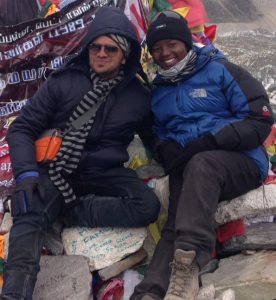
Praneet Dabral
Did the Everest base camp trek with this company. It was an amazing and a life changing experience. Its a little tiring trek but when you reach the base camp you realize all the blood, sweat and tears were worth it. The arrangements were very smooth and efficient. The guide and porter were very helpful and friendly. The flight bookings, hotel bookings and food everything was right on schedule. Hope do do some more treks with this company again. You pass beautiful places like Namche bazaar, Tingboche and Gorakshep on the way. Loved the serene beauty of Tingboche especially the monastery. Would definitely recommend this trip to everyone.
Thane, India
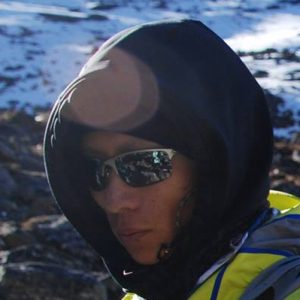
Chang Kah Wane
The services by AGH is always excellent and wonderful! I’ve trek with them on 4 different occasion (3 on EBC, Island Peak and one in Langtang) and without fail, I’ve always have a wonderful experience. Babu, the managing director of AGH and all their staff is always very accommodating and really helpful!
The guides of AGH, particularly Nabin (he guided me on 3 different occasion) and Nanda is excellent, they go above and beyond what is required of them. I have them to thank for guiding me safely throughout the treks. They are to me, a friend and guide.
I will continue again and again to use AGH for all my future trips to Nepal! If you ever needed an adventure operator in Nepal, AGH is the go to agency!
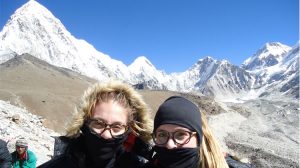
My sister and I decided we wanted to go trekking to Mount Everest Base Camp. Thanks to Adventure Great Himalaya we had a fantastic experience! It was everything we could have asked for and more. The staff and the guides were super professional and knowledgeable. We are so happy we decided to use a local company. Thank you for everything!!!
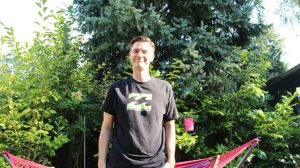
Kevin Petzold
Im Oktober 2010 lief ich zusammen mit drei Freunden den Everest Base Camp Trek. Unser Guide hiess Nabin. Er war nicht nur Jemand, der uns den Weg gezeigt hat, sondern er hat auch versucht uns so gut wie moeglich die nepalesische Kultur naeherzubringen. Am Ende unseres insgesamt drei Wochen andauernden Aufenthalts in Nepal hatten wir zu ihm dann ein sehr freundschaftliches Verhaeltnis.
Leider bekam ich kurz vor dem Ziel die ersten akuteren Symptome von Hoehenkrankheit, so dass wir ein paar Tage vorher umkehren mussten. Die so gewonnene Zeit verbrachten wir in Kathmandu, wo Nabin uns dann noch ueber mehrere Tage verteilt die Stadt gezeigt hat. Außerdem hat Babu uns noch einen Rafting Ausflug organisiert.
Alles in Allem muss ich sagen, dass uns Babu und sein Team vom Moment unserer Ankunft in Kathmandu bis zu unserer Abreise einen hervorragenden Service boten. Beim naechsten Trip nach Nepal, welchen es definitiv geben wird, werde ich mich daher definitiv wieder an Adventure Great Himalaya wenden.
Name: Kevin Petzold Country: Germany Email: [email protected]

Trekking to Everest Base Camp was my lifetime ambitious. I fulfilled it in October 2011. It is my lifetime experience and my life’s most memorable moment. The moment I reached the Everest base camp and the top of Kala Patthar was really awesome. It was like you were on the top of the world….well, not quite, but the sense of achievement you felt was beyond words. All these would not make possible without Adventure Great Himalaya Trek & Expedition (P) Ltd. Thanks to Mr. Babu (Managing Director of Adventure Great Himalaya)
I travelled alone and joined with a group of 15 trekkers from UK. I felt very comfortable with the group I went with. They were friendly and not to mentioned very funny as well. We turned into friends almost instantly. There were a lot of fun travelling with them and I am glad to have their company on my trip.
Our trek was fantastic. Everything was very well organized. Even when we had bad weather in Lukla and could not fly back to Kathmandu, the tour guide and the Trekking Company managed to rearrange everything and we flew back to Kathmandu next morning.
On our trek, breakfast, lunch and dinner were very well served. We chose what we want from the menu. Food was fantastic and cooked in “clean” and “safe” kitchens. Adventure Great Himalaya provides us with great porters and lovely guides. Guides are very knowledgeable and have great experience in the Himalaya region. They were friendly; spoke good English and great singers as well. They always made sure that we got the best rooms in the lodge. Every night after dinner, we were brief by guides on the journey ahead next day. I personally found this very useful and communicative.
In Himalaya region, everywhere you look, there is great view. The astonish view is way beyond words could descript. The sheer size of the mountains and valleys is something I have never experienced. Thanks to Adventure Great Himalaya for making my EBC trek a wonderful and memorable experience. If I decide to go back for another adventure in Nepal, I will definitely go with Adventure Great Himalaya.

Write a Review
Enquiry form.
Note: Please ensure names must be exactly the same as your passport (for ticketing/security purposes). You could incur extra costs or even miss your flight if the names are not correct.
Interested Program: *
Full Name: *
Email Address: *
Contact Number: *
Afghanistan Albania Algeria Andorra Angola Antigua and Barbuda Argentina Armenia Australia Austria Azerbaijan Bahamas Bahrain Bangladesh Barbados Belarus Belgium Belize Benin Bhutan Bolivia Bosnia and Herzegovina Botswana Brazil Brunei Bulgaria Burkina Faso Burundi Cabo Verde Cambodia Cameroon Canada Central African Republic (CAR) Chad Chile China Colombia Comoros Democratic Republic of the Congo Republic of the Congo Costa Rica Cote d'Ivoire Croatia Cuba Cyprus Czech Republic Denmark Djibouti Dominica Dominican Republic Ecuador Egypt El Salvador Equatorial Guinea Eritrea Estonia Ethiopia Fiji Finland France Gabon Gambia Georgia Germany Ghana Greece Grenada Guatemala Guinea Guinea-Bissau Guyana Haiti Honduras Hungary Iceland India Indonesia Iran Iraq Ireland Israel Italy Jamaica Japan Jordan Kazakhstan Kenya Kiribati Kosovo Kuwait Kyrgyzstan Laos Latvia Lebanon Lesotho Liberia Libya Liechtenstein Lithuania Luxembourg Macedonia Madagascar Malawi Malaysia Maldives Mali Malta Marshall Islands Mauritania Mauritius Mexico Micronesia Moldova Monaco Mongolia Montenegro Morocco Mozambique Myanmar (Burma) Namibia Nauru Nepal Netherlands New Zealand Nicaragua Niger Nigeria North Korea Norway Oman Pakistan Palau Palestine Panama Papua New Guinea Paraguay Peru Philippines Poland Portugal Qatar Romania Russia Rwanda Saint Kitts and Nevis Saint Lucia Saint Vincent and the Grenadines Samoa San Marino Sao Tome and Principe Saudi Arabia Senegal Serbia Seychelles Sierra Leone Singapore Slovakia Slovenia Solomon Islands Somalia South Africa South Korea South Sudan Spain Sri Lanka Sudan Suriname Swaziland Sweden Switzerland Syria Taiwan Tajikistan Tanzania Thailand Timor-Leste Togo Tonga Trinidad and Tobago Tunisia Turkey Turkmenistan Tuvalu Uganda Ukraine United Arab Emirates (UAE) United Kingdom (UK) United States of America (USA) Uruguay Uzbekistan Vanuatu Vatican City (Holy See) Venezuela Vietnam Yemen Zambia Zimbabwe
Number of People: *
You May Like This
Everest 3 high pass trek, everest base camp luxury lodge trek, short everest base camp trek – 10 days, gokyo lake trekking, share this trip, customer's reviews.

Adventure Great Himalaya Pvt. Ltd. (Private day tours)
Why booking with us ?
- Fully Locally Owned Company
- Quality Of Service and Competitive price
- Highly Professional Staff
- Flexible and customization trip itinerary
- 100% Customer satisfaction
24 hour customer service

- Classic EBC Trek
- EBC + Gokyo Trek
- Jiri to EBC
- 3 Passes Trek to EBC
- Island Peak and EBC
- Acclimatisation
- Packing List
Get a Trek Quote
Make the Right Choice for Your EBC Trek
Get trek quotes from companies i recommend.
- Just Me
- Me + 1
- Me + 2
- Me + 3
- Me + 4
- Me + 5
- More than 6
What travellers say?
I've helped 1000s of people plan a safe and successful EBC hiking adventure.
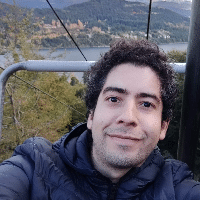
The response I got from Mark was truly amazing. Fast and with as much information as you can imagine.
Mario, Spain

Very informative website with useful tips - just looking forward to when we are able to book something now!
Michelle, UK

Mark’s service went well beyond what I had expected, and we are already looking to plan our next trip through Mark and Mountain IQ.
George, USA
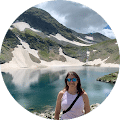
Very courteous and helpful. I appreciated the email communications and valuable advice provided in them.
Teodora, USA

While I was searching for our trek experience I must admit that no guides where as analytical and informative as Mountain IQ. All info was to the point and extremely professional.
Yiannis, Greece

Really helpful, knowledgeable and professional. Definitely recommend Mark and the team.
Nathalie, UK
See more reviews on Google .

Why get in touch?
In addition to getting unlimited email access to ask me questions, you'll also receive...
Selection of companies
See which companies I recommend. All have great safety and ethical records.
Answers to key questions
From when to go, which routes I recommend, what gear to take and which travel insurance to get, I answer everything.
$50 discount coupon
Access a $50 discount coupon that you can use to book with selected operators.
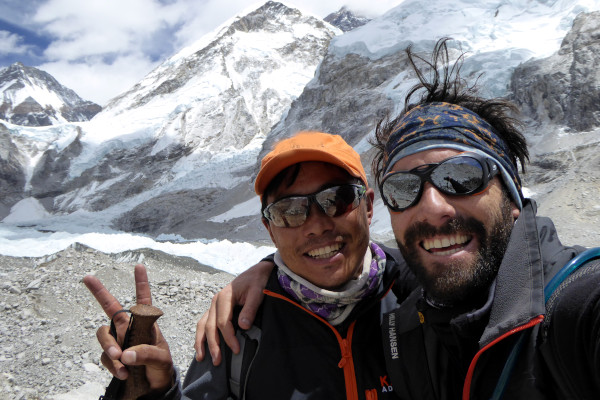
Hey, I’m Mark.
I started this website in 2014 after hiking to EBC for the first time (I've since hiked both the classic and Gokyo lakes routes). Over 2 million people have visited and benefitted from this site.
For 3 years I ran a major EBC trek operator.
Today I run Skyhook - an adventure travel booking platform that connects travellers with guides I've personally vetted.
My aim is to provide expert advice to help you prepare for a safe and successful EBC trekking experience.
Discover EBC's Best

ROUTE OPTIONS
Everest Base Camp Trek
Gokyo Lakes Trek to EBC
Three Passes Trek to EBC
Jiri to EBC Trek
EBC and Island Peak
EBC Packing List
Acclimatisation Guide
Trek Insurance
EBC Weather Guide
Training Guide
useful links
[email protected]
Privacy | Terms | DMCA | Affiliate Disclosure | Site Map
As an Amazon Associate, EBC Trek Guide earns from qualifying purchases.
© 2024 EBC Trek Guide | A Mountain IQ Guide. All Rights Reserved

Trekking in Nepal Images
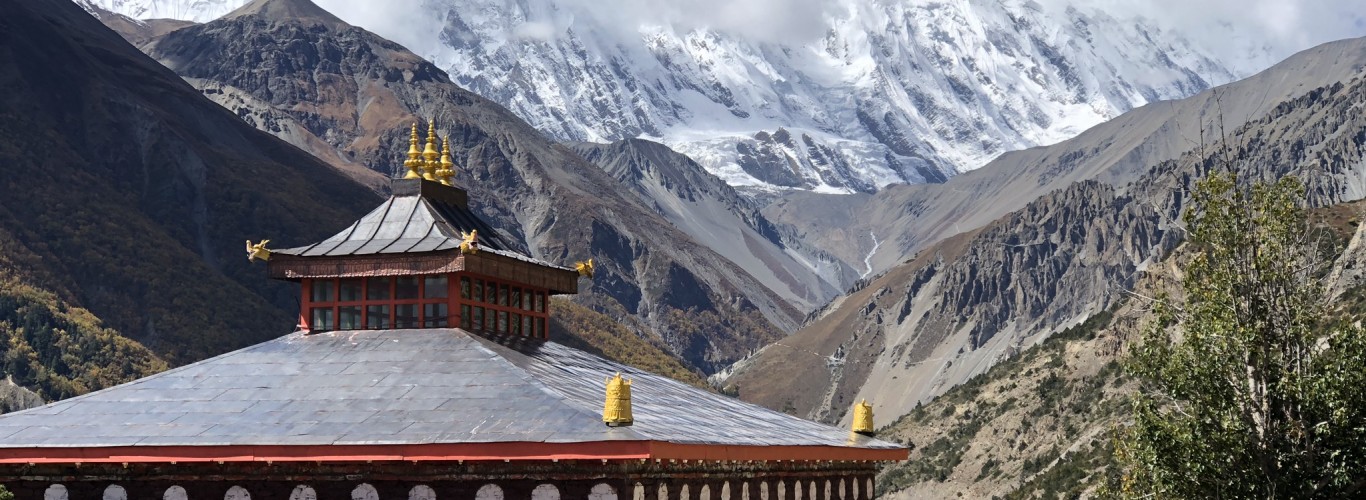
Search Tours
Everest Base Camp Trekking & Tour in Nepal with Joyful Trekking
Joyful trekking and tour company is Nepal’s best and unique trekking company with an Eco-friendly environment system on Mountain’s base country of Nepal. We are an established company specialized in Tour, Trekking and Expedition business in all over Nepal. We are offering best class services to our clients since 2,010 AD. We are running this company to prove the old Nepali famous proverb that “Guests are Gods to us”. If you have the wish to explore every corner of Nepal then we are here to fulfill your wish to be filled.
100% Customer Oriented
Best Services
Guaranteed Trips
Reasonable Price
Flexible To Customize Trip
Good Reviews
Popular EBC Trekking Packages

Annapurna Sanctuary Trekking is incredibly spectacular, set under the shade of majestic peaks Annapurna I (8091 m), Annapurna South (7219 m), Machapuchhre (6993 m) and Hiunchuli (6441). The western . .
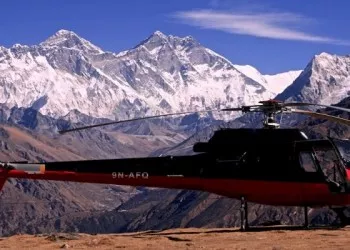
Best Selling Packages
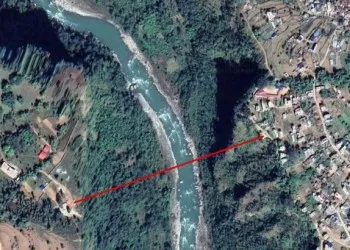
Latest Blog Posts

I'm always on the hunt for a good book. I absolutely love to read, and since I spend so much time in transit I'm always in need of something to help me pass the time. Here are some of the best books I've read recently – as well as a discount code for a Kindle!..... read more
Latest Clients Reviews

Bella from China
Eric is a very considerate and professional guide. The trip to ABC with him was much easier with his help. He tried his best to meet the customers’ demands, and sometimes he was really the life saver considering I was always the ‘careless’ person. Besides, the trip with him was a lot of fun because he also liked to make jokes and shared his life stories with us. You can really treat him as a good friend and a reliable trekking teammate, as well. Many thanks to you, Eric. I would like to recommend him to any of my friends who is interested in Nepal trekking to go with Joyful Trekking and Tours.
EBC Trekking Blogs
Recommended on
Site by SEO On Top
© 2024 Joyful Trekking Pvt Ltd
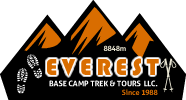
Main Navigation
- TESTIMONIALS
- Why Travel With Us?
- Associate Membership With
- Know about Everest Base Camp Trek
- Why book Trekking with Local Trekking Company
- Legal Documents
- privacy policy
- 12 Days Everest Base Camp Trek
- 14 Days Everest Base Camp Trek
- Everest Base Camp Trek and Helicopter Return
- Everest Base Camp Luxury Lodge Trek
- Everest Base Camp Budget Trek
- Everest Three High Passes Trek
- Short Gokyo-Cho La-Everest Base Camp Trek
- Everest Base Camp Via Gokyo Lakes Trek
- Everest Base Camp Trek for Indian
- Gokyo Lakes and GokyoRi Trek
- Short Everest View Trek
- 05 Days Everest Namche Bazaar Trek
- Everest View Classic Trek
- Everest View Luxury Trek and Helicopter fly
- Island Peak Climbing Package
- 03 days mera peak climbing package
- Island Peak Climbing with Everest Base Camp Trek
- Everest Base Camp Trek with Island Peak Climbing
- 18 days Mera Peak Climb climbing
- Gokyo High Pass EBC & Island Peak
- Lobuche East Peak with Everest Base Camp Trek
- 20 Days Everest Base Camp with Island Peak
Everest Base Camp Trek- Many more Package
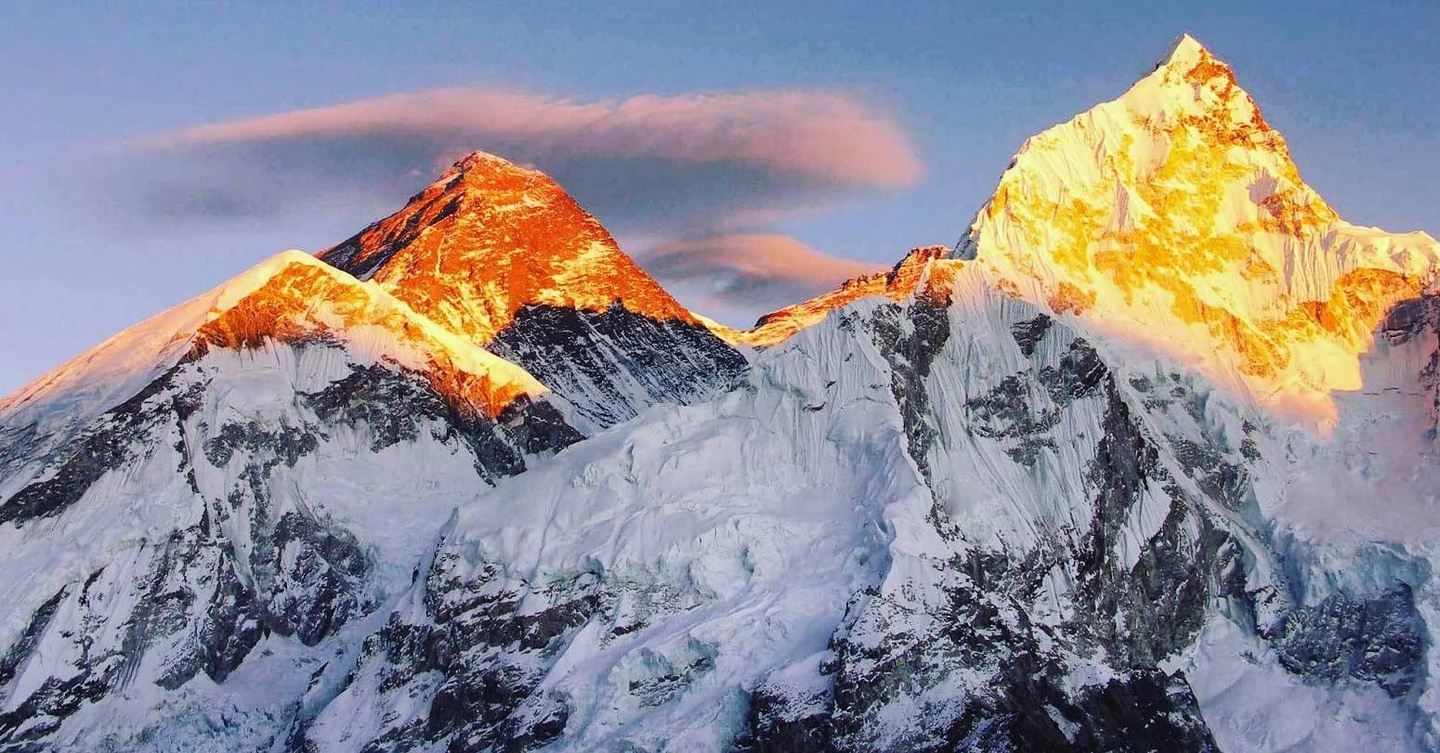
Everest Base Camp Trek & Tours!
Discover the wonders of the Himalayas with Everest Base Camp Trek, curated by our Kathmandu-based team specializing in adventure holidays. Immerse yourself in the awe-inspiring journey to Everest Base Camp or conquer thrilling peaks like Lobuche, Island, and Mera.
Tailored to your preferences, we customize your trekking experience, from duration to departure dates, catering to solo travelers, groups, couples, and families alike. As a registered company under Nepal's Ministry of Culture, Tourism, and Civil Aviation, we guarantee high-quality service since our establishment in 2009.
Beyond treks , we offer logistical support, including permits, guides, and transport from Kathmandu to Lukla. Explore our website for tentative itineraries, costs, and departure dates, or customize your adventure with our tailor-made options.
By choosing us, you support sustainable tourism and the local economy, ensuring responsible travel practices. Rest assured of safe departures and competitive pricing, with additional assistance for research projects and volunteer placements in Nepal. Embark on a journey of a lifetime with us.
Different trekking package in Everest nepal
As duration, Budget and Comfort
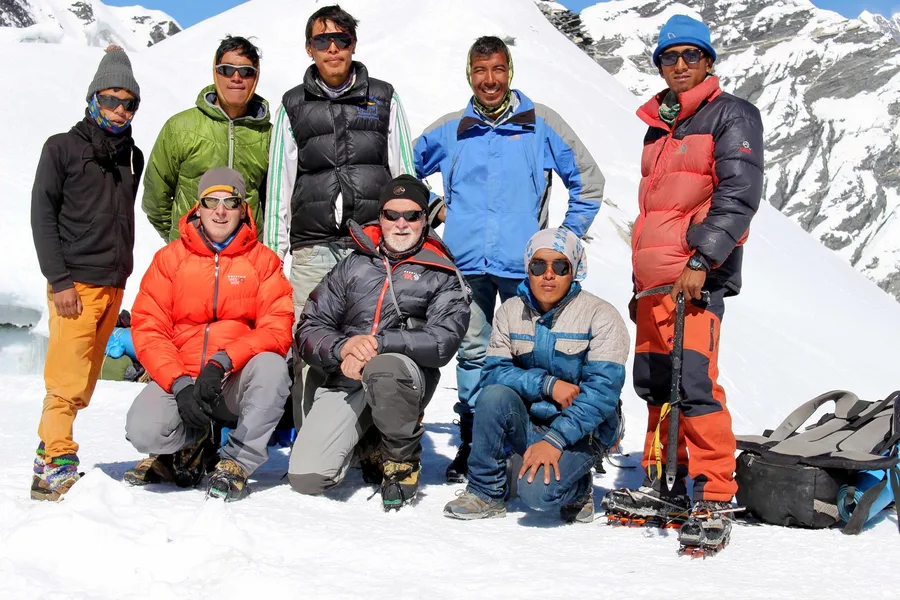
Everest Base Camp Trek Packages all inclusive
Join our Everest base camp trek, fixed departure all inclusive package or make your own private group or departure.

₹95000 INR ₹85000

Everest Trekking with Helicopter

Yeti Mountain Home & Luxury Trek
Best Selleting Everest Base Camp Trek 2023
Client testimonials
What Our Clients Say About Us - Everest Base Camp Trek

Everest Base Camp Trek Blog
Search, Read and Go
14 Apr 2024
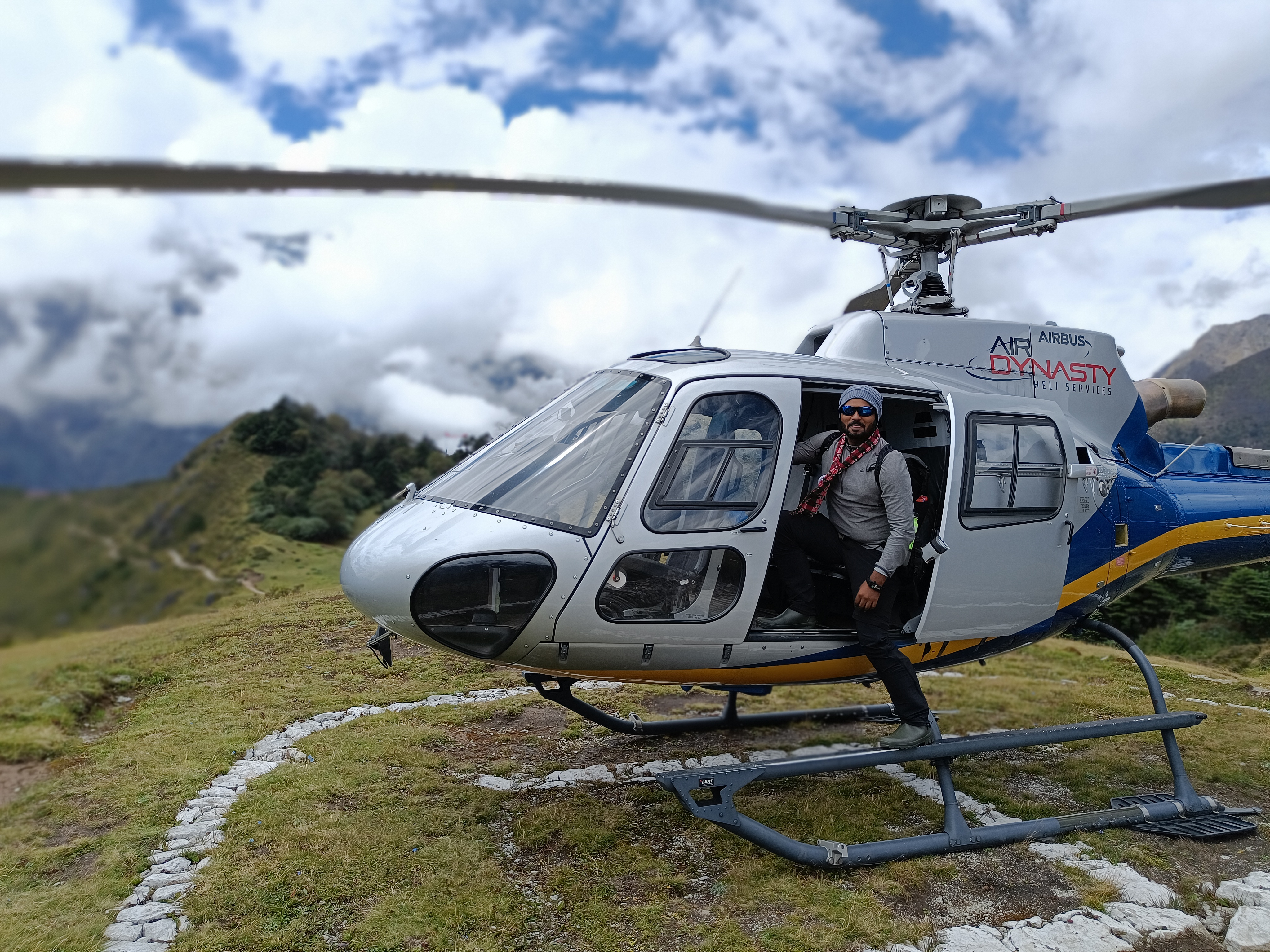
Premium everest base camp trek 10 days price
The price of the Premium Everest Base Camp trek for 10 days may seem high at first glance, but it..
28 Mar 2024
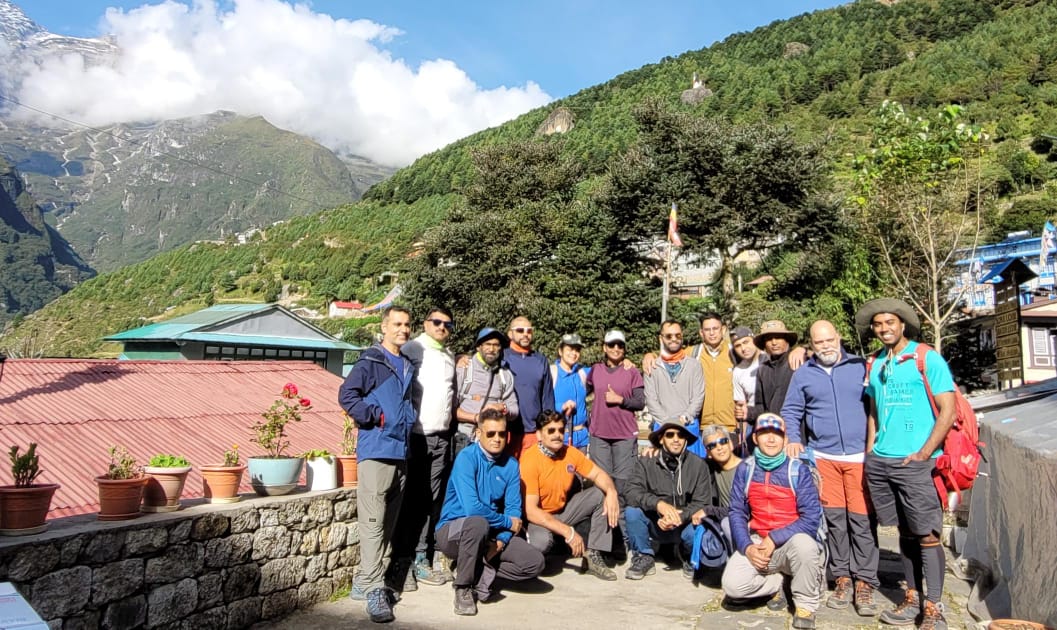
Preparing for a trek to Mount Everest
Preparing for a trek to Mount Everest demands a comprehensive approach to physical readiness, ..
14 Jan 2024

Everest Base Camp luxury lodge trek Complete Guide update
It seems like you're interested in information related to the Everest Base Camp trek, specifical..
06 Nov 2023
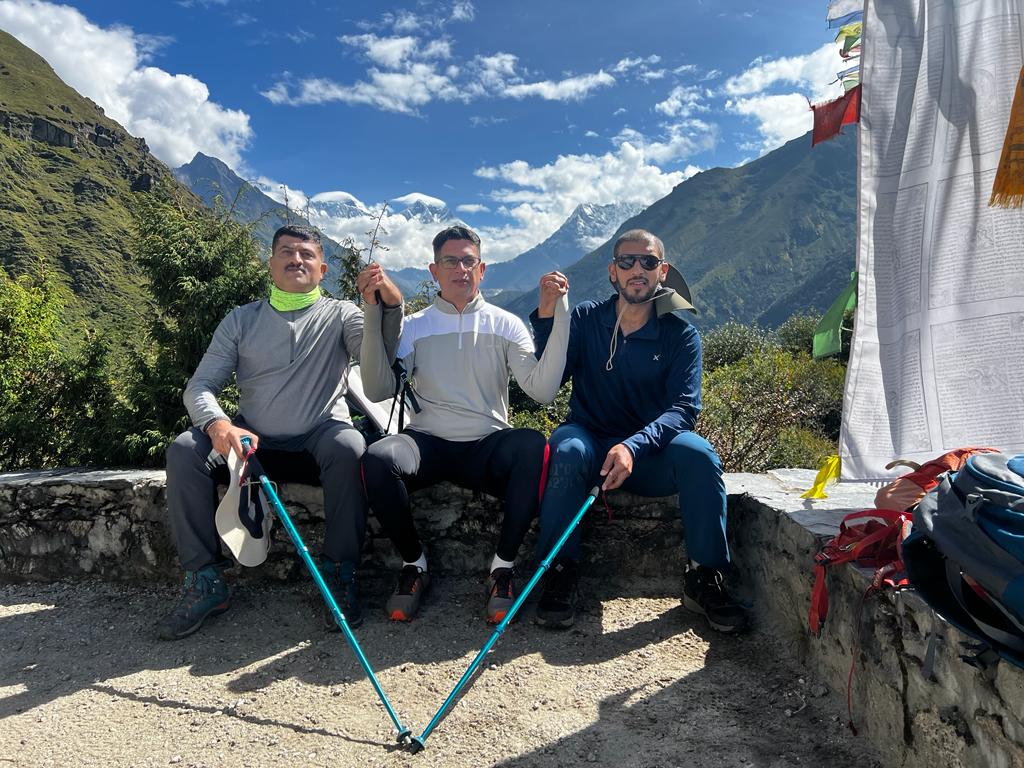
Trek to Everest Base Camp with Helicopter Return, Cost, Itineary, Guide
Trek to Everest Base Camp with Helicopter Return - An Unforgettable Adventure with Actual Adventure ..
We Accept Payments

All Contents & Photographs Within This Website Is Copyright © by Everest Base Camp Trek & Tours & May Not Be Reproduced Without Our Permission.
Notice. This site uses cookies to optimize your user experience. By using this site, you are consenting to our use of these cookies. Check out our Privacy Policy and our Cookies Policy.

- Everest Group Tour
- Tibet EBC Tour
- Nepal EBC Tour
- Tibet Permit
- Travel Guide
- 4 Days Everest Base Camp Small Group from Lhasa from USD580
- 7 Days Lhasa Shigatse EBC Small Group Tour from USD730
- 8 Days Lhasa to Everest Base Camp Small Group Tour from USD830
- 9 Days Lhasa Shigatse EBC Namtso Small Group Tour from Chengdu from USD840
- 9 Days EBC Hiking Group from Old Tingri from USD1880
- 10 Days Lhasa Everest Base Camp & Namtso Lake Small Group Tour from USD1190
- 11 Days Tibet Old Tingri to EBC Trek Small Group Tour from USD2080
- EBC Private Tour
- Lhasa & EBC Tour
- EBC & Namtso Tour
- EBC Overland Tour
- Everest Trekking Tour
- Everest Climbing Tour
- 13 Days Nepal Everest Base Camp Tour from Kathmandu
- Tibet Small Group Tours
- Top Tibet Tours
- Lhasa Tours
- Lhasa & Namtso Tours
- Lhasa & Kailash Tours
- 2022 Tibet Permit Application Policy
- 2022 Tibet Permit for Expats in China
- Tibet Travel Permit / Tibet Visa
- How to Apply for Tibet Travel Permit
- How to Get Tibet Travel Permit
- How to Travel to Tibet
- Qinghai-Tibet Railway
- Best Time to Travel Tibet
- Soft Sleeper Berth of Tibet Train
- How to Plan a Tibet Tour
- Soft and Hard Sleeper Tickets
- High Altitude Sickness
- Book Qinghai-Tibet Train Ticket
- Tibet Temperatures
- Beijing to Lhasa Train
- Tibet Tour Packing List
- Tibet Road Maps
- Top Tibet Travel FAQs in Jan. & Feb.

Why Travel with EBCtours.com
EBCtours , a branch of TibetTourism and a company integrating Tibet local based tour operator and online leading travel agency , is the best assistant to help you plan a lifetime and valuable travel to Everest Base Camp (EBC) .
Travelling with EBCtours, clients will not only have a real Tibet journey as you are guided to enjoy the stunning alpine scenery and mysterious Tibetan monasteries, but also experience as much as you could the local Tibetans’ life and exotic Tibetan culture and customs.
Travel to EBC with us for an once-in-a-lifetime spiritual Tibet trip on "the Roof of the World" from today.
Competitive Price
Big savings on vehicles, hotels, tickets and tour packages because of the large groups of our clients to bring down the tour operating cost;
Massive discount on early-bird booking but meanwhile enjoying the same service.
Top Service Experience
Provide one-stop 24/7 professional 1-on-1 customer service; Reply to your inquiry within 24 hours from our trained travel experts;
Showcase Tibetan scenery, culture, history with NO commission-based shopping stops.
Tibet Permit Guarantee
100% Tibet Travel Permit guarantee to our clients based on decades of cooperation with local Tibet government;
Tibet Permit application and delivery are totally free of charge.
Responsible Travel
Use local experienced drivers & professional tour guides to offer more jobs for Tibetans and support sustainable Tibet tourism development;
Join in wonderful tour activities but only leave the footprint in Tibet as eco-travel supporters.
Top Everest Base Camp Tour Packages

Customizable Private EBC Tour Packages

Most Recommended Private Tibet Tours by Theme and Destination

Travelers' Reviews
Real-time tibet travel guide.
Whether you are searching China Tibet travel tips or scenic spot overview, we will always provide you with real-time travel information in Tibet, so that you will not make the wrong Tibet tour plan because of the information lag.

Free Design Itinerary and Quote for You !

Copyright © 2001-2023 All Rights Reserved by EBCtours.com .

IMAGES
VIDEO
COMMENTS
Mexico Tours. Northern Morocco tours. Nile Winter tours. Amazon Rainforest tours. Machu Picchu Luxury tours. Best USA Vacation Spots for Couples: Parks, Cities and more. Browse 250+ tours from the best tour operators in Everest Base Camp with 2,903 reviews visiting places like Kathmandu and Lukla. Compare & book now!
The iconic Everest Base Camp Trek leads you through the Khumbu Valley, allowing you to experience the immense beauty of the surrounding Sagarmatha National Park while simultaneously providing breath-taking vistas of 4 of the 6 highest peaks in the world - My. Everest (8.848m), Mt. Lhotse (8,516 meters), Mt. Makalu (8,470 meters) and Cho Oyu (8,201 meters).
For a complete cent-by-cent cost breakdown of our trek to Everest Base Camp in 2020. Cost of trekking to EBC in different ways in a nutshell: Package tour EBC trek with international agency $1700. Package tour EBC trek with local agency $1600. Independent EBC trek with a guide and porter $1370.
The standard trekking itinerary for the Everest Base Camp Trek is 12 days long. However, it may vary slightly depending on the trekking agency you choose to go with: Day 1. Flight to Lukla and trek to Phakding (2,650m) Day 2. Phakding - Namche Bazaar (3,440m) Day 3. Acclimatization day at Namche Bazaar.
Our trips don't only include our incredible crew but also all the safety gear required to help get you to Everest Base Camp safely. All accommodation and transport is included, plus a return flight to Lukla to get you to the start of the trek. Sustainable Travel. We have a 'bring in, bring out' philosophy on our Base Camp treks, meaning ...
Everest base camp trek is one of the finest treks in the world that centers on the world's highest peak Mt. Everest (29,029 ft/ 8,848.68m). This trek will provide you with a natural thrill as it takes you through breathtaking high-altitude landscapes, esoteric Buddhist monasteries, traditional Sherpa villages, high-altitude flora and fauna, and snow-capped mountains.
Trekking to 5,550m/18,204ft0 at its highest point (Kala Patthar), the two weeks Everest Base Camp trek (EBC trek) is the most loved and popular trekking route in the World. This amazing adventurous journey takes you around the foothills of the renowned World's highest peak, Mt. Everest (8,848.86m). The major attraction of the EBC trek is Kala ...
The Everest Base Camp Trek is one of the most popular and best treks in Nepal.. Home to four of the six highest mountains in the world - Mt. Everest (8,848 meters), Mt. Lhotse (8,516 meters), Mt. Makalu (8,470 meters) and Cho Oyu (8,201 meters) - the Everest (or Khumbu) region affords trekkers the opportunity to hike in one of the grandest and most awe-inspiring trekking areas in the world.
The Best Everest Base Camp Tours and Alternate Trekking Packages. The Mount Everest Base Camp Trek is an incredible journey that offers breathtaking views of the landscape, mountains, and hills. You experience the chill of fresh mountain air coming down from the world's tallest peak during this once-in-a-lifetime trek.
Everest Base Camp Trek Cost. For a 13 day trek, I paid about $21 USD per day for food, drinks, and room. Porter/guide was an extra $25 per day, although it's not a requirement. ... Best Everest Base Camp Tours. If you'd rather skip the hassle of planning your own EBC Trek, Klook has Everest Base Camp Tours starting as low as $900 USD for a ...
15 days, Kathmandu to Kathmandu. Overview. Full itinerary. Tour details. Everest is more than a mountain and the journey to its base camp is more than just a trek. Along a route dubbed by some as "the steps to heaven," every bend in the trail provides another photo opportunity — beautiful forests, Sherpa villages, glacial moraines, and foothills.
The Gokyo Lakes Trek to Everest Base Camp is a variation of the traditional trek to Base Camp that offers additional sights and the wonderful opportunity to experience the beauty of the highest freshwater lake system in the world. This is all in addition to visiting the Everest Base Camp and high-point of Kala Patthar - two of the highlights of the standard base camp trek.
10 Best Everest Base Camp Trekking Companies 2024/2025 - TourRadar. Choose from the best Everest Base Camp trekking companies with thousands of traveler reviews. Find the right tour operator for your next Himalayan adventure.
This classic trek takes place in the Bagmati Zone of Nepal and allows you to experience the immense beauty of the surroundings. Along your trek, you will get to witness 4 of the 6 highest mountain peaks in the world — Cho Oyu (8,201 m), Mt. Makalu (8,470 m), Mt. Lhotse (8,516 m), and Mt. Everest (8,848 m). Everest Base Camp is a teahouse trek ...
The best time to trek to the Everest Base Camp is from March to May and September to November. These are the peak trekking seasons when the weather is stable, and the skies are clear, allowing for stunning views of the Himalayas. During the peak seasons, the trails can get crowded, and the accommodation can get fully booked.
Altitude: Kathmandu (1 400m) - Lukla (2 860m) - Phakding (2 610m). Trekking time: 3-4 hours | 7,4 km. Difficulty: Easy with only a few uphill sections. Highlight: Flight into Lukla. Overview: The first day of your Everest Base Camp trek itinerary will start bright and early with a flight out of Kathmandu to the infamous Tenzing Hillary Airport in Lukla.
Overview. Everest Base Camp Trek is the exciting exploration to the highest peak in the world, Mt. Everest [8,848 meters/ 29,032 feet], is one of the most renowned trekking adventures in the world.. This enriching Everest base camp trekking experience outshines other high-altitude adventures thanks to its unparalleled natural beauty, iconic landmarks, rich Himalayan bio-diversity, culturally ...
Everest Base Camp Trek Cost. Many factors affect the total cost of trekking to the Everest base camp. It also depends on the season you pick for the trek. The luxury Everest base camp trek provides good accommodation, meals, and unexpected events. Trekking to Everest Base Camp costs between $1150 and $3500, depending on the package chosen. This ...
When embarking on the Guided Everest Base Camp Trekking, adventurers can expect a comprehensive package that includes an experienced, friendly English-speaking trekking guide, domestic flight tickets, necessary permits and taxes, transportation to and from the trek starting point, as well as essential trekking equipment such as a sleeping bag and duffel bag.
Over 2 million people have visited and benefitted from this site. For 3 years I ran a major EBC trek operator. Today I run Skyhook - an adventure travel booking platform that connects travellers with guides I've personally vetted. My aim is to provide expert advice to help you prepare for a safe and successful EBC trekking experience.
Joyful trekking and tour company is Nepal's best and unique trekking company with an Eco-friendly environment system on Mountain's base country of Nepal. We are an established company specialized in Tour, Trekking and Expedition business in all over Nepal. We are offering best class services to our clients since 2,010 AD.
Everest Base Camp Trek & Tours! Discover the wonders of the Himalayas with Everest Base Camp Trek, curated by our Kathmandu-based team specializing in adventure holidays. Immerse yourself in the awe-inspiring journey to Everest Base Camp or conquer thrilling peaks like Lobuche, Island, and Mera. Tailored to your preferences, we customize your ...
EBCtours, a branch of TibetTourism and a company integrating Tibet local based tour operator and online leading travel agency, is the best assistant to help you plan a lifetime and valuable travel to Everest Base Camp (EBC).. Travelling with EBCtours, clients will not only have a real Tibet journey as you are guided to enjoy the stunning alpine scenery and mysterious Tibetan monasteries, but ...